Birds of Florida listed by their systematic.
Geography: Other: As of November 2022, there were 539 species included in the official list, 18 have been introduced to North America. [Link] A total of 357 species is included.
Schellente am Südende des Pfäffikersee Ich hätte gern ein besseres Foto aber die Schellenten waren nur etwa 100 Meter vom
Weg entfernt und dazu hinter Schilf. Auch mein 600mm Objektiv hat nicht gereicht,
aber zugegeben, ein Stativ hätte geholfen. 2021-01-26 15.36.26 Pfäffikersee
First observed in 🇨🇭 on 2021-01-26.
This bird appears across the great seas in the following continents:
Europe, North America.
Etymology: Nabu: Schellenten verdanken ihren Namen dem pfeifenden und wie ein Klingeln («Schellen») tönenden Fluggeräusch. [Vogelwarte.ch erklärt: ]
Gruener Kopf mit gelbem Auge (Goldeneye), weisser Kreis zwischen Auge und (schwarzem) Schnabel, weisser Bauch und Seiten mit etwa 5 duennen schwarzen Streifen, schwarzer Ruecken. In Island gibt's eine sehr aehnliche Ente und in kleineren Mengen auch diese.
Wintergast am Pfäffikersee.
Vocalization: ![]() Male display sound a dry nasal disyllabic "Ka-weerr". First note introductory and second longer and descending. Usually accompanied by back-throwing head motion. Female: dry harsh "aahrrrr aahrrrr aahrrrr ". Wings make a characteristic whistling sound. [Link]
Male display sound a dry nasal disyllabic "Ka-weerr". First note introductory and second longer and descending. Usually accompanied by back-throwing head motion. Female: dry harsh "aahrrrr aahrrrr aahrrrr ". Wings make a characteristic whistling sound. [Link]
Physical details: length=42-50 cm,
wingspan=65-80 cm,
weight=650-1200 g
Habitats:
River and lake

Wikipedia: Bufflehead Source: OTHER
1200px-Bucephala-albeola-007.jpg
General: ![]() The bufflehead (Bucephala albeola) is a small sea duck of the genus Bucephala, the goldeneyes. This species was first described by Carl Linnaeus in his landmark 1758 10th edition of Systema Naturae as Anas albeola.[2]
[more]
The bufflehead (Bucephala albeola) is a small sea duck of the genus Bucephala, the goldeneyes. This species was first described by Carl Linnaeus in his landmark 1758 10th edition of Systema Naturae as Anas albeola.[2]
[more]
Mittelsaeger Weibchen auf Lago Maggiore, Locarno. 2021-04-06 13.18.48 Northern Lago Maggiore
First observed in 🇨🇭 on 2021-04-06.
This bird appears across the great seas in the following continents:
Europe, North America.
Personal notes: ![]() Zuerst gesehen in Lago Maggiore in Locarno. Jan 2022 auch als Wintergast am Pfaeffikersee. [Link]
Zuerst gesehen in Lago Maggiore in Locarno. Jan 2022 auch als Wintergast am Pfaeffikersee. [Link]
Appearance and identification: ![]() In winter you can admire a few of these birds with the straggly tuft. [Link]
In winter you can admire a few of these birds with the straggly tuft. [Link]
Habitats:
River and lake
Looks similar to:
Greater scaup.
Eiderente, vom Steg aus gesehen in Rapperswil. 2021-02-12 13.42.20 Rapperswil
First observed in Iceland on 2015-06-09.
This bird appears across the great seas in the following continents:
Europe, North America.
Etymology: Nabu: Auch heute noch erinnert ihr wissenschaftlicher Name an die Bedeutung ihrer isolierenden Daunen für die Menschen. Übersetzt bedeutet ihr Name nämlich „die Allerweichste mit dem schwarzen Körper“. [Link]
Geography: ![]() Die im Norden Europas häufige und wegen ihren Daunenfedern bekannte Eiderente war in der Schweiz früher ein seltener Gast. Doch in der zweiten Hälfte des 20. Jahrhunderts erfolgten mehrere grosse Einflüge. Dank der Wandermuschelvermehrung war das Nahrungsangebot ausreichend und die Vögel verbrachten zunehmend den Sommer bei uns. Mittlerweile gehört die Eiderente sogar zu den Brutvögeln, was für einen ans Meer angepassten Vogel bemerkenswert ist. [Link]
Die im Norden Europas häufige und wegen ihren Daunenfedern bekannte Eiderente war in der Schweiz früher ein seltener Gast. Doch in der zweiten Hälfte des 20. Jahrhunderts erfolgten mehrere grosse Einflüge. Dank der Wandermuschelvermehrung war das Nahrungsangebot ausreichend und die Vögel verbrachten zunehmend den Sommer bei uns. Mittlerweile gehört die Eiderente sogar zu den Brutvögeln, was für einen ans Meer angepassten Vogel bemerkenswert ist. [Link]
Calls: ![]() Males call a typical, pleasant, clear, 2-3 second long "aaaooooooh". Starting on a low note, slowly ascending and ending on a descending note. Usually accompanied by the female "ga ga ga ga". [Link]
Males call a typical, pleasant, clear, 2-3 second long "aaaooooooh". Starting on a low note, slowly ascending and ending on a descending note. Usually accompanied by the female "ga ga ga ga". [Link]
Physical details: length=50-71 cm,
wingspan=80-108 cm,
weight=1500-2800 g
Habitats:
River and lake
Mother and 4 of 9 babies on the Pfäffikersee 2020-05-20 09.12.44 Pfäffikersee
First observed in 🇨🇭 on 2020-05-20.
This bird appears across the great seas in the following continents:
Europe, North America, South America, Africa.
Common waterbird at Pfäffikersee
Etymology: ![]() Der heutige Name kann als Hinweis auf ihre Brutplätze verstanden werden, zu denen auf Stock gesetzte Weiden, Weidengebüsch oder auch Reisighaufen gehören.
['Stock' wird weiter erklärt: Als Stockausschlag bezeichnet man bei Bäumen und Sträuchern Triebe, die nach dem Verlust der primären Sprossachse
neu aus dem Stumpf oder Stubben (der dann „Stock“ genannt wird) austreiben.] [Link]
Der heutige Name kann als Hinweis auf ihre Brutplätze verstanden werden, zu denen auf Stock gesetzte Weiden, Weidengebüsch oder auch Reisighaufen gehören.
['Stock' wird weiter erklärt: Als Stockausschlag bezeichnet man bei Bäumen und Sträuchern Triebe, die nach dem Verlust der primären Sprossachse
neu aus dem Stumpf oder Stubben (der dann „Stock“ genannt wird) austreiben.] [Link]
![]() The name 'was derived from the Old French malart or mallart for "wild drake"' [Link]
The name 'was derived from the Old French malart or mallart for "wild drake"' [Link]
Vocalization: ![]() Female: A distinct coarse, laughing quacking; "haaa ha ha ha ha ha", with first note accented and then descending in pitch. Male: a more silent, very nasal "rriib". [Link]
Female: A distinct coarse, laughing quacking; "haaa ha ha ha ha ha", with first note accented and then descending in pitch. Male: a more silent, very nasal "rriib". [Link]
Calls: ![]() Display call a high-pitched short whistle. [Link]
Display call a high-pitched short whistle. [Link]
Physical details: length=50-65 cm,
wingspan=81-98 cm,
weight=750-1450 g
Habitats:
River and lake
Krickente am Aa-Bach beim Südende des Pfäffikersee 2021-01-26 15.41.54 Pfäffikersee
First observed in 🇨🇭 on 2021-01-26.
This bird appears across the great seas in the following continents:
Europe, North America, South America, Africa, Asia.
Wintergast am Teich am Aa-Bach beim Südende des Pfäffikersee
Etymology: ![]() Die hellen «krrik»-Rufe der stimmfreudigen Erpel verhalfen dieser Art zu ihrem deutschen Namen. [Link]
Die hellen «krrik»-Rufe der stimmfreudigen Erpel verhalfen dieser Art zu ihrem deutschen Namen. [Link]
Vocalization: ![]() Male: characteristic, short, highly resonant and metallic "plytt". A bit similar to Pintail, but higher pitched and lacking accompanying whistling sound. Female: various quacking sounds generally quicker paced, more nasal and noticeably higher pitched than Mallard. [Link]
Male: characteristic, short, highly resonant and metallic "plytt". A bit similar to Pintail, but higher pitched and lacking accompanying whistling sound. Female: various quacking sounds generally quicker paced, more nasal and noticeably higher pitched than Mallard. [Link]
Physical details: length=34-38 cm,
wingspan=58-64 cm,
weight=200-450 g
Habitats:
River and lake
Call:
Blup blup, fast wie vom Computer generiert, fur mich nohe Noten (obwohl Sonogram nur 2.5 KHz zeigt)
Krickente Ruf von XenoCanto
♫ Krickente Ruf von XenoCanto Source: XENOCANTO
XC619133-Krickente von Peter Bosman, Belgium.mp3
(call)

Call attributes:
Call melody: simple rhythmic, slow, Frequency: low (1-3 KHz),
Loeffelenten am Greifensee bei Silberweide Es gab dutzende davon, dazwischen eine Krickente. 2021-02-08 15.20.36
First observed in 🇨🇭 on 2021-02-08.
This bird appears across the great seas in the following continents:
Europe, North America, South America, Africa.
Wintergast am Greifensee.
PK: white, black, rust-brown, yellow eyes, black spoonbill, red legs.
Vocalization: ![]() Male is characteristic and most often heard: A hoarse nasal knocking sound "took took", often staccato or disyllabic. Female similar to Mallard but flatter and more creaking. [Link]
Male is characteristic and most often heard: A hoarse nasal knocking sound "took took", often staccato or disyllabic. Female similar to Mallard but flatter and more creaking. [Link]
Physical details: length=44-52 cm,
wingspan=70-84 cm,
weight=470-800 g
Habitats:
River and lake
Profile Wikipedia eBird Vogelwarte BirdLife ZH ornitho.ch Audubon AllAboutBirds Xeno-Canto BirdID NABU
Spiessente Paar. 2022-02-05 13.14.54 Klingnauer Stausee (man-made lake)
First observed in 🇨🇭 on 2022-02-05.
This bird appears across the great seas in the following continents:
Europe, North America, South America, Africa, Asia.
Long tailfeathers make the name obvious, also a thin white stripe from the white neck up the back of the head.
Vocalization: ![]() Female: similar to Mallards coarse laughing sound, but with a more emphasized first "haaa", and a more silent accelerating subsequent "laugh". Male: Pleasant, resonant "plop" similar to Teal, but lower pitched, richer, mellower and not so metallic. Accompanied by a higher pitched, slightly raspy whistling "aiiooo" rising and falling in pitch. [Link]
Female: similar to Mallards coarse laughing sound, but with a more emphasized first "haaa", and a more silent accelerating subsequent "laugh". Male: Pleasant, resonant "plop" similar to Teal, but lower pitched, richer, mellower and not so metallic. Accompanied by a higher pitched, slightly raspy whistling "aiiooo" rising and falling in pitch. [Link]
Physical details: length=51-66 cm,
wingspan=51-66 cm,
weight=500-1100 g
Habitats:
River and lake

Wikipedia: American black duck Source: OTHER
1200px-Blackduck.jpg
General: ![]() The American black duck (Anas rubripes) is a large dabbling duck in the family Anatidae. It was described by William Brewster in 1902. It is the heaviest species in the genus Anas, weighing 720–1,640 g (1.59–3.62 lb) on average and measuring 54–59 cm (21–23 in) in length with a 88–95 cm (35–37 in) wingspan. It somewhat resembles the female mallard in coloration, but has a darker plumage. The male and female are generally similar in appearance, but the male's bill is yellow while the female's is dull green with dark marks on the upper mandible. It is native to eastern North America. During the breeding season, it is usually found in coastal and freshwater wetlands from Saskatchewan to the Atlantic in Canada and the Great Lakes and the Adirondacks in the United States. It is a partially migratory species, mostly wintering in the east-central United States, especially in coastal areas.
[more]
The American black duck (Anas rubripes) is a large dabbling duck in the family Anatidae. It was described by William Brewster in 1902. It is the heaviest species in the genus Anas, weighing 720–1,640 g (1.59–3.62 lb) on average and measuring 54–59 cm (21–23 in) in length with a 88–95 cm (35–37 in) wingspan. It somewhat resembles the female mallard in coloration, but has a darker plumage. The male and female are generally similar in appearance, but the male's bill is yellow while the female's is dull green with dark marks on the upper mandible. It is native to eastern North America. During the breeding season, it is usually found in coastal and freshwater wetlands from Saskatchewan to the Atlantic in Canada and the Great Lakes and the Adirondacks in the United States. It is a partially migratory species, mostly wintering in the east-central United States, especially in coastal areas.
[more]
Profile Wikipedia eBird Audubon AllAboutBirds Xeno-Canto
MerlinBirdID says mottled ducks near Mark's place in St Petersburg - they resembled female mallards but darker, males have yellow bills, females they call olive but pictures show orange and brown too. 2023-09-25 09.52.18 Florida
First observed in Florida on 2023-09-25.
![]() The mottled duck (Anas fulvigula)[note 1] or mottled mallard is a medium-sized dabbling duck. It is intermediate in appearance between the female mallard and the American black duck. It is closely related to those species, and is sometimes considered a subspecies of the former, but this is inappropriate (see Systematics below).
[more]
The mottled duck (Anas fulvigula)[note 1] or mottled mallard is a medium-sized dabbling duck. It is intermediate in appearance between the female mallard and the American black duck. It is closely related to those species, and is sometimes considered a subspecies of the former, but this is inappropriate (see Systematics below).
[more]
Pfeifente Erpel , Neeracher Ried. Die zehnte Entenart, die ich gefunden habe. 2021-02-24 14.05.08 Neeracherried
First observed in 🇨🇭 on 2021-02-24.
This bird appears across the great seas in the following continents:
Europe, North America, Africa.
Etymology: ![]() Es ist der Ruf des Männchens, der zu dem deutschen Namen der Art geführt hat. Das Männchen leitet seine kurzen, scharfen, zwei- bis dreisilbigen pfeifenden wiu-Rufe häufig mit einem krr krkrkrr ein. [Link]
Es ist der Ruf des Männchens, der zu dem deutschen Namen der Art geführt hat. Das Männchen leitet seine kurzen, scharfen, zwei- bis dreisilbigen pfeifenden wiu-Rufe häufig mit einem krr krkrkrr ein. [Link]
Funny red head (made me confused it with the Kolbente) that's brown with a golden forehead (Kolbente is brown, a bit lighter at the back of the head) is the obvious characteristic. Also has a nice black and white pattern on its back and wings with white-rimmed black feathers at the end of the wing, a bit of white before a black butt.
Vocalization: ![]() Male: a pleasant high pitched whistle "piiiiuuu", rapidly rising in pitch and then falling. Quite vocal. Female: a harsh "kraaa kraaa kraa" more like female diving-ducks than other dabbling-ducks. [Link]
Male: a pleasant high pitched whistle "piiiiuuu", rapidly rising in pitch and then falling. Quite vocal. Female: a harsh "kraaa kraaa kraa" more like female diving-ducks than other dabbling-ducks. [Link]
Physical details: length=45-51 cm,
wingspan=75-86 cm,
weight=500-1000 g
Habitats:
River and lake
Call:
Pfeifen, fast wie ein Rotmilan oder Maeusebussard. Ton steigt und faellt!
Pfeifente von XenoCanto
♫ Pfeifente von XenoCanto Source: XENOCANTO
XC613742-Pfeifente von Adrien Mauss.mp3
(call)

Call attributes:
Call melody: simple rhythmic, slow, Frequency: low (1-3 KHz),
Schnatterente am Greifensee bei Silberweide Es gab dutzende davon, dazwischen eine Krickente. 2021-02-08 15.45.18
First observed in 🇨🇭 on 2021-02-08.
This bird appears across the great seas in the following continents:
Europe, North America, Africa.
In my mind this is the chocolate duck.
Etymology: ![]() The etymology of the word gadwall is not known, but the name has been in use since 1666.[9] [Link]
The etymology of the word gadwall is not known, but the name has been in use since 1666.[9] [Link]
Nabu: Die Schnatterente fällt aber – wie ihr Name schon vermuten lässt – durch ihre Art der Nahrungssuche auf. Sie durchschnattert das Wasser mit ihrem Schnabel. [Link]
Chocolate bill, black-and-white pattern on head, shoulders, belly, sides of wings, chocolate patterned wings, black butt, a bit of white before the butt.
Appearance and identification: Nabu: Die Schnatterente ähnelt auf den ersten Blick so sehr der weiblichen Stockente, dass man diese schnell verwechseln kann. [Link]
Wintergast am Greifensee.
Calls: ![]() Males display-call a short dry rattling or croaking sound and some high whistling notes. Female quacking similar to Mallard, but drier and shriller. [Link]
Males display-call a short dry rattling or croaking sound and some high whistling notes. Female quacking similar to Mallard, but drier and shriller. [Link]
Physical details: length=46-56 cm,
wingspan=84-95 cm,
weight=550-1000 g
Habitats:
River and lake
Call:
Automatically generated from Xeno-Canto recording
♫ Schnatterenten, Moewen und an 29 Sekunden eindeutig ein Jet von Swiss, da wir in Neeracherried sehr nach am Kloten Flughafen sind, BirdNet schlaegt auch Teichrohrsaenger vor, wie auch ein Moewe-Typ aus Kalifornien. ![]() Source: Zoom H6 2021-10-24 13.12.46 Neeracherried (song?)
Source: Zoom H6 2021-10-24 13.12.46 Neeracherried (song?)

Wikipedia: American wigeon Source: OTHER
1200px-Anas_americana_-_drake.jpg
This bird appears across the great seas in the following continents:
Europe, North America, South America.
General: ![]() The American wigeon (Mareca americana), also known as the baldpate, is a species of dabbling duck found in North America. Formerly assigned to Anas, this species is classified with the other wigeons in the dabbling duck genus Mareca. It is the New World counterpart of the Eurasian wigeon. Mareca is from the Brazilian-Portuguese word Marréco for a small duck and americana refers to America.[2][3]
[more]
The American wigeon (Mareca americana), also known as the baldpate, is a species of dabbling duck found in North America. Formerly assigned to Anas, this species is classified with the other wigeons in the dabbling duck genus Mareca. It is the New World counterpart of the Eurasian wigeon. Mareca is from the Brazilian-Portuguese word Marréco for a small duck and americana refers to America.[2][3]
[more]

Wikipedia: Greater scaup Source: OTHER
1200px-2017-03-24_Aythya_marila%2C_male%2C_Killingworth_Lake%2C_Northumberland_15.jpg
This bird appears across the great seas in the following continents:
Europe, North America.
Deutschland: Zugvogel, Wintergast RL R
Calls: ![]() Male call carries only a few meters: a whistling "po-ho" last syllable slowly descending. Female calls with harsh "harr-harrr-harrr". [Link]
Male call carries only a few meters: a whistling "po-ho" last syllable slowly descending. Female calls with harsh "harr-harrr-harrr". [Link]
Physical details: length=42-51 cm,
wingspan=72-84 cm,
weight=700-1300 g
Habitats:
River and lake
Looks similar to:
Red-breasted merganser.

Wikipedia: Redhead Source: OTHER
1200px-Woman_redhead_natural_portrait_1.jpg
General: ![]() Die Rotkopfente (Aythya americana) ist eine Tauchente aus der Familie der Entenvögel. Sie ist ein nordamerikanischer Brutvogel. In ihrem Federkleid ähnelt sie der ebenfalls in Nordamerika brütenden Riesentafelente und der in Europa beheimateten Tafelente. Die drei Arten können jedoch anhand ihrer Schnabelfärbung unterschieden werden. Die Riesentafelente hat einen durchgängig dunkelgrauen Schnabel. Die Stirn fällt außerdem flach ab, wodurch ihr Profil keilförmig wie bei der Eiderente wirkt. Die Tafelente hat eine schwarze Schnabelbasis, so dass der Schnabel in der Mitte ein hellgraues Band aufweist. Bei der Rotkopfente dagegen ist nur die Schnabelspitze dunkelgrau bis schwarz.
[more]
Die Rotkopfente (Aythya americana) ist eine Tauchente aus der Familie der Entenvögel. Sie ist ein nordamerikanischer Brutvogel. In ihrem Federkleid ähnelt sie der ebenfalls in Nordamerika brütenden Riesentafelente und der in Europa beheimateten Tafelente. Die drei Arten können jedoch anhand ihrer Schnabelfärbung unterschieden werden. Die Riesentafelente hat einen durchgängig dunkelgrauen Schnabel. Die Stirn fällt außerdem flach ab, wodurch ihr Profil keilförmig wie bei der Eiderente wirkt. Die Tafelente hat eine schwarze Schnabelbasis, so dass der Schnabel in der Mitte ein hellgraues Band aufweist. Bei der Rotkopfente dagegen ist nur die Schnabelspitze dunkelgrau bis schwarz.
[more]

Wikipedia: Lesser scaup Source: OTHER
1200px-Lesser_scaup_-_Aythya_affinis.jpg
![]() The lesser scaup (Aythya affinis) is a small North American diving duck that migrates south as far as Central America in winter. It is colloquially known as the little bluebill or broadbill because of its distinctive blue bill. The origin of the name scaup may stem from the bird's preference for feeding on scalp—the Scottish word for clams, oysters, and mussels; however, some credit it to the female's discordant scaup call as the name's source.[2] It is apparently a very close relative of the Holarctic greater scaup or "bluebill" (A. marila), with which it forms a superspecies.[3][4] The scientific name is derived from Ancient Greek aithuia an unidentified seabird mentioned by authors including Hesychius and Aristotle, and Latin, affinis "related to", from its resemblance to the greater scaup.[5]
[more]
The lesser scaup (Aythya affinis) is a small North American diving duck that migrates south as far as Central America in winter. It is colloquially known as the little bluebill or broadbill because of its distinctive blue bill. The origin of the name scaup may stem from the bird's preference for feeding on scalp—the Scottish word for clams, oysters, and mussels; however, some credit it to the female's discordant scaup call as the name's source.[2] It is apparently a very close relative of the Holarctic greater scaup or "bluebill" (A. marila), with which it forms a superspecies.[3][4] The scientific name is derived from Ancient Greek aithuia an unidentified seabird mentioned by authors including Hesychius and Aristotle, and Latin, affinis "related to", from its resemblance to the greater scaup.[5]
[more]
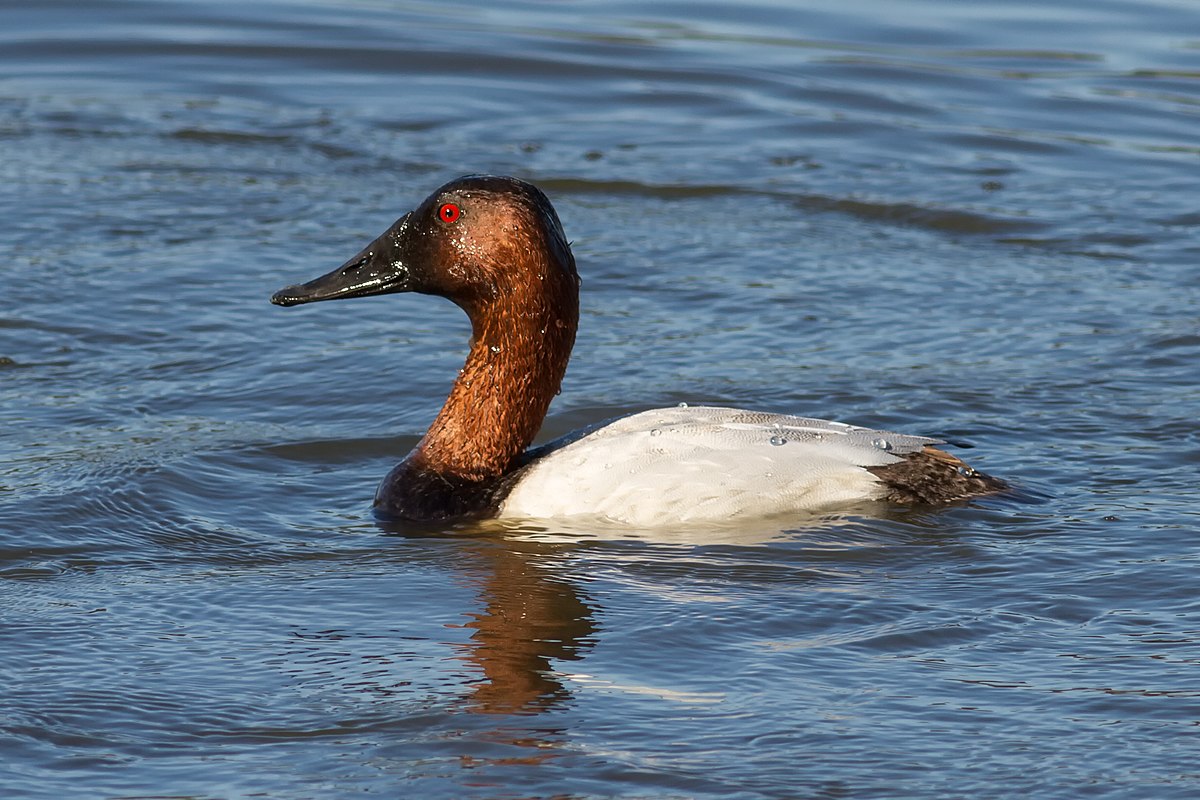
Wikipedia: Canvasback Source: OTHER
1200px-Aythya_valisineria_at_Las_Gallinas_Wildlife_Ponds.jpg
![]() The canvasback (Aythya valisineria) is a species of diving duck, the largest found in North America.
[more]
The canvasback (Aythya valisineria) is a species of diving duck, the largest found in North America.
[more]

Wikipedia: Ring-necked duck Source: OTHER
Aythya-collaris-001.jpg
![]() The ring-necked duck (Aythya collaris) is a diving duck from North America commonly found in freshwater ponds and lakes.[2] The scientific name is derived from Greek aithuia, an unidentified seabird mentioned by authors including Hesychius and Aristotle, and Latin collaris, "of the neck" from collum, "neck".[3]
[more]
The ring-necked duck (Aythya collaris) is a diving duck from North America commonly found in freshwater ponds and lakes.[2] The scientific name is derived from Greek aithuia, an unidentified seabird mentioned by authors including Hesychius and Aristotle, and Latin collaris, "of the neck" from collum, "neck".[3]
[more]
Nilgans am Südende des Greifensee 2021-02-08 15.21.56
First observed in Botswana on 2016-09-24.
This bird appears across the great seas in the following continents:
Europe, North America, Africa.
Wintergast am Greifensee. Invasiv. Nach Vogelwarte.ch: 'als Ziervogel im 18. Jahrhundert in Europa eingeführt...
Ausgehend von einer in den 1970er Jahren in den Niederlanden und Belgien gebildeten Population breitete sich die Nilgans rasant dem Rhein und seinen Nebenflüssen entlang aus und hat inzwischen auch die Schweiz erreicht.
Vocalization: ![]() Quite vocal when interacting. [Link]
Quite vocal when interacting. [Link]
Calls: ![]() Female calls may resemble RS, but are coarser, harder and trills are more rolling. Single calls are longer, and falls markedly in pitch. Male calls quite different, with husky, wheezing or hissing "kaahhh", or with the same timbre in series lika a steam engine. [Link]
Female calls may resemble RS, but are coarser, harder and trills are more rolling. Single calls are longer, and falls markedly in pitch. Male calls quite different, with husky, wheezing or hissing "kaahhh", or with the same timbre in series lika a steam engine. [Link]
Physical details: length=63-73 cm,
wingspan=134-154 cm,
weight=1500-2250 g

Wikipedia: Mandarin duck Source: OTHER
1200px-Aix_galericulata_-_Z%C3%BCrich_-_Hafen_Riesbach_2011-01-14_15-58-32.JPG
This bird appears across the great seas in the following continents:
Europe, North America, Africa.
Deutschland: etabliertes Neozoon, Brut-, Jahresvogel
Vocalization: ![]() Other sounds include a short and sharp, coot-like "ket", and a short "ack". [Link]
Other sounds include a short and sharp, coot-like "ket", and a short "ack". [Link]
Calls: ![]() Display call a thin, whistling and rapidly rising "hueessst, accompanied by deeper clappering sounds. [Link]
Display call a thin, whistling and rapidly rising "hueessst, accompanied by deeper clappering sounds. [Link]
Physical details: length=41-49 cm,
wingspan=68-74 cm,
weight=571-608 g
Habitats:
River and lake
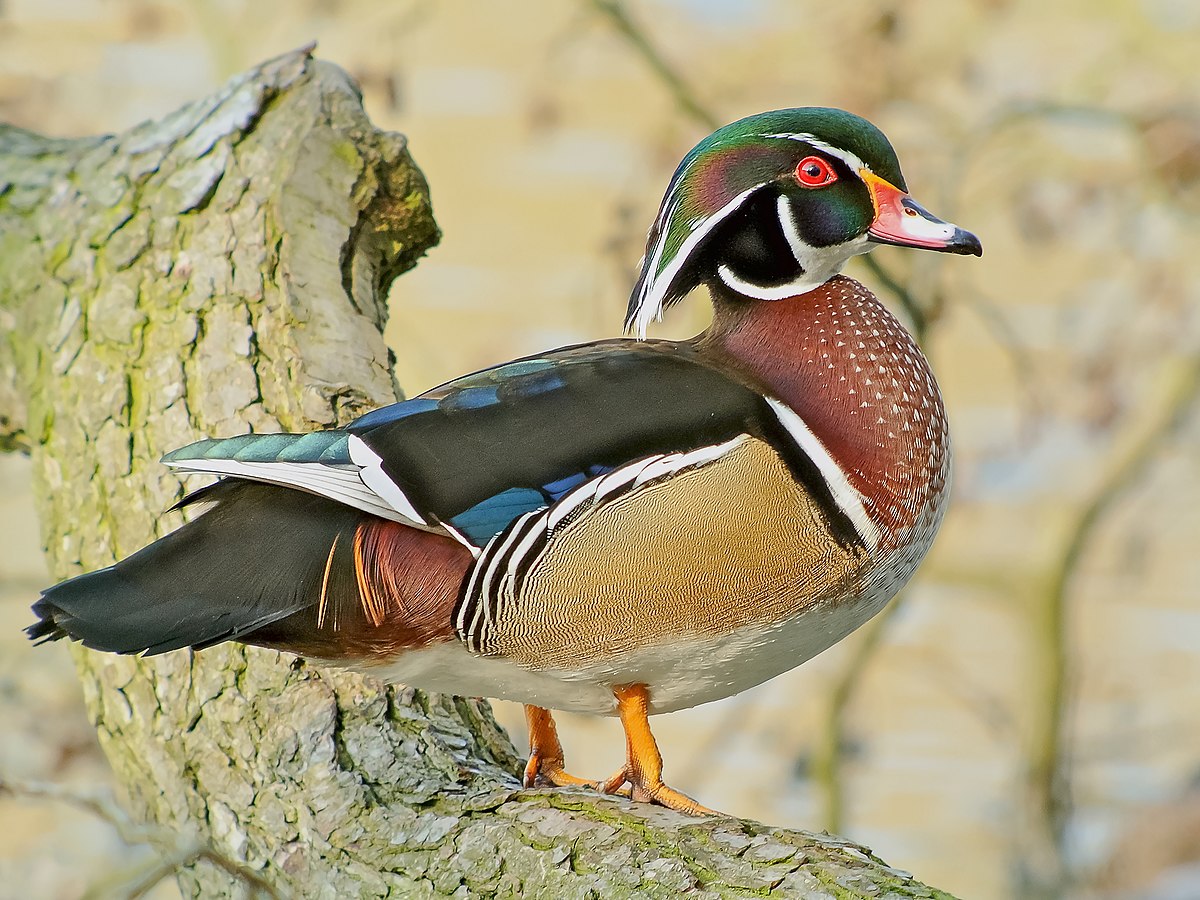
Wikipedia: Wood duck Source: OTHER
1200px-Wood_Duck_%28Aix_sponsa%29%2C_Parc_du_Rouge-Clo%C3%AEtre%2C_Brussels.jpg
This bird appears across the great seas in the following continents:
Europe, North America.
General: ![]() The wood duck or Carolina duck (Aix sponsa) is a species of perching duck found in North America. It is one of the most colorful North American waterfowl.[2][3]
[more]
The wood duck or Carolina duck (Aix sponsa) is a species of perching duck found in North America. It is one of the most colorful North American waterfowl.[2][3]
[more]

Wikipedia: Muscovy duck Source: OTHER
MuscovyDuck.jpg
![]() The Muscovy duck (Cairina moschata) is a large duck native to Mexico and Central and South America. Small wild and feral breeding populations have established themselves in the United States, particularly in Florida, Louisiana, Massachusetts, and the lower Rio Grande Valley of Texas, the Big Island of Hawaii, as well as in many other parts of North America, including southern Canada. Feral Muscovy ducks are found in New Zealand, Australia, and in parts of Europe.
[more]
The Muscovy duck (Cairina moschata) is a large duck native to Mexico and Central and South America. Small wild and feral breeding populations have established themselves in the United States, particularly in Florida, Louisiana, Massachusetts, and the lower Rio Grande Valley of Texas, the Big Island of Hawaii, as well as in many other parts of North America, including southern Canada. Feral Muscovy ducks are found in New Zealand, Australia, and in parts of Europe.
[more]
Profile Wikipedia eBird Audubon AllAboutBirds Xeno-Canto NABU
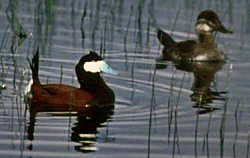
Wikipedia: Ruddy duck Source: OTHER
Oxyura_jamaicensis_FWS.jpg
This bird appears across the great seas in the following continents:
Europe, North America, South America.
Deutschland: eingebürgertes Neozoon, ausnahmsweise Brutvogel
Profile Wikipedia eBird Vogelwarte BirdLife ZH ornitho.ch Audubon AllAboutBirds Xeno-Canto NABU

Wikipedia: Long-tailed duck Source: OTHER
Long-tailed-duck.jpg
This bird appears across the great seas in the following continents:
Europe, North America.
Deutschland: Zugvogel, Wintergast
Habitats:
River and lake

Wikipedia: Surf scoter Source: OTHER
Melanitta_perspicillata.jpg
General: ![]() The surf scoter (Melanitta perspicillata) is a large sea duck native to North America.[2] Adult males are almost entirely black with characteristic white patches on the forehead and the nape and adult females are slightly smaller and browner.[3] Surf scoters breed in Northern Canada and Alaska and winter along the Pacific and Atlantic coasts of North America.[2] Those diving ducks mainly feed on benthic invertebrates, mussels representing an important part of their diet.[3]
[more]
The surf scoter (Melanitta perspicillata) is a large sea duck native to North America.[2] Adult males are almost entirely black with characteristic white patches on the forehead and the nape and adult females are slightly smaller and browner.[3] Surf scoters breed in Northern Canada and Alaska and winter along the Pacific and Atlantic coasts of North America.[2] Those diving ducks mainly feed on benthic invertebrates, mussels representing an important part of their diet.[3]
[more]
Profile Wikipedia eBird Audubon AllAboutBirds Xeno-Canto NABU

Wikipedia: White-winged scoter Source: OTHER
White-winged_Scoter.jpg
This bird appears across the great seas in the following continents:
Europe, North America.
![]() Melanitta fusca deglandi
[more]
Melanitta fusca deglandi
[more]
This bird appears across the great seas in the following continents:
Europe, North America.
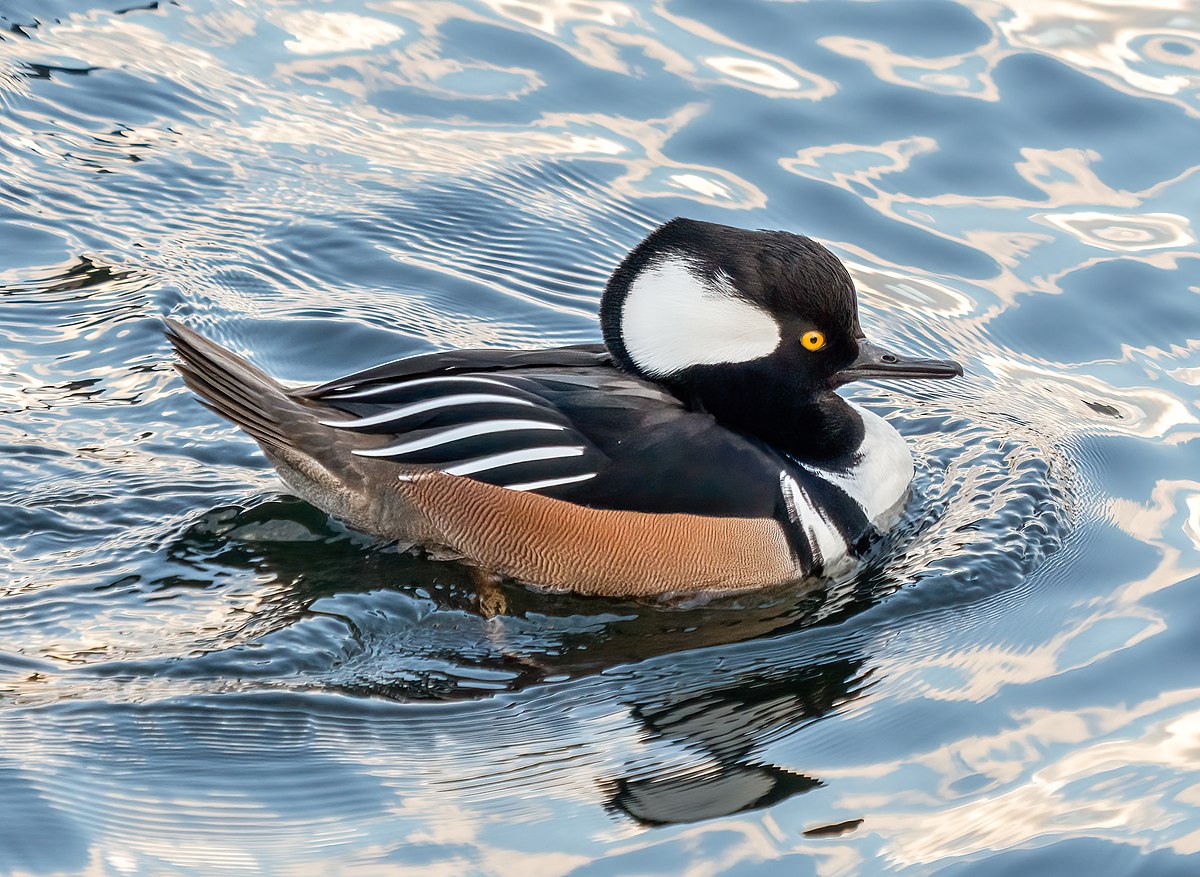
Wikipedia: Hooded merganser Source: OTHER
1200px-Hooded_merganser_male_in_Central_Park_%2895790%29.jpg
![]() The hooded merganser (Lophodytes cucullatus) is a species of merganser. It is the only extant species in the genus Lophodytes. The genus name derives from the Greek language: lophos meaning 'crest', and dutes meaning 'diver'.[2] The bird is striking in appearance; both sexes have crests that they can raise or lower, and the breeding plumage of the male is handsomely patterned and coloured. The hooded merganser has a sawbill but is not classified as a typical merganser.
[more]
The hooded merganser (Lophodytes cucullatus) is a species of merganser. It is the only extant species in the genus Lophodytes. The genus name derives from the Greek language: lophos meaning 'crest', and dutes meaning 'diver'.[2] The bird is striking in appearance; both sexes have crests that they can raise or lower, and the breeding plumage of the male is handsomely patterned and coloured. The hooded merganser has a sawbill but is not classified as a typical merganser.
[more]
White-fronted goose closeup, on the way home from Laphroiag? 2023-08-11 13.38.38 Islay
First observed in Islay on 2023-08-11.
This bird appears across the great seas in the following continents:
Europe, North America, Africa.
Deutschland: Zugvogel, Wintergast Bruten gehen auf entflogene Tiere zurück
Habitats:
River and lake
General: ![]() Die Zwergschneegans (Anser rossii), auch Ross-Schneegans, ist eine in Nordamerika einheimische Art der Feldgänse und gehört damit zu den echten Gänsen (Anserini). Sie wird zuweilen auch mit der Schneegans (Anser caerulescens), der Kaisergans (Anser canagicus) und der Streifengans (Anser indicus) in eine eigene Gattung mit dem wissenschaftlichen Namen Chen gestellt. Sie ist die kleinste der arktischen Gänse. Die Art wurde erstmals 1861 durch J. Cassin wissenschaftlich beschrieben.
[more]
Die Zwergschneegans (Anser rossii), auch Ross-Schneegans, ist eine in Nordamerika einheimische Art der Feldgänse und gehört damit zu den echten Gänsen (Anserini). Sie wird zuweilen auch mit der Schneegans (Anser caerulescens), der Kaisergans (Anser canagicus) und der Streifengans (Anser indicus) in eine eigene Gattung mit dem wissenschaftlichen Namen Chen gestellt. Sie ist die kleinste der arktischen Gänse. Die Art wurde erstmals 1861 durch J. Cassin wissenschaftlich beschrieben.
[more]

Wikipedia: Snow goose Source: OTHER
1200px-Snow_goose_in_Central_Park_%2833138%29.jpg
This bird appears across the great seas in the following continents:
Europe, North America.
![]() The snow goose (Anser caerulescens) is a species of goose native to North America. Both white and dark morphs exist, the latter often known as blue goose. Its name derives from the typically white plumage. The species was previously placed in the genus Chen, but is now typically included in the "gray goose" genus Anser.[2][3]
[more]
The snow goose (Anser caerulescens) is a species of goose native to North America. Both white and dark morphs exist, the latter often known as blue goose. Its name derives from the typically white plumage. The species was previously placed in the genus Chen, but is now typically included in the "gray goose" genus Anser.[2][3]
[more]
Canada goose. 2022-05-01 09.55.20 Maryland
First observed in Maryland on 2022-05-01.
This bird appears across the great seas in the following continents:
Europe, North America, Australia.
vagrant, presumably from introduced NZ population
Vocalization: ![]() Trumpet like, resonant, honking sounds. Closer to Whooper Swans than many of the other geese. [Link]
Trumpet like, resonant, honking sounds. Closer to Whooper Swans than many of the other geese. [Link]
Physical details: length=80-105 cm,
wingspan=160-175 cm,
weight=3670-5410 g
Call:
Automatically generated from Xeno-Canto recording
♫ Source: BirdNet
20220503_104414 birdnet - Canada Goose - 2022-05-03 10:44:14 - Canada Goose - Cockeysville.mp3
2022-05-03 10.44.14 Cockeysville (song?)
Blue-winged teal (Spatula discors)
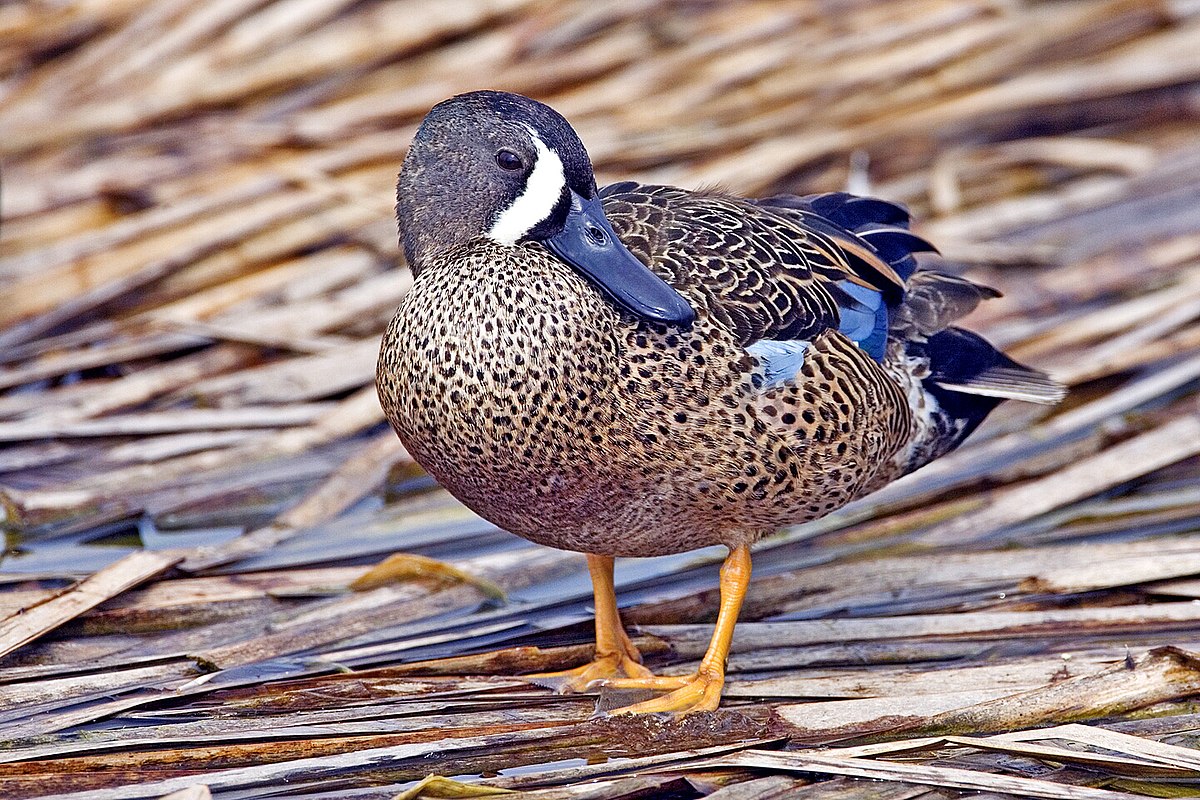
Wikipedia: Blue-winged teal Source: OTHER
1200px-Blue-Winged_Teal.jpg
General: ![]() The blue-winged teal (Spatula discors) is a species of bird in the duck, goose, and swan family Anatidae. One of the smaller members of the dabbling duck group, it occurs in North America, where it breeds from southern Alaska to Nova Scotia, and south to northern Texas. It winters along the Pacific and Atlantic coasts and south into the Caribbean islands and Central America.
[more]
The blue-winged teal (Spatula discors) is a species of bird in the duck, goose, and swan family Anatidae. One of the smaller members of the dabbling duck group, it occurs in North America, where it breeds from southern Alaska to Nova Scotia, and south to northern Texas. It winters along the Pacific and Atlantic coasts and south into the Caribbean islands and Central America.
[more]
Cinnamon teal (alternate) / Zimtente (Spatula cyanoptera)
![]() Die Zimtente (Spatula cyanoptera, Syn.: Anas cyanoptera), selten auch Kupferente genannt, zählt mit ihren fünf Unterarten zur Familie der Entenvögel (Anatidae) und gehört dort zur Gattung Spatula. Die Zimtente ist eine Entenart der Neuen Welt und in Nord- und Südamerika weit verbreitet. Sie gleicht in vielem der nordamerikanischen Blauflügelente, mit der sie eng verwandt ist. Die Weibchen der beiden Arten sind anhand ihres Gefieders kaum voneinander zu unterscheiden. Der Schnabel der Zimtente ist allerdings lang und breit ausgezogen und gleicht dem der Löffelente. Zimtenten suchen ihre Nahrung entsprechend ähnlich der Löffelente.[1]
[more]
Die Zimtente (Spatula cyanoptera, Syn.: Anas cyanoptera), selten auch Kupferente genannt, zählt mit ihren fünf Unterarten zur Familie der Entenvögel (Anatidae) und gehört dort zur Gattung Spatula. Die Zimtente ist eine Entenart der Neuen Welt und in Nord- und Südamerika weit verbreitet. Sie gleicht in vielem der nordamerikanischen Blauflügelente, mit der sie eng verwandt ist. Die Weibchen der beiden Arten sind anhand ihres Gefieders kaum voneinander zu unterscheiden. Der Schnabel der Zimtente ist allerdings lang und breit ausgezogen und gleicht dem der Löffelente. Zimtenten suchen ihre Nahrung entsprechend ähnlich der Löffelente.[1]
[more]

Wikipedia: Fulvous whistling-duck Source: OTHER
1200px-Dendrocygna_bicolor_wilhelma.jpg
This bird appears across the great seas in the following continents:
North America, South America, Africa.
![]() The fulvous whistling duck or fulvous tree duck (Dendrocygna bicolor) is a species of whistling duck that breeds across the world's tropical regions in much of Mexico and South America, the West Indies, the southern United States, sub-Saharan Africa and the Indian subcontinent. It has plumage that is mainly reddish brown, long legs and a long grey bill, and shows a distinctive white band across its black tail in flight. Like other members of its ancient lineage, it has a whistling call which is given in flight or on the ground. Its preferred habitat consists of wetlands with plentiful vegetation, including shallow lakes and paddy fields.
The nest, built from plant material and unlined, is placed among dense vegetation or in a tree hole. The typical clutch is around ten whitish eggs. The breeding adults, which pair for life, take turns to incubate, and the eggs hatch in 24–29 days. The downy grey ducklings leave the nest within a day or so of hatching, but the parents continue to protect them until they fledge around nine weeks later.
[more]
The fulvous whistling duck or fulvous tree duck (Dendrocygna bicolor) is a species of whistling duck that breeds across the world's tropical regions in much of Mexico and South America, the West Indies, the southern United States, sub-Saharan Africa and the Indian subcontinent. It has plumage that is mainly reddish brown, long legs and a long grey bill, and shows a distinctive white band across its black tail in flight. Like other members of its ancient lineage, it has a whistling call which is given in flight or on the ground. Its preferred habitat consists of wetlands with plentiful vegetation, including shallow lakes and paddy fields.
The nest, built from plant material and unlined, is placed among dense vegetation or in a tree hole. The typical clutch is around ten whitish eggs. The breeding adults, which pair for life, take turns to incubate, and the eggs hatch in 24–29 days. The downy grey ducklings leave the nest within a day or so of hatching, but the parents continue to protect them until they fledge around nine weeks later.
[more]

Wikipedia: Black-bellied whistling-duck Source: OTHER
1200px-Whistling_duck_flight02_-_natures_pics-edit1.jpg
![]() The black-bellied whistling duck (Dendrocygna autumnalis), formerly called the black-bellied tree duck, is a whistling duck that breeds from the southernmost United States, Mexico, and tropical Central to south-central South America. In the US, it can be found year-round in peninsular Florida, parts of southeast Texas, coastal Alabama and seasonally in southeast Arizona, and Louisiana's Gulf Coast. It is a rare breeder in such disparate locations as Arkansas, Georgia, Tennessee, and South Carolina, though it is now a common breeder in parts of central Florida. There is a large population of several hundred that winter each year in Audubon Park in uptown New Orleans, Louisiana. Since it is one of only two whistling duck species native to North America, it is occasionally just known as the "whistling duck" or "Mexican squealer" in the southern USA.
[more]
The black-bellied whistling duck (Dendrocygna autumnalis), formerly called the black-bellied tree duck, is a whistling duck that breeds from the southernmost United States, Mexico, and tropical Central to south-central South America. In the US, it can be found year-round in peninsular Florida, parts of southeast Texas, coastal Alabama and seasonally in southeast Arizona, and Louisiana's Gulf Coast. It is a rare breeder in such disparate locations as Arkansas, Georgia, Tennessee, and South Carolina, though it is now a common breeder in parts of central Florida. There is a large population of several hundred that winter each year in Audubon Park in uptown New Orleans, Louisiana. Since it is one of only two whistling duck species native to North America, it is occasionally just known as the "whistling duck" or "Mexican squealer" in the southern USA.
[more]
Neotropic cormorant (alternate) (Nannopterum brasilianum)
Great egret / Silberreiher (Ardea alba)

Silberreiher in Deutschland, von WikiCommons Von Andreas Eichler, CC BY-SA 4.0, https://commons.wikimedia.org/w/index.php?curid=59954907 Source: OTHER
Wikicommons 2016.10.30--Silberreiher.jpg
First observed in 🇨🇭 on 2021-02-24.
This bird appears across the great seas in the following continents:
Europe, North America, South America, Africa, Asia.
Auf dem Heimweg von Schwanden haben wir bei Benken ganz weisse Reiher gesehen.
Laut ornitho.ch waren sie Silberreiher.
Bei den meisten Quellen heisst es, sie sind in der Schweiz nur Durchzüger oder Wintergäste.
Aber laut Balzari und Gygax, brüten auch einige Vögel am Lac Neuchatel seit 2013.
Vocalization: ![]() Silent outside breeding ground. [Link]
Silent outside breeding ground. [Link]
Calls: ![]() In colonies various harsh calls like a dry, and mechanical "kerrrrrrr", and a very nasal "geet" or "ga-geet ga-geet" are heard. [Link]
In colonies various harsh calls like a dry, and mechanical "kerrrrrrr", and a very nasal "geet" or "ga-geet ga-geet" are heard. [Link]
Physical details: length=85-102 cm,
wingspan=140-170 cm,
weight=960-1030 g
Habitats:
Wetland
Call:
Partly an awkward quack: uck uck. Rattles. Deep-toned urrr. Higher-toned trill.
Call attributes:
Call melody: non-musical, slow, Frequency: low (1-3 KHz),
Great blue heron / Kanadareiher (Ardea herodias)
Profile Wikipedia eBird A-Z Animals Audubon AllAboutBirds Xeno-Canto
Great blue heron. 2022-04-28 18.15.08 Maryland
First observed in Maryland on 2021-06-17.
General: ![]() The great blue heron (Ardea herodias) is a large wading bird in the heron family Ardeidae, common near the shores of open water and in wetlands over most of North America and Central America, as well as the Caribbean and the Galápagos Islands. It is a rare vagrant to coastal Spain, the Azores, and areas of far southern Europe. An all-white population found in south Florida and the Florida Keys is known as the great white heron. Debate exists about whether this represents a white color morph of the great blue heron, a subspecies of it, or an entirely separate species.[2][3] The status of white individuals known to occur elsewhere in the Caribbean, and very rarely elsewhere in eastern North America, is unclear.[3]
[more]
The great blue heron (Ardea herodias) is a large wading bird in the heron family Ardeidae, common near the shores of open water and in wetlands over most of North America and Central America, as well as the Caribbean and the Galápagos Islands. It is a rare vagrant to coastal Spain, the Azores, and areas of far southern Europe. An all-white population found in south Florida and the Florida Keys is known as the great white heron. Debate exists about whether this represents a white color morph of the great blue heron, a subspecies of it, or an entirely separate species.[2][3] The status of white individuals known to occur elsewhere in the Caribbean, and very rarely elsewhere in eastern North America, is unclear.[3]
[more]
Black-crowned night-heron / Nachtreiher (Nycticorax nycticorax)

Wikipedia: Black-crowned night-heron Source: OTHER
1200px-BCNH_CMCNJ_for_Wiki.png
This bird appears across the great seas in the following continents:
Europe, North America, South America, Africa, Asia.
![]() The black-crowned night heron (Nycticorax nycticorax), or black-capped night heron, commonly shortened to just night heron in Eurasia, is a medium-sized heron found throughout a large part of the world, except in the coldest regions and Australasia (where it is replaced by the closely related nankeen night heron, with which it has hybridized in the area of contact).
[more]
The black-crowned night heron (Nycticorax nycticorax), or black-capped night heron, commonly shortened to just night heron in Eurasia, is a medium-sized heron found throughout a large part of the world, except in the coldest regions and Australasia (where it is replaced by the closely related nankeen night heron, with which it has hybridized in the area of contact).
[more]
Calls: ![]() Most commonly hear call is a nasal, soft croaking "roack", like cross between Raven and frog. [Link]
Most commonly hear call is a nasal, soft croaking "roack", like cross between Raven and frog. [Link]
Physical details: length=58-65 cm,
wingspan=105-112 cm,
weight=500-800 g
Habitats:
Wetland
Snowy egret / Schmuckreiher (Egretta thula)
Profile Wikipedia eBird Audubon AllAboutBirds Xeno-Canto
Snowy egret at John's Pass, Madeira Beach, Florida. 2023-09-27 11.51.14 Florida
First observed in Yucatan on 2023-04-15.
This bird appears across the great seas in the following continents:
North America, South America, Africa.
General: ![]() The snowy egret (Egretta thula) is a small white heron. The genus name comes from Provençal French for the little egret, aigrette, which is a diminutive of aigron, 'heron'. The species name thula is the Araucano term for the black-necked swan, applied to this species in error by Chilean naturalist Juan Ignacio Molina in 1782.[3]
[more]
The snowy egret (Egretta thula) is a small white heron. The genus name comes from Provençal French for the little egret, aigrette, which is a diminutive of aigron, 'heron'. The species name thula is the Araucano term for the black-necked swan, applied to this species in error by Chilean naturalist Juan Ignacio Molina in 1782.[3]
[more]
Little blue heron / Blaureiher (Egretta caerulea)
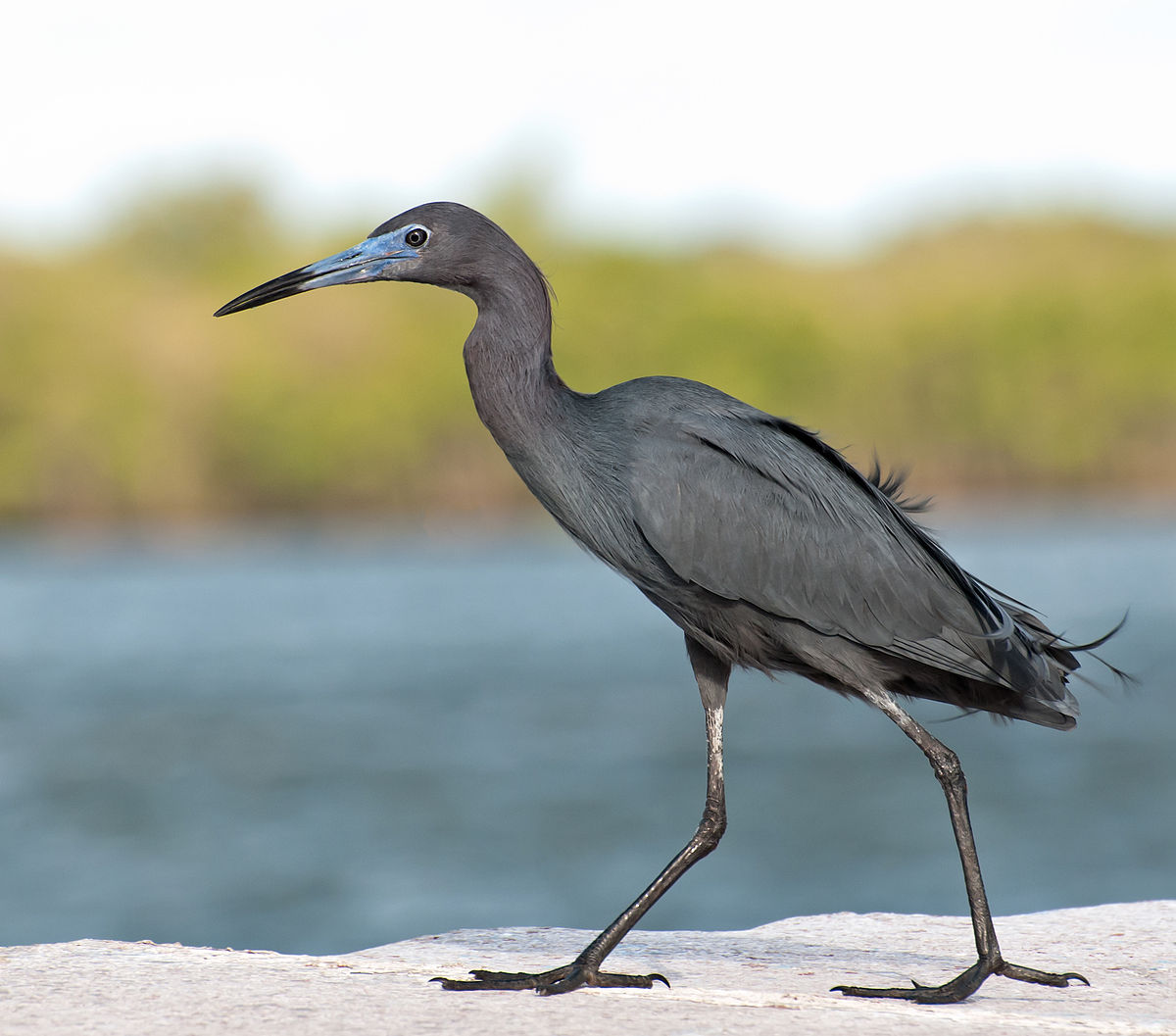
Wikipedia: Little blue heron Source: OTHER
1200px-Egretta_caerulea_-Cananeia%2C_Sao_Paulo%2C_Brasil-8.jpg
This bird appears across the great seas in the following continents:
North America, South America, Africa.
![]() The little blue heron (Egretta caerulea) is a small heron belonging to the family Ardeidae.
[more]
The little blue heron (Egretta caerulea) is a small heron belonging to the family Ardeidae.
[more]
Tricolored heron / Dreifarbenreiher (Egretta tricolor)
Profile Wikipedia eBird Audubon AllAboutBirds Xeno-Canto
Beautiful tricolored heron near Las Coloradas. 2023-04-15 10.04.30 Yucatan
First observed in Yucatan on 2023-04-15.
![]() The tricolored heron (Egretta tricolor), formerly known as the Louisiana heron, is a small species of heron native to coastal parts of the Americas; in the Atlantic region, it ranges from the northeastern United States, south along the coast, through the Gulf of Mexico and the Caribbean, to northern South America as far south as Brazil. In the Pacific region, it ranges from Peru to California, but it is only a nonbreeding visitor to the far north.
[more]
The tricolored heron (Egretta tricolor), formerly known as the Louisiana heron, is a small species of heron native to coastal parts of the Americas; in the Atlantic region, it ranges from the northeastern United States, south along the coast, through the Gulf of Mexico and the Caribbean, to northern South America as far south as Brazil. In the Pacific region, it ranges from Peru to California, but it is only a nonbreeding visitor to the far north.
[more]
Reddish egret / Rötelreiher (Egretta rufescens)
Profile Wikipedia eBird Audubon AllAboutBirds Xeno-Canto
Elegant reddish egret near Las Coloradas. 2023-04-15 10.05.52 Yucatan
First observed in Yucatan on 2023-04-15.
![]() The reddish egret (Egretta rufescens) is a medium-sized heron. It is a resident breeder in Central America, The Bahamas, the Caribbean, the Gulf Coast of the United States, and Mexico.[2] There is post-breeding dispersal to well north of the nesting range. In the past, this bird was a victim of the plume trade.
[more]
The reddish egret (Egretta rufescens) is a medium-sized heron. It is a resident breeder in Central America, The Bahamas, the Caribbean, the Gulf Coast of the United States, and Mexico.[2] There is post-breeding dispersal to well north of the nesting range. In the past, this bird was a victim of the plume trade.
[more]
Yellow-crowned night heron / Krabbenreiher (Nyctanassa violacea)
Yellow-crowned night heron in Manzanillo, Costa Rica. 2020-03-13 09.00.32 Costa Rica
First observed in Costa Rica on 2020-03-13.
![]() The yellow-crowned night heron (Nyctanassa violacea), is one of two species of night herons found in the Americas, the other one being the black-crowned night heron. It is known as the "bihoreau violacé" in French and the "pedrete corona clara" in Spanish.
[more]
The yellow-crowned night heron (Nyctanassa violacea), is one of two species of night herons found in the Americas, the other one being the black-crowned night heron. It is known as the "bihoreau violacé" in French and the "pedrete corona clara" in Spanish.
[more]
American bittern / Nordamerikanische Rohrdommel (Botaurus lentiginosus)

Wikipedia: American bittern Source: OTHER
1200px-Botaurus_lentiginosus_28079.JPG
This bird appears across the great seas in the following continents:
North America, South America, Africa.
![]() The American bittern (Botaurus lentiginosus) is a species of wading bird in the heron family. It has a Nearctic distribution, breeding in Canada and the northern and central parts of the United States, and wintering in the U.S. Gulf Coast states, all of Florida into the Everglades, the Caribbean islands and parts of Central America.
[more]
The American bittern (Botaurus lentiginosus) is a species of wading bird in the heron family. It has a Nearctic distribution, breeding in Canada and the northern and central parts of the United States, and wintering in the U.S. Gulf Coast states, all of Florida into the Everglades, the Caribbean islands and parts of Central America.
[more]
Cattle egret / Kuhreiher (Bubulcus ibis)
Cow-plus-cattle egret. 2020-03-07 15.17.34 Panama
First observed in Costa Rica on 2018-02-27.
This bird appears across the great seas in the following continents:
Europe, North America, South America, Africa, Asia.
![]() The cattle egret (Bubulcus ibis) is a cosmopolitan species of heron (family Ardeidae) found in the tropics, subtropics, and warm-temperate zones. It is the only member of the monotypic genus Bubulcus, although some authorities regard two of its subspecies as full species, the western cattle egret and the eastern cattle egret. Despite the similarities in plumage to the egrets of the genus Egretta, it is more closely related to the herons of Ardea. Originally native to parts of Asia, Africa, and Europe, it has undergone a rapid expansion in its distribution and successfully colonised much of the rest of the world in the last century.
[more]
The cattle egret (Bubulcus ibis) is a cosmopolitan species of heron (family Ardeidae) found in the tropics, subtropics, and warm-temperate zones. It is the only member of the monotypic genus Bubulcus, although some authorities regard two of its subspecies as full species, the western cattle egret and the eastern cattle egret. Despite the similarities in plumage to the egrets of the genus Egretta, it is more closely related to the herons of Ardea. Originally native to parts of Asia, Africa, and Europe, it has undergone a rapid expansion in its distribution and successfully colonised much of the rest of the world in the last century.
[more]
Vocalization: ![]() Usually silent away from breeding ground. In the colonies a chorus of various coarse sounds can be heard. Most distinct is a disyllabic "rick-rack". Other sounds includes short, guttural utterings, or drawn, harsh shrieks. [Link]
Usually silent away from breeding ground. In the colonies a chorus of various coarse sounds can be heard. Most distinct is a disyllabic "rick-rack". Other sounds includes short, guttural utterings, or drawn, harsh shrieks. [Link]
Physical details: length=48-53 cm,
wingspan=90-96 cm,
weight=300-400 g
Call:
Automatically generated from Xeno-Canto recording
♫ XC353848 - Western Cattle Egret - Bubulcus ibis - flight call - sevilla, andalucía, Spain. Source: XENOCANTO
XC353848 - Western Cattle Egret - Bubulcus ibis - flight call - sevilla, andalucía, Spain.mp3
Spain (flight call)

Call attributes:
flight call Frequency: ,
Green heron / Grünreiher (Butorides virescens)
Green heron. 2023-04-16 08.37.04 Yucatan
First observed in Yucatan on 2023-04-16.
General: ![]() The green heron (Butorides virescens) is a small heron of North and Central America. Butorides is from Middle English butor "bittern" and Ancient Greek -oides, "resembling", and virescens is Latin for "greenish".[2]
[more]
The green heron (Butorides virescens) is a small heron of North and Central America. Butorides is from Middle English butor "bittern" and Ancient Greek -oides, "resembling", and virescens is Latin for "greenish".[2]
[more]
Least bittern / Amerikanische Zwergdommel (Ixobrychus exilis)
Profile Wikipedia eBird Audubon AllAboutBirds Xeno-Canto
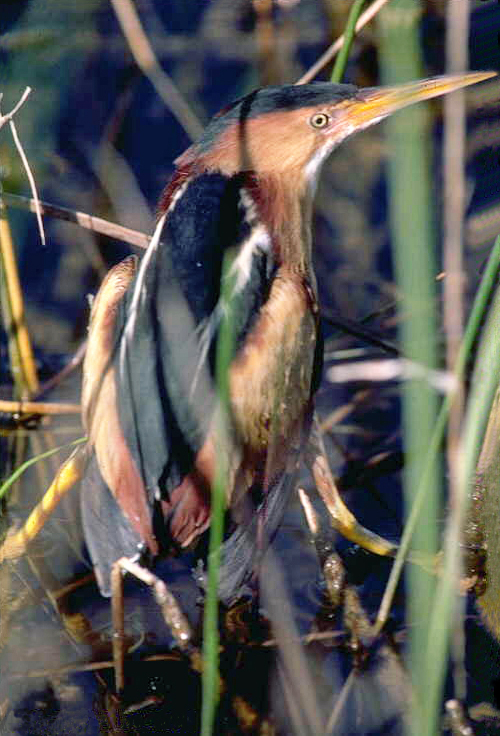
Wikipedia: Least bittern Source: OTHER
Ixobrychus_exilis.jpg
![]() The least bittern (Ixobrychus exilis) is a small heron, the smallest member of the family Ardeidae found in the Americas.
[more]
The least bittern (Ixobrychus exilis) is a small heron, the smallest member of the family Ardeidae found in the Americas.
[more]
American anhinga (Anhinga anhinga)
Wonderful patterns of an anhinga near RIo Lagartos. 2023-04-15 08.57.48 Yucatan
First observed in Yucatan on 2023-04-15.
Magnificent frigatebird / Prachtfregattvogel (Fregata magnificens)
Profile Wikipedia eBird Audubon AllAboutBirds Xeno-Canto
Magnificent frigatebirds in Puerto Morelos. 2023-03-26 13.47.02 Yucatan
First observed in Yucatan on 2023-03-26.
This bird appears across the great seas in the following continents:
North America, South America, Africa.
![]() The magnificent frigatebird (Fregata magnificens) or man o' war is a seabird of the frigatebird family Fregatidae. With a length of 89–114 centimetres (35–45 in) and wingspan of 2.17–2.44 m (7.1–8.0 ft) it is the largest species of frigatebird. It occurs over tropical and subtropical waters off America, between northern Mexico and Perú on the Pacific coast and between Florida and southern Brazil along the Atlantic coast.[1] There are also populations on the Galápagos Islands in the Pacific and the Cape Verde islands in the Atlantic.
[more]
The magnificent frigatebird (Fregata magnificens) or man o' war is a seabird of the frigatebird family Fregatidae. With a length of 89–114 centimetres (35–45 in) and wingspan of 2.17–2.44 m (7.1–8.0 ft) it is the largest species of frigatebird. It occurs over tropical and subtropical waters off America, between northern Mexico and Perú on the Pacific coast and between Florida and southern Brazil along the Atlantic coast.[1] There are also populations on the Galápagos Islands in the Pacific and the Cape Verde islands in the Atlantic.
[more]
American white pelican / Nashornpelikan (Pelecanus erythrorhynchos)

Wikipedia: American white pelican Source: OTHER
1200px-American_White_Pelican.jpg
![]() The American white pelican (Pelecanus erythrorhynchos) is a large aquatic soaring bird from the order Pelecaniformes. It breeds in interior North America, moving south and to the coasts, as far as Central America and South America, in winter.[2]
[more]
The American white pelican (Pelecanus erythrorhynchos) is a large aquatic soaring bird from the order Pelecaniformes. It breeds in interior North America, moving south and to the coasts, as far as Central America and South America, in winter.[2]
[more]
Brown pelican (Pelecanus occidentalis)
Profile Wikipedia eBird Audubon AllAboutBirds Xeno-Canto
Brown pelican, Madeira Beach, Florida. 2023-09-27 11.48.26 Florida
First observed in Panama on 2020-03-08.
![]() The brown pelican (Pelecanus occidentalis) is a bird of the pelican family, Pelecanidae, one of three species found in the Americas and one of two that feed by diving into water. It is found on the Atlantic Coast from New Jersey to the mouth of the Amazon River, and along the Pacific Coast from British Columbia to northern Chile, including the Galapagos Islands. The nominate subspecies in its breeding plumage has a white head with a yellowish wash on the crown. The nape and neck are dark maroon–brown. The upper sides of the neck have white lines along the base of the gular pouch, and the lower fore neck has a pale yellowish patch. The male and female are similar, but the female is slightly smaller. The nonbreeding adult has a white head and neck. The pink skin around the eyes becomes dull and gray in the nonbreeding season. It lacks any red hue, and the pouch is strongly olivaceous ochre-tinged and the legs are olivaceous gray to blackish-gray.
[more]
The brown pelican (Pelecanus occidentalis) is a bird of the pelican family, Pelecanidae, one of three species found in the Americas and one of two that feed by diving into water. It is found on the Atlantic Coast from New Jersey to the mouth of the Amazon River, and along the Pacific Coast from British Columbia to northern Chile, including the Galapagos Islands. The nominate subspecies in its breeding plumage has a white head with a yellowish wash on the crown. The nape and neck are dark maroon–brown. The upper sides of the neck have white lines along the base of the gular pouch, and the lower fore neck has a pale yellowish patch. The male and female are similar, but the female is slightly smaller. The nonbreeding adult has a white head and neck. The pink skin around the eyes becomes dull and gray in the nonbreeding season. It lacks any red hue, and the pouch is strongly olivaceous ochre-tinged and the legs are olivaceous gray to blackish-gray.
[more]
White-tailed tropicbird / Weißschwanz-Tropikvogel (Phaethon lepturus)
Profile Wikipedia eBird Audubon AllAboutBirds Xeno-Canto
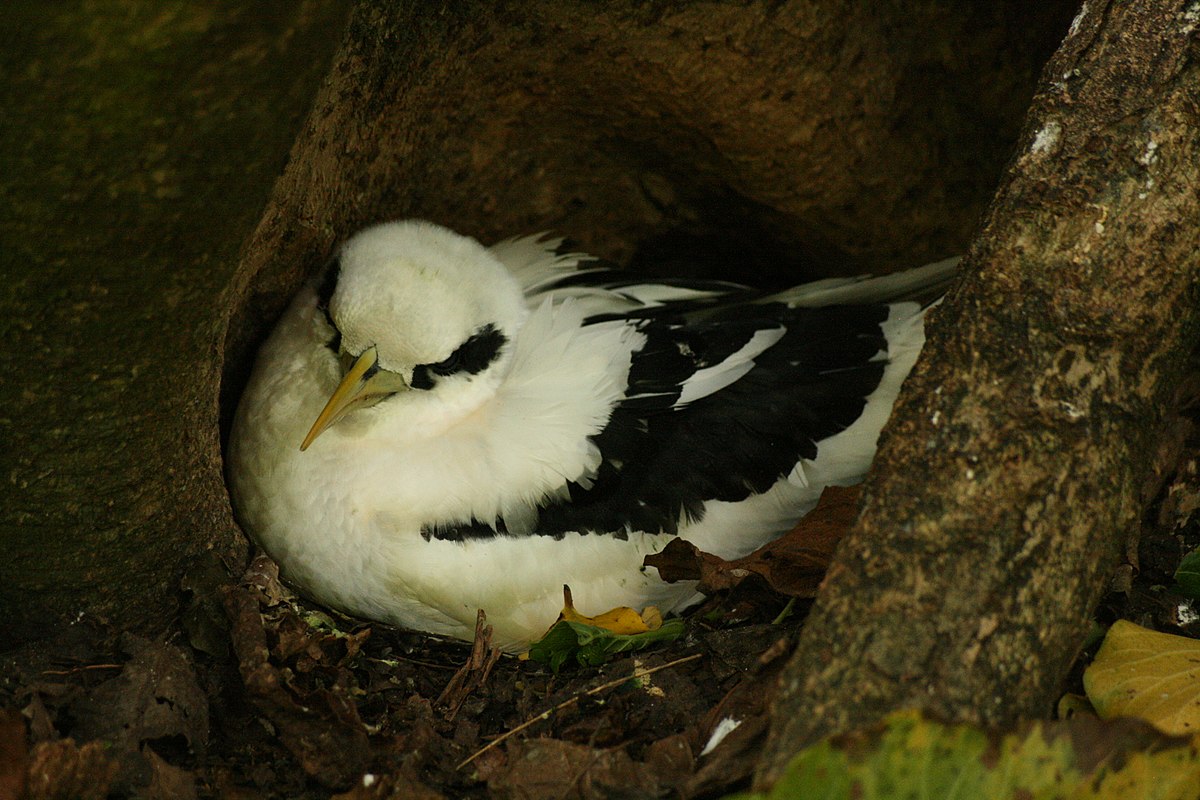
Wikipedia: White-tailed tropicbird Source: OTHER
1200px-White-tailed_Tropicbird_-_Phaeton_lepturus.jpg
This bird appears across the great seas in the following continents:
North America, Africa, Asia.
![]() The white-tailed tropicbird (Phaethon lepturus) is a species of tropicbird. It is the smallest of three closely related seabirds of the tropical oceans and smallest member of the order Phaethontiformes. It is found in the tropical Atlantic, western Pacific and Indian Oceans. It also breeds on some Caribbean islands, and a few pairs have started nesting recently on Little Tobago, joining the red-billed tropicbird colony. In addition to the tropical Atlantic, it nests as far north as Bermuda, where it is locally called a "longtail".[2]
[more]
The white-tailed tropicbird (Phaethon lepturus) is a species of tropicbird. It is the smallest of three closely related seabirds of the tropical oceans and smallest member of the order Phaethontiformes. It is found in the tropical Atlantic, western Pacific and Indian Oceans. It also breeds on some Caribbean islands, and a few pairs have started nesting recently on Little Tobago, joining the red-billed tropicbird colony. In addition to the tropical Atlantic, it nests as far north as Bermuda, where it is locally called a "longtail".[2]
[more]
Brown booby / Weißbauchtölpel (Sula leucogaster)
Profile Wikipedia eBird Audubon AllAboutBirds Xeno-Canto

Wikipedia: Brown booby Source: OTHER
1200px-Atob%C3%A1-pardo.jpg
This bird appears across the great seas in the following continents:
North America, South America, Africa, Asia.
![]() The brown booby (Sula leucogaster) is a large seabird of the booby family, Sulidae, of which it is perhaps the most common and widespread species.[3] It has a pantropical range, which overlaps with that of other booby species. The gregarious brown booby commutes and forages at low height over inshore waters. Flocks plunge-dive to take small fish, especially when these are driven near the surface by their predators. They only nest on the ground, and roost on solid objects rather than the water surface.[3]
[more]
The brown booby (Sula leucogaster) is a large seabird of the booby family, Sulidae, of which it is perhaps the most common and widespread species.[3] It has a pantropical range, which overlaps with that of other booby species. The gregarious brown booby commutes and forages at low height over inshore waters. Flocks plunge-dive to take small fish, especially when these are driven near the surface by their predators. They only nest on the ground, and roost on solid objects rather than the water surface.[3]
[more]
Masked booby (Sula dactylatra)

Wikipedia: Masked booby Source: OTHER
1200px-Starr_080606-6808_Coronopus_didymus.jpg
This bird appears across the great seas in the following continents:
North America, South America, Africa, Asia.
![]() The masked booby (Sula dactylatra), also called the masked gannet or the blue-faced booby, is a large seabird of the booby and gannet family, Sulidae. First described by the French naturalist René-Primevère Lesson in 1831, the masked booby is one of six species of booby in the genus Sula. It has a typical sulid body shape, with a long pointed yellowish bill, long neck, aerodynamic body, long slender wings and pointed tail. The adult is bright white with black wings, a black tail and a dark face mask; at 75–85 cm (30–33 in) long, it is the largest species of booby. The sexes have similar plumage. This species ranges across tropical oceans, except in the eastern Atlantic and eastern Pacific. In the latter, it is replaced by the Nazca booby (Sula granti), which was formerly regarded as a subspecies of masked booby.
[more]
The masked booby (Sula dactylatra), also called the masked gannet or the blue-faced booby, is a large seabird of the booby and gannet family, Sulidae. First described by the French naturalist René-Primevère Lesson in 1831, the masked booby is one of six species of booby in the genus Sula. It has a typical sulid body shape, with a long pointed yellowish bill, long neck, aerodynamic body, long slender wings and pointed tail. The adult is bright white with black wings, a black tail and a dark face mask; at 75–85 cm (30–33 in) long, it is the largest species of booby. The sexes have similar plumage. This species ranges across tropical oceans, except in the eastern Atlantic and eastern Pacific. In the latter, it is replaced by the Nazca booby (Sula granti), which was formerly regarded as a subspecies of masked booby.
[more]
Northern gannet / Basstölpel (Morus bassanus)

Wikipedia: Northern gannet Source: OTHER
1200px-Morus_bassanus_adu.jpg
This bird appears across the great seas in the following continents:
Europe, North America, Africa.
Deutschland: Brut-, Jahres-, Zugvogel, Wintergast RL R
Vocalization: ![]() Heard mostly at breeding ground. Even, rhythmical series of harsh "harrr, harrr, harrr,". [Link]
Heard mostly at breeding ground. Even, rhythmical series of harsh "harrr, harrr, harrr,". [Link]
Physical details: length=87-100 cm,
wingspan=165-180 cm,
weight=2400-3600 g
Glossy ibis / Brauner Sichler (Plegadis falcinellus)
Sichler nach ornitho, Brauner Sichler nach Wikipedia oder Plegadis falcinellus, Neeracherried. Source: WIKIPEDIA
20220904_071146-DSC_0059 Sichler nach ornitho, Brauner Sichler nach Wikipedia oder Plegadis falcinellus, Neeracherried.JPG
2022-09-04 07.11.46
First observed in 🇨🇭 on 2022-09-04.
This bird appears across the great seas in the following continents:
Europe, North America, South America, Africa, Asia.
General: ![]() The glossy ibis (Plegadis falcinellus) is a water bird in the order Pelecaniformes and the ibis and spoonbill family Threskiornithidae. The scientific name derives from Ancient Greek plegados and Latin, falcis, both meaning "sickle" and referring to the distinctive shape of the bill.[2]
[more]
The glossy ibis (Plegadis falcinellus) is a water bird in the order Pelecaniformes and the ibis and spoonbill family Threskiornithidae. The scientific name derives from Ancient Greek plegados and Latin, falcis, both meaning "sickle" and referring to the distinctive shape of the bill.[2]
[more]
Vocalization: ![]() Generally silent away from breeding ground. Dry, crow-like "garr garr", may be heard occasionally in flight. At breeding ground various guttural grunts, and piping, hissing sounds. [Link]
Generally silent away from breeding ground. Dry, crow-like "garr garr", may be heard occasionally in flight. At breeding ground various guttural grunts, and piping, hissing sounds. [Link]
Physical details: length=55-65 cm,
wingspan=80-95 cm,
weight=530-768 g
White-faced ibis / Brillensichler (Plegadis chihi)
Profile Wikipedia eBird Audubon AllAboutBirds Xeno-Canto
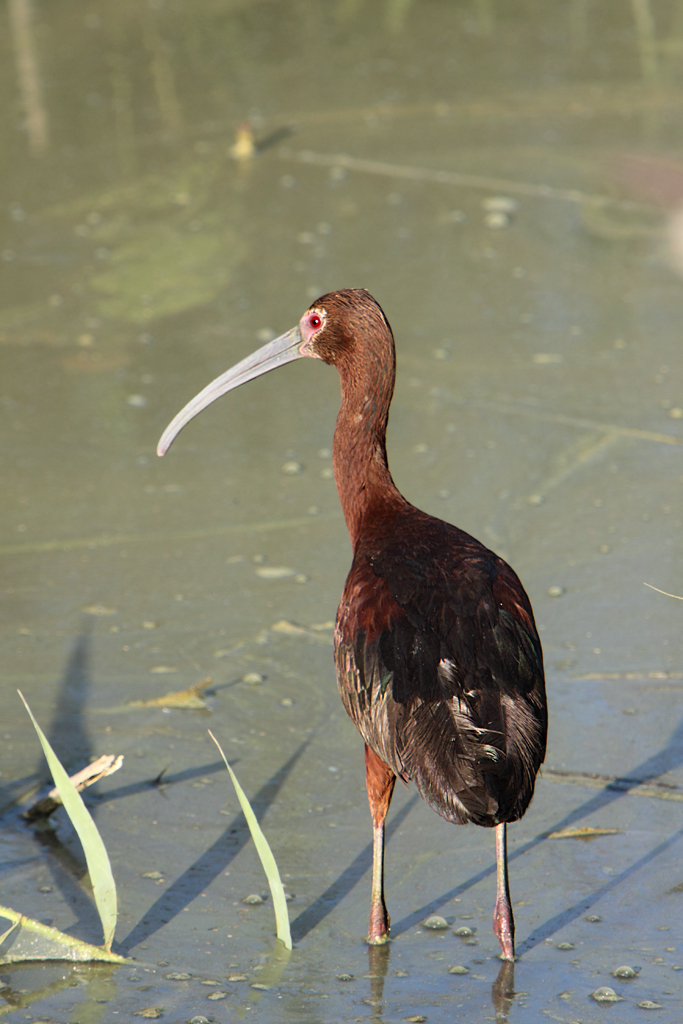
Wikipedia: White-faced ibis Source: OTHER
White-faced_Ibis_Great_Salt_Lake_1.jpg
General: ![]() The white-faced ibis (Plegadis chihi) is a wading bird in the ibis family, Threskiornithidae.
[more]
The white-faced ibis (Plegadis chihi) is a wading bird in the ibis family, Threskiornithidae.
[more]
Roseate spoonbill / Rosalöffler (Platalea ajaja)
Roseate spoonbills near Rio Lagartos. 2023-04-15 08.56.42 Yucatan
First observed in Yucatan on 2023-04-15.
![]() The roseate spoonbill (Platalea ajaja) is a gregarious wading bird of the ibis and spoonbill family, Threskiornithidae. It is a resident breeder in South America mostly east of the Andes, and in coastal regions of the Caribbean, Central America, Mexico, the Gulf Coast of the United States,[2][3] and from central Florida's Atlantic coast[4] at Merritt Island National Wildlife Refuge, adjoined with NASA Kennedy Space Center at least as far north as South Carolina's Myrtle Beach.[5]
[more]
The roseate spoonbill (Platalea ajaja) is a gregarious wading bird of the ibis and spoonbill family, Threskiornithidae. It is a resident breeder in South America mostly east of the Andes, and in coastal regions of the Caribbean, Central America, Mexico, the Gulf Coast of the United States,[2][3] and from central Florida's Atlantic coast[4] at Merritt Island National Wildlife Refuge, adjoined with NASA Kennedy Space Center at least as far north as South Carolina's Myrtle Beach.[5]
[more]
White ibis (Eudocimus albus)
Profile Wikipedia eBird Audubon AllAboutBirds Xeno-Canto
White ibises in flight, St Petersburg. 2023-09-23 19.16.50 Florida
First observed in Florida on 2023-09-23.
Profile Wikipedia eBird A-Z Animals Audubon AllAboutBirds Xeno-Canto

Wikipedia: Golden-crowned kinglet Source: OTHER
Regulus_satrapa_-Canada-8a.jpg
![]() The golden-crowned kinglet (Regulus satrapa) is a very small songbird in the family Regulidae that lives throughout much of North America.
[more]
The golden-crowned kinglet (Regulus satrapa) is a very small songbird in the family Regulidae that lives throughout much of North America.
[more]
Profile Wikipedia eBird Audubon AllAboutBirds Xeno-Canto
Five red-whiskered bulbuls. 2024-02-10 15.05.58 Laos
First observed in Thailand on 2024-01-21.
This bird appears across the great seas in the following continents:
North America, Asia, Australia.
introduced
Call:
Automatically generated from Xeno-Canto recording
♫ XC776525 - Red-whiskered Bulbul - Pycnonotus jocosus pattani. Source: XENOCANTO
XC776525 - Red-whiskered Bulbul - Pycnonotus jocosus pattani.mp3
(song?)

Profile Wikipedia eBird A-Z Animals Vogelwarte BirdLife ZH ornitho.ch bird-song.ch Audubon AllAboutBirds Xeno-Canto BirdID NABU
Barn swallow. 2022-05-05 09.41.44 Maryland
First observed in 🇨🇭 on 2020-04-16.
This bird appears across the great seas in the following continents:
Europe, North America, South America, Africa, Asia.
Die langen Schwanzfedern vom Rauchschwalbe und anderen geben auch dem Schmetterling Schwalbenschwanz seine deutschen Namen.
Etymology: ![]() In früheren Jahrhunderten flogen sie vielfach durch die Öffnungen im Giebel ein und aus, durch die auch der Rauch des Herdfeuers abzog. So erhielten sie den Namen Rauchschwalben. [Link]
In früheren Jahrhunderten flogen sie vielfach durch die Öffnungen im Giebel ein und aus, durch die auch der Rauch des Herdfeuers abzog. So erhielten sie den Namen Rauchschwalben. [Link]
Appearance and identification: ![]() Rauchschwalbes Bauch ist etwas braun rot, nicht weiss wie der von der Mehlschwalbe - was wahrscheinlich Quelle der zwei Namen ist. [Link]
Rauchschwalbes Bauch ist etwas braun rot, nicht weiss wie der von der Mehlschwalbe - was wahrscheinlich Quelle der zwei Namen ist. [Link]
Song: ![]() Characteristic calls and song. Song a sparkling, squeaky energetic improvisation with interspersed contact calls, often with diagnostic ending; an electric and drawn-out "su-eerrrrrrrrrrrrrrr". [Link]
Characteristic calls and song. Song a sparkling, squeaky energetic improvisation with interspersed contact calls, often with diagnostic ending; an electric and drawn-out "su-eerrrrrrrrrrrrrrr". [Link]
Calls: ![]() Contact call a short and sharp "weet" or "kee-weet". [Link]
Contact call a short and sharp "weet" or "kee-weet". [Link]
Physical details: length=17-19 cm,
wingspan=32-34 cm,
weight=16-22 g
Habitats:
Settlement
Looks similar to:
Common house martin.
Song:
General: Squeaky with occasional buzzes, usually heard in flock.
Song: ![]() Kann melodisch sein wenn einzeln gehört statt viele zusammen. [Link]
Kann melodisch sein wenn einzeln gehört statt viele zusammen. [Link]
Song attributes:
Melody: stereotype melodic, fast, Frequency: 2-6 KHz
Call:
Automatically generated from Xeno-Canto recording
♫ Barn swallows on the hunt, some quite high. 2020-08-18 13.01.00 Luppmen (song?)
Tree swallow at Cromwell. 2022-04-29 12.44.58 Maryland
First observed in Maryland on 2021-06-14.
General: ![]() The tree swallow (Tachycineta bicolor) is a migratory bird of the family Hirundinidae. Found in the Americas, the tree swallow was first described in 1807 by French ornithologist Louis Vieillot as Hirundo bicolor. It has since been moved to its current genus, Tachycineta, within which its phylogenetic placement is debated. The tree swallow has glossy blue-green upperparts, with the exception of the blackish wings and tail, and white underparts. The bill is black, the eyes dark brown, and the legs and feet pale brown. The female is generally duller than the male, and the first-year female has mostly brown upperparts, with some blue feathers. Juveniles have brown upperparts, and a grey-brown-washed breast. The tree swallow breeds in the US and Canada. It winters along southern US coasts south, along the Gulf Coast, to Panama and the northwestern coast of South America, and in the West Indies.
[more]
The tree swallow (Tachycineta bicolor) is a migratory bird of the family Hirundinidae. Found in the Americas, the tree swallow was first described in 1807 by French ornithologist Louis Vieillot as Hirundo bicolor. It has since been moved to its current genus, Tachycineta, within which its phylogenetic placement is debated. The tree swallow has glossy blue-green upperparts, with the exception of the blackish wings and tail, and white underparts. The bill is black, the eyes dark brown, and the legs and feet pale brown. The female is generally duller than the male, and the first-year female has mostly brown upperparts, with some blue feathers. Juveniles have brown upperparts, and a grey-brown-washed breast. The tree swallow breeds in the US and Canada. It winters along southern US coasts south, along the Gulf Coast, to Panama and the northwestern coast of South America, and in the West Indies.
[more]
Profile Wikipedia eBird Audubon AllAboutBirds Xeno-Canto
Could be a wild guess - MerlinBirdID says purple martin - it says identification features are (in part) best left unidentified. 2023-04-01 14.20.30 Yucatan
First observed in Yucatan on 2023-04-01.
![]() The purple martin (Progne subis) is the largest swallow in North America. Despite their name, purple martins are not truly purple. Their dark blackish-blue feathers have an iridescent sheen caused by the refraction of incident light[2] giving them a bright blue to navy blue or deep purple appearance. In some light they may even appear green in color.
[more]
The purple martin (Progne subis) is the largest swallow in North America. Despite their name, purple martins are not truly purple. Their dark blackish-blue feathers have an iridescent sheen caused by the refraction of incident light[2] giving them a bright blue to navy blue or deep purple appearance. In some light they may even appear green in color.
[more]
Profile Wikipedia eBird Audubon AllAboutBirds Xeno-Canto
Northern rough-winged swallow. 2022-05-01 09.39.08 Maryland
First observed in Maryland on 2022-05-01.
![]() The northern rough-winged swallow (Stelgidopteryx serripennis) is a small, migratory swallow. It is very similar to the southern rough-winged swallow, Stelgidopteryx ruficollis.
[more]
The northern rough-winged swallow (Stelgidopteryx serripennis) is a small, migratory swallow. It is very similar to the southern rough-winged swallow, Stelgidopteryx ruficollis.
[more]
Bank swallow. 2024-01-26 15.58.58 Thailand
First observed in Thailand on 2024-01-26.
This bird appears across the great seas in the following continents:
Europe, North America, South America, Africa, Asia.
![]() The sand martin (Riparia riparia) or European sand martin, bank swallow, and collared sand martin in India, is a migratory passerine bird in the swallow family. It has a wide range in summer, embracing practically the whole of Europe and the Mediterranean countries and across the Palearctic to the Pacific Ocean. It is a Holarctic species also found in North America. It winters in eastern and southern Africa, South America, and the Indian Subcontinent.
[more]
The sand martin (Riparia riparia) or European sand martin, bank swallow, and collared sand martin in India, is a migratory passerine bird in the swallow family. It has a wide range in summer, embracing practically the whole of Europe and the Mediterranean countries and across the Palearctic to the Pacific Ocean. It is a Holarctic species also found in North America. It winters in eastern and southern Africa, South America, and the Indian Subcontinent.
[more]
Song: ![]() Song a primitive improvisation on the contact call. [Link]
Song a primitive improvisation on the contact call. [Link]
Calls: ![]() Contact call a mono- or disyllabic "trrrrt". Similar to House Martin but more raucous and less crisp, with less rolling r's, and with stable pitch throughout. Alarm call similar to House Martin; a sharp plaintive "tseep", but somewhat purer and more drawn. [Link]
Contact call a mono- or disyllabic "trrrrt". Similar to House Martin but more raucous and less crisp, with less rolling r's, and with stable pitch throughout. Alarm call similar to House Martin; a sharp plaintive "tseep", but somewhat purer and more drawn. [Link]
Physical details: length=12 cm,
wingspan=26-29 cm,
weight=11-16 g
Habitats:
Wetland
Song:
Fast raspy one-noter.
Song attributes:
Melody: non-musical, fast, Frequency: 1-7 KHz Special sounds: rasp
♫ Source: XENOCANTO
XC344092 - Sand Martin - Riparia riparia - raspy song but note, does not sing often.mp3
(song)


Wikipedia: Cliff swallow Source: OTHER
Petrochelidon_pyrrhonota_-flight_-Palo_Alto_Baylands-8.jpg
This bird appears across the great seas in the following continents:
Europe, North America, South America.
General: ![]() The cliff swallow or American cliff swallow (Petrochelidon pyrrhonota) is a member of the passerine bird family Hirundinidae, the swallows and martins.[2] The scientific name is derived from Ancient Greek; Petrochelidon originates from the petros meaning "rock" and khelidon "swallow", pyrrhonota comes from purrhos meaning "flame-coloured" and -notos "-backed".[3]
[more]
The cliff swallow or American cliff swallow (Petrochelidon pyrrhonota) is a member of the passerine bird family Hirundinidae, the swallows and martins.[2] The scientific name is derived from Ancient Greek; Petrochelidon originates from the petros meaning "rock" and khelidon "swallow", pyrrhonota comes from purrhos meaning "flame-coloured" and -notos "-backed".[3]
[more]
Profile Wikipedia eBird Audubon AllAboutBirds Xeno-Canto
Cave swallows at Izamal, from the name an unlikely city dweller but others also identify them as such. 2023-04-11 18.23.06 Yucatan
First observed in Yucatan on 2023-04-11.
![]() The cave swallow (Petrochelidon fulva) is a medium-sized, squarish tailed swallow belonging to the same genus as the more familiar and widespread cliff swallow of North America. The cave swallow, also native to the Americas, nests and roosts primarily in caves and sinkholes.
[more]
The cave swallow (Petrochelidon fulva) is a medium-sized, squarish tailed swallow belonging to the same genus as the more familiar and widespread cliff swallow of North America. The cave swallow, also native to the Americas, nests and roosts primarily in caves and sinkholes.
[more]
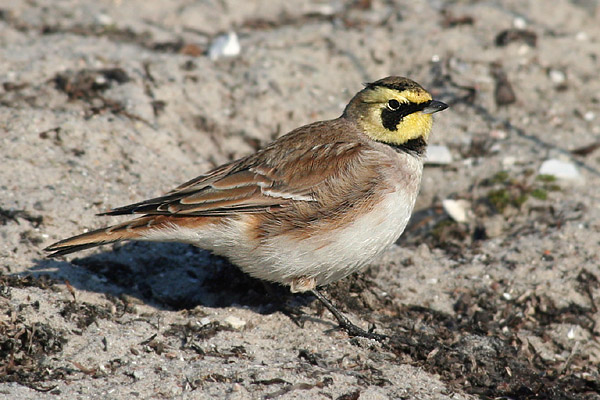
Wikipedia: Horned lark Source: OTHER
Eremophila_alpestris2.jpg
This bird appears across the great seas in the following continents:
Europe, North America, Africa.
Deutschland: Wintergast
Song: ![]() Song a stream of thin and tinkling, squeaking notes with a recurring, drawn, ringing and slightly ascending chirp. Timbre resemblant to Lapland Bunting. Often given from high in the air, being difficult to locate. More hesitantly when given from the ground with a stumbling introduction. [Link]
Song a stream of thin and tinkling, squeaking notes with a recurring, drawn, ringing and slightly ascending chirp. Timbre resemblant to Lapland Bunting. Often given from high in the air, being difficult to locate. More hesitantly when given from the ground with a stumbling introduction. [Link]
Calls: ![]() Flight call quite similar to Meadow Pipit's "tseep" call, but less anxious. [Link]
Flight call quite similar to Meadow Pipit's "tseep" call, but less anxious. [Link]
Physical details: length=14-17 cm,
wingspan=30-35 cm,
weight=26-46 g
Profile Wikipedia eBird Vogelwarte BirdLife ZH ornitho.ch bird-song.ch Audubon AllAboutBirds Xeno-Canto BirdID NABU
Pair of house sparrows in a tree near Zürichstrasse, Fehraltorf 2020-04-11 07.54.30 Luppmen
First observed in 🇨🇭 on 2019-05-14.
This bird appears across the great seas in the following continents:
Europe, North America (introduced), South America, Africa, Asia.
One of the most common birds anywhere in Europe and North America.
In Fehraltorf there are 5 house sparrows for every one tree sparrow.
Eugene Schieffelin brought house sparrows and starlings to North Ameria.
As a Shakespeare fan, it is often claimed that he wanted to introduce all species to North America that are mentioned in Shakespeare,
but apparently this is not supported by any records
Found practically everywhere. Often on the ground or on your table in a cafe (they're very bold)
or in groups in bushes and hedges
Song: ![]() Song a primitive, monosyllabic, or slightly disyllabic "chilp", hard to distinguish from Tree Sparrow. [Link]
Song a primitive, monosyllabic, or slightly disyllabic "chilp", hard to distinguish from Tree Sparrow. [Link]
Calls: ![]() Most calls very similar to Tree Sparrow, but lacks said species' distinct high pitched call (chew-itt), and alarm call is less dry and raucous. [Link]
Most calls very similar to Tree Sparrow, but lacks said species' distinct high pitched call (chew-itt), and alarm call is less dry and raucous. [Link]
Physical details: length=14-15 cm,
wingspan=21-25 cm,
weight=24-38 g
not sexually dimporphic.
No breeding plumage
Identifying characteristics:
Youth:
beak = yellow (Makes it look like a finch)
Habitats:
Settlement
Song:
An monotone chirping. Mainly 2-5 KHz with higher overtones.
Song attributes:
Melody: simple rhythmic, slow, Frequency: 2-5 KHz Singing season: 01-01 - 08-31 Dawn chorus start, 30 minutes before dawn.
Call:
Automatically generated from Xeno-Canto recording
♫ Source: BirdNet
20200507_071255 birdnet 457 - good one note recording - House sparrow.mp3
2020-05-07 07.12.55 Luppmen (song?)
House Finch on Cherrywood Court. 2022-04-28 11.03.30 Maryland
First observed in Cockeysville on 2021-06-11.
General: ![]() The house finch (Haemorhous mexicanus) is a bird in the finch family Fringillidae. It is native to western North America and has been introduced to the eastern half of the continent and Hawaii. This species and the other "American rosefinches" are placed in the genus Haemorhous.
[more]
The house finch (Haemorhous mexicanus) is a bird in the finch family Fringillidae. It is native to western North America and has been introduced to the eastern half of the continent and Hawaii. This species and the other "American rosefinches" are placed in the genus Haemorhous.
[more]
Call:
Automatically generated from Xeno-Canto recording
♫ Source: BirdNet
20210612_155654 birdnet 1622 - House Finch plus northern cardinal - House Finch - Cockeysville.mp3
2021-06-12 15.56.54 Cockeysville (song?)

Wikipedia: Purple finch Source: OTHER
1200px-Carpodacus_purpureus_CT3.jpg
![]() The purple finch (Haemorhous purpureus) is a bird in the finch family, Fringillidae.
[more]
The purple finch (Haemorhous purpureus) is a bird in the finch family, Fringillidae.
[more]
I observed something new practically every day at Cherrywood Court, hear an American goldfinch. 2021-06-17 05.49.04 Maryland
First observed in Maryland on 2021-06-17.
![]() The American goldfinch (Spinus tristis) is a small North American bird in the finch family. It is migratory, ranging from mid-Alberta to North Carolina during the breeding season, and from just south of the Canada–United States border to Mexico during the winter.
[more]
The American goldfinch (Spinus tristis) is a small North American bird in the finch family. It is migratory, ranging from mid-Alberta to North Carolina during the breeding season, and from just south of the Canada–United States border to Mexico during the winter.
[more]

Wikipedia: Pine siskin Source: OTHER
1200px-Carduelis_pinus_CT7.jpg
![]() The pine siskin (Spinus pinus) is a North American bird in the finch family. It is a migratory bird with an extremely sporadic winter range.
[more]
The pine siskin (Spinus pinus) is a North American bird in the finch family. It is a migratory bird with an extremely sporadic winter range.
[more]
Profile Wikipedia eBird A-Z Animals Audubon AllAboutBirds Xeno-Canto
Northern Cardinal, female. 2022-05-01 09.02.04 Maryland
First observed in Cockeysville on 2021-06-10.
![]() The northern cardinal (Cardinalis cardinalis) is a bird in the genus Cardinalis; it is also known colloquially as the redbird, common cardinal, red cardinal, or just cardinal (which was its name prior to 1985). It can be found in southeastern Canada, through the eastern United States from Maine to Minnesota to Texas, and south through Mexico, Belize, and Guatemala. It is also an introduced species in a few locations such as Bermuda and Hawaii. Its habitat includes woodlands, gardens, shrublands, and wetlands.
[more]
The northern cardinal (Cardinalis cardinalis) is a bird in the genus Cardinalis; it is also known colloquially as the redbird, common cardinal, red cardinal, or just cardinal (which was its name prior to 1985). It can be found in southeastern Canada, through the eastern United States from Maine to Minnesota to Texas, and south through Mexico, Belize, and Guatemala. It is also an introduced species in a few locations such as Bermuda and Hawaii. Its habitat includes woodlands, gardens, shrublands, and wetlands.
[more]
Song:
Automatically generated from Xeno-Canto recording
Song attributes:
Frequency:
♫ Morning at Cherrywood Court - northern cardinal, gray catbirds, song sparrow. 2021-06-19 07.38.01 Cherrywood (song)
Call:
Automatically generated from Xeno-Canto recording
♫ Source: BirdNet
20220503_104300 birdnet - Northern Cardinal - 2022-05-03 10:43:00 - Northern Cardinal - Cockeysville.mp3
2022-05-03 10.43.00 Cockeysville (song?)
Profile Wikipedia eBird Audubon AllAboutBirds Xeno-Canto
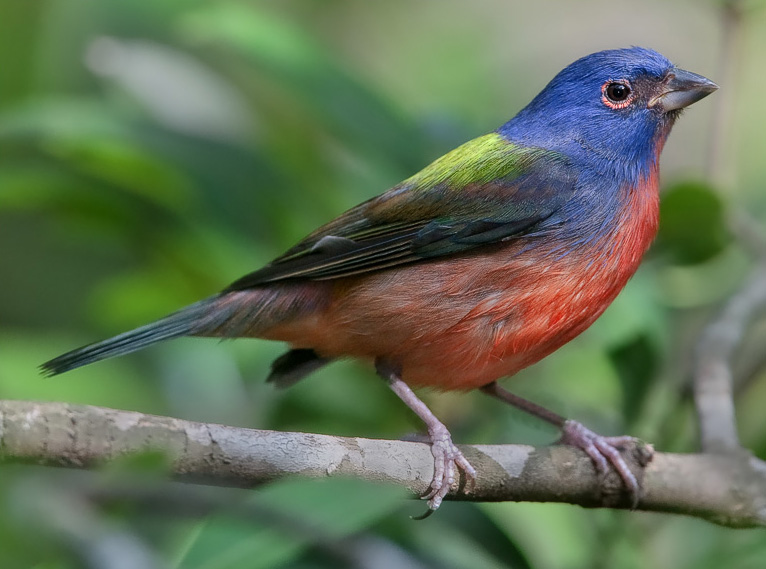
Wikipedia: Painted bunting Source: OTHER
Passerina_ciris-20090208.jpg
![]() The painted bunting (Passerina ciris) is a species of bird in the cardinal family, Cardinalidae, that is native to North America. The bright plumage of the male only comes in the second year of life; in the first year they can only be distinguished from the female by close inspection.
[more]
The painted bunting (Passerina ciris) is a species of bird in the cardinal family, Cardinalidae, that is native to North America. The bright plumage of the male only comes in the second year of life; in the first year they can only be distinguished from the female by close inspection.
[more]
Profile Wikipedia eBird Audubon AllAboutBirds Xeno-Canto
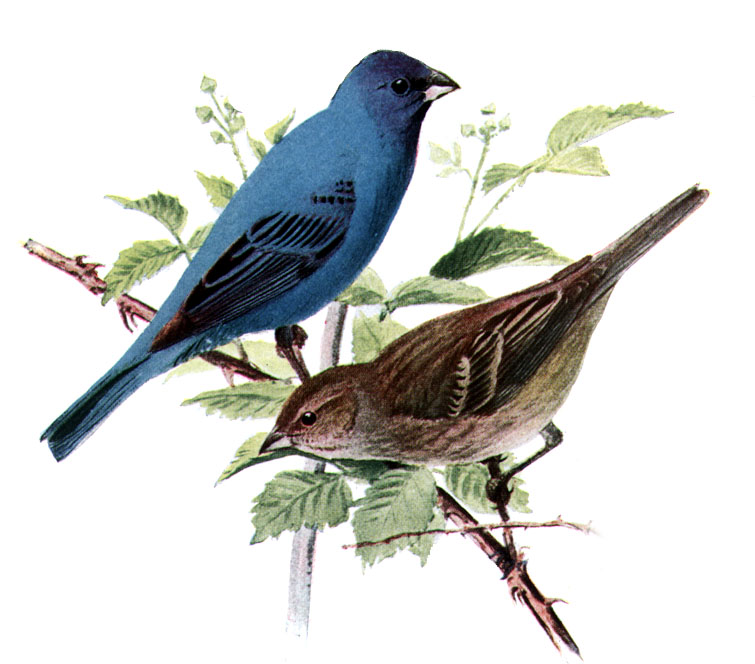
Wikipedia: Indigo bunting Source: OTHER
Passerina_cyaneaAAP086CA.jpg
![]() The indigo bunting (Passerina cyanea) is a small seed-eating bird in the cardinal family, Cardinalidae. It is migratory, ranging from southern Canada to northern Florida during the breeding season, and from southern Florida to northern South America during the winter.[2] It often migrates by night, using the stars to navigate.[3] Its habitat is farmland, brush areas, and open woodland.[4] The indigo bunting is closely related to the lazuli bunting and interbreeds with the species where their ranges overlap.
[more]
The indigo bunting (Passerina cyanea) is a small seed-eating bird in the cardinal family, Cardinalidae. It is migratory, ranging from southern Canada to northern Florida during the breeding season, and from southern Florida to northern South America during the winter.[2] It often migrates by night, using the stars to navigate.[3] Its habitat is farmland, brush areas, and open woodland.[4] The indigo bunting is closely related to the lazuli bunting and interbreeds with the species where their ranges overlap.
[more]

Wikipedia: Blue grosbeak Source: OTHER
1200px-Blue_Grosbeak_by_Dan_Pancamo.jpg
![]() The blue grosbeak (Passerina caerulea), is a medium-sized North American passerine bird in the cardinal family Cardinalidae. It is mainly migratory, wintering in Central America and breeding in northern Mexico and the southern United States. The male is blue with two brown wing bars. The female is mainly brown with scattered blue feathers on the upperparts and two brown wing bars.
[more]
The blue grosbeak (Passerina caerulea), is a medium-sized North American passerine bird in the cardinal family Cardinalidae. It is mainly migratory, wintering in Central America and breeding in northern Mexico and the southern United States. The male is blue with two brown wing bars. The female is mainly brown with scattered blue feathers on the upperparts and two brown wing bars.
[more]
Profile Wikipedia eBird Audubon AllAboutBirds Xeno-Canto
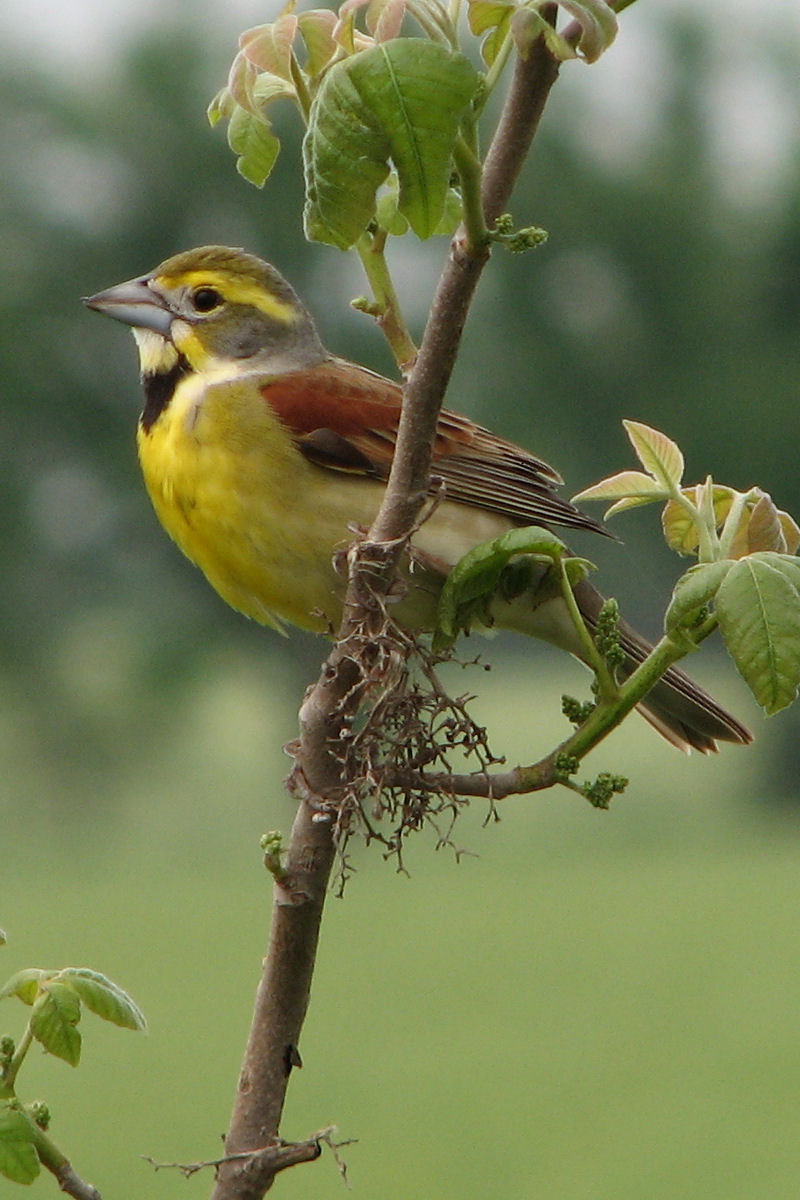
Wikipedia: Dickcissel Source: OTHER
DickcisselA.jpg
![]() Emberiza townsendi
Emberiza townsendi
Emberiza townsendii (lapsus)
Spiza townsendi
Spiza townsendii (lapsus)
(see text)
[more]
Profile Wikipedia eBird A-Z Animals Audubon AllAboutBirds Xeno-Canto
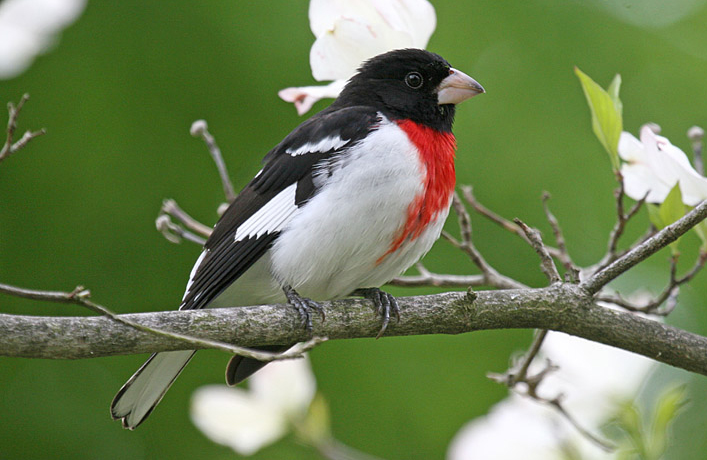
Wikipedia: Rose-breasted grosbeak Source: OTHER
RosebreastedGrosbeak08.jpg
![]() The rose-breasted grosbeak (Pheucticus ludovicianus) is a large, seed-eating grosbeak in the cardinal family (Cardinalidae). It is primarily a foliage gleaner.[2] Males have black heads, wings, backs, and tails, and a bright rose colored patch on their white breast. Males and females exhibit marked sexual dimorphism.
[more]
The rose-breasted grosbeak (Pheucticus ludovicianus) is a large, seed-eating grosbeak in the cardinal family (Cardinalidae). It is primarily a foliage gleaner.[2] Males have black heads, wings, backs, and tails, and a bright rose colored patch on their white breast. Males and females exhibit marked sexual dimorphism.
[more]

Wikipedia: Bachman's sparrow Source: OTHER
Bachmanssparrow.jpg
![]() Bachman's sparrow (Peucaea aestivalis) (also known as the "Pinewoods Sparrow" or "Oakwoods Sparrow") is a small American sparrow that is endemic to the southeastern United States. This species was named in honor of Reverend John Bachman.[3]
[more]
Bachman's sparrow (Peucaea aestivalis) (also known as the "Pinewoods Sparrow" or "Oakwoods Sparrow") is a small American sparrow that is endemic to the southeastern United States. This species was named in honor of Reverend John Bachman.[3]
[more]
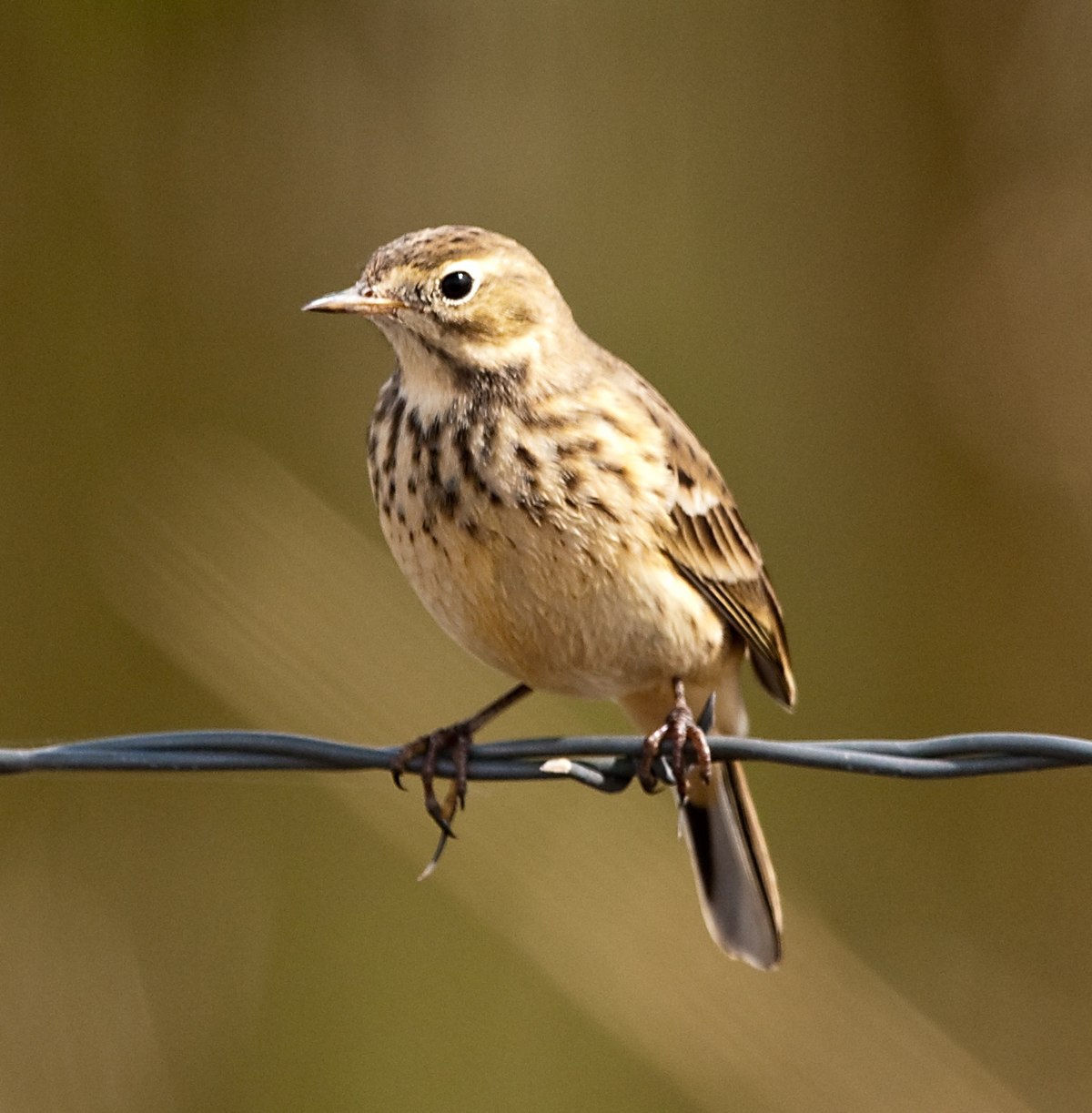
Wikipedia: American pipit Source: OTHER
1200px-Anthus_rubescens_-Harney_County%2C_Oregon%2C_USA-8.jpg
![]() The buff-bellied pipit or American pipit (Anthus rubescens) is a small songbird found on both sides of the northern Pacific. It was first described by Marmaduke Tunstall in his 1771 Ornithologia Britannica.[2] It was formerly classified as a form of the water pipit. It is known as "American pipit" in North America and "buff-bellied pipit" in Eurasia.
[more]
The buff-bellied pipit or American pipit (Anthus rubescens) is a small songbird found on both sides of the northern Pacific. It was first described by Marmaduke Tunstall in his 1771 Ornithologia Britannica.[2] It was formerly classified as a form of the water pipit. It is known as "American pipit" in North America and "buff-bellied pipit" in Eurasia.
[more]
Profile Wikipedia eBird Audubon AllAboutBirds Xeno-Canto NABU
Scaly breasted munia, Vientiane. 2024-02-18 06.54.12 Laos
First observed in Laos on 2024-02-18.
This bird appears across the great seas in the following continents:
Europe, North America, Asia, Australia.
introduced, mainland; vagrant, Ashmore Reef
Song:
Automatically generated from Xeno-Canto recording
Song attributes:
Frequency:
♫ XC797137 - Scaly-breasted Munia - Lonchura punctulata topela - song, Pha Chang Park, Wiang Chai District, Chiang Rai, Thailand. Source: XENOCANTO
XC797137 - Scaly-breasted Munia - Lonchura punctulata topela - song, Pha Chang Park, Wiang Chai District, Chiang Rai, Thailand.mp3
Thailand (song)

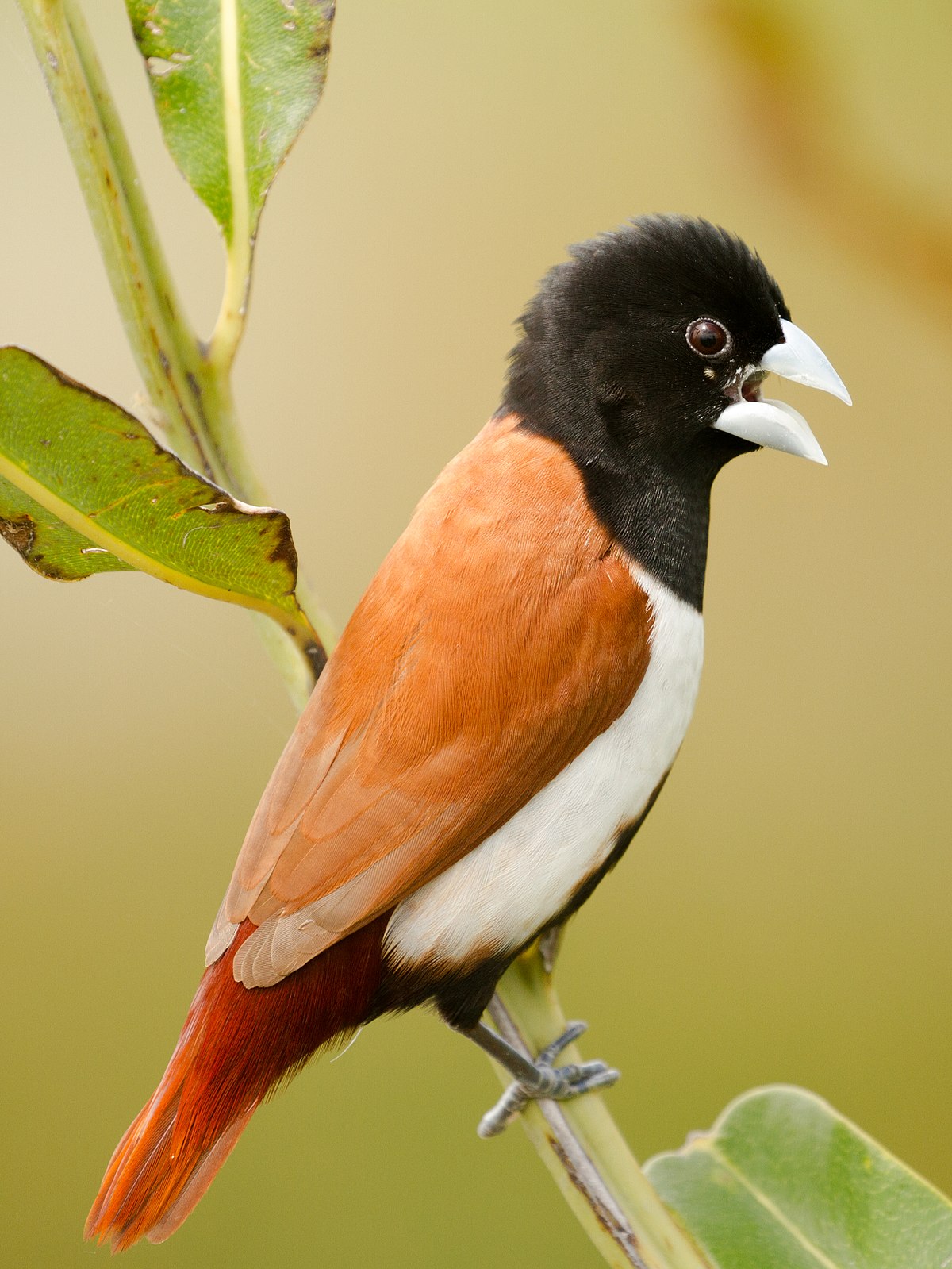
Wikipedia: Tricolored munia Source: OTHER
1200px-Tricoloured_munia_%28cropped%29.jpg
This bird appears across the great seas in the following continents:
Europe, North America, South America, Asia.
General: ![]() The tricoloured munia (Lonchura malacca) is an estrildid finch, native to Bangladesh,[2] India, Sri Lanka, Pakistan, and southern China. The species has also introduced to the Caribbean, in Trinidad, Jamaica, Hispaniola, Puerto Rico, Cuba, and Venezuela. This species, like the chestnut munia has been known as the black-headed munia. Immature birds have pale brown upperparts, lack the dark head found in adults, and have uniform buff underparts that can be confused with immatures of other munias such as the scaly-breasted munia.
[more]
The tricoloured munia (Lonchura malacca) is an estrildid finch, native to Bangladesh,[2] India, Sri Lanka, Pakistan, and southern China. The species has also introduced to the Caribbean, in Trinidad, Jamaica, Hispaniola, Puerto Rico, Cuba, and Venezuela. This species, like the chestnut munia has been known as the black-headed munia. Immature birds have pale brown upperparts, lack the dark head found in adults, and have uniform buff underparts that can be confused with immatures of other munias such as the scaly-breasted munia.
[more]
Red winged blackbird, female. 2022-05-03 10.27.30 Maryland
First observed in Maryland on 2021-06-14.
![]() The red-winged blackbird (Agelaius phoeniceus) is a passerine bird of the family Icteridae found in most of North America and much of Central America. It breeds from Alaska and Newfoundland south to Florida, the Gulf of Mexico, Mexico, and Guatemala, with isolated populations in western El Salvador, northwestern Honduras, and northwestern Costa Rica. It may winter as far north as Pennsylvania and British Columbia, but northern populations are generally migratory, moving south to Mexico and the southern United States. Claims have been made that it is the most abundant living land bird in North America, as bird-counting censuses of wintering red-winged blackbirds sometimes show that loose flocks can number in excess of a million birds per flock and the full number of breeding pairs across North and Central America may exceed 250 million in peak years. It also ranks among the best-studied wild bird species in the world.[2][3][4][5][6] The red-winged blackbird is sexually dimorphic; the male is all black with a red shoulder and yellow wing bar, while the female is a nondescript dark brown. Seeds and insects make up the bulk of the red-winged blackbird's diet.
[more]
The red-winged blackbird (Agelaius phoeniceus) is a passerine bird of the family Icteridae found in most of North America and much of Central America. It breeds from Alaska and Newfoundland south to Florida, the Gulf of Mexico, Mexico, and Guatemala, with isolated populations in western El Salvador, northwestern Honduras, and northwestern Costa Rica. It may winter as far north as Pennsylvania and British Columbia, but northern populations are generally migratory, moving south to Mexico and the southern United States. Claims have been made that it is the most abundant living land bird in North America, as bird-counting censuses of wintering red-winged blackbirds sometimes show that loose flocks can number in excess of a million birds per flock and the full number of breeding pairs across North and Central America may exceed 250 million in peak years. It also ranks among the best-studied wild bird species in the world.[2][3][4][5][6] The red-winged blackbird is sexually dimorphic; the male is all black with a red shoulder and yellow wing bar, while the female is a nondescript dark brown. Seeds and insects make up the bulk of the red-winged blackbird's diet.
[more]
Call:
Automatically generated from Xeno-Canto recording
♫ Source: BirdNet
20220501_101845 birdnet - Red-winged Blackbird - 2022-05-01 10:18:45 - Red-winged Blackbird - Cockeysville.mp3
2022-05-01 10.18.45 Cockeysville (song?)
Profile Wikipedia eBird A-Z Animals Audubon AllAboutBirds Xeno-Canto
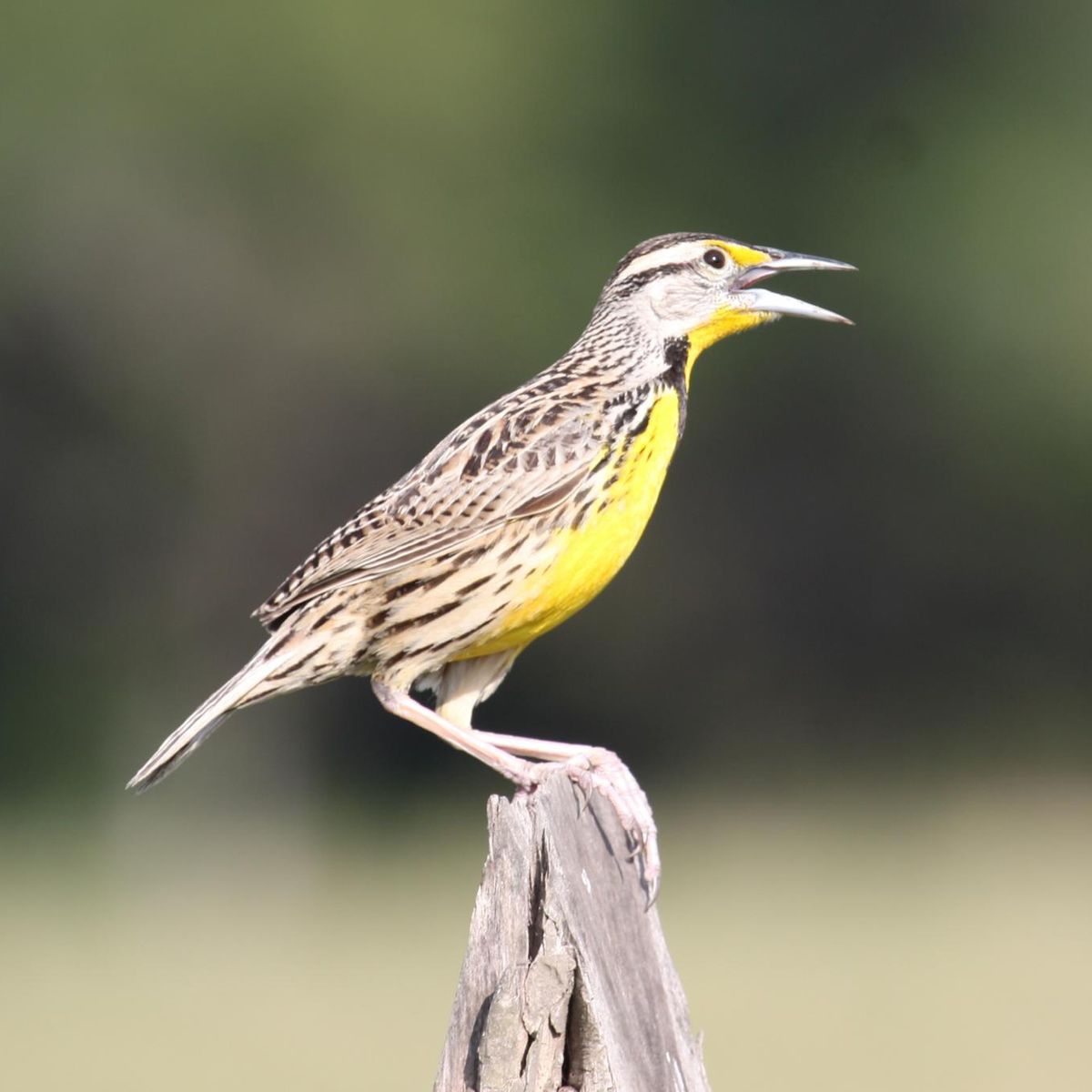
Wikipedia: Eastern meadowlark Source: OTHER
1200px-Sturnella_magna_-Mexico-8.jpg
Mexico
First observed in Panama on 2020-03-02.
![]() The eastern meadowlark (Sturnella magna) is a medium-sized icterid bird, very similar in appearance to the western meadowlark. It occurs from eastern North America to South America, where it is also most widespread in the east.
[more]
The eastern meadowlark (Sturnella magna) is a medium-sized icterid bird, very similar in appearance to the western meadowlark. It occurs from eastern North America to South America, where it is also most widespread in the east.
[more]
Call:
Automatically generated from Xeno-Canto recording
♫ Source: BirdNet
20200302_220235 birdnet 24 - Eastern Meadowlark - 2020-03-02 22:02:35 - Eastern Meadowlark - Bajo Boquete.mp3
2020-03-02 22.02.35 Panama (song?)
Profile Wikipedia eBird Audubon AllAboutBirds Xeno-Canto
Boat-tailed grackles. 2023-09-24 09.53.28 Florida
First observed in Florida on 2023-09-24.
![]() The boat-tailed grackle (Quiscalus major) is a passerine bird of the family Icteridae found as a permanent resident on the coasts of the Southeastern United States.
[more]
The boat-tailed grackle (Quiscalus major) is a passerine bird of the family Icteridae found as a permanent resident on the coasts of the Southeastern United States.
[more]
Profile Wikipedia eBird A-Z Animals Audubon AllAboutBirds Xeno-Canto
The Common Grackle has yellow eyes, unlike the boat-tailed. 2023-09-27 14.24.20 Florida
First observed in Maryland on 2021-06-17.
![]() The common grackle (Quiscalus quiscula) is a large icterid found in large numbers through much of North America. First described in 1758 by Carl Linnaeus, the common grackle has three subspecies. Adult common grackles have a long and dark bill, pale yellow eyes, and a long tail. Adults often have an iridescent appearance on their head, especially males. Common grackles are found in much of North America east of the Rocky Mountains.
[more]
The common grackle (Quiscalus quiscula) is a large icterid found in large numbers through much of North America. First described in 1758 by Carl Linnaeus, the common grackle has three subspecies. Adult common grackles have a long and dark bill, pale yellow eyes, and a long tail. Adults often have an iridescent appearance on their head, especially males. Common grackles are found in much of North America east of the Rocky Mountains.
[more]
Profile Wikipedia eBird A-Z Animals Audubon AllAboutBirds Xeno-Canto

Wikipedia: Bobolink Source: OTHER
Bobolink%2C_Mer_Bleue.jpg
![]() The bobolink (Dolichonyx oryzivorus) is a small New World blackbird and the only member of the genus Dolichonyx. An old name for this species is the "Rice Bird", from its tendency to feed on cultivated grains. Adults are 16–18 cm (6.3–7.1 in) long with short finch-like bills and weigh about 1 oz (28 g). Adult males are mostly black with creamy napes and white scapulars, lower backs, and rumps. Adult females are mostly light brown with black streaks on the back and flanks, and dark stripes on the head; their wings and tails are darker. The bobolink breeds in the summer in North America and southern Canada, often wintering in South America. Considered a pest by some farmers, the numbers of these birds are declining and are a species at risk throughout Canada.
[more]
The bobolink (Dolichonyx oryzivorus) is a small New World blackbird and the only member of the genus Dolichonyx. An old name for this species is the "Rice Bird", from its tendency to feed on cultivated grains. Adults are 16–18 cm (6.3–7.1 in) long with short finch-like bills and weigh about 1 oz (28 g). Adult males are mostly black with creamy napes and white scapulars, lower backs, and rumps. Adult females are mostly light brown with black streaks on the back and flanks, and dark stripes on the head; their wings and tails are darker. The bobolink breeds in the summer in North America and southern Canada, often wintering in South America. Considered a pest by some farmers, the numbers of these birds are declining and are a species at risk throughout Canada.
[more]

Wikipedia: Rusty blackbird Source: OTHER
Euphagus-carolinus-001.jpg
![]() The rusty blackbird (Euphagus carolinus) is a medium-sized blackbird, closely related to grackles ("rusty grackle" is an older name for the species). It is a bird that prefers wet forested areas, breeding in the boreal forest and muskeg across northern Canada, and migrating southeast to the United States during winter.
[more]
The rusty blackbird (Euphagus carolinus) is a medium-sized blackbird, closely related to grackles ("rusty grackle" is an older name for the species). It is a bird that prefers wet forested areas, breeding in the boreal forest and muskeg across northern Canada, and migrating southeast to the United States during winter.
[more]
Profile Wikipedia eBird Audubon AllAboutBirds Xeno-Canto

Wikipedia: Brewer's blackbird Source: OTHER
Brewers_Blackbird_Esquimalt_Lagoon.jpg
![]() Brewer's blackbird (Euphagus cyanocephalus) is a medium-sized New World blackbird. It is named after the ornithologist Thomas Mayo Brewer.
[more]
Brewer's blackbird (Euphagus cyanocephalus) is a medium-sized New World blackbird. It is named after the ornithologist Thomas Mayo Brewer.
[more]
Baltimore oriole at Cromwell. 2022-04-29 12.40.24 Maryland
First observed in Maryland on 2021-06-18.
![]() The Baltimore oriole (Icterus galbula) is a small icterid blackbird common in eastern North America as a migratory breeding bird. It received its name from the resemblance of the male's colors to those on the coat-of-arms of Lord Baltimore. Observations of interbreeding between the Baltimore oriole and the western Bullock's oriole, Icterus bullockii, led to both being classified as a single species, called the northern oriole, from 1973 to 1995. Research by James Rising, a professor of zoology at the University of Toronto, and others showed that the two birds actually did not interbreed significantly.[2]
[more]
The Baltimore oriole (Icterus galbula) is a small icterid blackbird common in eastern North America as a migratory breeding bird. It received its name from the resemblance of the male's colors to those on the coat-of-arms of Lord Baltimore. Observations of interbreeding between the Baltimore oriole and the western Bullock's oriole, Icterus bullockii, led to both being classified as a single species, called the northern oriole, from 1973 to 1995. Research by James Rising, a professor of zoology at the University of Toronto, and others showed that the two birds actually did not interbreed significantly.[2]
[more]
Profile Wikipedia eBird Audubon AllAboutBirds Xeno-Canto
Monteverde Bullocks oriole tenative ID by MerlinBirdID. 2018-02-21 16.23.04 Costa Rica
First observed in Costa Rica on 2018-02-21.
![]() Bullock's oriole (Icterus bullockii) is a small New World blackbird. At one time, this species and the Baltimore oriole were considered to be a single species, the northern oriole. This bird is named after William Bullock, an English amateur naturalist.
[more]
Bullock's oriole (Icterus bullockii) is a small New World blackbird. At one time, this species and the Baltimore oriole were considered to be a single species, the northern oriole. This bird is named after William Bullock, an English amateur naturalist.
[more]
Profile Wikipedia eBird A-Z Animals Audubon AllAboutBirds Xeno-Canto

Wikipedia: Orchard oriole Source: OTHER
1200px-Orchard_Oriole_by_Dan_Pancamo_1.jpg
![]() The orchard oriole (Icterus spurius) is the smallest species of icterid. The subspecies of the Caribbean coast of Mexico, I. s. fuertesi, is sometimes considered a separate species, the ochre oriole or Fuertes's oriole.
[more]
The orchard oriole (Icterus spurius) is the smallest species of icterid. The subspecies of the Caribbean coast of Mexico, I. s. fuertesi, is sometimes considered a separate species, the ochre oriole or Fuertes's oriole.
[more]
Profile Wikipedia eBird Audubon AllAboutBirds Xeno-Canto

Wikipedia: Spot-breasted oriole Source: OTHER
Icterus_pectoralis.jpg
![]() The spot-breasted oriole (Icterus pectoralis) is a species of bird in the family Icteridae.
[more]
The spot-breasted oriole (Icterus pectoralis) is a species of bird in the family Icteridae.
[more]
Profile Wikipedia eBird Audubon AllAboutBirds Xeno-Canto

Wikipedia: Shiny cowbird Source: OTHER
1200px-Shiny_cowbird_%28Molothrus_bonariensis%29_male.JPG
![]() The shiny cowbird (Molothrus bonariensis) is a passerine bird in the New World family Icteridae. It breeds in most of South America except for dense forests and areas of high altitude such as mountains.[1] Since 1900 the shiny cowbirds' range has shifted northward, and it was recorded in the Caribbean islands as well as the United States, where it is found breeding in southern Florida.[2] It is a bird associated with open habitats, including disturbed land from agriculture and deforestation.[1]
[more]
The shiny cowbird (Molothrus bonariensis) is a passerine bird in the New World family Icteridae. It breeds in most of South America except for dense forests and areas of high altitude such as mountains.[1] Since 1900 the shiny cowbirds' range has shifted northward, and it was recorded in the Caribbean islands as well as the United States, where it is found breeding in southern Florida.[2] It is a bird associated with open habitats, including disturbed land from agriculture and deforestation.[1]
[more]
Profile Wikipedia eBird Audubon AllAboutBirds Xeno-Canto
Brown-headed cowbird, Paper Mill Road. 2021-06-20 11.34.20 Maryland
First observed in Maryland on 2021-06-14.
![]() The brown-headed cowbird (Molothrus ater) is a small, obligate brood parasitic icterid native to temperate and subtropical North America. It is a permanent resident in the southern parts of its range; northern birds migrate to the southern United States and Mexico in winter, returning to their summer habitat around March or April.[2]
[more]
The brown-headed cowbird (Molothrus ater) is a small, obligate brood parasitic icterid native to temperate and subtropical North America. It is a permanent resident in the southern parts of its range; northern birds migrate to the southern United States and Mexico in winter, returning to their summer habitat around March or April.[2]
[more]
Profile Wikipedia eBird Audubon AllAboutBirds Xeno-Canto
The red-eyed bronzed cowbird at Chichen Itza. 2023-04-13 11.57.06 Yucatan
First observed in Yucatan on 2023-04-13.
![]()
The bronzed cowbird (once known as the red-eyed cowbird, Molothrus aeneus) is a small icterid.
[more]
Profile Wikipedia eBird Audubon AllAboutBirds Xeno-Canto

Wikipedia: Yellow-headed blackbird Source: OTHER
1200px-Male_Yellow-headed_Blackbird.jpg
![]() The yellow-headed blackbird (Xanthocephalus xanthocephalus) is a medium-sized blackbird, and the only member of the genus Xanthocephalus.
[more]
The yellow-headed blackbird (Xanthocephalus xanthocephalus) is a medium-sized blackbird, and the only member of the genus Xanthocephalus.
[more]

Wikipedia: Golden-winged warbler Source: OTHER
Golden-winged_Warbler_NGM-v31-p308-C.jpg
![]() The golden-winged warbler (Vermivora chrysoptera) is a New World warbler. It breeds in southeastern and south-central Canada and in the Appalachian Mountains in northeastern to north-central United States. The majority (~70%) of the global population breeds in Wisconsin, Minnesota, and Manitoba. Golden-winged warbler populations are slowly expanding northwards, but are generally declining across its range, most likely as a result of habitat loss and competition/interbreeding with the very closely related blue-winged warbler, Vermivora cyanoptera.
[more]
The golden-winged warbler (Vermivora chrysoptera) is a New World warbler. It breeds in southeastern and south-central Canada and in the Appalachian Mountains in northeastern to north-central United States. The majority (~70%) of the global population breeds in Wisconsin, Minnesota, and Manitoba. Golden-winged warbler populations are slowly expanding northwards, but are generally declining across its range, most likely as a result of habitat loss and competition/interbreeding with the very closely related blue-winged warbler, Vermivora cyanoptera.
[more]

Wikipedia: Blue-winged warbler Source: OTHER
Vermivora_cyanoptera_-North_Berwick%2C_Maine%2C_USA-8.jpg
![]() The blue-winged warbler (Vermivora cyanoptera) is a fairly common New World warbler, 11.5 cm (4.5 in) long and weighing 8.5 g (0.30 oz). It breeds in eastern North America in southern Ontario and the eastern United States. Its range is extending northwards, where it is replacing the very closely related golden-winged warbler, Vermivora chrysoptera.
[more]
The blue-winged warbler (Vermivora cyanoptera) is a fairly common New World warbler, 11.5 cm (4.5 in) long and weighing 8.5 g (0.30 oz). It breeds in eastern North America in southern Ontario and the eastern United States. Its range is extending northwards, where it is replacing the very closely related golden-winged warbler, Vermivora chrysoptera.
[more]
Profile Wikipedia eBird Audubon AllAboutBirds Xeno-Canto

Wikipedia: Swainson's warbler Source: OTHER
1200px-Limnothlypis_swainsonii_4702971_%28cropped%29.jpg
![]() Swainson's warbler (Limnothlypis swainsonii) is a small species of New World warbler. It is monotypic, the only member of the genus Limnothlypis. Swainson's warbler was named after William Swainson, an English ornithologist.
[more]
Swainson's warbler (Limnothlypis swainsonii) is a small species of New World warbler. It is monotypic, the only member of the genus Limnothlypis. Swainson's warbler was named after William Swainson, an English ornithologist.
[more]

Wikipedia: Kentucky warbler Source: OTHER
Oporornis_formosus_FWS.jpg
![]() The Kentucky warbler (Geothlypis formosa) is a small species of New World warbler. It is a sluggish and heavy warbler with a short tail, preferring to spend most of its time on or near the ground, except when singing.
[more]
The Kentucky warbler (Geothlypis formosa) is a small species of New World warbler. It is a sluggish and heavy warbler with a short tail, preferring to spend most of its time on or near the ground, except when singing.
[more]
MerlinBirdID suggests common yellowthroat - Kohunlich. 2023-04-03 10.51.28 Yucatan
First observed in Yucatan on 2023-04-03.
![]() The common yellowthroat (Geothlypis trichas) is a New World warbler. It is an abundant breeder in North America, ranging from southern Canada to central Mexico. The genus name Geothlypis is from Ancient Greek geo, "ground", and thlupis, an unidentified small bird; thlypis is often used in the scientific names of New World warblers. The specific trichas is also from Greek; trikhas is a kind of thrush, the word being derived from trikhos, "hair".[2]
[more]
The common yellowthroat (Geothlypis trichas) is a New World warbler. It is an abundant breeder in North America, ranging from southern Canada to central Mexico. The genus name Geothlypis is from Ancient Greek geo, "ground", and thlupis, an unidentified small bird; thlypis is often used in the scientific names of New World warblers. The specific trichas is also from Greek; trikhas is a kind of thrush, the word being derived from trikhos, "hair".[2]
[more]
Profile Wikipedia eBird Audubon AllAboutBirds Xeno-Canto

Wikipedia: Yellow-breasted chat Source: OTHER
Yellow-Breasted-Chat-Oregon.jpg
![]() The yellow-breasted chat (Icteria virens) is a large songbird found in North America, and is the only member of the family Icteriidae. It was once a member of the New World warbler family, but in 2017, the American Ornithological Society moved it to its own family. Its placement is not definitely resolved.
[more]
The yellow-breasted chat (Icteria virens) is a large songbird found in North America, and is the only member of the family Icteriidae. It was once a member of the New World warbler family, but in 2017, the American Ornithological Society moved it to its own family. Its placement is not definitely resolved.
[more]

Wikipedia: Connecticut warbler Source: OTHER
1200px-Oporornis_agilis_Youghiogheny_River_MD.jpg
![]() The Connecticut warbler (Oporornis agilis) is a small songbird of the New World warbler family.
[more]
The Connecticut warbler (Oporornis agilis) is a small songbird of the New World warbler family.
[more]

Wikipedia: Worm-eating warbler Source: OTHER
Worm-eating_Warbler.jpg
![]() The worm-eating warbler (Helmitheros vermivorum) is a small New World warbler that breeds in the Eastern United States and migrates to southern Mexico, the Caribbean, and Central America for the winter.
[more]
The worm-eating warbler (Helmitheros vermivorum) is a small New World warbler that breeds in the Eastern United States and migrates to southern Mexico, the Caribbean, and Central America for the winter.
[more]
Black and white warbler, Ecotucan, Bacalar. 2023-03-30 17.30.48 Yucatan
First observed in Yucatan on 2023-03-27.
![]() The black-and-white warbler (Mniotilta varia) is a species of New World warbler, and the only member of its genus, Mniotilta.[2]
It breeds in northern and eastern North America and winters in Florida, Central America, and the West Indies down to Peru. This species is a very rare vagrant to western Europe.[2]
[more]
The black-and-white warbler (Mniotilta varia) is a species of New World warbler, and the only member of its genus, Mniotilta.[2]
It breeds in northern and eastern North America and winters in Florida, Central America, and the West Indies down to Peru. This species is a very rare vagrant to western Europe.[2]
[more]
Profile Wikipedia eBird Audubon AllAboutBirds Xeno-Canto
MerlinBirdID suggest a prothonotary warbler, at botanical garden, Puerto Morelos. 2023-03-27 11.50.22 Yucatan
First observed in Yucatan on 2023-03-27.
![]() The prothonotary warbler (Protonotaria citrea) is a small songbird of the New World warbler family. It is the only member of the genus Protonotaria.[2]
[more]
The prothonotary warbler (Protonotaria citrea) is a small songbird of the New World warbler family. It is the only member of the genus Protonotaria.[2]
[more]

Wikipedia: Ovenbird Source: OTHER
1200px-Ovenbird_RWD2011b.jpg
![]() The ovenbird (Seiurus aurocapilla) is a small songbird of the New World warbler family (Parulidae). This migratory bird breeds in eastern North America and winters in Central America, many Caribbean islands, Florida and northern Venezuela.[2][3]
[more]
The ovenbird (Seiurus aurocapilla) is a small songbird of the New World warbler family (Parulidae). This migratory bird breeds in eastern North America and winters in Central America, many Caribbean islands, Florida and northern Venezuela.[2][3]
[more]

Wikipedia: Black-throated blue warbler Source: OTHER
1200px-Black-throated_Blue_Warbler%2C_Parc_%C3%89coforestier_de_Johnville%2C_Quebec%2C_Canada.jpg
![]() The black-throated blue warbler (Setophaga caerulescens) is a small passerine bird of the New World warbler family. Its breeding ranges are located in the interior of deciduous and mixed coniferous forests in eastern North America. Over the cooler months, it migrates to islands in the Caribbean and Central America. It is very rarely found in western Europe, where it is considered to be a non-indigenous species. The black-throated blue warbler is sexually dimorphic; the adult male has a black face and cheeks, deep blue upperparts and white underparts, while the adult female is olive-brown above and light yellow below.
[more]
The black-throated blue warbler (Setophaga caerulescens) is a small passerine bird of the New World warbler family. Its breeding ranges are located in the interior of deciduous and mixed coniferous forests in eastern North America. Over the cooler months, it migrates to islands in the Caribbean and Central America. It is very rarely found in western Europe, where it is considered to be a non-indigenous species. The black-throated blue warbler is sexually dimorphic; the adult male has a black face and cheeks, deep blue upperparts and white underparts, while the adult female is olive-brown above and light yellow below.
[more]
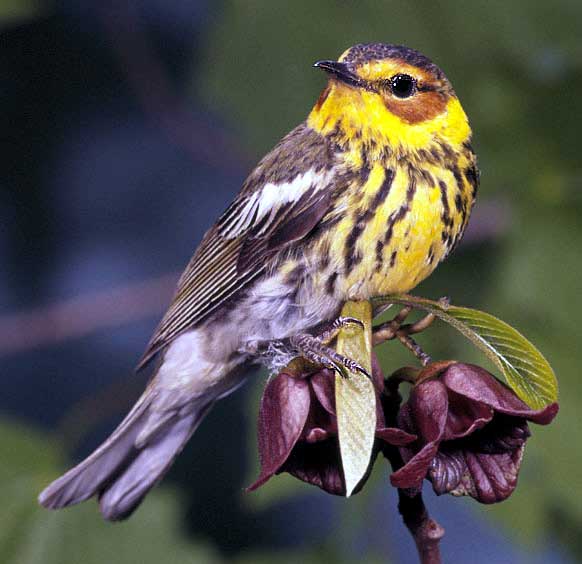
Wikipedia: Cape may warbler Source: OTHER
Dendroica_tigrina_FWS.jpg
![]() The Cape May warbler (Setophaga tigrina) is a species of New World warbler. It breeds in northern North America. Its breeding range spans all but the westernmost parts of southern Canada, the Great Lakes region, and New England. It is migratory, wintering in the West Indies. This species is a very rare vagrant to western Europe, with two records in Britain as of October 2013. The English name refers to Cape May, New Jersey, where George Ord collected the specimen later described by Alexander Wilson. This species was not recorded again in Cape May for another 100 years, although it is now known as an uncommon migrant there.[2]
[more]
The Cape May warbler (Setophaga tigrina) is a species of New World warbler. It breeds in northern North America. Its breeding range spans all but the westernmost parts of southern Canada, the Great Lakes region, and New England. It is migratory, wintering in the West Indies. This species is a very rare vagrant to western Europe, with two records in Britain as of October 2013. The English name refers to Cape May, New Jersey, where George Ord collected the specimen later described by Alexander Wilson. This species was not recorded again in Cape May for another 100 years, although it is now known as an uncommon migrant there.[2]
[more]
Palm warbler by Windham Hill Inn, Vermont. 2023-10-03 10.42.20 New England
First observed in New England on 2023-10-03.
![]() The palm warbler (Setophaga palmarum) is a small songbird of the New World warbler family.
[more]
The palm warbler (Setophaga palmarum) is a small songbird of the New World warbler family.
[more]

Wikipedia: Cerulean warbler Source: OTHER
Dendroica-cerulea-002.jpg
![]() The cerulean warbler (Setophaga cerulea) is a small songbird of the New World warbler family.
Adult males have pale cerulean blue and white upperparts with a black necklace across the breast and black streaks on the back and flanks. Females and immature birds have greyer or greenish upperparts, a pale stripe over the eye, and no streaking on the back and no neck. All of these birds have wing bars and a thin pointed bill.
They are found in deciduous forests of eastern North America during the breeding season and then migrate to forested mountain areas in South America.
The species is considered threatened with an IUCN status of near threatened, indicating it does not face any imminent threat of extinction in the wild.
[more]
The cerulean warbler (Setophaga cerulea) is a small songbird of the New World warbler family.
Adult males have pale cerulean blue and white upperparts with a black necklace across the breast and black streaks on the back and flanks. Females and immature birds have greyer or greenish upperparts, a pale stripe over the eye, and no streaking on the back and no neck. All of these birds have wing bars and a thin pointed bill.
They are found in deciduous forests of eastern North America during the breeding season and then migrate to forested mountain areas in South America.
The species is considered threatened with an IUCN status of near threatened, indicating it does not face any imminent threat of extinction in the wild.
[more]

Wikipedia: Chestnut-sided warbler Source: OTHER
1200px-Dendroica-pensylvanica-003.jpg
![]() The chestnut-sided warbler (Setophaga pensylvanica) is a New World warbler. They breed in eastern North America and in southern Canada westwards to the Canadian Prairies. They also breed in the Great Lakes region and in the eastern United States.
[more]
The chestnut-sided warbler (Setophaga pensylvanica) is a New World warbler. They breed in eastern North America and in southern Canada westwards to the Canadian Prairies. They also breed in the Great Lakes region and in the eastern United States.
[more]

Wikipedia: Blackburnian warbler Source: OTHER
1200px-Dendroica-fusca-001.jpg
![]() The Blackburnian warbler (Setophaga fusca) is a small New World warbler. They breed in eastern North America, from southern Canada, westwards to the southern Canadian Prairies, the Great Lakes region and New England, to North Carolina.
[more]
The Blackburnian warbler (Setophaga fusca) is a small New World warbler. They breed in eastern North America, from southern Canada, westwards to the southern Canadian Prairies, the Great Lakes region and New England, to North Carolina.
[more]
Yellow warbler, male of one of the mangrove subspecies, feeding off coconuts used just to sell the milk as a refreshing drink. 2023-04-21 07.08.16 Yucatan
First observed in Yucatan on 2023-04-21.
![]() The yellow warbler (Setophaga petechia) is a New World warbler species. Yellow warblers are the most widespread species in the diverse genus Setophaga. The species can be found throughout most of North America and migrates to wintering grounds from southern California to the Amazon region, Bolivia, and Peru.
[more]
The yellow warbler (Setophaga petechia) is a New World warbler species. Yellow warblers are the most widespread species in the diverse genus Setophaga. The species can be found throughout most of North America and migrates to wintering grounds from southern California to the Amazon region, Bolivia, and Peru.
[more]

Wikipedia: Blackpoll warbler Source: OTHER
1200px-Dendroica_striata_MN.jpg
![]() The blackpoll warbler (Setophaga striata) is a New World warbler. Breeding males are mostly black and white. They have a prominent black cap, white cheeks and white wing bars. The blackpoll breeds in forests of northern North America, from Alaska throughout most of Canada, to the mountains of New York and New England. They are a common migrant through much of North America. In fall, they fly south to the Greater Antilles and the northeastern coasts of South America in a non-stop long-distance migration over open water, averaging 2500 km, one of the longest distance non-stop overwater flights ever recorded for a migratory songbird. Rare vagrants to western Europe, they are one of the more frequent transatlantic passerine wanderers.
[more]
The blackpoll warbler (Setophaga striata) is a New World warbler. Breeding males are mostly black and white. They have a prominent black cap, white cheeks and white wing bars. The blackpoll breeds in forests of northern North America, from Alaska throughout most of Canada, to the mountains of New York and New England. They are a common migrant through much of North America. In fall, they fly south to the Greater Antilles and the northeastern coasts of South America in a non-stop long-distance migration over open water, averaging 2500 km, one of the longest distance non-stop overwater flights ever recorded for a migratory songbird. Rare vagrants to western Europe, they are one of the more frequent transatlantic passerine wanderers.
[more]
Profile Wikipedia eBird Audubon AllAboutBirds Xeno-Canto
Possibly a female American redstart at Maya site Becan. 2023-04-03 12.11.18 Yucatan
First observed in Cockeysville on 2022-05-02.
![]() The American redstart (Setophaga ruticilla) is a New World warbler. It is unrelated to the Old World (common) redstart.
[more]
The American redstart (Setophaga ruticilla) is a New World warbler. It is unrelated to the Old World (common) redstart.
[more]
Call:
Automatically generated from Xeno-Canto recording
♫ Source: BirdNet
20220502_085740 birdnet - American Redstart - 2022-05-02 08:57:40 - American Redstart - Cockeysville.mp3
2022-05-02 08.57.40 Cockeysville (song?)

Wikipedia: Hooded warbler Source: OTHER
Wilsonia_citrina_%28Belize%29.jpg
![]() The hooded warbler (Setophaga citrina) is a New World warbler. It breeds in eastern North America and across the eastern United States and into southernmost Canada (Ontario). It is migratory, wintering in Central America and the West Indies. Hooded warblers are very rare vagrants to western Europe.
[more]
The hooded warbler (Setophaga citrina) is a New World warbler. It breeds in eastern North America and across the eastern United States and into southernmost Canada (Ontario). It is migratory, wintering in Central America and the West Indies. Hooded warblers are very rare vagrants to western Europe.
[more]
Call:
Automatically generated from Xeno-Canto recording
♫ Source: BirdNet
20210613_064404 birdnet 1638 - No confident detection, wild guess hooded warbler or yellow backed warbler - No confident detection - Cockeysville.mp3
2021-06-13 06.44.04 Cockeysville (song?)

Wikipedia: Northern parula Source: OTHER
Northernparalua20.jpg
First observed in Cockeysville on 2022-05-01.
![]() The northern parula (Setophaga americana) is a small New World warbler. It breeds in eastern North America from southern Canada to Florida.[2]
[more]
The northern parula (Setophaga americana) is a small New World warbler. It breeds in eastern North America from southern Canada to Florida.[2]
[more]
Call:
Automatically generated from Xeno-Canto recording
♫ Source: BirdNet
20220501_090658 birdnet - Northern Parula - 2022-05-01 09:06:58 - Northern Parula - Cockeysville.mp3
2022-05-01 09.06.58 Cockeysville (song?)

Wikipedia: Magnolia warbler Source: OTHER
Dendroica_magnolia_MN.jpg
![]() The magnolia warbler (Setophaga magnolia) is a member of the wood warbler family Parulidae.
[more]
The magnolia warbler (Setophaga magnolia) is a member of the wood warbler family Parulidae.
[more]

Wikipedia: Pine warbler Source: OTHER
1200px-Dendroica_pinus.jpg
![]() The pine warbler (Setophaga pinus) is a small songbird of the New World warbler family.
[more]
The pine warbler (Setophaga pinus) is a small songbird of the New World warbler family.
[more]

Wikipedia: Bay-breasted warbler Source: OTHER
1200px-Dendroica-castanea-001.jpg
![]() The Bay-breasted Warbler (Setophaga castanea) is a small species of songbird in the New World warbler family, Parulidae. It is one of thirty-four species in the diverse genus Setophaga.[2] Like all songbirds, or passerines, the species is classified in the order Passeriformes.
[more]
The Bay-breasted Warbler (Setophaga castanea) is a small species of songbird in the New World warbler family, Parulidae. It is one of thirty-four species in the diverse genus Setophaga.[2] Like all songbirds, or passerines, the species is classified in the order Passeriformes.
[more]
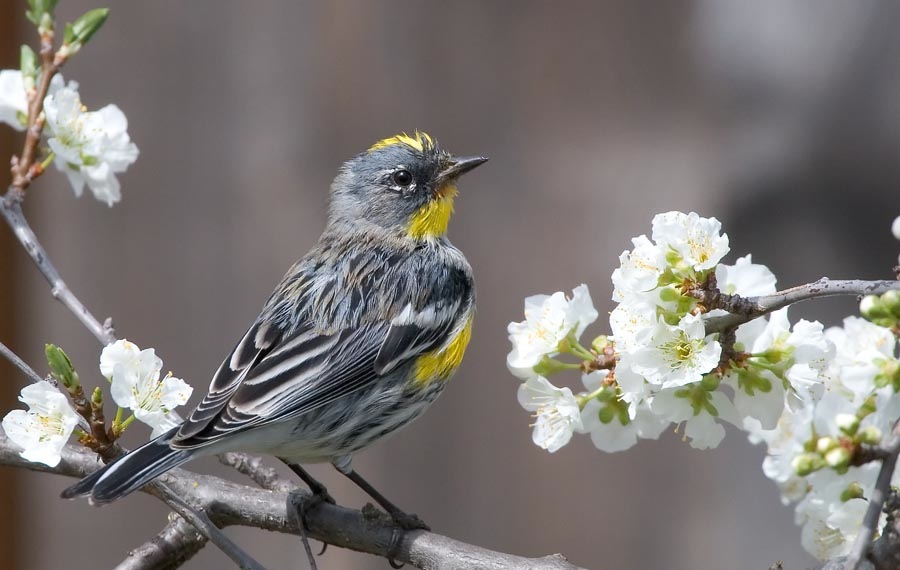
Wikipedia: Yellow-rumped warbler Source: OTHER
Audubon%27s_Warbler_Setophaga_auduboni.jpg
![]() The yellow-rumped warbler (Setophaga coronata) is a regular North American bird species that can be commonly observed all across the continent. Its extensive distribution range connects both the Pacific and Atlantic coasts of the U.S. as well as Canada and Central America, with the population concentrating in the continent's northern parts during the breeding season and migrating southwards to southern North and Central America in Winter. The species generally prefers coniferous forests or mixed coniferous-deciduous forests as its breeding habitat, while during the winter it can be found inhabiting more open areas such as shrublands that offer food resources. The diet of the yellow-rumped warbler is based primarily on insects, though the species does eat fruits such as juniper berries as well, especially in winter.
[more]
The yellow-rumped warbler (Setophaga coronata) is a regular North American bird species that can be commonly observed all across the continent. Its extensive distribution range connects both the Pacific and Atlantic coasts of the U.S. as well as Canada and Central America, with the population concentrating in the continent's northern parts during the breeding season and migrating southwards to southern North and Central America in Winter. The species generally prefers coniferous forests or mixed coniferous-deciduous forests as its breeding habitat, while during the winter it can be found inhabiting more open areas such as shrublands that offer food resources. The diet of the yellow-rumped warbler is based primarily on insects, though the species does eat fruits such as juniper berries as well, especially in winter.
[more]

Wikipedia: Northern waterthrush Source: OTHER
Northern_Waterthrush%2C_Parkesia_noveboracensis.jpg
![]() The northern waterthrush (Parkesia noveboracensis[2]) is one of the larger New World warblers and one of the Nearctic-Neotropical migratory songbirds.[3] It breeds in the northern part of North America in Canada and the northern United States including Alaska. This bird is migratory, wintering in Central America, the West Indies and Florida, as well as in Venezuela, Colombia, and Ecuador. It is a very rare vagrant to other South American countries and to western Europe.
[more]
The northern waterthrush (Parkesia noveboracensis[2]) is one of the larger New World warblers and one of the Nearctic-Neotropical migratory songbirds.[3] It breeds in the northern part of North America in Canada and the northern United States including Alaska. This bird is migratory, wintering in Central America, the West Indies and Florida, as well as in Venezuela, Colombia, and Ecuador. It is a very rare vagrant to other South American countries and to western Europe.
[more]
![]() Der Stelzenwaldsänger (Parkesia motacilla, Syn.: Seiurus motacilla) ist ein kleiner Vogel aus der Familie der Waldsänger (Parulidae). Er ist neben dem Uferwaldsänger (Parkesia noveboracensis) die zweite Art in der Gattung Parkesia.
[more]
Der Stelzenwaldsänger (Parkesia motacilla, Syn.: Seiurus motacilla) ist ein kleiner Vogel aus der Familie der Waldsänger (Parulidae). Er ist neben dem Uferwaldsänger (Parkesia noveboracensis) die zweite Art in der Gattung Parkesia.
[more]

Wikipedia: Tennessee warbler Source: OTHER
1200px-Tennessee_Warbler_2.jpg
![]() The Tennessee warbler (Leiothlypis peregrina) is a New World warbler that breeds in eastern North America and winters in southern Central America, the Caribbean, and northern South America. The specific name peregrina is from Latin peregrinus "wanderer".[2]
[more]
The Tennessee warbler (Leiothlypis peregrina) is a New World warbler that breeds in eastern North America and winters in southern Central America, the Caribbean, and northern South America. The specific name peregrina is from Latin peregrinus "wanderer".[2]
[more]
MerlinBirdID suggests orange-crowned warbler, which has many different color variations. 2023-04-20 11.26.48 Yucatan
First observed in Yucatan on 2023-04-20.
![]() The orange-crowned warbler (Leiothlypis celata) is a small songbird of the New World warbler family.
[more]
The orange-crowned warbler (Leiothlypis celata) is a small songbird of the New World warbler family.
[more]

Wikipedia: Nashville warbler Source: OTHER
1200px-Vermivora_ruficapilla_Winema_National_Forest_%28cropped%29.jpg
![]() The Nashville warbler (Leiothlypis ruficapilla) is a small songbird in the New World warbler family, found in North and Central America. It breeds in parts of the northern and western United States and southern Canada, and migrates to winter in southern California and Texas, Mexico, and the north of Central America. It has a gray head and a green back, and its underparts are yellow and white.
[more]
The Nashville warbler (Leiothlypis ruficapilla) is a small songbird in the New World warbler family, found in North and Central America. It breeds in parts of the northern and western United States and southern Canada, and migrates to winter in southern California and Texas, Mexico, and the north of Central America. It has a gray head and a green back, and its underparts are yellow and white.
[more]
Carolina chickadee (Poecile carolinensis)
Possibly two Carolina chickadees. 2022-05-05 18.19.16 Maryland
First observed in Cockeysville on 2021-06-11.
![]() Parus carolinensis
[more]
Parus carolinensis
[more]
Call:
Automatically generated from Xeno-Canto recording
♫ Source: BirdNet
20220502_105412 birdnet - Carolina Chickadee - 2022-05-02 10:54:12 - Carolina Chickadee - Cockeysville.mp3
2022-05-02 10.54.12 Cockeysville (song?)
Tufted titmouse / Indianermeise (Baeolophus bicolor)
Tufted titmouse. 2022-05-03 10.55.46 Maryland
First observed in Cockeysville on 2021-06-12.
![]() The tufted titmouse (Baeolophus bicolor) is a small songbird from North America, a species in the tit and chickadee family (Paridae). The black-crested titmouse, found from central and southern Texas southward,[2] was included as a subspecies, but now is considered a separate species, (Baeolophus atricristatus).[3]
[more]
The tufted titmouse (Baeolophus bicolor) is a small songbird from North America, a species in the tit and chickadee family (Paridae). The black-crested titmouse, found from central and southern Texas southward,[2] was included as a subspecies, but now is considered a separate species, (Baeolophus atricristatus).[3]
[more]
Call:
Automatically generated from Xeno-Canto recording
♫ Source: BirdNet
20220428_115651 birdnet - Tufted Titmouse - Tufted Titmouse - Cockeysville.mp3
2022-04-28 11.56.51 Cockeysville (song?)
Common starling / Star (Sturnus vulgaris)
Im richtigen Licht schimmern die Federn. 2020-04-11 07.54.52 Luppmen
First observed in 🇨🇭 on 2020-04-11.
This bird appears across the great seas in the following continents:
Europe, North America (introduced), Africa.
Learned on BBC's Winterwatch: the movement of a swarm of starlings is called a murmuration! Check out this this video or even an entire half hour
In trees or in the fields by the cows.
Frequently seen here, for instance by their nests under the eaves of one of the Toblerone houses.
Introduced to North America from Europe by Eugene Schieffelin.
Eine der Vogelarten, die gleichzeitig zwei Töne singen kann!
Vocalization: ![]() Among the best of imitators. Mimics birds, animals and mechanical noises. Often makes several sounds at the same time. [Link]
Among the best of imitators. Mimics birds, animals and mechanical noises. Often makes several sounds at the same time. [Link]
Song: ![]() Song a highly varied mix of falling whistles, bill-clappering and various masterful mimicry. [Link]
Song a highly varied mix of falling whistles, bill-clappering and various masterful mimicry. [Link]
Calls: ![]() Other calls; a harsh "chaee" and a short sharp "tink". [Link]
Other calls; a harsh "chaee" and a short sharp "tink". [Link]
Physical details: length=21 cm,
wingspan=37-42 cm,
weight=60-90 g
Habitats:
Agricultural
Song:
I find their individual song amusing, with its (long) whoops and weird noises.
As a group, they're just noisy!
Song attributes:
Melody: improvised melodic, slow, Frequency: medium (1-5 KHz) Special sounds: mimicry, whoop, weird Singing season: 01-01 - 09-30 Dawn chorus start, 15 minutes before dawn.
Call:
I hear this occasionally and really enjoy it - a long rising 'whoop', as I call it', starting low at 1 1/2 KHz and rising to 6 1/2 KHz!
♫ Source: BirdNet
20210823_172609 birdnet 1968 - European Starling long whoop call - 2021-08-23 17:26:09 - European Starling - Fehraltorf.mp3
2021-08-23 17.26.09 Fehraltorf (call)
Call attributes:
Call melody: one note, slow, Frequency: 1-6 KHz, Special sounds: whoop.
Common myna (Acridotheres tristis)
First common myna seen on trip to SE Asia, in Wat Pho, Bangkok. 2024-01-19 17.00.32 Thailand
First observed in Thailand on 2024-01-19.
This bird appears across the great seas in the following continents:
North America, Africa, Asia.
General: ![]() The common myna or Indian myna (Acridotheres tristis), sometimes spelled mynah,[2] is a member of the family Sturnidae (starlings and mynas) native to Asia. An omnivorous open woodland bird with a strong territorial instinct, the common myna has adapted extremely well to urban environments.
[more]
The common myna or Indian myna (Acridotheres tristis), sometimes spelled mynah,[2] is a member of the family Sturnidae (starlings and mynas) native to Asia. An omnivorous open woodland bird with a strong territorial instinct, the common myna has adapted extremely well to urban environments.
[more]
Call:
Automatically generated from Xeno-Canto recording
♫ XC729094 - Common Myna - Acridotheres tristis tristis. Source: XENOCANTO
XC729094 - Common Myna - Acridotheres tristis tristis.mp3
(song?)

Veery / Wilson-Drossel (Catharus fuscescens)
Profile Wikipedia eBird Audubon AllAboutBirds Xeno-Canto

Wikipedia: Veery Source: OTHER
1200px-Catharus_fuscescens_CT.jpg
![]() The veery (Catharus fuscescens) is a small North American thrush species, a member of a group of closely related and similar species in the genus Catharus, also including the gray-cheeked thrush (C. minimus), Bicknell's thrush (C. bicknelli), Swainson's thrush (C. ustulatus), and Hermit thrush (C. guttatus).[2][3] Alternate names for this species include Wilson's thrush (named so after Alexander Wilson[4]) and tawny thrush.[5] Up to six subspecies exist, which are grouped into the eastern Veery (C. fuscescens fuscescens), the western Veery or Willow Thrush (C. fuscescens salicicolus), and the Newfoundland Veery (C. fuscescens fuliginosus).[6]
[more]
The veery (Catharus fuscescens) is a small North American thrush species, a member of a group of closely related and similar species in the genus Catharus, also including the gray-cheeked thrush (C. minimus), Bicknell's thrush (C. bicknelli), Swainson's thrush (C. ustulatus), and Hermit thrush (C. guttatus).[2][3] Alternate names for this species include Wilson's thrush (named so after Alexander Wilson[4]) and tawny thrush.[5] Up to six subspecies exist, which are grouped into the eastern Veery (C. fuscescens fuscescens), the western Veery or Willow Thrush (C. fuscescens salicicolus), and the Newfoundland Veery (C. fuscescens fuliginosus).[6]
[more]
Gray-cheeked thrush / Grauwangendrossel (Catharus minimus)
Profile Wikipedia eBird Audubon AllAboutBirds Xeno-Canto

Wikipedia: Gray-cheeked thrush Source: OTHER
1200px-Graycheekedthrush36.jpg
![]() The grey-cheeked thrush (Catharus minimus) is a medium-sized thrush. This species is 15–17 cm (5.9–6.7 in) in length, and has the white-dark-white underwing pattern characteristic of Catharus thrushes. It is a member of a close-knit group of migrant species together with the veery and Bicknell's thrush;[2] it forms a cryptic species pair with the latter. The grey-cheeked thrush is all but indistinguishable from Bicknell's thrush except by its slightly larger size and different song. The two were formerly considered conspecific.[3] Of all the American spotted thrushes, the grey-cheeked has the most northern breeding range.[4]
[more]
The grey-cheeked thrush (Catharus minimus) is a medium-sized thrush. This species is 15–17 cm (5.9–6.7 in) in length, and has the white-dark-white underwing pattern characteristic of Catharus thrushes. It is a member of a close-knit group of migrant species together with the veery and Bicknell's thrush;[2] it forms a cryptic species pair with the latter. The grey-cheeked thrush is all but indistinguishable from Bicknell's thrush except by its slightly larger size and different song. The two were formerly considered conspecific.[3] Of all the American spotted thrushes, the grey-cheeked has the most northern breeding range.[4]
[more]
Swainson's thrush (Catharus ustulatus)
Profile Wikipedia eBird Audubon AllAboutBirds Xeno-Canto

Wikipedia: Swainson's thrush Source: OTHER
1200px-Catharus_ustulatus_-North_Dakota-8a.jpg
![]() Swainson's thrush (Catharus ustulatus), also called olive-backed thrush and russet-backed thrush, is a medium-sized thrush. It is a member of genus Catharus and is typical of it in terms of its subdued coloration and beautiful, ascending flute-like voice. Swainson's thrush was named after William Swainson, an English ornithologist.
[more]
Swainson's thrush (Catharus ustulatus), also called olive-backed thrush and russet-backed thrush, is a medium-sized thrush. It is a member of genus Catharus and is typical of it in terms of its subdued coloration and beautiful, ascending flute-like voice. Swainson's thrush was named after William Swainson, an English ornithologist.
[more]
Hermit thrush (Catharus guttatus)
Profile Wikipedia eBird Audubon AllAboutBirds Xeno-Canto
Hermit thrush. 2023-10-13 14.16.16 New England
First observed in New England on 2023-10-13.
![]() The hermit thrush (Catharus guttatus) is a medium-sized North American thrush. It is not very closely related to the other North American migrant species of Catharus, but rather to the Mexican russet nightingale-thrush.[2]
[more]
The hermit thrush (Catharus guttatus) is a medium-sized North American thrush. It is not very closely related to the other North American migrant species of Catharus, but rather to the Mexican russet nightingale-thrush.[2]
[more]
American robin / Wanderdrossel (Turdus migratorius)
American Robin intensely building a nest. 2022-04-26 16.58.36 Maryland
First observed in Cockeysville on 2021-06-11.
![]() The American robin (Turdus migratorius) is a migratory songbird of the true thrush genus and Turdidae, the wider thrush family. It is named after the European robin[2] because of its reddish-orange breast, though the two species are not closely related, with the European robin belonging to the Old World flycatcher family. The American robin is widely distributed throughout North America, wintering from southern Canada to central Mexico and along the Pacific Coast. It is the state bird of Connecticut, Michigan, and Wisconsin.[3]
[more]
The American robin (Turdus migratorius) is a migratory songbird of the true thrush genus and Turdidae, the wider thrush family. It is named after the European robin[2] because of its reddish-orange breast, though the two species are not closely related, with the European robin belonging to the Old World flycatcher family. The American robin is widely distributed throughout North America, wintering from southern Canada to central Mexico and along the Pacific Coast. It is the state bird of Connecticut, Michigan, and Wisconsin.[3]
[more]
Call:
Automatically generated from Xeno-Canto recording
♫ Source: BirdNet
20210611_204253 birdnet 1616 - American Robin - 2021-06-11 20:42:53 - American Robin - Cockeysville.mp3
2021-06-11 20.42.53 Cockeysville (song?)
Eastern bluebird (Sialia sialis)
Eastern bluebird. 2022-04-29 12.29.14 Maryland
First observed in Maryland on 2021-06-14.
![]() The eastern bluebird (Sialia sialis) is a small North American migratory thrush found in open woodlands, farmlands, and orchards.
[more]
The eastern bluebird (Sialia sialis) is a small North American migratory thrush found in open woodlands, farmlands, and orchards.
[more]
Wood thrush / Walddrossel (Hylocichla mustelina)
Wood thrush, magnificent singer. 2022-05-05 18.37.08 Maryland
First observed in Cockeysville on 2021-06-12.
![]() The wood thrush (Hylocichla mustelina) is a North American passerine bird. It is closely related to other thrushes such as the American robin and is widely distributed across North America, wintering in Central America and southern Mexico. The wood thrush is the official bird of the District of Columbia.[2]
[more]
The wood thrush (Hylocichla mustelina) is a North American passerine bird. It is closely related to other thrushes such as the American robin and is widely distributed across North America, wintering in Central America and southern Mexico. The wood thrush is the official bird of the District of Columbia.[2]
[more]
Call:
Automatically generated from Xeno-Canto recording
♫ Source: BirdNet
20220505_163615 birdnet - Wood Thrush - 2022-05-05 16:36:15 - Wood Thrush - Cockeysville.mp3
2022-05-05 16.36.15 Cockeysville (song?)
Least flycatcher / Gartentyrann (Empidonax minimus)
Profile Wikipedia eBird Audubon AllAboutBirds Xeno-Canto
Least flycatcher on second outing near Rio Lagartos. 2023-04-16 06.39.50 Yucatan
First observed in Yucatan on 2023-04-16.
![]() The least flycatcher (Empidonax minimus), (also called chebec, or chebecker, after the sound it makes), is a small insect-eating bird. It is the smallest Empidonax flycatcher in eastern North America.
[more]
The least flycatcher (Empidonax minimus), (also called chebec, or chebecker, after the sound it makes), is a small insect-eating bird. It is the smallest Empidonax flycatcher in eastern North America.
[more]
Acadian flycatcher / Buchentyrann (Empidonax virescens)
Profile Wikipedia eBird Audubon AllAboutBirds Xeno-Canto
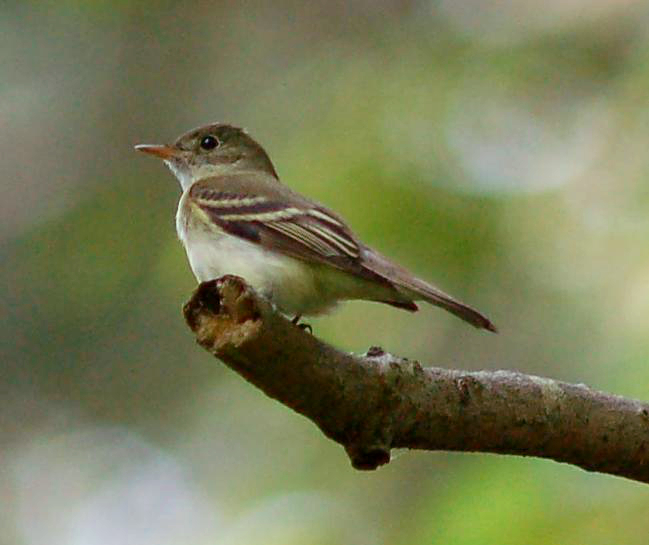
Wikipedia: Acadian flycatcher Source: OTHER
Acadian_Flycatcher.jpg
![]() The Acadian flycatcher (Empidonax virescens) is a small insect-eating bird of the tyrant flycatcher family.
[more]
The Acadian flycatcher (Empidonax virescens) is a small insect-eating bird of the tyrant flycatcher family.
[more]
Alder flycatcher (Empidonax alnorum)
Profile Wikipedia eBird Audubon AllAboutBirds Xeno-Canto

Wikipedia: Alder flycatcher Source: OTHER
1200px-Empidonax_alnorum_CT2.jpg
![]() The alder flycatcher (Empidonax alnorum) is a small insect-eating bird of the tyrant flycatcher family. The genus name Empidonax is from Ancient Greek empis, "gnat", and anax, "master". The specific alnorum is Latin and means "of the alders".[2]
[more]
The alder flycatcher (Empidonax alnorum) is a small insect-eating bird of the tyrant flycatcher family. The genus name Empidonax is from Ancient Greek empis, "gnat", and anax, "master". The specific alnorum is Latin and means "of the alders".[2]
[more]
Eastern kingbird / Königstyrann (Tyrannus tyrannus)
Profile Wikipedia eBird A-Z Animals Audubon AllAboutBirds Xeno-Canto
Eastern kingbird. 2022-04-29 12.54.00 Maryland
First observed in Maryland on 2021-06-14.
![]() Lanius tyrannus Linnaeus, 1758
[more]
Lanius tyrannus Linnaeus, 1758
[more]
Gray kingbird / Grauer Königstyrann (Tyrannus dominicensis)
Profile Wikipedia eBird Audubon AllAboutBirds Xeno-Canto

Wikipedia: Gray kingbird Source: OTHER
1200px-Grey_kingbird_%28Tyrannus_dominicensis_vorax%29.jpg
![]() The gray kingbird or grey kingbird, also known as pitirre, petchary, or white-breasted kingbird (Tyrannus dominicensis) is a passerine bird.
[more]
The gray kingbird or grey kingbird, also known as pitirre, petchary, or white-breasted kingbird (Tyrannus dominicensis) is a passerine bird.
[more]
Scissor-tailed flycatcher / Scherenschwanz-Königstyrann (Tyrannus forficatus)
Profile Wikipedia eBird Audubon AllAboutBirds Xeno-Canto
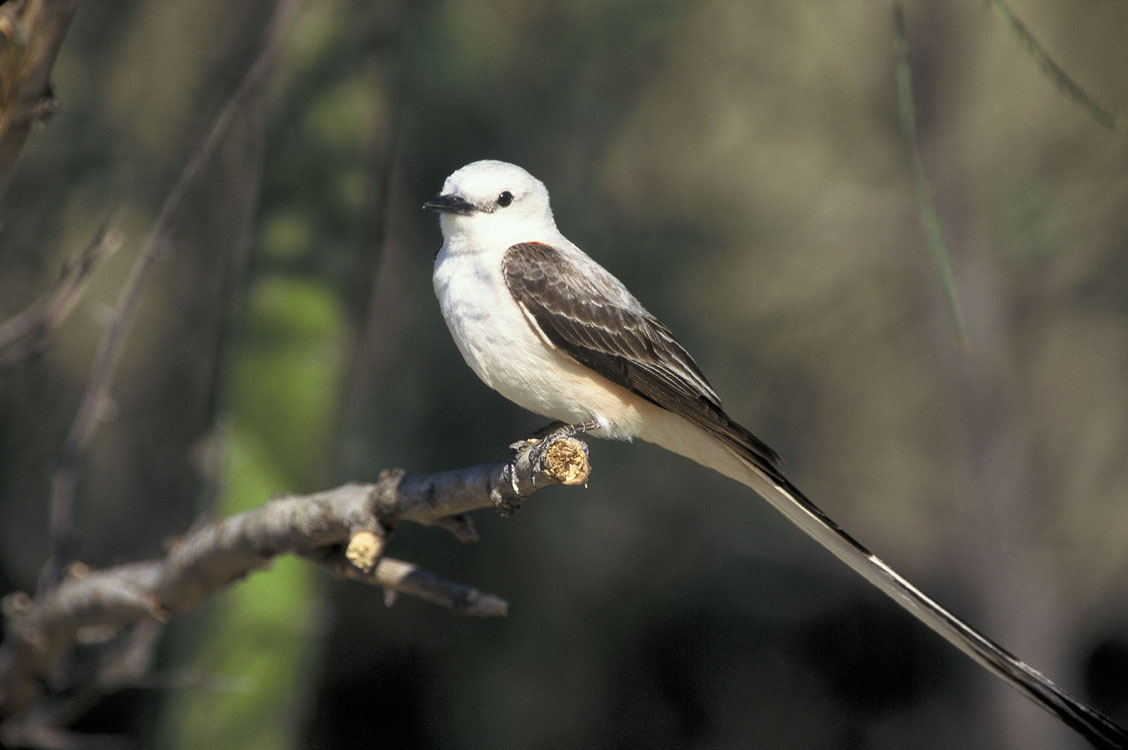
Wikipedia: Scissor-tailed flycatcher Source: OTHER
Tyrannus_forficatus_on_branch.jpg
![]() The scissor-tailed flycatcher (Tyrannus forficatus), also known as the Texas bird-of-paradise and swallow-tailed flycatcher, is a long-tailed bird of the genus Tyrannus, whose members are collectively referred to as kingbirds. The kingbirds are a group of large insectivorous (insect-eating) birds in the tyrant flycatcher (Tyrannidae) family. The scissor-tailed flycatcher is found in North and Central America.
[more]
The scissor-tailed flycatcher (Tyrannus forficatus), also known as the Texas bird-of-paradise and swallow-tailed flycatcher, is a long-tailed bird of the genus Tyrannus, whose members are collectively referred to as kingbirds. The kingbirds are a group of large insectivorous (insect-eating) birds in the tyrant flycatcher (Tyrannidae) family. The scissor-tailed flycatcher is found in North and Central America.
[more]
Tropical kingbird / Trauertyrann (Tyrannus melancholicus)
Profile Wikipedia eBird Audubon AllAboutBirds Xeno-Canto
Tropical kingbird tenative ID by MerlinBirdID, tail markings. 2018-02-16 16.21.26 Costa Rica
First observed in Costa Rica on 2018-02-16.
![]() The tropical kingbird (Tyrannus melancholicus) is a large tyrant flycatcher. This bird breeds from southern Arizona and the lower Rio Grande Valley of Texas in the United States through Central America, South America as far as south as central Argentina and eastern Peru, and on Trinidad and Tobago. Birds from the northernmost and southern breeding areas migrate to warmer parts of the range after breeding.
[more]
The tropical kingbird (Tyrannus melancholicus) is a large tyrant flycatcher. This bird breeds from southern Arizona and the lower Rio Grande Valley of Texas in the United States through Central America, South America as far as south as central Argentina and eastern Peru, and on Trinidad and Tobago. Birds from the northernmost and southern breeding areas migrate to warmer parts of the range after breeding.
[more]
Western kingbird / Arkansaskönigstyrann (Tyrannus verticalis)
Profile Wikipedia eBird Audubon AllAboutBirds Xeno-Canto
MerlinBirdID suggests western kingbird, birding tour near Rio Lagartos. 2023-04-15 08.41.04 Yucatan
First observed in Yucatan on 2023-04-15.
![]() The western kingbird (Tyrannus verticalis) is a large tyrant flycatcher found throughout western environments of North America and as far as Mexico.
[more]
The western kingbird (Tyrannus verticalis) is a large tyrant flycatcher found throughout western environments of North America and as far as Mexico.
[more]
Eastern phoebe / Weißbauch-Phoebetyrann (Sayornis phoebe)

Wikipedia: Eastern phoebe Source: OTHER
1200px-Sayornis_phoebe_-Owen_Conservation_Park%2C_Madison%2C_Wisconsin%2C_USA-8.jpg
First observed in Maryland on 2022-04-28.
![]() The eastern phoebe (Sayornis phoebe) is a small passerine bird. The genus name Sayornis is constructed from the specific part of Charles Lucien Bonaparte's name for Say's phoebe, Muscicapa saya, and Ancient Greek ornis, "bird".[2] Phoebe is an alternative name for the Roman moon-goddess Diana, but it may also have been chosen to imitate the bird's call.[3]
[more]
The eastern phoebe (Sayornis phoebe) is a small passerine bird. The genus name Sayornis is constructed from the specific part of Charles Lucien Bonaparte's name for Say's phoebe, Muscicapa saya, and Ancient Greek ornis, "bird".[2] Phoebe is an alternative name for the Roman moon-goddess Diana, but it may also have been chosen to imitate the bird's call.[3]
[more]
Call:
Automatically generated from Xeno-Canto recording
♫ Source: BirdNet
20220512_115707- birdnet - Eastern Phoebe - 2022-04-28 11:33:45 - birdnet_mobile_5867288364_recording_3278.wav.mp3
2022-05-12 11.57.07 (song?)
Olive-sided flycatcher / Fichtentyrann (Contopus cooperi)
Profile Wikipedia eBird Audubon AllAboutBirds Xeno-Canto

Wikipedia: Olive-sided flycatcher Source: OTHER
Olive-sided_Flycatcher.jpg
![]() The olive-sided flycatcher (Contopus cooperi) is a passerine bird. It is a medium-sized tyrant flycatcher.
[more]
The olive-sided flycatcher (Contopus cooperi) is a passerine bird. It is a medium-sized tyrant flycatcher.
[more]
Eastern wood-pewee (Contopus virens)
Profile Wikipedia eBird Audubon AllAboutBirds Xeno-Canto
Eastern wood pewee, last new bird we discovered - at the parking lot shortly before leaving, Oregon Ridge. 2021-06-19 09.34.10 Maryland
First observed in Maryland on 2021-06-19.
![]() The eastern wood pewee (Contopus virens) is a small tyrant flycatcher from North America. This bird and the western wood pewee (C. sordidulus) were formerly considered to be a single species. The two species are virtually identical in appearance, and can be distinguished most easily by their calls.
[more]
The eastern wood pewee (Contopus virens) is a small tyrant flycatcher from North America. This bird and the western wood pewee (C. sordidulus) were formerly considered to be a single species. The two species are virtually identical in appearance, and can be distinguished most easily by their calls.
[more]
Call:
Automatically generated from Xeno-Canto recording
♫ Source: BirdNet
20220501_084450 birdnet - Eastern Wood-Pewee - 2022-05-01 08:44:50 - Eastern Wood-Pewee - Cockeysville.mp3
2022-05-01 08.44.50 Cockeysville (song?)
Great crested flycatcher (Myiarchus crinitus)
Profile Wikipedia eBird A-Z Animals Audubon AllAboutBirds Xeno-Canto

Wikipedia: Great crested flycatcher Source: OTHER
Great_Crested_Flycatcher_RWD2.jpg
First observed in 🇨🇭 on 2021-03-18.
![]() The great crested flycatcher (Myiarchus crinitus) is a large insect-eating bird of the tyrant flycatcher family. It is the most widespread member of the genus Myiarchus in North America, and is found over most of the eastern and mid-western portions of the continent.[2] It dwells mostly in the treetops and rarely is found on the ground.[3]
[more]
The great crested flycatcher (Myiarchus crinitus) is a large insect-eating bird of the tyrant flycatcher family. It is the most widespread member of the genus Myiarchus in North America, and is found over most of the eastern and mid-western portions of the continent.[2] It dwells mostly in the treetops and rarely is found on the ground.[3]
[more]
Call:
Automatically generated from Xeno-Canto recording
♫ Source: BirdNet
20210318_165219- birdnet 9 - Great Crested Flycatcher - 2020-02-25 18:26:45 - birdnet_mobile_5867288364_recording_15.wav.mp3
2021-03-18 16.52.19 Fehraltorf (song?)
Ash-throated flycatcher (Myiarchus cinerascens)
Profile Wikipedia eBird Audubon AllAboutBirds Xeno-Canto
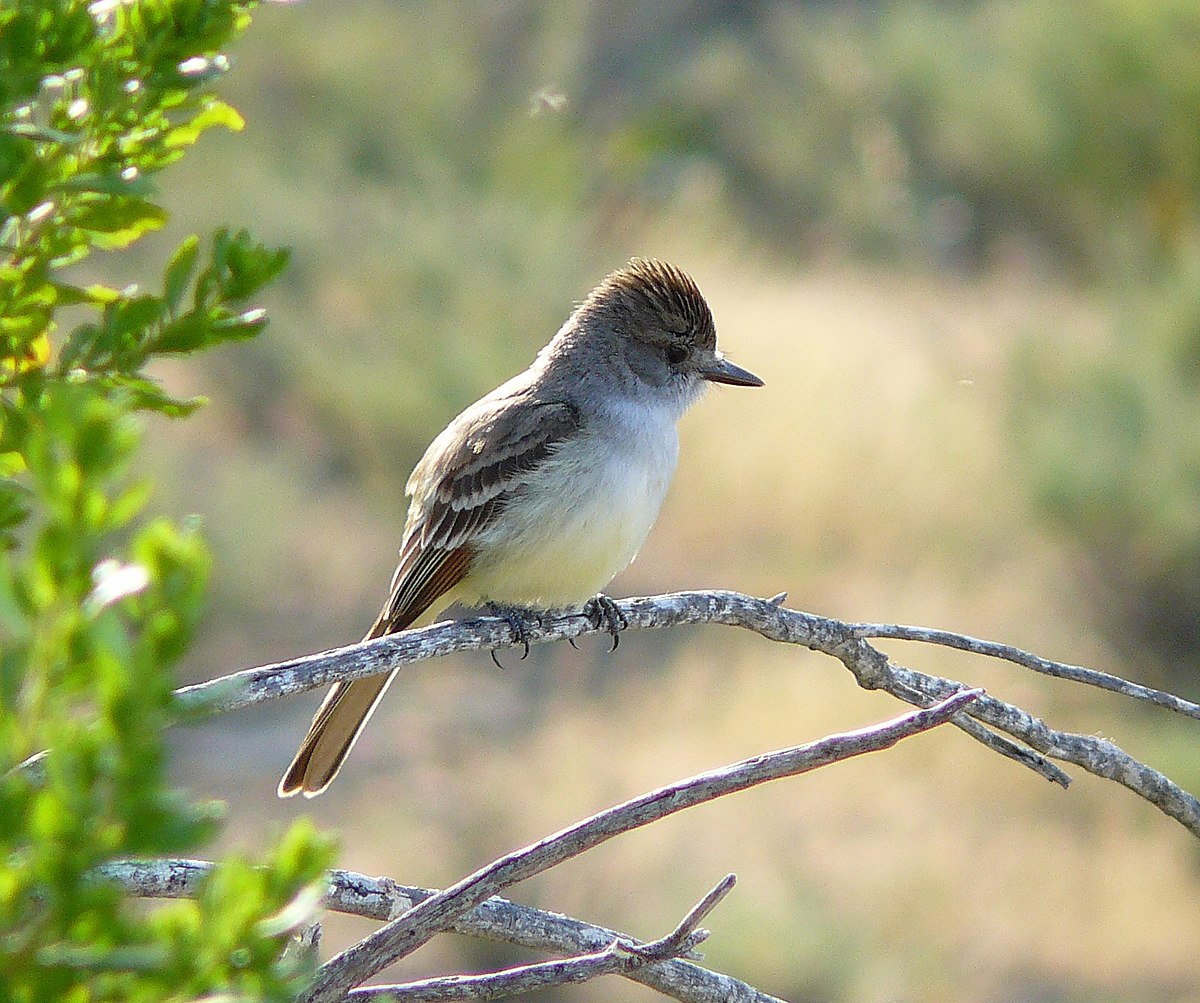
Wikipedia: Ash-throated flycatcher Source: OTHER
1200px-Myiarchus_cinerascens.jpg
![]() The ash-throated flycatcher (Myiarchus cinerascens) is a passerine bird in the tyrant flycatcher family. It breeds in desert scrub, riparian forest, brushy pastures and open woodland from the western United States to central Mexico. It is a short-distance migrant, retreating from most of the U.S. and northern and central Mexico, spending the winter from southern Mexico to Honduras. This bird is also prone to wander, with single birds often seen outside its normal breeding range as far away as the east coast of North America.
[more]
The ash-throated flycatcher (Myiarchus cinerascens) is a passerine bird in the tyrant flycatcher family. It breeds in desert scrub, riparian forest, brushy pastures and open woodland from the western United States to central Mexico. It is a short-distance migrant, retreating from most of the U.S. and northern and central Mexico, spending the winter from southern Mexico to Honduras. This bird is also prone to wander, with single birds often seen outside its normal breeding range as far away as the east coast of North America.
[more]
Brown-crested flycatcher (Myiarchus tyrannulus)
Profile Wikipedia eBird Audubon AllAboutBirds Xeno-Canto
Brown-crested flycatcher in Holbox by a morning walk. 2023-04-21 07.30.58 Yucatan
First observed in Yucatan on 2023-04-07.
![]() The brown-crested flycatcher (Myiarchus tyrannulus) is a passerine bird in the tyrant flycatcher family.
[more]
The brown-crested flycatcher (Myiarchus tyrannulus) is a passerine bird in the tyrant flycatcher family.
[more]
Vermilion flycatcher (Pyrocephalus rubinus)
Profile Wikipedia eBird A-Z Animals Audubon AllAboutBirds Xeno-Canto

Wikipedia: Vermilion flycatcher Source: OTHER
1200px-Vermilion_Flycatcher_by_Dan_Pancamo.jpg
![]() The vermilion flycatcher (Pyrocephalus obscurus) is a small passerine bird in the tyrant flycatcher family found throughout South America and southern North America. It is a striking exception among the generally drab Tyrannidae due to its vermilion-red coloration. The males have bright red crowns, chests, and underparts, with brownish wings and tails. Females lack the vivid red coloration and can be hard to identify—they may be confused for the Say's phoebe. The vermilion flycatcher's song is a pit pit pit pidddrrrreeedrr, which is variable and important in establishing a territory. Riparian habitats and semi-open environments are preferred. As aerial insectivores, they catch their prey while flying. Their several months-long molt begins in summer.
[more]
The vermilion flycatcher (Pyrocephalus obscurus) is a small passerine bird in the tyrant flycatcher family found throughout South America and southern North America. It is a striking exception among the generally drab Tyrannidae due to its vermilion-red coloration. The males have bright red crowns, chests, and underparts, with brownish wings and tails. Females lack the vivid red coloration and can be hard to identify—they may be confused for the Say's phoebe. The vermilion flycatcher's song is a pit pit pit pidddrrrreeedrr, which is variable and important in establishing a territory. Riparian habitats and semi-open environments are preferred. As aerial insectivores, they catch their prey while flying. Their several months-long molt begins in summer.
[more]
Brown-headed nuthatch / Braunkopfkleiber (Sitta pusilla)
Profile Wikipedia eBird Audubon AllAboutBirds Xeno-Canto
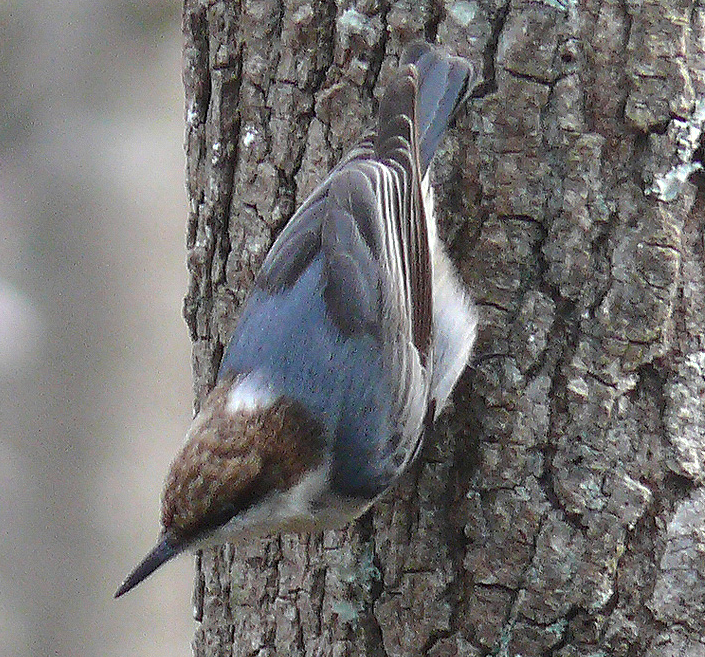
Wikipedia: Brown-headed nuthatch Source: OTHER
Brown-headed_Nuthatch-27527-4c.jpg
![]() The brown-headed nuthatch (Sitta pusilla) is a small songbird found in pine forests throughout the Southeastern United States. Genetic analyses indicated low differentiation between northern and southern populations in Florida, but the study also found lower genetic diversity among south Florida populations that may be a result of the increased habitat fragmentation that was documented. A population on the Bahamas showed moderate to high differentiation compared with Florida populations.[2] The Bahama nuthatch was and still is considered a subspecies (S. p. insularis) by several authorities including the IOC, but the IUCN and BirdLife International have reclassified it as its own separate species.[3] Two recent studies assessing vocalizations in Bahama and continental nuthatch populations found important differences.[4][5] One of the studies[4] also demonstrated that continental and Bahama populations did not respond aggressively to calls of the other population. This type of call-response study is often used to help define cryptic species.[6]
[more]
The brown-headed nuthatch (Sitta pusilla) is a small songbird found in pine forests throughout the Southeastern United States. Genetic analyses indicated low differentiation between northern and southern populations in Florida, but the study also found lower genetic diversity among south Florida populations that may be a result of the increased habitat fragmentation that was documented. A population on the Bahamas showed moderate to high differentiation compared with Florida populations.[2] The Bahama nuthatch was and still is considered a subspecies (S. p. insularis) by several authorities including the IOC, but the IUCN and BirdLife International have reclassified it as its own separate species.[3] Two recent studies assessing vocalizations in Bahama and continental nuthatch populations found important differences.[4][5] One of the studies[4] also demonstrated that continental and Bahama populations did not respond aggressively to calls of the other population. This type of call-response study is often used to help define cryptic species.[6]
[more]
White-breasted nuthatch / Carolinakleiber (Sitta carolinensis)
Profile Wikipedia eBird Audubon AllAboutBirds Xeno-Canto
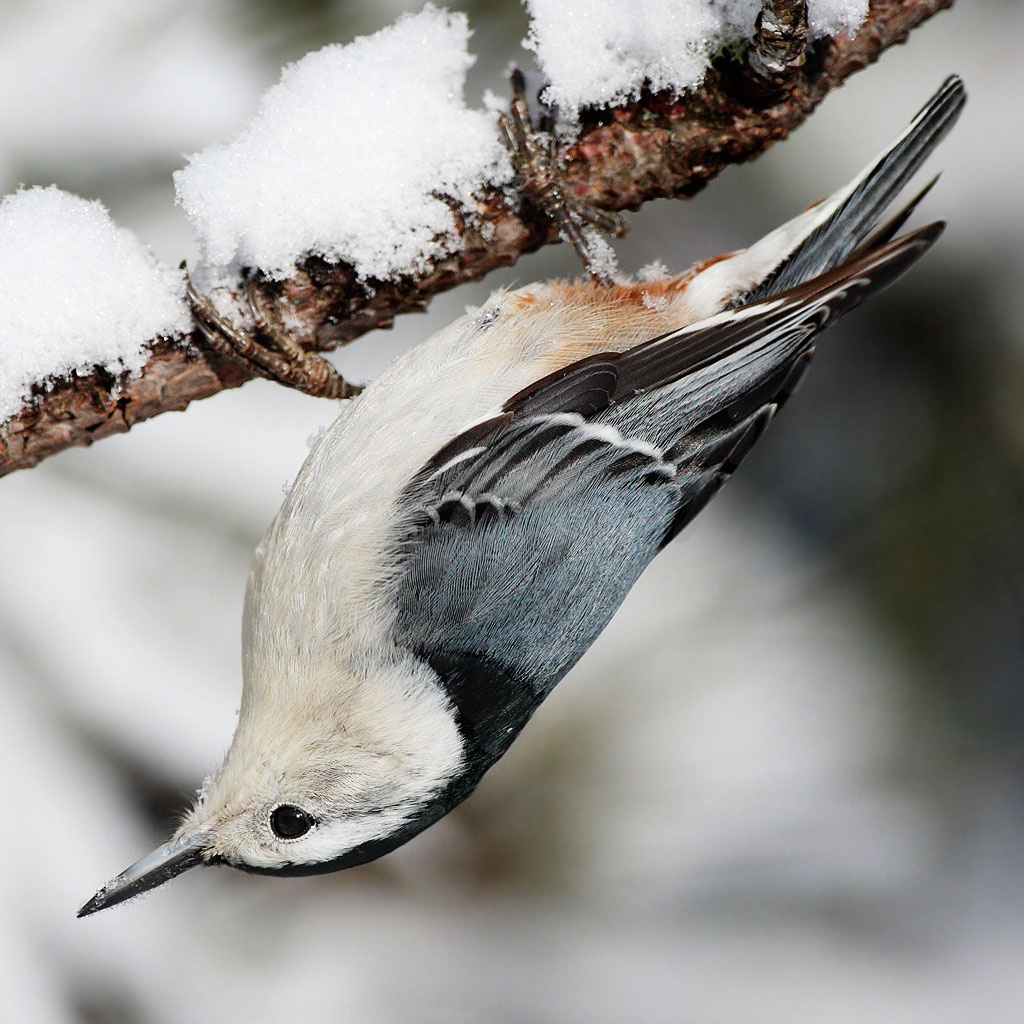
Wikipedia: White-breasted nuthatch Source: OTHER
Sitta-carolinensis-001.jpg
![]() The white-breasted nuthatch (Sitta carolinensis) is a small songbird of the nuthatch family common across much of temperate North America. It is stocky, with a large head, short tail, powerful bill, and strong feet. It has a black cap, white face, chest, and flanks, blue-gray upperparts, and a chestnut lower belly. Its nine subspecies differ mainly in the color of the body plumage.
[more]
The white-breasted nuthatch (Sitta carolinensis) is a small songbird of the nuthatch family common across much of temperate North America. It is stocky, with a large head, short tail, powerful bill, and strong feet. It has a black cap, white face, chest, and flanks, blue-gray upperparts, and a chestnut lower belly. Its nine subspecies differ mainly in the color of the body plumage.
[more]
Red-breasted nuthatch / Kanadakleiber (Sitta canadensis)
Profile Wikipedia eBird Audubon AllAboutBirds Xeno-Canto

Wikipedia: Red-breasted nuthatch Source: OTHER
1200px-Sitta_canadensis_CT2.jpg
![]() The red-breasted nuthatch (Sitta canadensis) is a small songbird. The adult has blue-grey upperparts with cinnamon underparts, a white throat and face with a black stripe through the eyes, a straight grey bill and a black crown. Its call, which has been likened to a tin trumpet, is high-pitched and nasal. It breeds in coniferous forests across Canada, Alaska and the northeastern and western United States. Though often a permanent resident, it regularly irrupts further south if its food supply fails. There are records of vagrants occurring as far south as the Gulf Coast and northern Mexico. It forages on the trunks and large branches of trees, often descending head first, sometimes catching insects in flight. It eats mainly insects and seeds, especially from conifers. It excavates its nest in dead wood, often close to the ground, smearing the entrance with pitch.
[more]
The red-breasted nuthatch (Sitta canadensis) is a small songbird. The adult has blue-grey upperparts with cinnamon underparts, a white throat and face with a black stripe through the eyes, a straight grey bill and a black crown. Its call, which has been likened to a tin trumpet, is high-pitched and nasal. It breeds in coniferous forests across Canada, Alaska and the northeastern and western United States. Though often a permanent resident, it regularly irrupts further south if its food supply fails. There are records of vagrants occurring as far south as the Gulf Coast and northern Mexico. It forages on the trunks and large branches of trees, often descending head first, sometimes catching insects in flight. It eats mainly insects and seeds, especially from conifers. It excavates its nest in dead wood, often close to the ground, smearing the entrance with pitch.
[more]
Brown thrasher / Rotspottdrossel (Toxostoma rufum)
Profile Wikipedia eBird Audubon AllAboutBirds Xeno-Canto

Wikipedia: Brown thrasher Source: OTHER
1200px-Brown_thrasher_in_CP_%2802147%29.jpg
First observed in Cockeysville on 2022-04-29.
![]() The brown thrasher (Toxostoma rufum) is a bird in the family Mimidae, which also includes the New World catbirds and mockingbirds. The brown thrasher is abundant throughout the eastern and central United States and southern and central Canada, and it is the only thrasher to live primarily east of the Rockies and central Texas. It is the state bird of Georgia.
[more]
The brown thrasher (Toxostoma rufum) is a bird in the family Mimidae, which also includes the New World catbirds and mockingbirds. The brown thrasher is abundant throughout the eastern and central United States and southern and central Canada, and it is the only thrasher to live primarily east of the Rockies and central Texas. It is the state bird of Georgia.
[more]
Call:
Automatically generated from Xeno-Canto recording
♫ Source: BirdNet
20220429_082734 birdnet - Brown Thrasher - Brown Thrasher - Cockeysville.mp3
2022-04-29 08.27.34 Cockeysville (song?)
Bahama mockingbird (Mimus gundlachii)

Wikipedia: Bahama mockingbird Source: OTHER
1200px-Mimus_gundlachii_-Ciego_de_Avila_Province%2C_Cuba-8_%282%29.jpg
![]() The Bahama mockingbird (Mimus gundlachii) is a species of bird in the family Mimidae.
It is found in the Bahamas, Cuba, Jamaica and the Turks and Caicos Islands, and is a vagrant to Florida.[2] Its natural habitats are subtropical or tropical dry forest, subtropical or tropical moist lowland forest, subtropical or tropical dry shrubland, and heavily degraded former forest.
[more]
The Bahama mockingbird (Mimus gundlachii) is a species of bird in the family Mimidae.
It is found in the Bahamas, Cuba, Jamaica and the Turks and Caicos Islands, and is a vagrant to Florida.[2] Its natural habitats are subtropical or tropical dry forest, subtropical or tropical moist lowland forest, subtropical or tropical dry shrubland, and heavily degraded former forest.
[more]
Northern mockingbird / Gartenspottdrossel (Mimus polyglottos)
Northern mockingbird with its very long legs and tails, Cherrywood Court. 2021-06-17 05.53.30 Maryland
First observed in Maryland on 2021-06-17.
![]() The northern mockingbird (Mimus polyglottos) is a mockingbird commonly found in North America. This bird is mainly a permanent resident, but northern birds may move south during harsh weather. This species has rarely been observed in Europe. This species was first described by Carl Linnaeus in his 1758 10th edition of Systema Naturae as Turdus polyglottos. The northern mockingbird is known for its mimicking ability, as reflected by the meaning of its scientific name, "many-tongued thrush". The northern mockingbird has gray to brown upper feathers and a paler belly. Its tail and wings have white patches which are visible in flight.[2]
[more]
The northern mockingbird (Mimus polyglottos) is a mockingbird commonly found in North America. This bird is mainly a permanent resident, but northern birds may move south during harsh weather. This species has rarely been observed in Europe. This species was first described by Carl Linnaeus in his 1758 10th edition of Systema Naturae as Turdus polyglottos. The northern mockingbird is known for its mimicking ability, as reflected by the meaning of its scientific name, "many-tongued thrush". The northern mockingbird has gray to brown upper feathers and a paler belly. Its tail and wings have white patches which are visible in flight.[2]
[more]
Call:
Automatically generated from Xeno-Canto recording
♫ Probably northern mockingbird at Silversage Court, Hunt Valley. 2021-06-20 08.51.26 Maryland (song?)
Grey catbird / Katzendrossel (Dumetella carolinensis)
Gray catbird. 2022-04-30 09.51.08 Maryland
First observed in Cockeysville on 2021-06-11.
![]() The gray catbird (Dumetella carolinensis), also spelled grey catbird, is a medium-sized North American and Central American perching bird of the mimid family. It is the only member of the "catbird" genus Dumetella. Like the black catbird (Melanoptila glabrirostris), it is among the basal lineages of the Mimidae, probably a closer relative of the Caribbean thrasher and trembler assemblage than of the mockingbirds and Toxostoma thrashers.[2][3] In some areas it is known as the slate-colored mockingbird.[4]
[more]
The gray catbird (Dumetella carolinensis), also spelled grey catbird, is a medium-sized North American and Central American perching bird of the mimid family. It is the only member of the "catbird" genus Dumetella. Like the black catbird (Melanoptila glabrirostris), it is among the basal lineages of the Mimidae, probably a closer relative of the Caribbean thrasher and trembler assemblage than of the mockingbirds and Toxostoma thrashers.[2][3] In some areas it is known as the slate-colored mockingbird.[4]
[more]
Song:
Automatically generated from Xeno-Canto recording
Song attributes:
Frequency:
♫ Gray catbird weird song, Cherrywood Court. 2021-06-16 07.38.03 Cherrywood (song)
Call:
Automatically generated from Xeno-Canto recording
♫ Source: BirdNet
20220503_083848 birdnet - Gray Catbird - 2022-05-03 08:38:48 - Gray Catbird - Cockeysville.mp3
2022-05-03 08.38.48 Cockeysville (song?)
Profile Wikipedia eBird A-Z Animals Audubon AllAboutBirds Xeno-Canto
House wren. 2022-05-05 08.41.48 Maryland
First observed in Cherrywood on 2021-06-17.
![]() The house wren (Troglodytes aedon) is a very small songbird of the wren family, Troglodytidae. It occurs from Canada to southernmost South America, and is thus the most widely distributed native bird in the Americas.[2] It occurs in most suburban areas in its range and it is the single most common wren. Its taxonomy is highly complex and some subspecies groups are often considered separate species.
[more]
The house wren (Troglodytes aedon) is a very small songbird of the wren family, Troglodytidae. It occurs from Canada to southernmost South America, and is thus the most widely distributed native bird in the Americas.[2] It occurs in most suburban areas in its range and it is the single most common wren. Its taxonomy is highly complex and some subspecies groups are often considered separate species.
[more]
Call:
Automatically generated from Xeno-Canto recording
♫ Source: BirdNet
20220503_103153 birdnet - House Wren - 2022-05-03 10:31:53 - House Wren - Cockeysville.mp3
2022-05-03 10.31.53 Cockeysville (song?)
Profile Wikipedia eBird Audubon AllAboutBirds Xeno-Canto

Wikipedia: Winter wren Source: OTHER
1200px-Winter_wren_in_Prospect_Park_%2832249%29.jpg
![]() Olbiorchilus hiemalis
Olbiorchilus hiemalis
Nannus hiemalis
[more]
Profile Wikipedia eBird Audubon AllAboutBirds Xeno-Canto
Carolina wren, Cromwell Valley Park. 2021-06-18 10.15.06 Maryland
First observed in Cockeysville on 2021-06-13.
![]() The Carolina wren (Thryothorus ludovicianus) is a common species of wren that is a resident in the eastern half of the United States of America, the extreme south of Ontario, Canada, and the extreme northeast of Mexico. Severe winters restrict the northern limits of their range while favorable weather conditions lead to a northward extension of their breeding range. Their preferred habitat is in dense cover in forest, farm edges and suburban areas. This wren is the state bird of South Carolina.
[more]
The Carolina wren (Thryothorus ludovicianus) is a common species of wren that is a resident in the eastern half of the United States of America, the extreme south of Ontario, Canada, and the extreme northeast of Mexico. Severe winters restrict the northern limits of their range while favorable weather conditions lead to a northward extension of their breeding range. Their preferred habitat is in dense cover in forest, farm edges and suburban areas. This wren is the state bird of South Carolina.
[more]
Call:
Automatically generated from Xeno-Canto recording
♫ Carolina wren sings Figaro. ![]() Source: Zoom H6 2022-04-29 08.33.28 Maryland (song?)
Source: Zoom H6 2022-04-29 08.33.28 Maryland (song?)
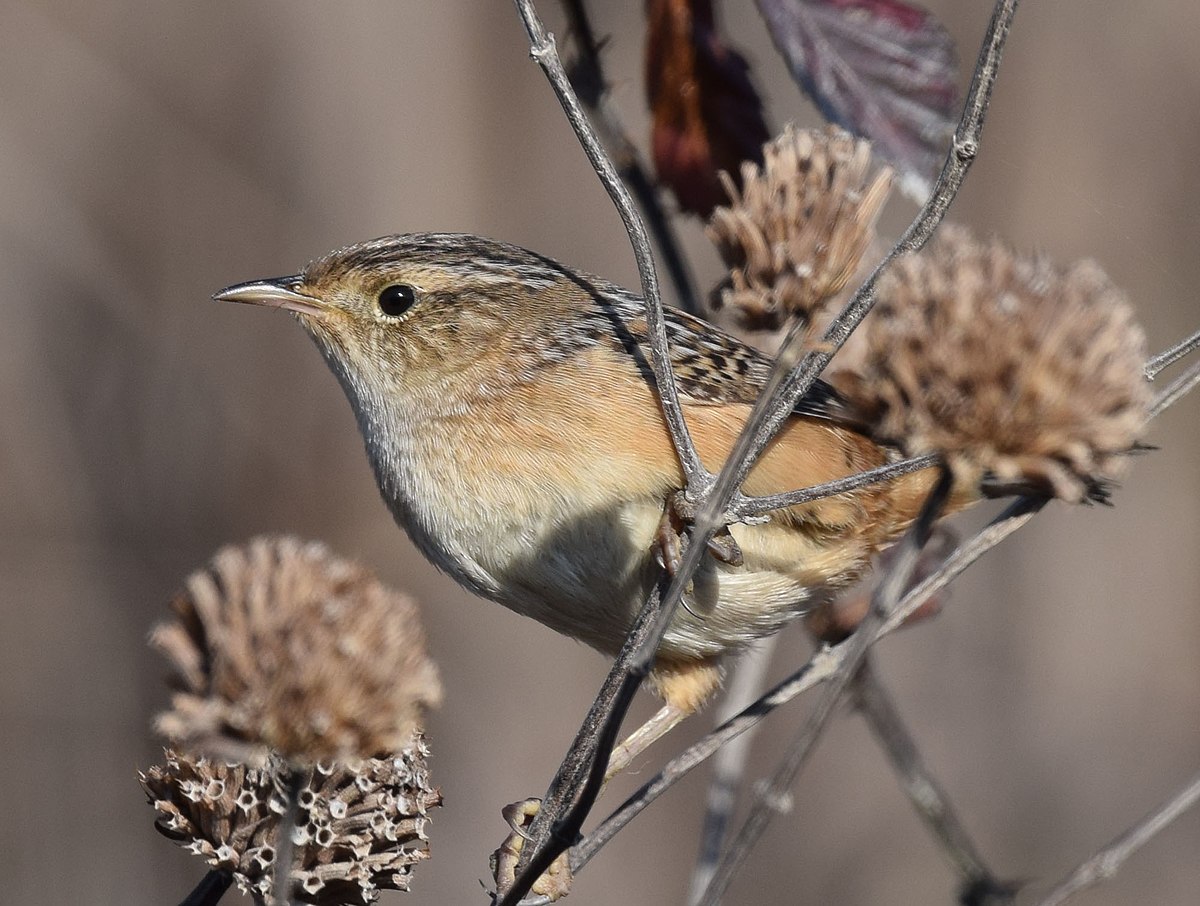
Wikipedia: Sedge wren Source: OTHER
1200px-Sedge_Wren_%2831204304001%29.jpg
![]() The sedge wren (Cistothorus stellaris) is a small and secretive passerine bird in the family Troglodytidae. It is widely distributed in North America. It is often found in wet grasslands and meadows where it nests in the tall grasses and sedges and feeds on insects. The sedge wren was formerly considered as conspecific with the non-migratory grass wren of central and South America.
[more]
The sedge wren (Cistothorus stellaris) is a small and secretive passerine bird in the family Troglodytidae. It is widely distributed in North America. It is often found in wet grasslands and meadows where it nests in the tall grasses and sedges and feeds on insects. The sedge wren was formerly considered as conspecific with the non-migratory grass wren of central and South America.
[more]
Profile Wikipedia eBird Audubon AllAboutBirds Xeno-Canto NABU
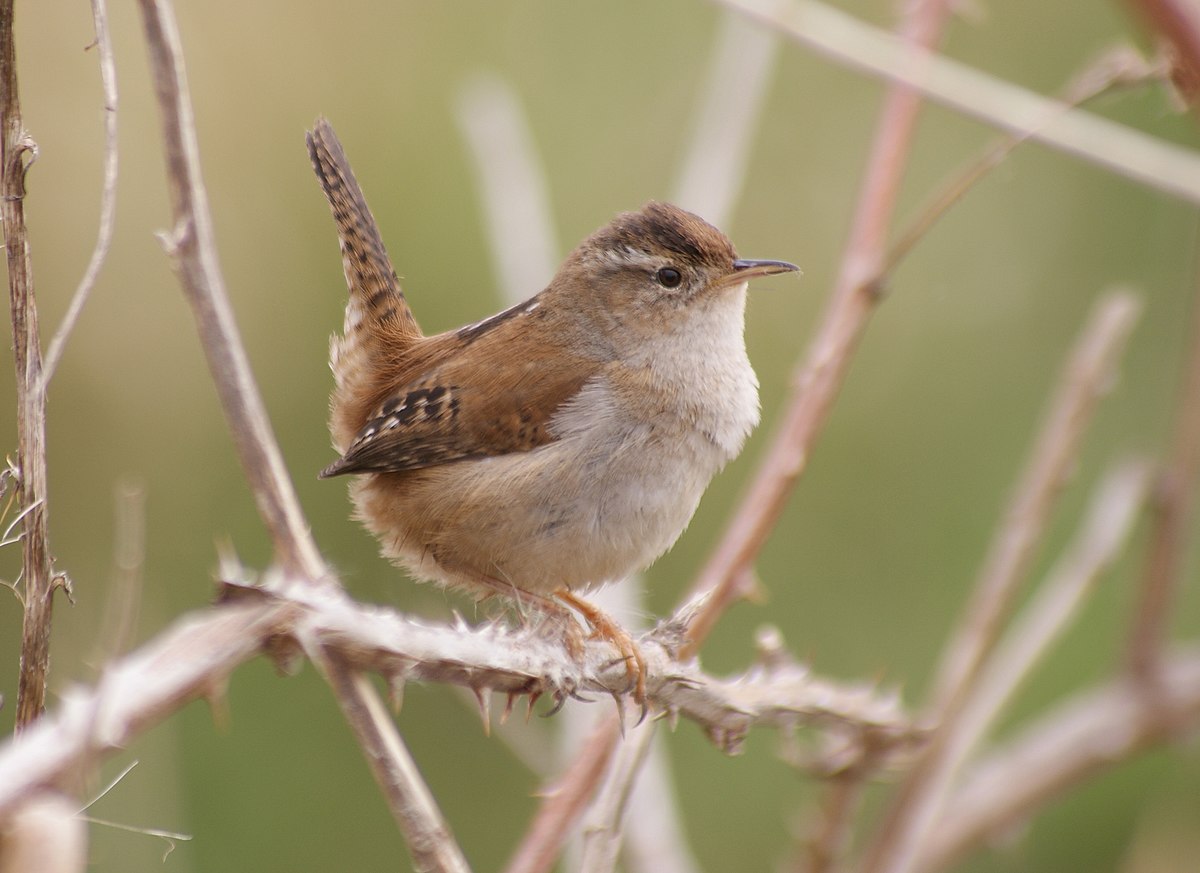
Wikipedia: Marsh wren Source: OTHER
1200px-Cistothorus_palustris_-Reifel_Island%2C_Vancouver-8.jpg
This bird appears across the great seas in the following continents:
Europe, North America.
![]() The marsh wren (Cistothorus palustris) is a small North American songbird of the wren family. It is sometimes called the long-billed marsh wren to distinguish it from the sedge wren, also known as the short-billed marsh wren.
[more]
The marsh wren (Cistothorus palustris) is a small North American songbird of the wren family. It is sometimes called the long-billed marsh wren to distinguish it from the sedge wren, also known as the short-billed marsh wren.
[more]
Profile Wikipedia eBird Audubon AllAboutBirds Xeno-Canto

Wikipedia: Brown creeper Source: OTHER
Certhia-americana-001.jpg
![]() The brown creeper (Certhia americana), also known as the American treecreeper, is a small songbird, the only North American member of the treecreeper family Certhiidae.
[more]
The brown creeper (Certhia americana), also known as the American treecreeper, is a small songbird, the only North American member of the treecreeper family Certhiidae.
[more]
Profile Wikipedia eBird Audubon AllAboutBirds Xeno-Canto
Blue-gray gnatcatcher. 2023-04-16 09.34.24 Yucatan
First observed in Maryland on 2022-04-29.
![]() The blue-gray gnatcatcher or blue-grey gnatcatcher (Polioptila caerulea) is a very small songbird native to North America.
[more]
The blue-gray gnatcatcher or blue-grey gnatcatcher (Polioptila caerulea) is a very small songbird native to North America.
[more]
Call:
Automatically generated from Xeno-Canto recording
♫ Source: BirdNet
20220429_112508 birdnet - Blue-gray Gnatcatcher - 2022-04-29 11:25:08 - Blue-gray Gnatcatcher - Baltimore.mp3
2022-04-29 11.25.08 Maryland (song?)
Cedar waxwing (Bombycilla cedrorum)
Profile Wikipedia eBird A-Z Animals Audubon AllAboutBirds Xeno-Canto

Wikipedia: Cedar waxwing Source: OTHER
Cedar_Waxwing_-_Bombycilla_cedrorum%2C_George_Washington%27s_Birthplace_National_Monument%2C_Colonial_Beach%2C_Virginia_%2839997434862%29.jpg
![]() The cedar waxwing (Bombycilla cedrorum) is a member of the family Bombycillidae or waxwing family of passerine birds. It is a medium-sized, mostly brown, gray, and yellow. This bird is named for its wax-like wing tips. It is a native of North and Central America, breeding in open wooded areas in southern Canada and wintering in the southern half of the United States, Central America, and the far northwest of South America. Its diet includes cedar cones, fruit, and insects.[2] The cedar waxwing is not endangered.
[more]
The cedar waxwing (Bombycilla cedrorum) is a member of the family Bombycillidae or waxwing family of passerine birds. It is a medium-sized, mostly brown, gray, and yellow. This bird is named for its wax-like wing tips. It is a native of North and Central America, breeding in open wooded areas in southern Canada and wintering in the southern half of the United States, Central America, and the far northwest of South America. Its diet includes cedar cones, fruit, and insects.[2] The cedar waxwing is not endangered.
[more]
Profile Wikipedia eBird Audubon AllAboutBirds Xeno-Canto
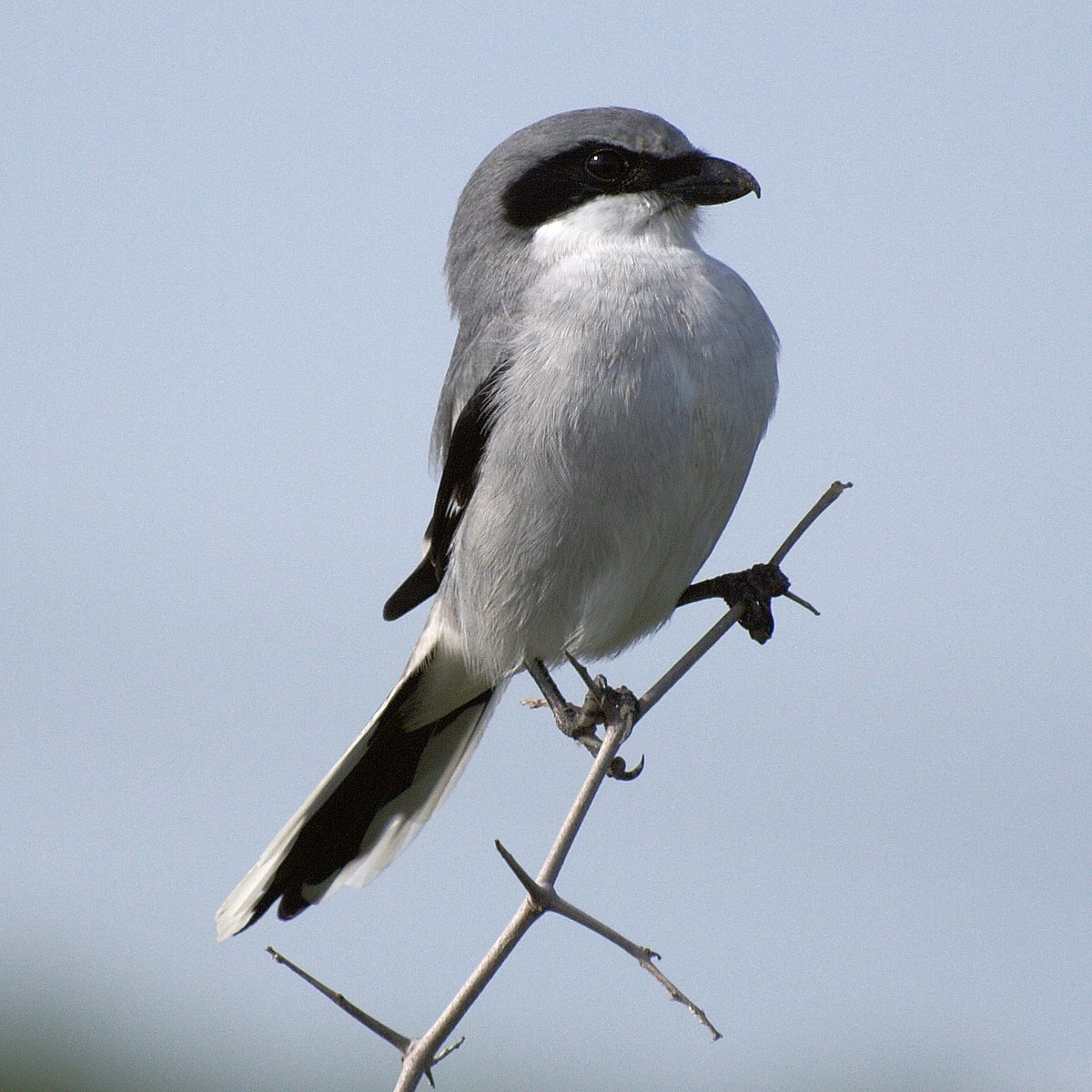
Wikipedia: Loggerhead shrike Source: OTHER
1200px-Lanius_ludovicianus_-Texas_-USA-8-4c.jpg
![]() The loggerhead shrike (Lanius ludovicianus) is a passerine bird in the family Laniidae. It is one of two members of the shrike family endemic to North America; the related northern shrike (L. borealis) occurs north of its range. It is nicknamed the butcherbird after its carnivorous tendencies, as it consumes prey such as amphibians, insects, lizards, small mammals and small birds, and some prey end up displayed and stored at a site, for example in a tree.[2] Due to its small size and weak talons, this predatory bird relies on impaling its prey upon thorns or barbed wire for facilitated consumption.[3] The numbers of loggerhead shrike have significantly decreased in recent years, especially in Midwestern, New England and Mid-Atlantic areas.[4]
[more]
The loggerhead shrike (Lanius ludovicianus) is a passerine bird in the family Laniidae. It is one of two members of the shrike family endemic to North America; the related northern shrike (L. borealis) occurs north of its range. It is nicknamed the butcherbird after its carnivorous tendencies, as it consumes prey such as amphibians, insects, lizards, small mammals and small birds, and some prey end up displayed and stored at a site, for example in a tree.[2] Due to its small size and weak talons, this predatory bird relies on impaling its prey upon thorns or barbed wire for facilitated consumption.[3] The numbers of loggerhead shrike have significantly decreased in recent years, especially in Midwestern, New England and Mid-Atlantic areas.[4]
[more]
Profile Wikipedia eBird A-Z Animals Audubon AllAboutBirds Xeno-Canto
Blue Jay. 2022-05-08 09.48.40 Maryland
First observed in Maryland on 2021-06-14.
![]() The blue jay (Cyanocitta cristata) is a passerine bird in the family Corvidae, native to eastern North America. It lives in most of the eastern and central United States; eastern populations may be migratory. Resident populations are also found in Newfoundland, Canada; breeding populations are found across southern Canada. It breeds in both deciduous and coniferous forests, and is common in residential areas. It is predominantly blue, with a white chest and underparts, and a blue crest; it has a black, U-shaped collar around its neck and a black border behind the crest. Males and females are similar in size and plumage, and plumage does not vary throughout the year. Four subspecies have been recognized.
[more]
The blue jay (Cyanocitta cristata) is a passerine bird in the family Corvidae, native to eastern North America. It lives in most of the eastern and central United States; eastern populations may be migratory. Resident populations are also found in Newfoundland, Canada; breeding populations are found across southern Canada. It breeds in both deciduous and coniferous forests, and is common in residential areas. It is predominantly blue, with a white chest and underparts, and a blue crest; it has a black, U-shaped collar around its neck and a black border behind the crest. Males and females are similar in size and plumage, and plumage does not vary throughout the year. Four subspecies have been recognized.
[more]
Call:
Automatically generated from Xeno-Canto recording
♫ Source: BirdNet
20220502_161140 birdnet - Blue Jay - 2022-05-02 16:11:40 - Blue Jay - Cockeysville.mp3
2022-05-02 16.11.40 Cockeysville (song?)
Profile Wikipedia eBird Audubon AllAboutBirds Xeno-Canto
Fish crows says MerlinBirdID. 2023-09-24 10.04.16 Florida
First observed in Florida on 2023-09-24.
![]() The fish crow (Corvus ossifragus) is a species of crow associated with wetland habitats in the eastern and southeastern United States.
[more]
The fish crow (Corvus ossifragus) is a species of crow associated with wetland habitats in the eastern and southeastern United States.
[more]
Profile Wikipedia eBird Audubon AllAboutBirds Xeno-Canto
American crow. 2022-05-05 19.32.30 Maryland
First observed in Cockeysville on 2021-06-12.
![]() The American crow (Corvus brachyrhynchos) is a large passerine bird species of the family Corvidae. It is a common bird found throughout much of North America.
American crows are the New World counterpart to the carrion crow and the hooded crow. Although the American crow and the hooded crow are very similar in size, structure and behavior, their calls are different. The American crow, nevertheless, occupies the same role that the hooded crow does in Eurasia.
[more]
The American crow (Corvus brachyrhynchos) is a large passerine bird species of the family Corvidae. It is a common bird found throughout much of North America.
American crows are the New World counterpart to the carrion crow and the hooded crow. Although the American crow and the hooded crow are very similar in size, structure and behavior, their calls are different. The American crow, nevertheless, occupies the same role that the hooded crow does in Eurasia.
[more]
Call:
Automatically generated from Xeno-Canto recording
♫ Source: BirdNet
20210612_131735 birdnet 1621 - American Crow - 2021-06-12 13:17:35 - American Crow - Cockeysville.mp3
2021-06-12 13.17.35 Cockeysville (song?)

Wikipedia: Scrub jay Source: OTHER
WesternScrubJay2.jpg
![]() The passerine birds of the genus Aphelocoma[A] include the scrub jays and their relatives. They are New World jays found in Mexico, western Central America and the western United States, with an outlying population in Florida. This genus belongs to the group of New World (or "blue") jays–possibly a distinct subfamily–which is not closely related to other jays, magpies or treepies.[1] They live in open pine-oak forests, chaparral, and mixed evergreen forests.
[more]
The passerine birds of the genus Aphelocoma[A] include the scrub jays and their relatives. They are New World jays found in Mexico, western Central America and the western United States, with an outlying population in Florida. This genus belongs to the group of New World (or "blue") jays–possibly a distinct subfamily–which is not closely related to other jays, magpies or treepies.[1] They live in open pine-oak forests, chaparral, and mixed evergreen forests.
[more]
Profile Wikipedia eBird Audubon AllAboutBirds Xeno-Canto

Wikipedia: Yellow-throated vireo Source: OTHER
1200px-Vireo-flavifrons-001.jpg
![]() The yellow-throated vireo (Vireo flavifrons) is a small American songbird.
[more]
The yellow-throated vireo (Vireo flavifrons) is a small American songbird.
[more]
Profile Wikipedia eBird Audubon AllAboutBirds Xeno-Canto

Wikipedia: Warbling vireo Source: OTHER
WarblingVireo08.jpg
![]() The warbling vireo (Vireo gilvus) is a small North American songbird.
[more]
The warbling vireo (Vireo gilvus) is a small North American songbird.
[more]
Profile Wikipedia eBird Audubon AllAboutBirds Xeno-Canto

Wikipedia: Red-eyed vireo Source: OTHER
1200px-Vireo_olivaceus_-Madison_-Wisconsin_-USA-8.jpg
First observed in Cockeysville on 2021-06-13.
![]() The red-eyed vireo (Vireo olivaceus) is a small American songbird. It is somewhat warbler-like but not closely related to the New World warblers (Parulidae). Common across its vast range, this species is not considered threatened by the IUCN.
[more]
The red-eyed vireo (Vireo olivaceus) is a small American songbird. It is somewhat warbler-like but not closely related to the New World warblers (Parulidae). Common across its vast range, this species is not considered threatened by the IUCN.
[more]
Song:
Automatically generated from Xeno-Canto recording
Song attributes:
Frequency:
♫ Source: BirdNet
20210615_182200 birdnet 1658 - Red-eyed Vireo, two-part song - Red-eyed Vireo - Cockeysville.mp3
2021-06-15 18.22.00 Cockeysville (song)
Call:
Automatically generated from Xeno-Canto recording
♫ Supposedly red eyed vireo at ncr trail, did not see. 2021-06-15 12.23.30 Maryland (song?)

Wikipedia: Philadelphia vireo Source: OTHER
Vireo_philadelphicus.jpg
![]() The Philadelphia vireo (Vireo philadelphicus) is a small North American songbird in the vireo family (Vireonidae). "Vireo" is a Latin word referring to a green migratory bird, perhaps the female golden oriole, possibly the European greenfinch. The specific philadelphicus is for the city of Philadelphia.[2][3]
[more]
The Philadelphia vireo (Vireo philadelphicus) is a small North American songbird in the vireo family (Vireonidae). "Vireo" is a Latin word referring to a green migratory bird, perhaps the female golden oriole, possibly the European greenfinch. The specific philadelphicus is for the city of Philadelphia.[2][3]
[more]
Profile Wikipedia eBird Audubon AllAboutBirds Xeno-Canto
White-eyed vireo. 2022-05-01 09.22.26 Maryland
First observed in Cockeysville on 2022-05-01.
![]() The white-eyed vireo (Vireo griseus) is a small songbird. It breeds in the southeastern United States from New Jersey west to northern Missouri and south to Texas and Florida, and also in eastern Mexico, northern Central America, Cuba and the Bahamas.
[more]
The white-eyed vireo (Vireo griseus) is a small songbird. It breeds in the southeastern United States from New Jersey west to northern Missouri and south to Texas and Florida, and also in eastern Mexico, northern Central America, Cuba and the Bahamas.
[more]
Call:
Automatically generated from Xeno-Canto recording
♫ Source: BirdNet
20220501_092806 birdnet - White-eyed Vireo - 2022-05-01 09:28:06 - White-eyed Vireo - Cockeysville.mp3
2022-05-01 09.28.06 Cockeysville (song?)
Profile Wikipedia eBird Audubon AllAboutBirds Xeno-Canto

Wikipedia: Black-whiskered vireo Source: OTHER
Black-whiskered_Vireo.jpg
![]() The black-whiskered vireo (Vireo altiloquus) is a small passerine bird, which breeds in southern Florida, USA, and the West Indies as far south as the offshore islands of Venezuela. It is a partial migrant, with northern birds wintering from the Greater Antilles to northern South America. This species has occurred as a rare vagrant to Costa Rica.
[more]
The black-whiskered vireo (Vireo altiloquus) is a small passerine bird, which breeds in southern Florida, USA, and the West Indies as far south as the offshore islands of Venezuela. It is a partial migrant, with northern birds wintering from the Greater Antilles to northern South America. This species has occurred as a rare vagrant to Costa Rica.
[more]

Wikipedia: Bell's vireo Source: OTHER
1200px-Bell%27s_Vireo.jpg
![]() Bell's vireo (Vireo bellii)[2] is a songbird that migrates between a breeding range in North America and a winter range in the Neotropics. It is dull olive-gray above and whitish below. It has a faint white eye ring and faint wing bars.
[more]
Bell's vireo (Vireo bellii)[2] is a songbird that migrates between a breeding range in North America and a winter range in the Neotropics. It is dull olive-gray above and whitish below. It has a faint white eye ring and faint wing bars.
[more]
Summer tanager (Piranga rubra)
Profile Wikipedia eBird A-Z Animals Audubon AllAboutBirds Xeno-Canto
Arenal feeder summer tanager tenatative ID. 2018-02-27 12.58.26 Costa Rica
First observed in Costa Rica on 2018-02-27.
![]() The summer tanager (Piranga rubra) is a medium-sized American songbird. Formerly placed in the tanager family (Thraupidae), it and other members of its genus are now classified in the cardinal family (Cardinalidae).[2] The species's plumage and vocalizations are similar to other members of the cardinal family.
[more]
The summer tanager (Piranga rubra) is a medium-sized American songbird. Formerly placed in the tanager family (Thraupidae), it and other members of its genus are now classified in the cardinal family (Cardinalidae).[2] The species's plumage and vocalizations are similar to other members of the cardinal family.
[more]
Western tanager / Kieferntangare (Piranga ludoviciana)
Profile Wikipedia eBird A-Z Animals Audubon AllAboutBirds Xeno-Canto

Wikipedia: Western tanager Source: OTHER
Western_Tanager_%28male%29.jpg
![]() The western tanager (Piranga ludoviciana), is a medium-sized American songbird. Formerly placed in the tanager family (Thraupidae), other members of its genus and it are classified in the cardinal family (Cardinalidae). The species's plumage and vocalizations are similar to other members of the cardinal family.
[more]
The western tanager (Piranga ludoviciana), is a medium-sized American songbird. Formerly placed in the tanager family (Thraupidae), other members of its genus and it are classified in the cardinal family (Cardinalidae). The species's plumage and vocalizations are similar to other members of the cardinal family.
[more]
Scarlet tanager (Piranga olivacea)
Profile Wikipedia eBird Audubon AllAboutBirds Xeno-Canto
Scarlet tanager. 2022-05-07 17.51.00 Maryland
First observed in Maryland on 2022-05-07.
![]() The scarlet tanager (Piranga olivacea) is a medium-sized American songbird. Until recently, it was placed in the tanager family (Thraupidae), but it and other members of its genus are now classified as belonging to the cardinal family (Cardinalidae).[2] The species' plumage and vocalizations are similar to other members of the cardinal family, although the Piranga species lacks the thick conical bill (well suited to seed and insect eating) that many cardinals possess. The species resides in thick deciduous woodlands and suburbs.
[more]
The scarlet tanager (Piranga olivacea) is a medium-sized American songbird. Until recently, it was placed in the tanager family (Thraupidae), but it and other members of its genus are now classified as belonging to the cardinal family (Cardinalidae).[2] The species' plumage and vocalizations are similar to other members of the cardinal family, although the Piranga species lacks the thick conical bill (well suited to seed and insect eating) that many cardinals possess. The species resides in thick deciduous woodlands and suburbs.
[more]
Western spindalis (Spindalis zena)
Profile Wikipedia eBird Audubon AllAboutBirds Xeno-Canto

Wikipedia: Western spindalis Source: OTHER
1200px-Western_spindalis_%28Spindalis_zena_pretrei%29_male.JPG
![]() The western spindalis (Spindalis zena) is a songbird species. It was formerly considered conspecific with the other three species of spindalis, with the common name stripe-headed tanager.
[more]
The western spindalis (Spindalis zena) is a songbird species. It was formerly considered conspecific with the other three species of spindalis, with the common name stripe-headed tanager.
[more]
Eastern towhee / Rötelgrundammer (Pipilo erythrophthalmus)
Profile Wikipedia eBird Audubon AllAboutBirds Xeno-Canto
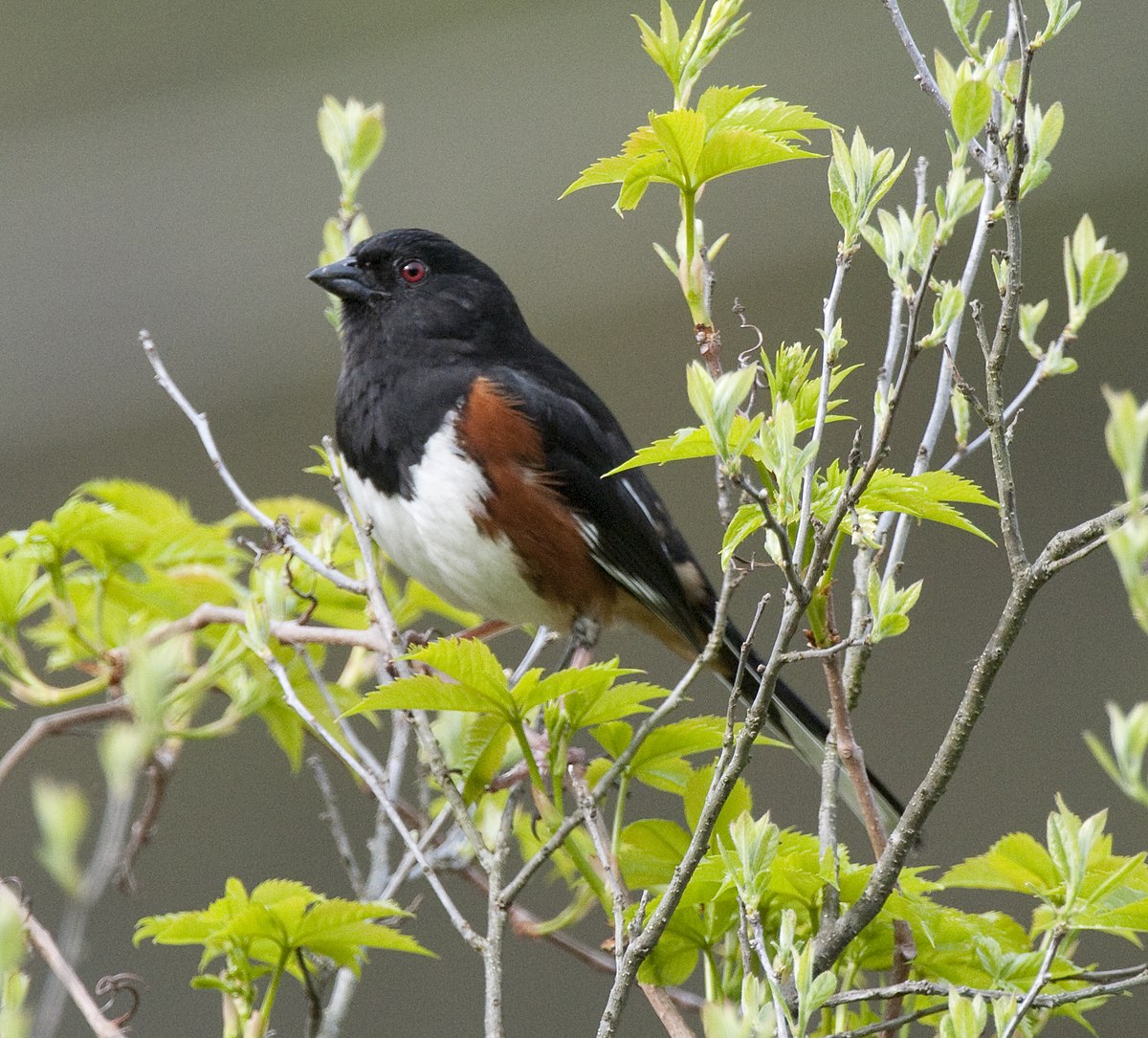
Wikipedia: Eastern towhee Source: OTHER
1200px-Pipilo_erythrophthalmus_-Quabbin_Reservoir%2C_Massachusetts%2C_USA_-male-8.jpg
![]() The eastern towhee (Pipilo erythrophthalmus) is a large New World sparrow. The taxonomy of the towhees has been under debate in recent decades, and formerly this bird and the spotted towhee were considered a single species, the rufous-sided towhee.
[more]
The eastern towhee (Pipilo erythrophthalmus) is a large New World sparrow. The taxonomy of the towhees has been under debate in recent decades, and formerly this bird and the spotted towhee were considered a single species, the rufous-sided towhee.
[more]
Song sparrow / Singammer (Melospiza melodia)
Here's a song sparrows Mark and I saw in Cromwell Valley Park. 2021-06-18 10.10.52
First observed in Cockeysville on 2021-06-13.
I had distinct memories of reading about the song sparrow in the two major books I read about bird biology in general (U. Cornell) and about birdsong by Marler and Slabbekoorn. Once I realized I heard them every morning at my mother's house and thoroughly enjoyed them - in Europe no sparrow really sings in any serious manner - I had to go back to read about all the research into song sparrows in those two books.
Song: ![]() Nature's Music: the Science of Birdsong Peter Marler and Hans Slabbekoorn, 2004. In this study it was found that young song sparrows recognize both a typical sound type, a trill, and the temporal pattern of the song, whereas swamp sparrows only listen for the trill, having no complex song. [page 82: acoustic cues for species-selective song learning]
Nature's Music: the Science of Birdsong Peter Marler and Hans Slabbekoorn, 2004. In this study it was found that young song sparrows recognize both a typical sound type, a trill, and the temporal pattern of the song, whereas swamp sparrows only listen for the trill, having no complex song. [page 82: acoustic cues for species-selective song learning]
![]() Ibid. The authors describe the singing with amusing terms, puff-sing-wave used to drive off a territorial intruder, and the aggressive 'zhee' call used throughout the year to threaten other species or other song sparrows. [page 165]
Ibid. The authors describe the singing with amusing terms, puff-sing-wave used to drive off a territorial intruder, and the aggressive 'zhee' call used throughout the year to threaten other species or other song sparrows. [page 165]
![]() Ibid. It was seen (by Hiebert et al in 1989) that song sparrows with a larger repertoire acquired a territory more quickly and survived longer. [page 48]
Ibid. It was seen (by Hiebert et al in 1989) that song sparrows with a larger repertoire acquired a territory more quickly and survived longer. [page 48]
![]() Ibid. It was seen that song sparrows matched the song repertoire of a neighbor to show that they were recognized. The authors (Beecher et al 1996) said that though not very aggressive, echoing the song of a neighbor's repertoire is more aggressive than singing a completely different song. [page 50]
Ibid. It was seen that song sparrows matched the song repertoire of a neighbor to show that they were recognized. The authors (Beecher et al 1996) said that though not very aggressive, echoing the song of a neighbor's repertoire is more aggressive than singing a completely different song. [page 50]
![]() Ibid. Another theory is that knowing all the songs of a neighbor means that it is sufficient to just responds those songs. If a bird has had to move to a more distant area or knows fewer songs himself, he may need to fight more often to prove the same point. [page 51-52]
Ibid. Another theory is that knowing all the songs of a neighbor means that it is sufficient to just responds those songs. If a bird has had to move to a more distant area or knows fewer songs himself, he may need to fight more often to prove the same point. [page 51-52]
![]() Ibid. Young birds are said to learn songs from either one adult male after hatching, therefore in the area his parents did their breeding, or after migration the following spring, in which case it learns other songs from a male there. Dialects happen because birds tend to breed and therefore to sing in the same local area where they learned their songs. [page 115-116]
Ibid. Young birds are said to learn songs from either one adult male after hatching, therefore in the area his parents did their breeding, or after migration the following spring, in which case it learns other songs from a male there. Dialects happen because birds tend to breed and therefore to sing in the same local area where they learned their songs. [page 115-116]
![]() The Cornell Lab of Ornithology Handbook of Bird Biology Edited by Irby J. Lovette and John W. Fitzpatrick, 2016. One study shows that birds under stress during song learning in early development produce poor quality songs with fewer copied notes. Females prefer songs learned with accuracy, so these poor stress-out kids are out of luck. [page 324]
The Cornell Lab of Ornithology Handbook of Bird Biology Edited by Irby J. Lovette and John W. Fitzpatrick, 2016. One study shows that birds under stress during song learning in early development produce poor quality songs with fewer copied notes. Females prefer songs learned with accuracy, so these poor stress-out kids are out of luck. [page 324]
![]() Ibid. Beecher 2008 notes that song sparrows always learn an entire song and don't link two different songs; and that they tend to learn songs sung by many different males in their new neighbohood, making the song more useful to them. [page 375]
Ibid. Beecher 2008 notes that song sparrows always learn an entire song and don't link two different songs; and that they tend to learn songs sung by many different males in their new neighbohood, making the song more useful to them. [page 375]
![]() Ibid. Stoddard et all 1991 noted that though each song sparrow has a repertoire of 10 songs, the set of neighbors will have about 50 all in all, but each can recognize the individuals. As I understood from the discussion before that, the point is that each can recognize the other's voice if they both sing the same song [page 384]
Ibid. Stoddard et all 1991 noted that though each song sparrow has a repertoire of 10 songs, the set of neighbors will have about 50 all in all, but each can recognize the individuals. As I understood from the discussion before that, the point is that each can recognize the other's voice if they both sing the same song [page 384]
![]() Ibid. Here it's mentioned that birds with more songs in their repertoire live longer - whether song sparrows in North America or great tits, which live right by our home. [page 396]
Ibid. Here it's mentioned that birds with more songs in their repertoire live longer - whether song sparrows in North America or great tits, which live right by our home. [page 396]
![]() Ibid. Some birds like white-crowned sparrows are "open ended learners", and could learn song sparrow songs but prefer those of their own species. These open ended learners continue to learn songs well into adulthood or even throughout their lives. [page 371]
Ibid. Some birds like white-crowned sparrows are "open ended learners", and could learn song sparrow songs but prefer those of their own species. These open ended learners continue to learn songs well into adulthood or even throughout their lives. [page 371]
Song:
Automatically generated from Xeno-Canto recording
Song attributes:
Frequency:
♫ Catbird plus song sparrow, 18 Cherrywood Court. 2021-06-16 20.27.47 Cherrywood (song)
Call:
Automatically generated from Xeno-Canto recording
♫ Song sparrow, Cherrywood Court. ![]() Source: Zoom H6 2022-04-29 08.29.46 Cherrywood (song?)
Source: Zoom H6 2022-04-29 08.29.46 Cherrywood (song?)
Swamp sparrow (Melospiza georgiana)
Profile Wikipedia eBird Audubon AllAboutBirds Xeno-Canto

Wikipedia: Swamp sparrow Source: OTHER
1200px-Melospiza_georgiana_MN1.jpg
General: ![]() The swamp sparrow (Melospiza georgiana) is a medium-sized New World sparrow related to the song sparrow.
[more]
The swamp sparrow (Melospiza georgiana) is a medium-sized New World sparrow related to the song sparrow.
[more]
Lincoln's sparrow / Lincoln-Ammer (Melospiza lincolnii)
Profile Wikipedia eBird Audubon AllAboutBirds Xeno-Canto

Wikipedia: Lincoln's sparrow Source: OTHER
1200px-Lincoln%27s_Sparrow_at_bird_feeder.jpg
![]() Lincoln's sparrow (Melospiza lincolnii) is a small sparrow native to North America. It is a less common passerine bird that often stays hidden under thick ground cover, but can be distinguished by its sweet, wrenlike song. Lincoln's sparrow is one of three species in the genus Melospiza which also includes the song sparrow (M. melodia) and the swamp sparrow (M. georgiana). It lives in well-covered brushy habitats, often near water. This bird is poorly documented because of its secretive nature and breeding habits solely in boreal regions.[2]
[more]
Lincoln's sparrow (Melospiza lincolnii) is a small sparrow native to North America. It is a less common passerine bird that often stays hidden under thick ground cover, but can be distinguished by its sweet, wrenlike song. Lincoln's sparrow is one of three species in the genus Melospiza which also includes the song sparrow (M. melodia) and the swamp sparrow (M. georgiana). It lives in well-covered brushy habitats, often near water. This bird is poorly documented because of its secretive nature and breeding habits solely in boreal regions.[2]
[more]
Grasshopper sparrow / Heuschreckenammer (Ammodramus savannarum)
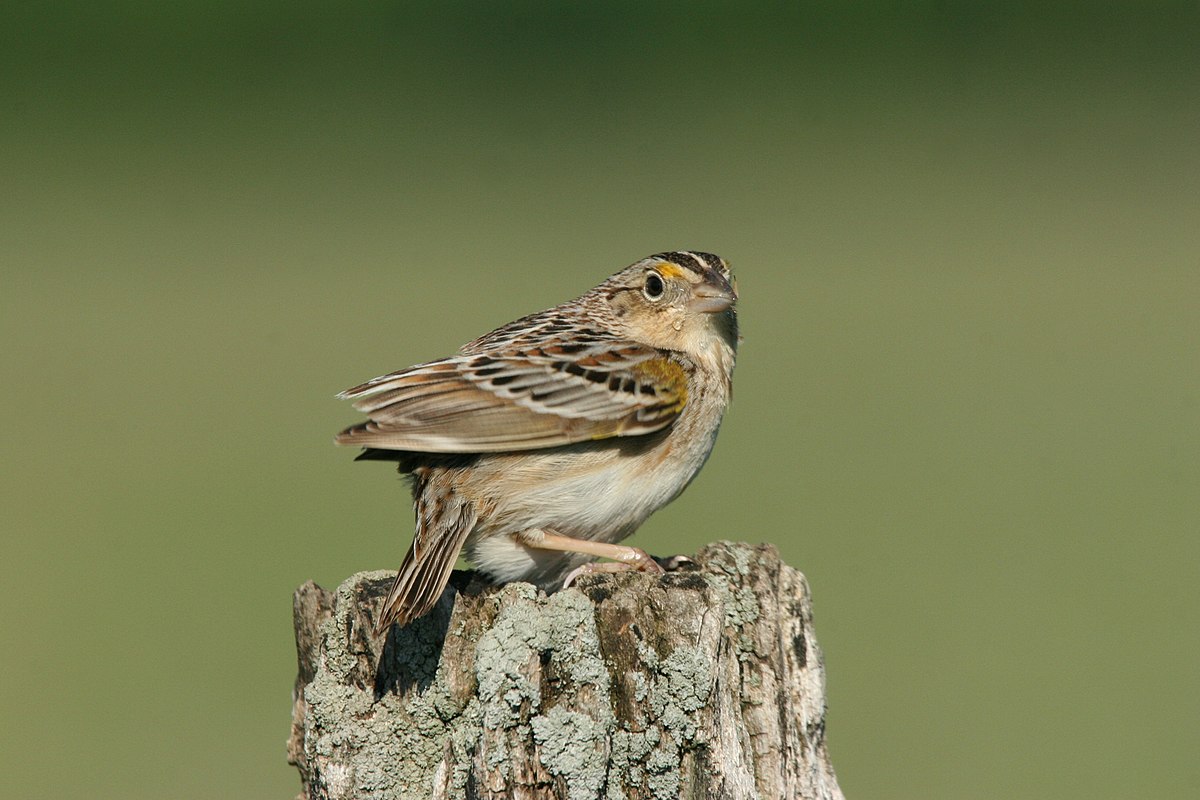
Wikipedia: Grasshopper sparrow Source: OTHER
1200px-Grasshopper_Sparrow.jpg
![]() The grasshopper sparrow (Ammodramus savannarum) is a small New World sparrow. The genus Ammodramus contains nine species that inhabit grasslands and prairies.
[more]
The grasshopper sparrow (Ammodramus savannarum) is a small New World sparrow. The genus Ammodramus contains nine species that inhabit grasslands and prairies.
[more]
Savannah sparrow (Passerculus sandwichensis)

Wikipedia: Savannah sparrow Source: OTHER
1200px-Passerculus_sandwichensis_crop.jpg
![]() The Savannah sparrow (Passerculus sandwichensis) is a small New World sparrow. It was the only member of the genus Passerculus and is typically the only widely accepted member. Comparison of mtDNA NADH dehydrogenase subunit 2 and 3 sequences indicates that the Ipswich sparrow, formerly usually considered a valid species (as Passerculus princeps), is a well-marked subspecies of the Savannah sparrow, whereas the southwestern large-billed sparrow should be recognized as a distinct species (Passerculus rostratus).[2]
[more]
The Savannah sparrow (Passerculus sandwichensis) is a small New World sparrow. It was the only member of the genus Passerculus and is typically the only widely accepted member. Comparison of mtDNA NADH dehydrogenase subunit 2 and 3 sequences indicates that the Ipswich sparrow, formerly usually considered a valid species (as Passerculus princeps), is a well-marked subspecies of the Savannah sparrow, whereas the southwestern large-billed sparrow should be recognized as a distinct species (Passerculus rostratus).[2]
[more]
Nelson's sparrow (Ammospiza nelsoni)
Profile Wikipedia eBird Audubon AllAboutBirds Xeno-Canto
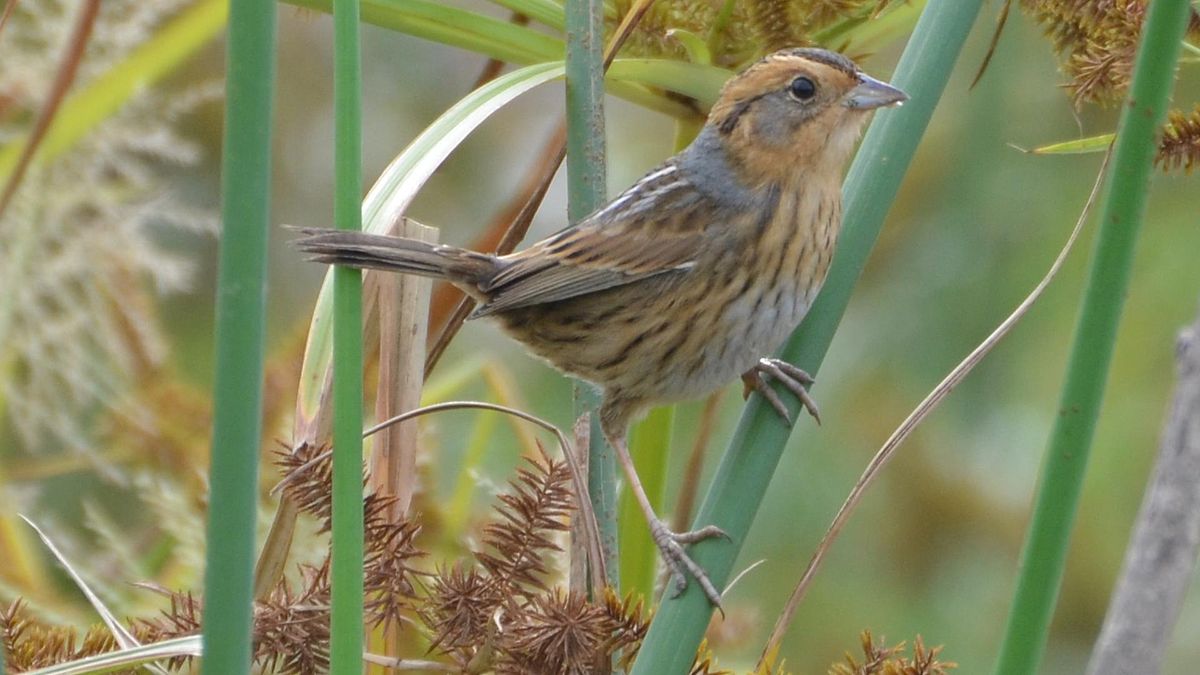
Wikipedia: Nelson's sparrow Source: OTHER
1200px-Ammodramus_nelsoni_-Riverlands_Migratory_Bird_Sanctuary%2C_Missouri%2C_USA-8_%281%29.jpg
![]() Nelson's sparrow (Ammospiza nelsoni) is a small New World sparrow. This bird was named after Edward William Nelson, an American naturalist. Formerly, this bird and the saltmarsh sparrow were considered to be a single species, the sharp-tailed sparrow; because of this it was briefly known as Nelson's sharp-tailed sparrow.
[more]
Nelson's sparrow (Ammospiza nelsoni) is a small New World sparrow. This bird was named after Edward William Nelson, an American naturalist. Formerly, this bird and the saltmarsh sparrow were considered to be a single species, the sharp-tailed sparrow; because of this it was briefly known as Nelson's sharp-tailed sparrow.
[more]
Saltmarsh sparrow (Ammospiza caudacta)
Profile Wikipedia eBird Audubon AllAboutBirds Xeno-Canto

Wikipedia: Saltmarsh sparrow Source: OTHER
Saltmarsh_sharp_tailed_sparrow.jpg
![]() The saltmarsh sparrow (Ammospiza caudacuta) is a small New World sparrow found in salt marshes along the Atlantic coast of the United States. At one time, this bird and the Nelson's sparrow were thought to be a single species, the sharp-tailed sparrow. Because of this, the species was briefly known as the "saltmarsh sharp-tailed sparrow."
[more]
The saltmarsh sparrow (Ammospiza caudacuta) is a small New World sparrow found in salt marshes along the Atlantic coast of the United States. At one time, this bird and the Nelson's sparrow were thought to be a single species, the sharp-tailed sparrow. Because of this, the species was briefly known as the "saltmarsh sharp-tailed sparrow."
[more]
Henslow's sparrow (Centronyx henslowii)

Wikipedia: Henslow's sparrow Source: OTHER
1200px-Henslows_Sparrow_%28Ammodramus_henslowii%29_%285752598436%29.jpg
![]() Henslow's sparrow (Centronyx henslowii) is a passerine bird in the family Passerellidae. It was named by John James Audubon in honor of John Stevens Henslow. It was originally classified in the genus Emberiza and called Henslow's bunting.[2]
[more]
Henslow's sparrow (Centronyx henslowii) is a passerine bird in the family Passerellidae. It was named by John James Audubon in honor of John Stevens Henslow. It was originally classified in the genus Emberiza and called Henslow's bunting.[2]
[more]
Profile Wikipedia eBird Vogelwarte BirdLife ZH ornitho.ch Audubon AllAboutBirds Xeno-Canto NABU
Lesser black-backed gull - yellow legs, yellow break with red under tip, black back but white shoulders. 2023-09-27 12.40.12 Florida
This bird appears across the great seas in the following continents:
Europe, North America, Africa.
![]() The lesser black-backed gull (Larus fuscus) is a large gull that breeds on the Atlantic coasts of Europe. It is migratory, wintering from the British Isles south to West Africa. It is a regular winter visitor to the east coast of North America, probably from the breeding population in Iceland.
[more]
The lesser black-backed gull (Larus fuscus) is a large gull that breeds on the Atlantic coasts of Europe. It is migratory, wintering from the British Isles south to West Africa. It is a regular winter visitor to the east coast of North America, probably from the breeding population in Iceland.
[more]
Habitats:
River and lake
Herring gulls at Squam Lake, New Hampshire. 2023-10-06 12.47.32 New England
This bird appears across the great seas in the following continents:
Europe, North America, South America.
Deutschland: Brut-, Jahres-, Zugvogel, Wintergast
Vocalization: ![]() Quite vocal. A long and strong "ay-kay-kay-kay-kay" with fading strength commonly heard. A deep "ga-ga-ga" heard from anxious birds. [Link]
Quite vocal. A long and strong "ay-kay-kay-kay-kay" with fading strength commonly heard. A deep "ga-ga-ga" heard from anxious birds. [Link]
Calls: ![]() All calls much deeper pitched than Common Gull. Difficult to distinguish from Lesser Black-backed Gull, but tone is less nasal. [Link]
All calls much deeper pitched than Common Gull. Difficult to distinguish from Lesser Black-backed Gull, but tone is less nasal. [Link]
Physical details: length=55-64 cm,
wingspan=123-148 cm,
weight=750-1440 g
Habitats:
River and lake
Profile Wikipedia eBird Vogelwarte BirdLife ZH ornitho.ch Audubon AllAboutBirds Xeno-Canto NABU
Great black-backed gull (Mantelmöwe), Islay near Bridgend. 2023-08-11 09.31.48 Islay
First observed in Islay on 2023-08-11.
This bird appears across the great seas in the following continents:
Europe, North America.
Deutschland: Brut-, Jahres-, Zugvogel, Wintergast RL R
Habitats:
River and lake

Wikipedia: Ring-billed gull Source: OTHER
1200px-Ring-billed_gull_in_Red_Hook_%2842799%29.jpg
General: ![]() The ring-billed gull (Larus delawarensis) is a medium-sized gull. The genus name is from Latin Larus which appears to have referred to a gull or other large seabird. The specific delawarensis refers to the Delaware River.[2]
[more]
The ring-billed gull (Larus delawarensis) is a medium-sized gull. The genus name is from Latin Larus which appears to have referred to a gull or other large seabird. The specific delawarensis refers to the Delaware River.[2]
[more]
Profile Wikipedia eBird Audubon AllAboutBirds Xeno-Canto BirdID NABU
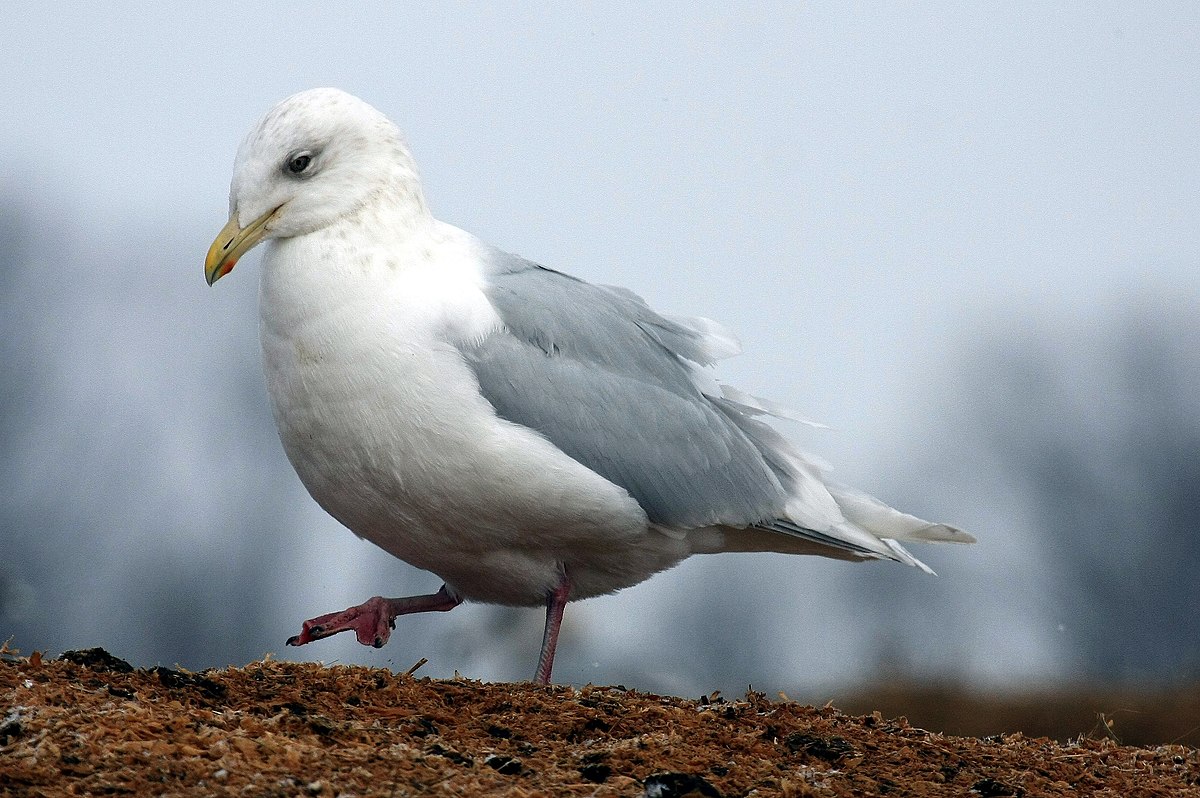
Wikipedia: Iceland gull Source: OTHER
1200px-Larus_glaucoides_IthacaNY.jpg
This bird appears across the great seas in the following continents:
Europe, North America.
![]() The Iceland gull (Larus glaucoides) is a medium-sized gull that breeds in the Arctic regions of Canada and Greenland, but not in Iceland (as its name suggests), where it is only seen during winter. The genus name is from Latin larus, which appears to have referred to a gull or other large seabird. The specific name glaucoides denotes its resemblance to Larus glaucus, a synonym of Larus hyperboreus, the glaucous gull; -oides is Ancient Greek and means "resembling".[2]
[more]
The Iceland gull (Larus glaucoides) is a medium-sized gull that breeds in the Arctic regions of Canada and Greenland, but not in Iceland (as its name suggests), where it is only seen during winter. The genus name is from Latin larus, which appears to have referred to a gull or other large seabird. The specific name glaucoides denotes its resemblance to Larus glaucus, a synonym of Larus hyperboreus, the glaucous gull; -oides is Ancient Greek and means "resembling".[2]
[more]
Vocalization: ![]() Like Herring Gull, but tone sharper. [Link]
Like Herring Gull, but tone sharper. [Link]
Physical details: length=52-60 cm,
wingspan=140-150 cm,
weight=460-1039 g
Profile Wikipedia eBird Audubon AllAboutBirds Xeno-Canto BirdID NABU
MerlinBirdID says glaucous gull and American black duck females. 2023-10-12 13.39.32 New England
First observed in New England on 2023-10-12.
This bird appears across the great seas in the following continents:
Europe, North America.
General: ![]() The glaucous gull (Larus hyperboreus) is a large gull, the second-largest gull in the world. It breeds in Arctic regions of the Northern Hemisphere and winters south to shores of the Holarctic. The genus name is from Latin larus, which appears to have referred to a gull or other large seabird. The specific name hyperboreus is Latin for "northern" from the Ancient Greek Huperboreoi people from the far north [2] "Glaucous" is from Latin glaucus and denotes the grey colour of the gull.[3]
[more]
The glaucous gull (Larus hyperboreus) is a large gull, the second-largest gull in the world. It breeds in Arctic regions of the Northern Hemisphere and winters south to shores of the Holarctic. The genus name is from Latin larus, which appears to have referred to a gull or other large seabird. The specific name hyperboreus is Latin for "northern" from the Ancient Greek Huperboreoi people from the far north [2] "Glaucous" is from Latin glaucus and denotes the grey colour of the gull.[3]
[more]
Vocalization: ![]() Like Herring Gull. [Link]
Like Herring Gull. [Link]
Physical details: length=62-68 cm,
wingspan=150-165 cm,
weight=964-2215 g
Gull-billed tern / Lachseeschwalbe (Gelochelidon nilotica)
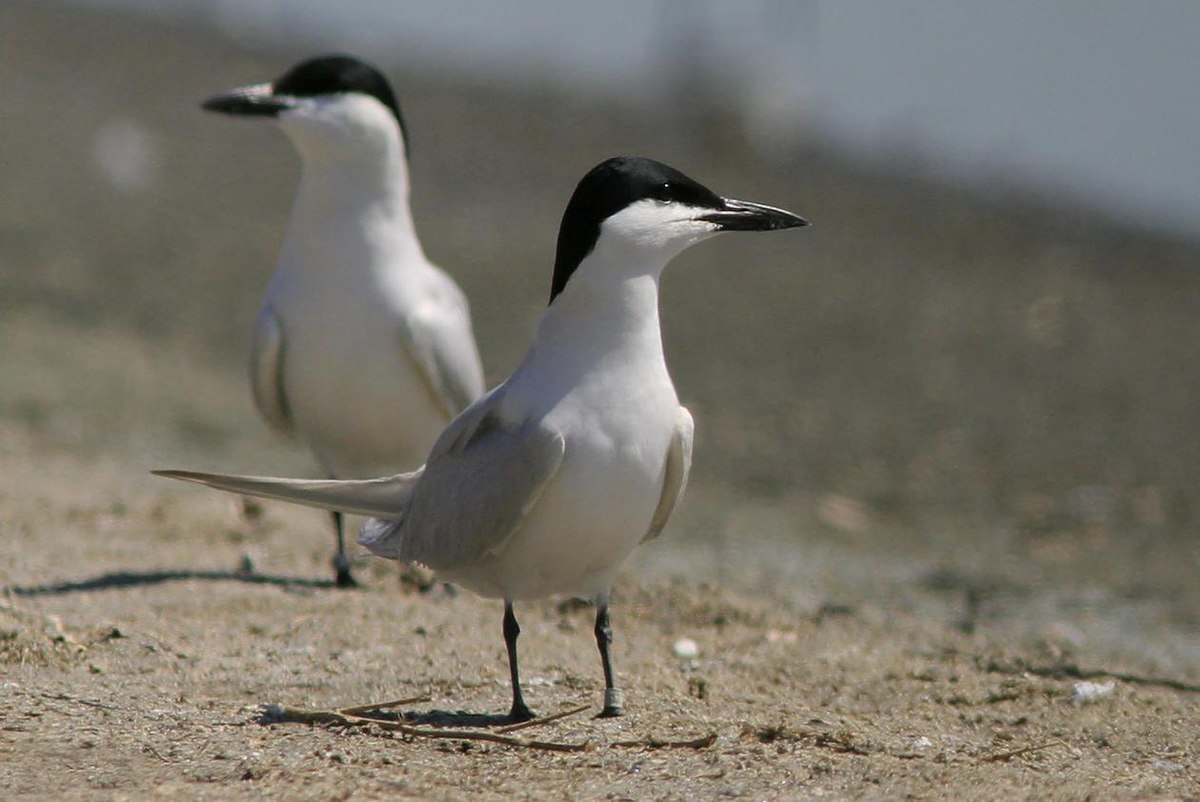
Wikipedia: Gull-billed tern Source: OTHER
1200px-Gelochelidon_nilotica_vanrossemi.jpg
This bird appears across the great seas in the following continents:
Europe, North America, South America, Africa, Asia.
General: ![]() The gull-billed tern (Gelochelidon nilotica), formerly Sterna nilotica,[2] is a tern in the family Laridae. The genus name is from Ancient Greek gelao, "to laugh", and khelidon, "swallow". The specific niloticus is from Latin and means of the Nile.[3] The Australian gull-billed tern was previously considered a subspecies.
[more]
The gull-billed tern (Gelochelidon nilotica), formerly Sterna nilotica,[2] is a tern in the family Laridae. The genus name is from Ancient Greek gelao, "to laugh", and khelidon, "swallow". The specific niloticus is from Latin and means of the Nile.[3] The Australian gull-billed tern was previously considered a subspecies.
[more]
Sabine's gull / Schwalbenmöwe (Xema sabini)

Wikipedia: Sabine's gull Source: OTHER
Xema_sabini_-Iceland_-swimming-8_%281%29.jpg
This bird appears across the great seas in the following continents:
Europe, North America, South America, Africa.
![]() Sabine's gull (/ˈseɪbɪn/ SAY-bin; Xema sabini), also known as the fork-tailed gull or xeme, is a small gull. Its generic placement is disputed; some authors treat it as the sole species in the genus Xema as Xema sabini,[2] while others retain it in the genus Larus as Larus sabini.[3][4]
[more]
Sabine's gull (/ˈseɪbɪn/ SAY-bin; Xema sabini), also known as the fork-tailed gull or xeme, is a small gull. Its generic placement is disputed; some authors treat it as the sole species in the genus Xema as Xema sabini,[2] while others retain it in the genus Larus as Larus sabini.[3][4]
[more]
Black tern / Trauerseeschwalbe (Chlidonias niger)
Profile Wikipedia eBird Vogelwarte BirdLife ZH ornitho.ch Audubon AllAboutBirds Xeno-Canto BirdID NABU

Wikipedia: Black tern Source: OTHER
1200px-%C4%8Cor%C3%ADk_%C4%8Dierny_%28Chlidonias_niger%29_a_%284644831482%29.jpg
This bird appears across the great seas in the following continents:
Europe, North America, South America, Africa.
![]() The black tern (Chlidonias niger) is a small tern generally found in or near inland water in Europe, Western Asia and North America. As its name suggests, it has predominantly dark plumage. In some lights it can appear blue in the breeding season, hence the old English name "blue darr".[2] The genus name is from Ancient Greek khelidonios, "swallow-like", from khelidon, "swallow": another old English name for the black tern is "carr (i.e. lake) swallow".[3] The species name is from Latin niger "shining black".[4]
[more]
The black tern (Chlidonias niger) is a small tern generally found in or near inland water in Europe, Western Asia and North America. As its name suggests, it has predominantly dark plumage. In some lights it can appear blue in the breeding season, hence the old English name "blue darr".[2] The genus name is from Ancient Greek khelidonios, "swallow-like", from khelidon, "swallow": another old English name for the black tern is "carr (i.e. lake) swallow".[3] The species name is from Latin niger "shining black".[4]
[more]
Vocalization: ![]() Moderately vocal. [Link]
Moderately vocal. [Link]
Calls: ![]() Flight call a more or less clear "kleck, or a disyllabic "klee-ake" with accented first syllable. Sometimes slightly rolling "klirr-eke", but never as much as in White-winged Tern. Also a slightly harsher "kreek", but not as raspy as in Whiskered Tern. [Link]
Flight call a more or less clear "kleck, or a disyllabic "klee-ake" with accented first syllable. Sometimes slightly rolling "klirr-eke", but never as much as in White-winged Tern. Also a slightly harsher "kreek", but not as raspy as in Whiskered Tern. [Link]
Physical details: length=22-24 cm,
wingspan=64-68 cm,
weight=60-86 g
Habitats:
River and lake
Brown noddy / Noddi (Anous stolidus)

Wikipedia: Brown noddy Source: OTHER
1200px-Common_Noddy_1_-_Michaelmas.jpg
This bird appears across the great seas in the following continents:
North America, South America, Africa, Asia.
General: ![]() The brown noddy or common noddy (Anous stolidus) is a seabird in the family Laridae. The largest of the noddies, it can be told from the closely related black noddy by its larger size and plumage, which is dark brown rather than black. The brown noddy is a tropical seabird with a worldwide distribution, ranging from Hawaii to the Tuamotu Archipelago and Australia in the Pacific Ocean, from the Red Sea to the Seychelles and Australia in the Indian Ocean and in the Caribbean to Tristan da Cunha in the Atlantic Ocean. The brown noddy is colonial, usually nesting on elevated situations on cliffs or in short trees or shrubs. It only occasionally nests on the ground. A single egg is laid by the female of a pair each breeding season. In India the brown noddy is protected in the PM Sayeed Marine Birds Conservation Reserve.[2]
[more]
The brown noddy or common noddy (Anous stolidus) is a seabird in the family Laridae. The largest of the noddies, it can be told from the closely related black noddy by its larger size and plumage, which is dark brown rather than black. The brown noddy is a tropical seabird with a worldwide distribution, ranging from Hawaii to the Tuamotu Archipelago and Australia in the Pacific Ocean, from the Red Sea to the Seychelles and Australia in the Indian Ocean and in the Caribbean to Tristan da Cunha in the Atlantic Ocean. The brown noddy is colonial, usually nesting on elevated situations on cliffs or in short trees or shrubs. It only occasionally nests on the ground. A single egg is laid by the female of a pair each breeding season. In India the brown noddy is protected in the PM Sayeed Marine Birds Conservation Reserve.[2]
[more]
Black noddy / Weißkappennoddi (Anous minutus)
Profile Wikipedia eBird Audubon AllAboutBirds Xeno-Canto

Wikipedia: Black noddy Source: OTHER
1200px-Anous_minutus_by_Gregg_Yan_02.jpg
This bird appears across the great seas in the following continents:
North America, South America, Africa, Australia.
![]() The black noddy or white-capped noddy (Anous minutus) is a seabird from the family Laridae. It is a medium-sized species of tern with black plumage and a white cap. It closely resembles the lesser noddy (Anous tenuirostris) with which it was at one time considered conspecific. The black noddy has slightly darker plumage and dark rather than pale lores.
[more]
The black noddy or white-capped noddy (Anous minutus) is a seabird from the family Laridae. It is a medium-sized species of tern with black plumage and a white cap. It closely resembles the lesser noddy (Anous tenuirostris) with which it was at one time considered conspecific. The black noddy has slightly darker plumage and dark rather than pale lores.
[more]
Franklin's gull / Präriemöwe (Leucophaeus pipixcan)

Wikipedia: Franklin's gull Source: OTHER
Franklin%27s_Gull%2C_Calgary.jpg
This bird appears across the great seas in the following continents:
North America, South America, Africa.
![]() Franklin's gull (Leucophaeus pipixcan) is a small (length 12.6–14.2 in, 32–36 cm) gull.[2] The genus name Leucophaeus is from Ancient Greek leukos, "white", and phaios, "dusky". The specific pipixcan is a Nahuatl name for a type of gull.[3][4]
[more]
Franklin's gull (Leucophaeus pipixcan) is a small (length 12.6–14.2 in, 32–36 cm) gull.[2] The genus name Leucophaeus is from Ancient Greek leukos, "white", and phaios, "dusky". The specific pipixcan is a Nahuatl name for a type of gull.[3][4]
[more]
Laughing gull / Aztekenmöwe (Leucophaeus atricilla)
Our gang - laughing gull, double-crested cormorants, brown pelicans - at Las Coloradas, Rio Lagartos. 2023-04-15 09.11.04 Yucatan
First observed in Yucatan on 2023-03-26.
This bird appears across the great seas in the following continents:
North America, South America, Australia.
vagrant
Caspian tern / Raubseeschwalbe (Hydroprogne caspia)

Wikipedia: Caspian tern Source: OTHER
1200px-Sterna-caspia-010.jpg
This bird appears across the great seas in the following continents:
Europe, North America, South America, Africa, Asia.
General: ![]() The Caspian tern (Hydroprogne caspia)[2] is a species of tern, with a subcosmopolitan but scattered distribution. Despite its extensive range, it is monotypic of its genus, and has no accepted subspecies.[3] The genus name is from Ancient Greek hudros, "water", and Latin progne, "swallow". The specific caspia is from Latin and, like the English name, refers to the Caspian Sea.[4]
[more]
The Caspian tern (Hydroprogne caspia)[2] is a species of tern, with a subcosmopolitan but scattered distribution. Despite its extensive range, it is monotypic of its genus, and has no accepted subspecies.[3] The genus name is from Ancient Greek hudros, "water", and Latin progne, "swallow". The specific caspia is from Latin and, like the English name, refers to the Caspian Sea.[4]
[more]
Calls: ![]() Easily recognized by its very harsh calls. Sometimes likened to the sound of a plate of steel being dragged across a concrete floor. Similar in harshness to Grey Heron, but more drawn, with an accented middle; "Kraaeeet", or with a double syllable start "ka-ha-kraaaeet". Immature birds begs with a penetrating, sharp whistle. [Link]
Easily recognized by its very harsh calls. Sometimes likened to the sound of a plate of steel being dragged across a concrete floor. Similar in harshness to Grey Heron, but more drawn, with an accented middle; "Kraaeeet", or with a double syllable start "ka-ha-kraaaeet". Immature birds begs with a penetrating, sharp whistle. [Link]
Physical details: length=47-54 cm,
wingspan=130-145 cm,
weight=500-750 g
Habitats:
River and lake
Bridled tern / Zügelseeschwalbe (Onychoprion anaethetus)
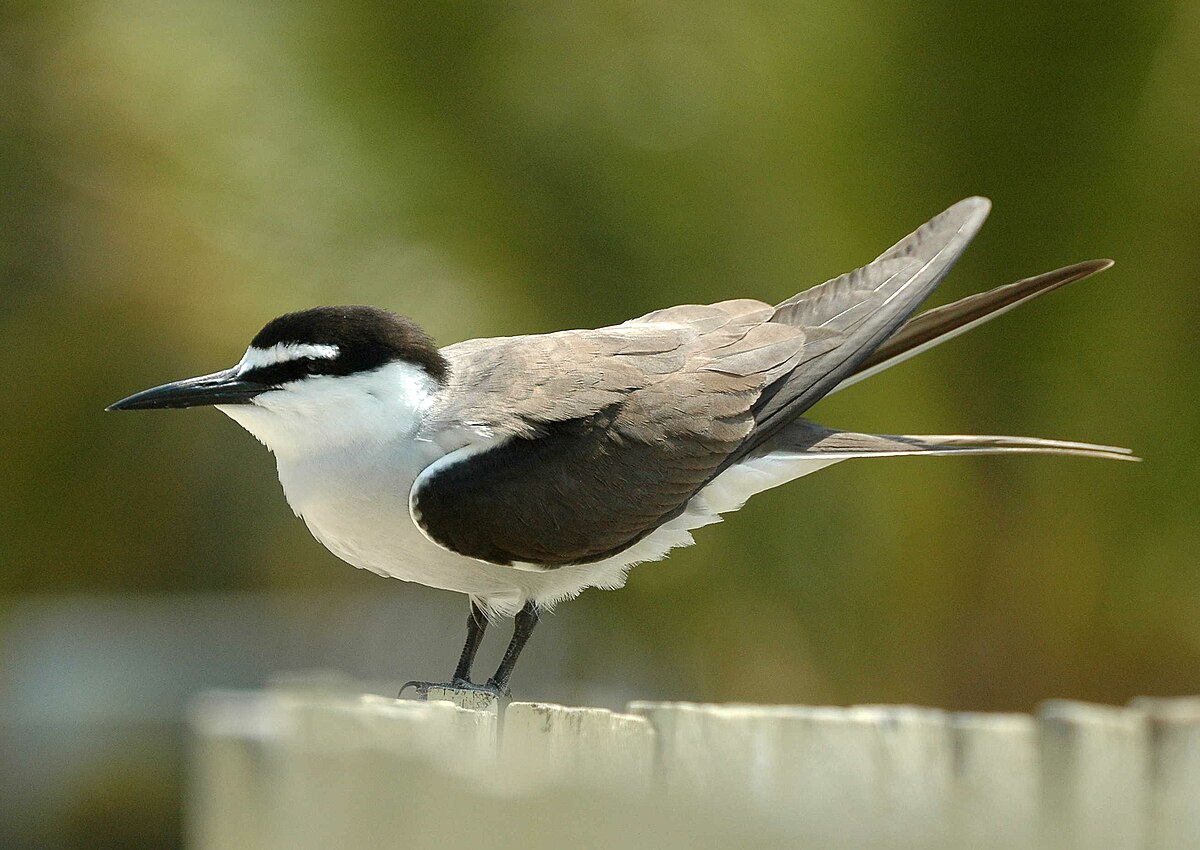
Wikipedia: Bridled tern Source: OTHER
1200px-Bridled_Tern_LEI_Nov06.JPG
This bird appears across the great seas in the following continents:
North America, South America, Africa, Asia.
General: ![]() The bridled tern (Onychoprion anaethetus)[2] is a seabird of the family Laridae. It is a bird of the tropical oceans. The scientific name is from Ancient Greek. The genus comes from onux meaning "claw" or "nail", and prion, meaning "saw". The specific anaethetus means "senseless, stupid".[3]
[more]
The bridled tern (Onychoprion anaethetus)[2] is a seabird of the family Laridae. It is a bird of the tropical oceans. The scientific name is from Ancient Greek. The genus comes from onux meaning "claw" or "nail", and prion, meaning "saw". The specific anaethetus means "senseless, stupid".[3]
[more]
Sooty tern (alternate) / Onychoprion fuscata (alternate) (Onychoprion fuscata)
This bird appears across the great seas in the following continents:
North America, Africa.
Least tern / Amerikanische Zwergseeschwalbe (Sternula antillarum)

Wikipedia: Least tern Source: OTHER
1200px-Least_Tern_%28Sternula_antillarum%29_RWD1.jpg
![]() The least tern (Sternula antillarum) is a species of tern that breeds in North America and locally in northern South America. It is closely related to, and was formerly often considered conspecific with, the little tern of the Old World. Other close relatives include the yellow-billed tern and Peruvian tern, both from South America.
[more]
The least tern (Sternula antillarum) is a species of tern that breeds in North America and locally in northern South America. It is closely related to, and was formerly often considered conspecific with, the little tern of the Old World. Other close relatives include the yellow-billed tern and Peruvian tern, both from South America.
[more]
Sandwich tern / Brandseeschwalbe (Thalasseus sandvicensis)
Sandwich tern in flight with distinct yellow tipped bill. 2023-09-27 12.28.34 Florida
First observed in Costa Rica on 2018-03-11.
This bird appears across the great seas in the following continents:
Europe, North America, South America, Africa.
![]() The Sandwich tern (Thalasseus sandvicensis)[2] is a tern in the family Laridae. It is very closely related to the lesser crested tern (T. bengalensis), Chinese crested tern (T. bernsteini), Cabot's tern (T. acuflavidus), and elegant tern (T. elegans) and has been known to interbreed with the lesser crested. It breeds in the Palearctic from Europe to the Caspian Sea wintering to South Africa, India and Sri Lanka.
[more]
The Sandwich tern (Thalasseus sandvicensis)[2] is a tern in the family Laridae. It is very closely related to the lesser crested tern (T. bengalensis), Chinese crested tern (T. bernsteini), Cabot's tern (T. acuflavidus), and elegant tern (T. elegans) and has been known to interbreed with the lesser crested. It breeds in the Palearctic from Europe to the Caspian Sea wintering to South Africa, India and Sri Lanka.
[more]
Calls: ![]() Contact call a sharp and grating "keeree-eek". Often compared to the pressing of amalgam into a tooth. [Link]
Contact call a sharp and grating "keeree-eek". Often compared to the pressing of amalgam into a tooth. [Link]
Physical details: length=36-41 cm,
wingspan=95-105 cm,
weight=215-275 g
Habitats:
River and lake
Royal tern (alternate) (Thalasseus maxima)
Hail, hail, the gang's all here at Madeira Beach - orange-beaked royal tern, black and yellow-beaked sandwich terns, a willet and two sanderlings. 2023-09-27 12.37.26 Florida
First observed in Yucatan on 2023-04-15.
Semipalmated plover / Amerika-Sandregenpfeifer (Charadrius semipalmatus)
Profile Wikipedia eBird Audubon AllAboutBirds Xeno-Canto NABU

Wikipedia: Semipalmated plover Source: OTHER
Semipalmated_Plover.jpg
This bird appears across the great seas in the following continents:
Europe, North America, South America, Australia.
vagrant
Piping plover (Charadrius melodus)
Profile Wikipedia eBird Audubon AllAboutBirds Xeno-Canto

Wikipedia: Piping plover Source: OTHER
1200px-Charadrius-melodus-004_edit.jpg
General: ![]() The piping plover (Charadrius melodus) is a small sand-colored, sparrow-sized shorebird that nests and feeds along coastal sand and gravel beaches in North America. The adult has yellow-orange-red legs, a black band across the forehead from eye to eye, and a black stripe running along the breast line. This chest band is usually thicker in males during the breeding season, and it is the only reliable way to tell the sexes apart. The bird is difficult to see when it is standing still, as it blends well with open, sandy beach habitats. It typically runs in short spurts and stops.
[more]
The piping plover (Charadrius melodus) is a small sand-colored, sparrow-sized shorebird that nests and feeds along coastal sand and gravel beaches in North America. The adult has yellow-orange-red legs, a black band across the forehead from eye to eye, and a black stripe running along the breast line. This chest band is usually thicker in males during the breeding season, and it is the only reliable way to tell the sexes apart. The bird is difficult to see when it is standing still, as it blends well with open, sandy beach habitats. It typically runs in short spurts and stops.
[more]
Snowy plover (Charadrius nivosus)
Profile Wikipedia eBird Audubon AllAboutBirds Xeno-Canto

Wikipedia: Snowy plover Source: OTHER
1200px-Snowy_Plover_srgb.jpg
![]() The snowy plover (Charadrius nivosus) is a small wader in the plover bird family, typically about 5-7" in length.[2] It breeds in Ecuador, Peru, Chile, the southern and western United States and the Caribbean. Long considered to be a subspecies of the Kentish plover, it is now known to be a distinct species.
[more]
The snowy plover (Charadrius nivosus) is a small wader in the plover bird family, typically about 5-7" in length.[2] It breeds in Ecuador, Peru, Chile, the southern and western United States and the Caribbean. Long considered to be a subspecies of the Kentish plover, it is now known to be a distinct species.
[more]
Killdeer / Keilschwanz-Regenpfeifer (Charadrius vociferus)

Wikipedia: Killdeer Source: OTHER
Killdeer.jpg
![]() The killdeer (Charadrius vociferus) is a large plover found in the Americas. It was described and given its current scientific name in 1758 by Carl Linnaeus in the 10th edition of his Systema Naturae. There are three subspecies. The killdeer's common name comes from its often-heard call. Its upperparts are mostly brown with rufous fringes, the head has patches of white and black, and there are two black breast bands. The belly and the rest of the breast are white. The nominate (or originally described) subspecies breeds from southeastern Alaska and southern Canada to Mexico. It is seen year-round in the southern half of its breeding range; the subspecies C. v. ternominatus is probably resident in the West Indies and C. v. peruvianus inhabits Peru and areas of the surrounding countries throughout the year. North American breeders winter from their resident range south to Central America, the West Indies, and the northernmost portions of South America.
[more]
The killdeer (Charadrius vociferus) is a large plover found in the Americas. It was described and given its current scientific name in 1758 by Carl Linnaeus in the 10th edition of his Systema Naturae. There are three subspecies. The killdeer's common name comes from its often-heard call. Its upperparts are mostly brown with rufous fringes, the head has patches of white and black, and there are two black breast bands. The belly and the rest of the breast are white. The nominate (or originally described) subspecies breeds from southeastern Alaska and southern Canada to Mexico. It is seen year-round in the southern half of its breeding range; the subspecies C. v. ternominatus is probably resident in the West Indies and C. v. peruvianus inhabits Peru and areas of the surrounding countries throughout the year. North American breeders winter from their resident range south to Central America, the West Indies, and the northernmost portions of South America.
[more]
Wilson's plover (Charadrius wilsonia)
Profile Wikipedia eBird Audubon AllAboutBirds Xeno-Canto

Wikipedia: Wilson's plover Source: OTHER
1200px-Wilson%27s_Plover_male_RWD2.jpg
![]() Wilson's plover (Charadrius wilsonia) is a small bird of the family Charadriidae.
[more]
Wilson's plover (Charadrius wilsonia) is a small bird of the family Charadriidae.
[more]
Black-bellied plover / Kiebitzregenpfeifer (Pluvialis squatarola)
Black-bellied plover eggs. 2016-09-25 16.51.00 Botswana
First observed in Botswana on 2016-09-25.
This bird appears across the great seas in the following continents:
Europe, North America, South America, Africa, Asia.
![]() The grey plover or black-bellied plover (Pluvialis squatarola) is a medium-sized plover breeding in Arctic regions. It is a long-distance migrant, with a nearly worldwide coastal distribution when not breeding.[2] The genus name is Latin and means relating to rain, from pluvia, "rain". It was believed that golden plovers flocked when rain was imminent. The species name squatarola is a Latinised version of Sgatarola, a Venetian name for some kind of plover.[3]
[more]
The grey plover or black-bellied plover (Pluvialis squatarola) is a medium-sized plover breeding in Arctic regions. It is a long-distance migrant, with a nearly worldwide coastal distribution when not breeding.[2] The genus name is Latin and means relating to rain, from pluvia, "rain". It was believed that golden plovers flocked when rain was imminent. The species name squatarola is a Latinised version of Sgatarola, a Venetian name for some kind of plover.[3]
[more]
Calls: ![]() Contact call diagnostic. A plaintive, drawn and trisyllabic (but continuous) "kleeooowee". Pitch falls on second syllable and rises on last. [Link]
Contact call diagnostic. A plaintive, drawn and trisyllabic (but continuous) "kleeooowee". Pitch falls on second syllable and rises on last. [Link]
Physical details: length=27-30 cm,
wingspan=71-83 cm,
weight=190-280 g
Habitats:
Wetland
Ruff / Kampfläufer (Calidris pugnax)

Wikipedia: Ruff Source: OTHER
1200px-Philomachus_pugnax_-Diergaarde_Blijdorp-8c.jpg
This bird appears across the great seas in the following continents:
Europe, North America, South America, Africa, Asia.
Etymology: Nabu: Der Name leitet sich vom Balzverhalten der Männchen ab: In Balzarenen tragen sie „Turniere“ aus, um die Weibchen zu beeindrucken, dabei herrscht eine komplizierte Rollenverteilung. [Link]
Vocalization: ![]() Generally silent. Short, muted, nasal, mono or disyllabic grunts sometimes heard. [Link]
Generally silent. Short, muted, nasal, mono or disyllabic grunts sometimes heard. [Link]
Physical details: length=26-30 cm,
wingspan=54-58 cm,
weight=75-230 g
Habitats:
Wetland
White-rumped sandpiper / Weißbürzelstrandläufer (Calidris fuscicollis)
Profile Wikipedia eBird Audubon AllAboutBirds Xeno-Canto

Wikipedia: White-rumped sandpiper Source: OTHER
1200px-Calidris_fuscicollis_PLAYERO_RABADILLA_BLANCA.jpg
This bird appears across the great seas in the following continents:
North America, South America, Africa.
General: ![]() The white-rumped sandpiper (Calidris fuscicollis) is a small shorebird that breeds in the northern tundra of Canada and Alaska. This bird can be difficult to distinguish from other similar tiny shorebirds; these are known collectively as "peeps" or "stints".
[more]
The white-rumped sandpiper (Calidris fuscicollis) is a small shorebird that breeds in the northern tundra of Canada and Alaska. This bird can be difficult to distinguish from other similar tiny shorebirds; these are known collectively as "peeps" or "stints".
[more]
Red knot / Knutt (Calidris canutus)
Profile Wikipedia eBird Vogelwarte BirdLife ZH ornitho.ch Audubon AllAboutBirds Xeno-Canto BirdID NABU
Red knots, according to MerlinBirdID - underway to somewhere better at Las Coloradas. 2023-04-15 09.34.08 Yucatan
First observed in Yucatan on 2023-04-15.
This bird appears across the great seas in the following continents:
Europe, North America, South America, Africa, Asia.
![]() The red knot (Calidris canutus) (just knot in English-speaking Europe) is a medium-sized shorebird which breeds in tundra and the Arctic Cordillera in the far north of Canada, Europe, and Russia. It is a large member of the Calidris sandpipers, second only to the great knot.[2] Six subspecies are recognised.
[more]
The red knot (Calidris canutus) (just knot in English-speaking Europe) is a medium-sized shorebird which breeds in tundra and the Arctic Cordillera in the far north of Canada, Europe, and Russia. It is a large member of the Calidris sandpipers, second only to the great knot.[2] Six subspecies are recognised.
[more]
Song: ![]() Song an undulating, nasal mewing "poooor-mee", or "po-hor-mee". [Link]
Song an undulating, nasal mewing "poooor-mee", or "po-hor-mee". [Link]
Calls: ![]() Most commonly heard migratory call, a short "kut" or "knot". Sometimes given in stuttering series. [Link]
Most commonly heard migratory call, a short "kut" or "knot". Sometimes given in stuttering series. [Link]
Physical details: length=23-25 cm,
wingspan=57-61 cm,
weight=110-160 g
Habitats:
Wetland
Baird's sandpiper / Bairdstrandläufer (Calidris bairdii)
Profile Wikipedia eBird Audubon AllAboutBirds Xeno-Canto

Wikipedia: Baird's sandpiper Source: OTHER
Calidris_bairdii_-Gullbringusysla%2C_Iceland-8.jpg
This bird appears across the great seas in the following continents:
North America, South America, Africa.
General: ![]() Baird's sandpiper (Calidris bairdii) is a small shorebird. It is among those calidrids which were formerly included in the genus Erolia, which was subsumed into the genus Calidris in 1973.[2] The genus name is from Ancient Greek kalidris or skalidris, a term used by Aristotle for some grey-coloured waterside birds. The English name and specific bairdii commemorate Spencer Fullerton Baird, 19th-century naturalist and assistant secretary of the Smithsonian Institution.[3]
[more]
Baird's sandpiper (Calidris bairdii) is a small shorebird. It is among those calidrids which were formerly included in the genus Erolia, which was subsumed into the genus Calidris in 1973.[2] The genus name is from Ancient Greek kalidris or skalidris, a term used by Aristotle for some grey-coloured waterside birds. The English name and specific bairdii commemorate Spencer Fullerton Baird, 19th-century naturalist and assistant secretary of the Smithsonian Institution.[3]
[more]
Buff-breasted sandpiper / Grasläufer (Calidris subruficollis)

Wikipedia: Buff-breasted sandpiper Source: OTHER
1200px-Tryngites_subruficollis_-USA-8.jpg
This bird appears across the great seas in the following continents:
North America, South America, Africa.
![]() The buff-breasted sandpiper (Calidris subruficollis) is a small shorebird. The species name subruficollis is from Latin subrufus, "reddish" (from sub, "somewhat", and rufus, "rufous") and collis, "-necked/-throated" (from collum, "neck").[2] It is a calidrid sandpiper.
[more]
The buff-breasted sandpiper (Calidris subruficollis) is a small shorebird. The species name subruficollis is from Latin subrufus, "reddish" (from sub, "somewhat", and rufus, "rufous") and collis, "-necked/-throated" (from collum, "neck").[2] It is a calidrid sandpiper.
[more]
Sanderling / Sanderling (Calidris alba)
Profile Wikipedia eBird Vogelwarte BirdLife ZH ornitho.ch Audubon AllAboutBirds Xeno-Canto BirdID NABU
Sanderling. 2023-09-27 12.12.20 Florida
First observed in Yucatan on 2023-03-27.
This bird appears across the great seas in the following continents:
Europe, North America, South America, Africa, Asia.
![]() The sanderling (Calidris alba) is a small wading bird. The name derives from Old English sand-yrðling, "sand-ploughman".[2] The genus name is from Ancient Greek kalidris or skalidris, a term used by Aristotle for some grey-coloured waterside birds. The specific alba is Latin for "white".[3]
[more]
The sanderling (Calidris alba) is a small wading bird. The name derives from Old English sand-yrðling, "sand-ploughman".[2] The genus name is from Ancient Greek kalidris or skalidris, a term used by Aristotle for some grey-coloured waterside birds. The specific alba is Latin for "white".[3]
[more]
Calls: ![]() Call not very diagnostic; a short and soft "pleet" or "keek". [Link]
Call not very diagnostic; a short and soft "pleet" or "keek". [Link]
Physical details: length=20-21 cm,
wingspan=40-45 cm,
weight=44-70 g
Habitats:
Wetland
Dunlin / Alpenstrandläufer (Calidris alpina)
Profile Wikipedia eBird Vogelwarte BirdLife ZH ornitho.ch Audubon AllAboutBirds Xeno-Canto BirdID NABU
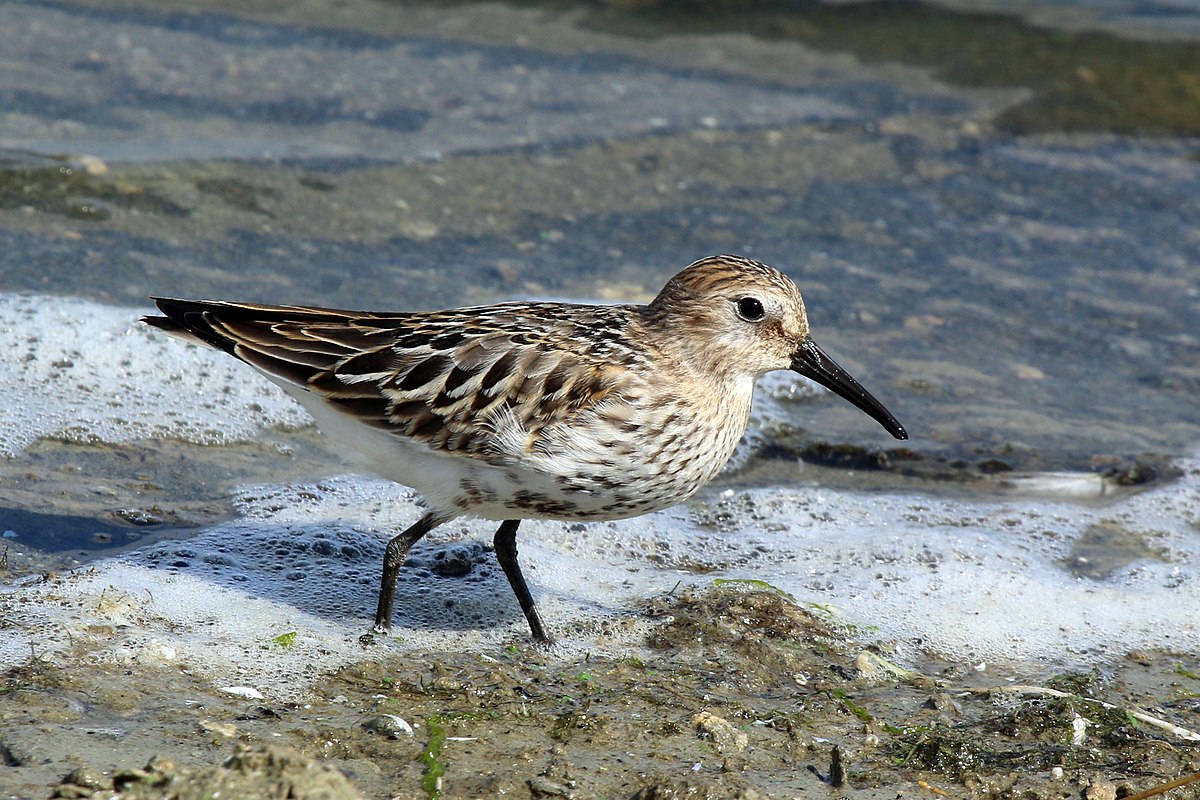
Wikipedia: Dunlin Source: OTHER
1200px-Dunlin_%28Calidris_alpina%29_juvenile.jpg
This bird appears across the great seas in the following continents:
Europe, North America, South America, Africa.
General: ![]() The dunlin (Calidris alpina) is a small wader, sometimes separated with the other "stints" in Erolia. The English name is a dialect form of "dunling", first recorded in 1531–2. It derives from dun, "dull brown", with the suffix -ling, meaning a person or thing with the given quality.[2] The genus name is from Ancient Greek kalidris or skalidris, a term used by Aristotle for some grey-coloured waterside birds. The specific alpina is from Latin and means "of high mountains", in this case referring to the Alps.[3]
[more]
The dunlin (Calidris alpina) is a small wader, sometimes separated with the other "stints" in Erolia. The English name is a dialect form of "dunling", first recorded in 1531–2. It derives from dun, "dull brown", with the suffix -ling, meaning a person or thing with the given quality.[2] The genus name is from Ancient Greek kalidris or skalidris, a term used by Aristotle for some grey-coloured waterside birds. The specific alpina is from Latin and means "of high mountains", in this case referring to the Alps.[3]
[more]
Song: ![]() Song: A drawn out, nasal "tweeet", and ringing variations on the contact call in decrescendo. Low chattering heard from feeding birds. [Link]
Song: A drawn out, nasal "tweeet", and ringing variations on the contact call in decrescendo. Low chattering heard from feeding birds. [Link]
Calls: ![]() Contact call a diagnostic, very nasal "trrreeet" . Given throughout the year and in many situations, including when being flushed. [Link]
Contact call a diagnostic, very nasal "trrreeet" . Given throughout the year and in many situations, including when being flushed. [Link]
Physical details: length=16-20 cm,
wingspan=38-43 cm,
weight=35-60 g
Habitats:
Wetland
Pectoral sandpiper / Graubrust-Strandläufer (Calidris melanotos)
Profile Wikipedia eBird Audubon AllAboutBirds Xeno-Canto

Wikipedia: Pectoral sandpiper Source: OTHER
1200px-Pectoral_Sandpiper3.jpg
This bird appears across the great seas in the following continents:
North America, South America, Africa.
General: ![]() The pectoral sandpiper (Calidris melanotos) is a small, migratory wader that breeds in North America and Asia, wintering in South America and Oceania. It eats small invertebrates. Its nest, a hole scraped in the ground and with a thick lining, is deep enough to protect its four eggs from the cool breezes of its breeding grounds. The pectoral sandpiper is 21 cm (8.3 in) long, with a wingspan of 46 cm (18 in).
[more]
The pectoral sandpiper (Calidris melanotos) is a small, migratory wader that breeds in North America and Asia, wintering in South America and Oceania. It eats small invertebrates. Its nest, a hole scraped in the ground and with a thick lining, is deep enough to protect its four eggs from the cool breezes of its breeding grounds. The pectoral sandpiper is 21 cm (8.3 in) long, with a wingspan of 46 cm (18 in).
[more]
Stilt sandpiper (Calidris himantopus)

Wikipedia: Stilt sandpiper Source: OTHER
Calidris_himantopus.jpg
This bird appears across the great seas in the following continents:
North America, South America, Australia.
vagrant
Purple sandpiper / Meerstrandläufer (Calidris maritima)
Profile Wikipedia eBird Audubon AllAboutBirds Xeno-Canto BirdID NABU
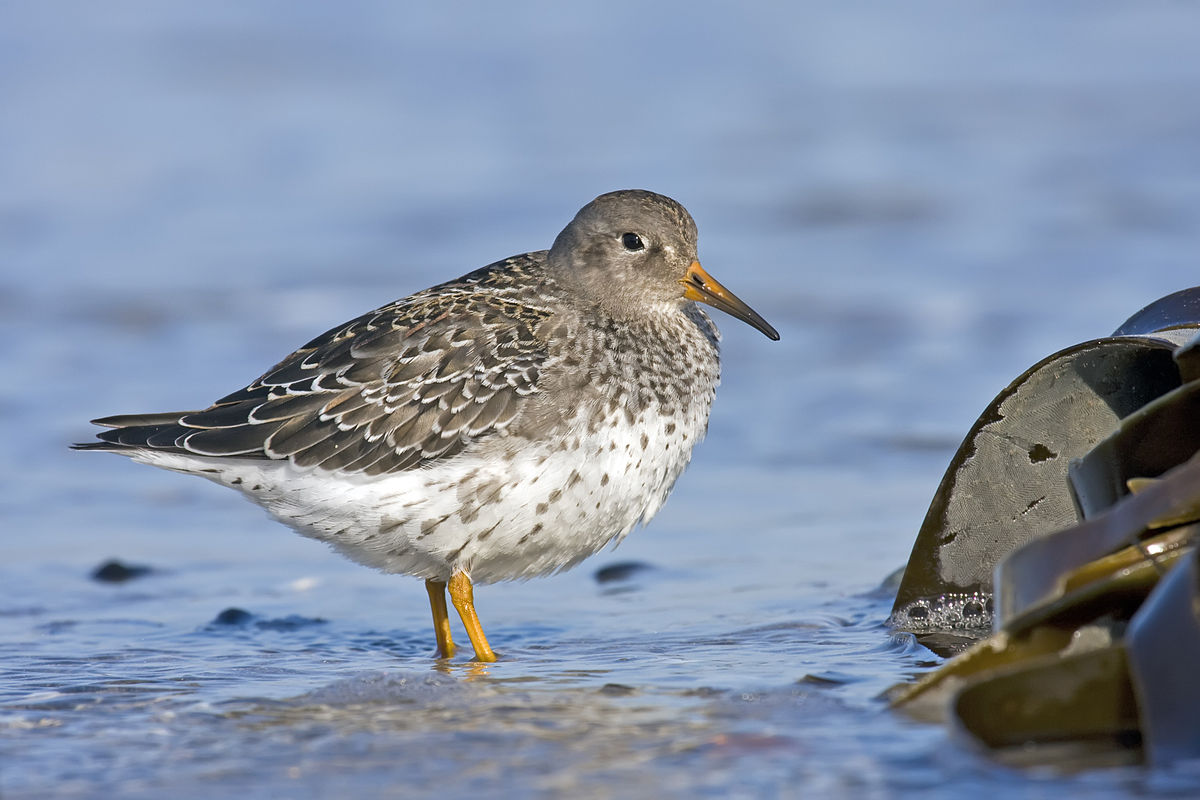
Wikipedia: Purple sandpiper Source: OTHER
1200px-Calidris_maritima.jpg
This bird appears across the great seas in the following continents:
Europe, North America.
Deutschland: Zugvogel, Wintergast
Song: ![]() Song quite varied with series of short, nasal, vibrating sounds, interspersed with drawn out, slower calls. [Link]
Song quite varied with series of short, nasal, vibrating sounds, interspersed with drawn out, slower calls. [Link]
Calls: ![]() Contact call a hoarse and hard "weet". Sometimes in chattering series. [Link]
Contact call a hoarse and hard "weet". Sometimes in chattering series. [Link]
Physical details: length=20-22 cm,
wingspan=42-46 cm,
weight=52-80 g
Western sandpiper / Bergstrandläufer (Calidris mauri)
Profile Wikipedia eBird Audubon AllAboutBirds Xeno-Canto

Wikipedia: Western sandpiper Source: OTHER
Western_Sandpiper.jpg
General: ![]() The western sandpiper (Calidris mauri) is a small shorebird. The genus name is from Ancient Greek kalidris or skalidris, a term used by Aristotle for some grey-coloured waterside birds. The specific mauri commemorates Italian botanist Ernesto Mauri (1791–1836).[2]
[more]
The western sandpiper (Calidris mauri) is a small shorebird. The genus name is from Ancient Greek kalidris or skalidris, a term used by Aristotle for some grey-coloured waterside birds. The specific mauri commemorates Italian botanist Ernesto Mauri (1791–1836).[2]
[more]
Semipalmated sandpiper / Sandstrandläufer (Calidris pusilla)
Dark-rimmed wings of these beautiful birds, probably semipalmated sandpiper, show up in flight. 2023-04-20 16.29.32 Yucatan
First observed in Yucatan on 2023-04-20.
![]() The semipalmated sandpiper (Calidris pusilla) is a very small shorebird. The genus name is from Ancient Greek kalidris or skalidris, a term used by Aristotle for some grey-coloured waterside birds. The specific pusilla is Latin for "very small".[2]
[more]
The semipalmated sandpiper (Calidris pusilla) is a very small shorebird. The genus name is from Ancient Greek kalidris or skalidris, a term used by Aristotle for some grey-coloured waterside birds. The specific pusilla is Latin for "very small".[2]
[more]
Least sandpiper / Wiesenstrandläufer (Calidris minutilla)
Profile Wikipedia eBird Audubon AllAboutBirds Xeno-Canto
Least sandpiper has wandered off the sea into the city in Campeche. 2023-04-06 16.53.02 Yucatan
First observed in Yucatan on 2023-04-06.
![]() The least sandpiper (Calidris minutilla) is the smallest shorebird. The genus name is from Ancient Greek kalidris or skalidris, a term used by Aristotle for some grey-colored waterside birds. The specific minutilla is Medieval Latin for "very small".[2]
[more]
The least sandpiper (Calidris minutilla) is the smallest shorebird. The genus name is from Ancient Greek kalidris or skalidris, a term used by Aristotle for some grey-colored waterside birds. The specific minutilla is Medieval Latin for "very small".[2]
[more]
Whimbrel / Regenbrachvogel (Numenius phaeopus)
Regenbrachvogel oder Grosser Brachvogel - dunkle Schwanzfedern ein moegliches Zeichen. 2022-06-23 16.53.34 La Sauge
First observed in Canary Islands on 2022-03-19.
This bird appears across the great seas in the following continents:
Europe, North America, South America, Africa, Asia.
![]() Der Regenbrachvogel (Numenius phaeopus) ist mit einer Spannweite um die 80 cm viel kleiner als der Große Brachvogel, auch der Schnabel ist kürzer und der Oberkopf ist hell und dunkel gestreift. Der Ruf dieser Vogelart ähnelt einem hellen Trillern.
[more]
Der Regenbrachvogel (Numenius phaeopus) ist mit einer Spannweite um die 80 cm viel kleiner als der Große Brachvogel, auch der Schnabel ist kürzer und der Oberkopf ist hell und dunkel gestreift. Der Ruf dieser Vogelart ähnelt einem hellen Trillern.
[more]
Song: ![]() Song starts similar to Curlew with long wailing notes "kluuueee", which then accelerates to a continuous, vibrating single note. Lacks the cyclic phrase ending of Curlew. [Link]
Song starts similar to Curlew with long wailing notes "kluuueee", which then accelerates to a continuous, vibrating single note. Lacks the cyclic phrase ending of Curlew. [Link]
Physical details: length=40-42 cm,
wingspan=76-89 cm,
weight=300-660 g
Habitats:
Wetland
Long-billed curlew (Numenius americanus)
Profile Wikipedia eBird Audubon AllAboutBirds Xeno-Canto

Wikipedia: Long-billed curlew Source: OTHER
1200px-Long-billed_curlew_at_Drakes_Beach%2C_Point_Reyes.jpg
General: ![]() The long-billed curlew (Numenius americanus) is a large North American shorebird of the family Scolopacidae. This species was also called "sicklebird"[2] and the "candlestick bird". The species breeds in central and western North America, migrating southward and coastward for the winter.
[more]
The long-billed curlew (Numenius americanus) is a large North American shorebird of the family Scolopacidae. This species was also called "sicklebird"[2] and the "candlestick bird". The species breeds in central and western North America, migrating southward and coastward for the winter.
[more]
Ruddy turnstone / Steinwälzer (Arenaria interpres)
Ruddy turnstone near Las Coloradas. 2023-04-15 10.06.32 Yucatan
First observed in Canary Islands on 2022-03-19.
This bird appears across the great seas in the following continents:
Europe, North America, South America, Africa, Asia.
![]() The ruddy turnstone (Arenaria interpres) is a small wading bird, one of two species of turnstone in the genus Arenaria. The scientific name is from Latin. The genus name arenaria derives from arenarius, "inhabiting sand, from arena, "sand". The specific interpres means "messenger"; when visiting Gotland in 1741, Linnaeus thought that the Swedish word Tolk "interpreter" applied to this species, but in the local dialect the word means "legs" and is used for the redshank.[2]
[more]
The ruddy turnstone (Arenaria interpres) is a small wading bird, one of two species of turnstone in the genus Arenaria. The scientific name is from Latin. The genus name arenaria derives from arenarius, "inhabiting sand, from arena, "sand". The specific interpres means "messenger"; when visiting Gotland in 1741, Linnaeus thought that the Swedish word Tolk "interpreter" applied to this species, but in the local dialect the word means "legs" and is used for the redshank.[2]
[more]
Song: ![]() Alarm call/song more "wader-like", a staccato "kuvi-kuvi-vit-vit-vitua". [Link]
Alarm call/song more "wader-like", a staccato "kuvi-kuvi-vit-vit-vitua". [Link]
Calls: ![]() Characteristic call: An explosive, hard, resonant and short "koi" or "kott" with a peculiar timbre, usually given in rapid or accelerating series. [Link]
Characteristic call: An explosive, hard, resonant and short "koi" or "kott" with a peculiar timbre, usually given in rapid or accelerating series. [Link]
Physical details: length=22-24 cm,
wingspan=50-57 cm,
weight=85-150 g
Habitats:
Wetland
American woodcock (Scolopax minor)
Profile Wikipedia eBird Audubon AllAboutBirds Xeno-Canto
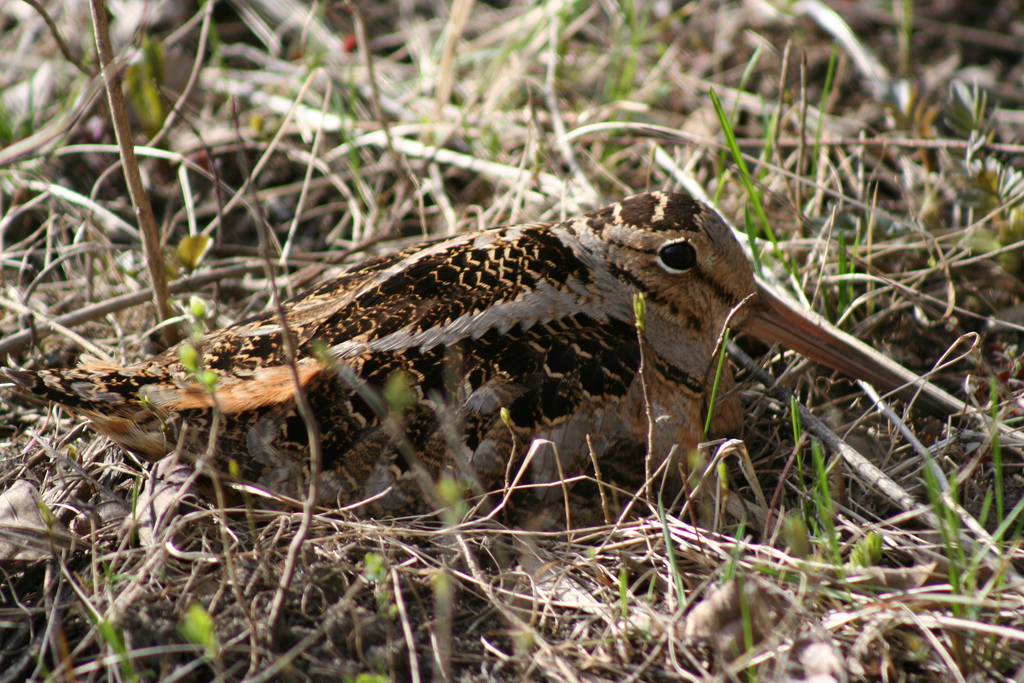
Wikipedia: American woodcock Source: OTHER
American_Woodcock_Scolopax_minor.jpg
General: ![]() The American woodcock (Scolopax minor), sometimes colloquially referred to as the timberdoodle, the bogsucker, the hokumpoke, and the Labrador twister,[2] is a small shorebird species found primarily in the eastern half of North America. Woodcocks spend most of their time on the ground in brushy, young-forest habitats, where the birds' brown, black, and gray plumage provides excellent camouflage.
[more]
The American woodcock (Scolopax minor), sometimes colloquially referred to as the timberdoodle, the bogsucker, the hokumpoke, and the Labrador twister,[2] is a small shorebird species found primarily in the eastern half of North America. Woodcocks spend most of their time on the ground in brushy, young-forest habitats, where the birds' brown, black, and gray plumage provides excellent camouflage.
[more]
Wilson's snipe / Wilsonbekassine (Gallinago delicata)
Profile Wikipedia eBird Audubon AllAboutBirds Xeno-Canto

Wikipedia: Wilson's snipe Source: OTHER
1200px-Gallinago-delicata-002-cropped.jpg
![]() Wilson's snipe (Gallinago delicata) is a small, stocky shorebird.[2] The genus name gallinago is New Latin for a woodcock or snipe from Latin gallina, "hen" and the suffix -ago, "resembling". The specific delicata is Latin for "dainty".[3]
[more]
Wilson's snipe (Gallinago delicata) is a small, stocky shorebird.[2] The genus name gallinago is New Latin for a woodcock or snipe from Latin gallina, "hen" and the suffix -ago, "resembling". The specific delicata is Latin for "dainty".[3]
[more]
Long-billed dowitcher / Großer Schlammläufer (Limnodromus scolopaceus)
Profile Wikipedia eBird Audubon AllAboutBirds Xeno-Canto

Wikipedia: Long-billed dowitcher Source: OTHER
1200px-Limnodromus_scolopaceus_Mike_Baird_crop.jpg
This bird appears across the great seas in the following continents:
North America, South America, Australia.
vagrant
Shortbilled dowitcher / Kleiner Schlammläufer (Limnodromus griseus)
You can see why it's called Las Colarados here - I believe Erik said short-billed dowitchers. 2023-04-15 09.33.38 Yucatan
First observed in Yucatan on 2023-04-15.
This bird appears across the great seas in the following continents:
North America, South America, Australia.
vagrant
Hudsonian godwit / Hudsonschnepfe (Limosa haemastica)
Profile Wikipedia eBird Audubon AllAboutBirds Xeno-Canto

Wikipedia: Hudsonian godwit Source: OTHER
1200px-Limosa_haemastica_-_Kogarah_Bay.jpg
This bird appears across the great seas in the following continents:
North America, South America, Africa.
General: ![]() The Hudsonian godwit (Limosa haemastica) is a large shorebird in the sandpiper family, Scolopacidae. The genus name Limosa is from Latin and means "muddy", from limus, "mud". The specific haemastica is from Ancient Greek and means "bloody". An 18th century name for this bird was red-breasted godwit.[2] The English term "godwit" was first recorded in about 1416–7 and is believed to imitate the bird's call.[3]
[more]
The Hudsonian godwit (Limosa haemastica) is a large shorebird in the sandpiper family, Scolopacidae. The genus name Limosa is from Latin and means "muddy", from limus, "mud". The specific haemastica is from Ancient Greek and means "bloody". An 18th century name for this bird was red-breasted godwit.[2] The English term "godwit" was first recorded in about 1416–7 and is believed to imitate the bird's call.[3]
[more]
Marbled godwit / Amerikanische Pfuhlschnepfe (Limosa fedoa)
Profile Wikipedia eBird Audubon AllAboutBirds Xeno-Canto
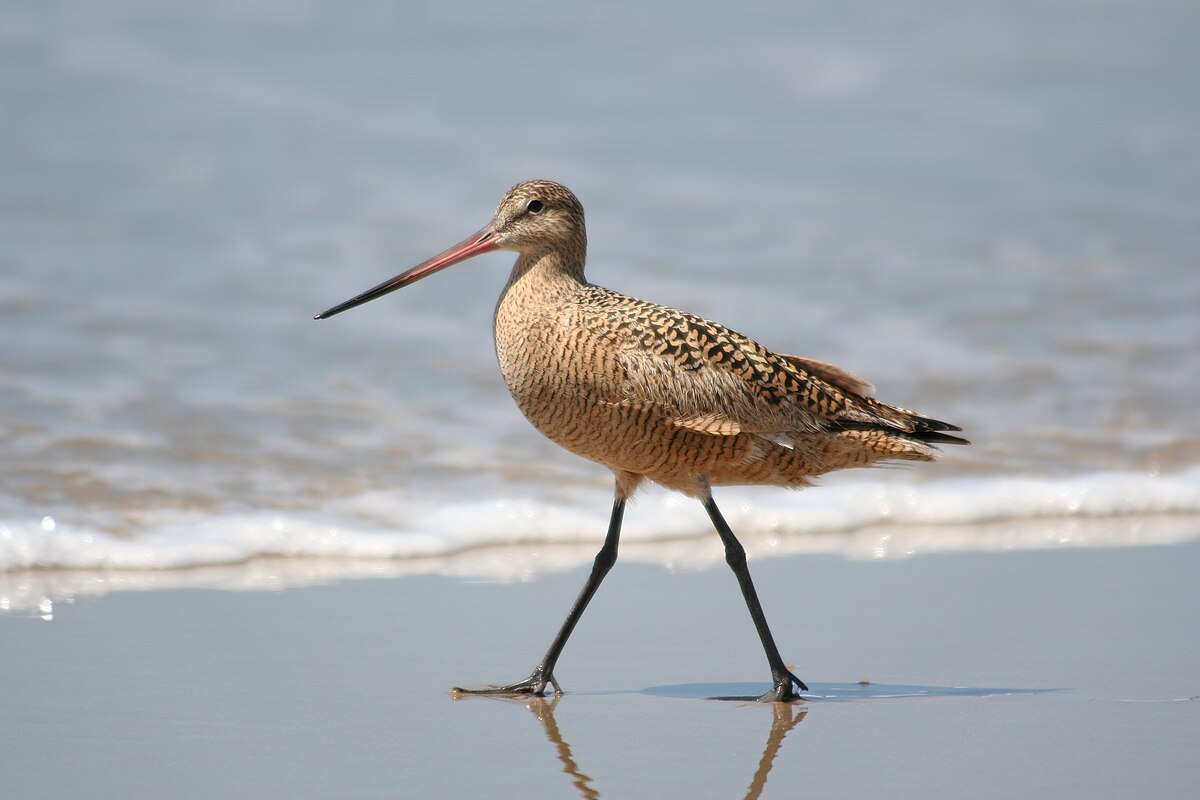
Wikipedia: Marbled godwit Source: OTHER
1200px-MarbledGodwit.jpg
![]() The marbled godwit (Limosa fedoa) is a large shorebird. On average, it is the largest of the 4 species of godwit.
[more]
The marbled godwit (Limosa fedoa) is a large shorebird. On average, it is the largest of the 4 species of godwit.
[more]
Lesser yellowlegs / Kleiner Gelbschenkel (Tringa flavipes)
Profile Wikipedia eBird Audubon AllAboutBirds Xeno-Canto

Wikipedia: Lesser yellowlegs Source: OTHER
1200px-Lesser_Yellowlegs.jpg
This bird appears across the great seas in the following continents:
North America, South America, Africa.
![]() The lesser yellowlegs (Tringa flavipes) is a medium-sized shorebird. The genus name Tringa is the New Latin name given to the green sandpiper by Aldrovandus in 1599 based on Ancient Greek trungas, a thrush-sized, white-rumped, tail-bobbing wading bird mentioned by Aristotle. The specific flavipes is from Latin flavus, "yellow", and pes, "foot".[2]
[more]
The lesser yellowlegs (Tringa flavipes) is a medium-sized shorebird. The genus name Tringa is the New Latin name given to the green sandpiper by Aldrovandus in 1599 based on Ancient Greek trungas, a thrush-sized, white-rumped, tail-bobbing wading bird mentioned by Aristotle. The specific flavipes is from Latin flavus, "yellow", and pes, "foot".[2]
[more]
Solitary sandpiper / Einsamer Wasserläufer (Tringa solitaria)
Profile Wikipedia eBird Audubon AllAboutBirds Xeno-Canto

Wikipedia: Solitary sandpiper Source: OTHER
Solitarysandpiper.jpg
![]() The solitary sandpiper (Tringa solitaria) is a small shorebird. The genus name Tringa is the New Latin name given to the green sandpiper by Aldrovandus in 1599 based on Ancient Greek trungas, a thrush-sized, white-rumped, tail-bobbing wading bird mentioned by Aristotle. The specific solitaria is Latin for "solitary" from solus, "alone".[2]
[more]
The solitary sandpiper (Tringa solitaria) is a small shorebird. The genus name Tringa is the New Latin name given to the green sandpiper by Aldrovandus in 1599 based on Ancient Greek trungas, a thrush-sized, white-rumped, tail-bobbing wading bird mentioned by Aristotle. The specific solitaria is Latin for "solitary" from solus, "alone".[2]
[more]
Willet / Schlammtreter (Tringa semipalmata)
MerlinBirdID says willet, near St Petersburg. 2023-09-27 12.03.34 Florida
First observed in Yucatan on 2023-04-15.
![]() The willet (Tringa semipalmata), formerly in the monotypic genus Catoptrophorus as Catoptrophorus semipalmatus,[2][3] is a large shorebird in the family Scolopacidae. It is a relatively large and robust sandpiper, and is the largest of the species called "shanks" in the genus Tringa. Its closest relative is the lesser yellowlegs, a much smaller bird with a very different appearance apart from the fine, clear, and dense pattern of the neck, which both species show in breeding plumage. It breeds in North America and the West Indies and winters in southern North America, Central America, the West Indies and South America.
[more]
The willet (Tringa semipalmata), formerly in the monotypic genus Catoptrophorus as Catoptrophorus semipalmatus,[2][3] is a large shorebird in the family Scolopacidae. It is a relatively large and robust sandpiper, and is the largest of the species called "shanks" in the genus Tringa. Its closest relative is the lesser yellowlegs, a much smaller bird with a very different appearance apart from the fine, clear, and dense pattern of the neck, which both species show in breeding plumage. It breeds in North America and the West Indies and winters in southern North America, Central America, the West Indies and South America.
[more]
Greater yellowlegs (Tringa melanoleuca)
Profile Wikipedia eBird Audubon AllAboutBirds Xeno-Canto
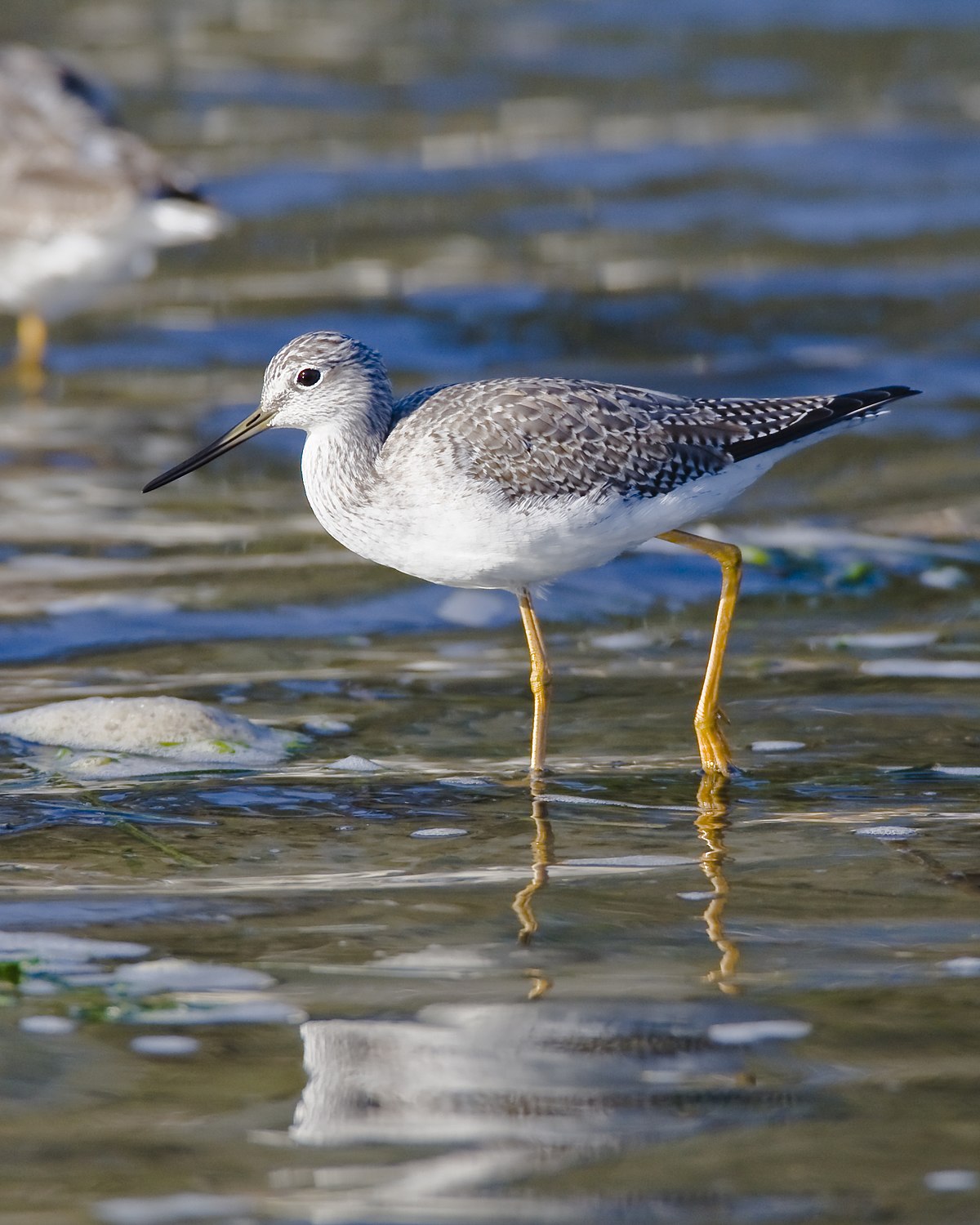
Wikipedia: Greater yellowlegs Source: OTHER
1200px-Greater_Yellowlegs2.jpg
![]() Totanus melanoleucus
[more]
Totanus melanoleucus
[more]
Spotted sandpiper / Drosseluferläufer (Actitis macularius)
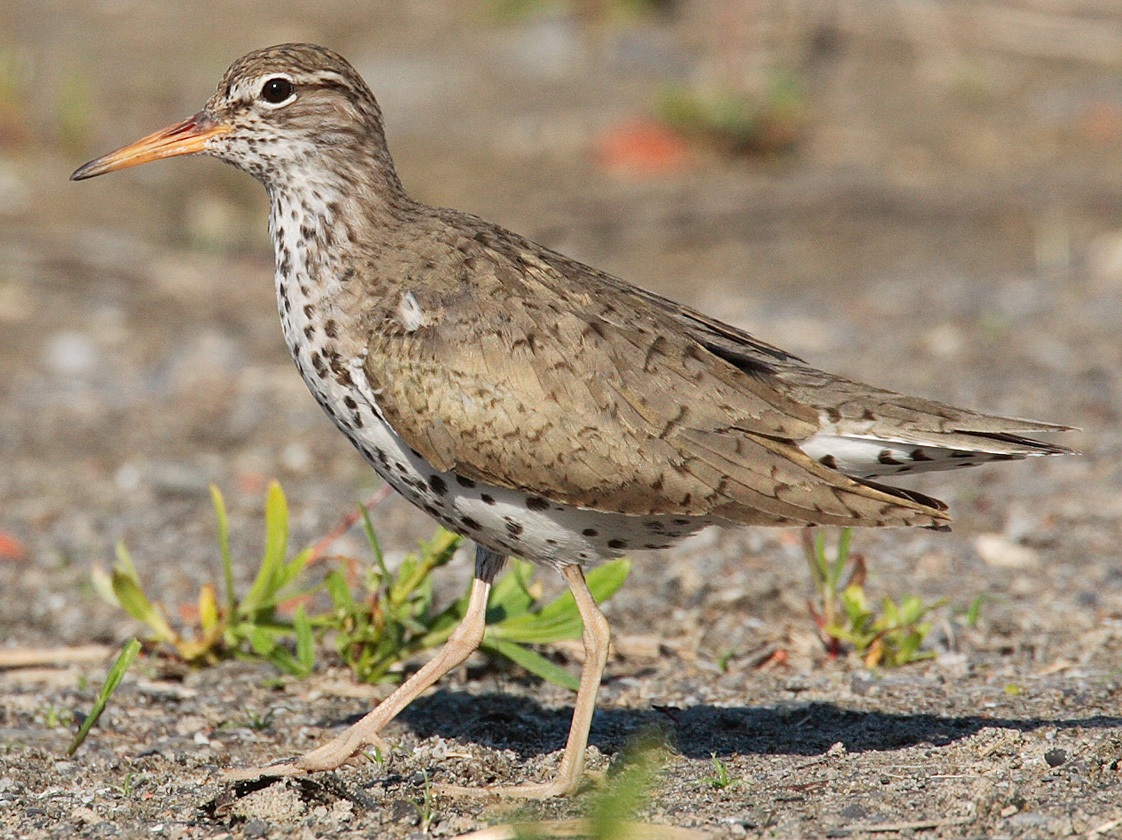
Wikipedia: Spotted sandpiper Source: OTHER
Actitis-macularia-005.jpg
![]() The spotted sandpiper (Actitis macularius) is a small shorebird. The genus name Actitis is from Ancient Greek aktites, "coast-dweller", derived from akte, "coast", and macularius is Latin from macula, "spot".[2]
[more]
The spotted sandpiper (Actitis macularius) is a small shorebird. The genus name Actitis is from Ancient Greek aktites, "coast-dweller", derived from akte, "coast", and macularius is Latin from macula, "spot".[2]
[more]
Red phalarope / Thorshühnchen (Phalaropus fulicarius)

Wikipedia: Red phalarope Source: OTHER
1200px-Phalaropus_fulicarius_10.jpg
This bird appears across the great seas in the following continents:
Europe, North America, South America, Africa.
![]() The red phalarope or grey phalarope (Phalaropus fulicarius) is a small wader. This phalarope breeds in the Arctic regions of North America and Eurasia. It is migratory, and, unusually for a wader, migrating mainly on oceanic routes and wintering at sea on tropical oceans.
[more]
The red phalarope or grey phalarope (Phalaropus fulicarius) is a small wader. This phalarope breeds in the Arctic regions of North America and Eurasia. It is migratory, and, unusually for a wader, migrating mainly on oceanic routes and wintering at sea on tropical oceans.
[more]
Calls: ![]() Flight-call a short and sharp, Coot-like "kit". Cleaner and higher pitched than Red-necked Phalarope. Display sound a rolling cooing, at stable pitch. Other calls: a hissing like the squeezing of a rubber duck, rising quickly in pitch and ending abruptly. [Link]
Flight-call a short and sharp, Coot-like "kit". Cleaner and higher pitched than Red-necked Phalarope. Display sound a rolling cooing, at stable pitch. Other calls: a hissing like the squeezing of a rubber duck, rising quickly in pitch and ending abruptly. [Link]
Physical details: length=20-22 cm,
wingspan=40-44 cm,
weight=40-75 g
Wilson's phalarope / Wilson-Wassertreter (Phalaropus tricolor)
Profile Wikipedia eBird Audubon AllAboutBirds Xeno-Canto
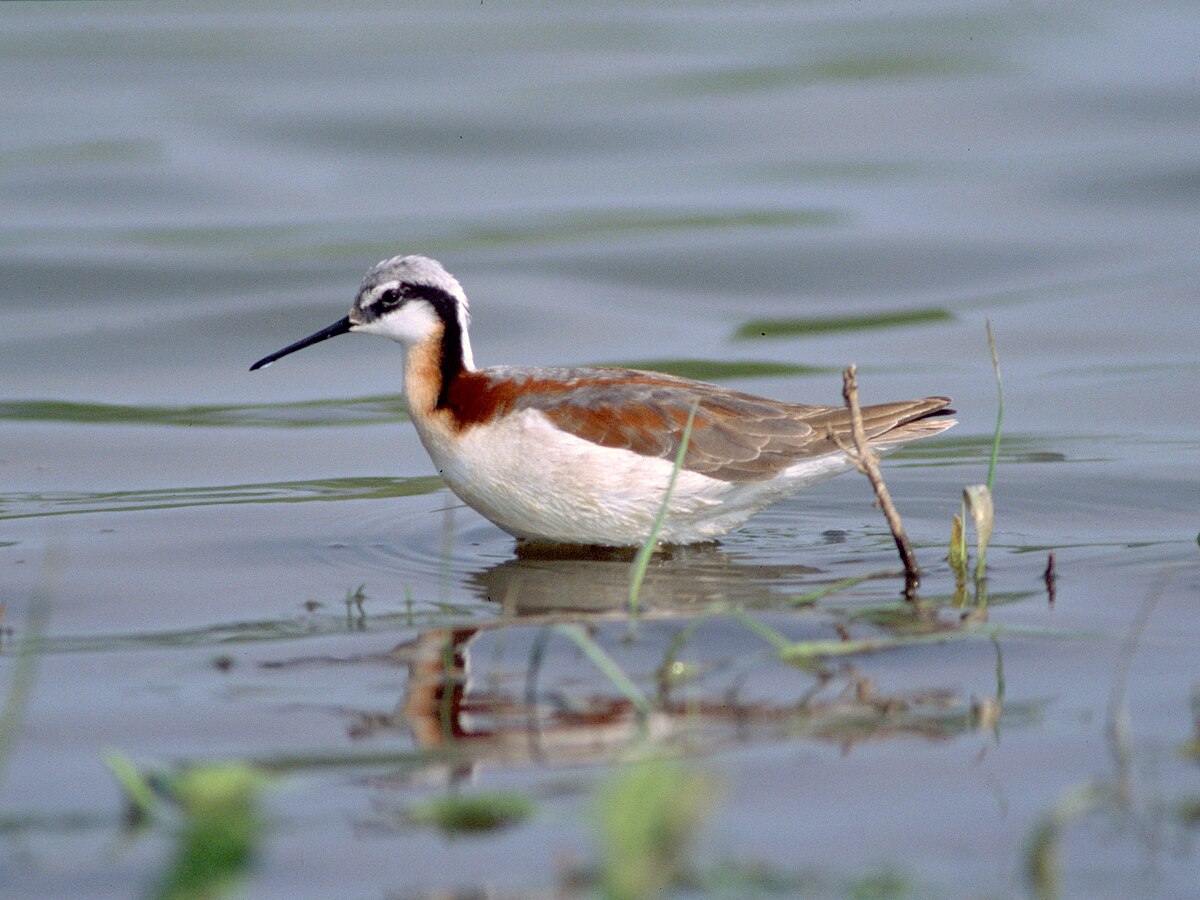
Wikipedia: Wilson's phalarope Source: OTHER
1200px-Phalaropus_tricolor_-_breeding_female.jpg
This bird appears across the great seas in the following continents:
North America, South America, Africa.
General: ![]() Wilson's phalarope (Phalaropus tricolor) is a small wader. This bird, the largest of the phalaropes, breeds in the prairies of North America in western Canada and the western United States. It is migratory, wintering in inland salt lakes near the Andes in Argentina.[2] They are passage migrants through Central America around March/April and again during September/October.[3] The species is a rare vagrant to western Europe.
[more]
Wilson's phalarope (Phalaropus tricolor) is a small wader. This bird, the largest of the phalaropes, breeds in the prairies of North America in western Canada and the western United States. It is migratory, wintering in inland salt lakes near the Andes in Argentina.[2] They are passage migrants through Central America around March/April and again during September/October.[3] The species is a rare vagrant to western Europe.
[more]
Red-necked phalarope / Odinshühnchen (Phalaropus lobatus)
Profile Wikipedia eBird Audubon AllAboutBirds Xeno-Canto NABU
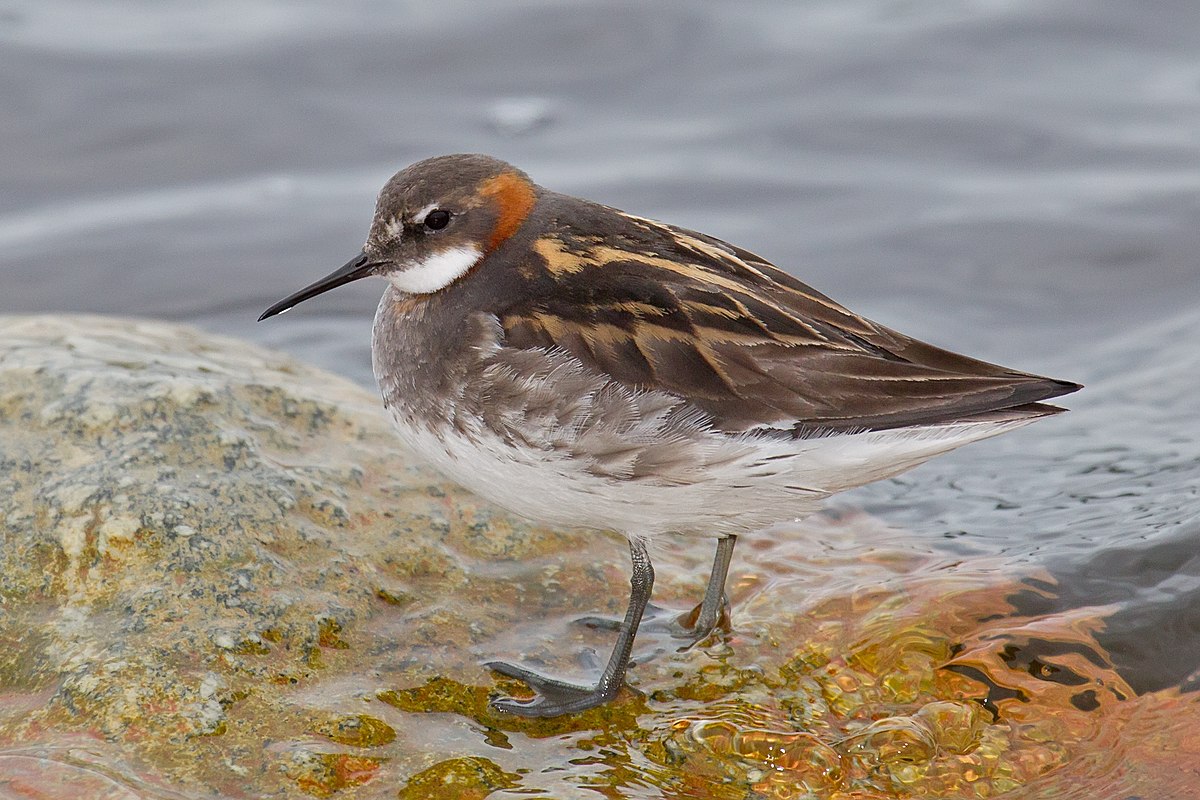
Wikipedia: Red-necked phalarope Source: OTHER
1200px-Red-necked_Phalarope.jpg
This bird appears across the great seas in the following continents:
Europe, North America, South America, Africa, Asia.
![]() The red-necked phalarope (Phalaropus lobatus), also known as the northern phalarope and hyperborean phalarope,[2] is a small wader. This phalarope breeds in the Arctic regions of North America and Eurasia. It is migratory, and, unusually for a wader, winters at sea on tropical oceans.
[more]
The red-necked phalarope (Phalaropus lobatus), also known as the northern phalarope and hyperborean phalarope,[2] is a small wader. This phalarope breeds in the Arctic regions of North America and Eurasia. It is migratory, and, unusually for a wader, winters at sea on tropical oceans.
[more]
Upland sandpiper / Prärieläufer (Bartramia longicauda)
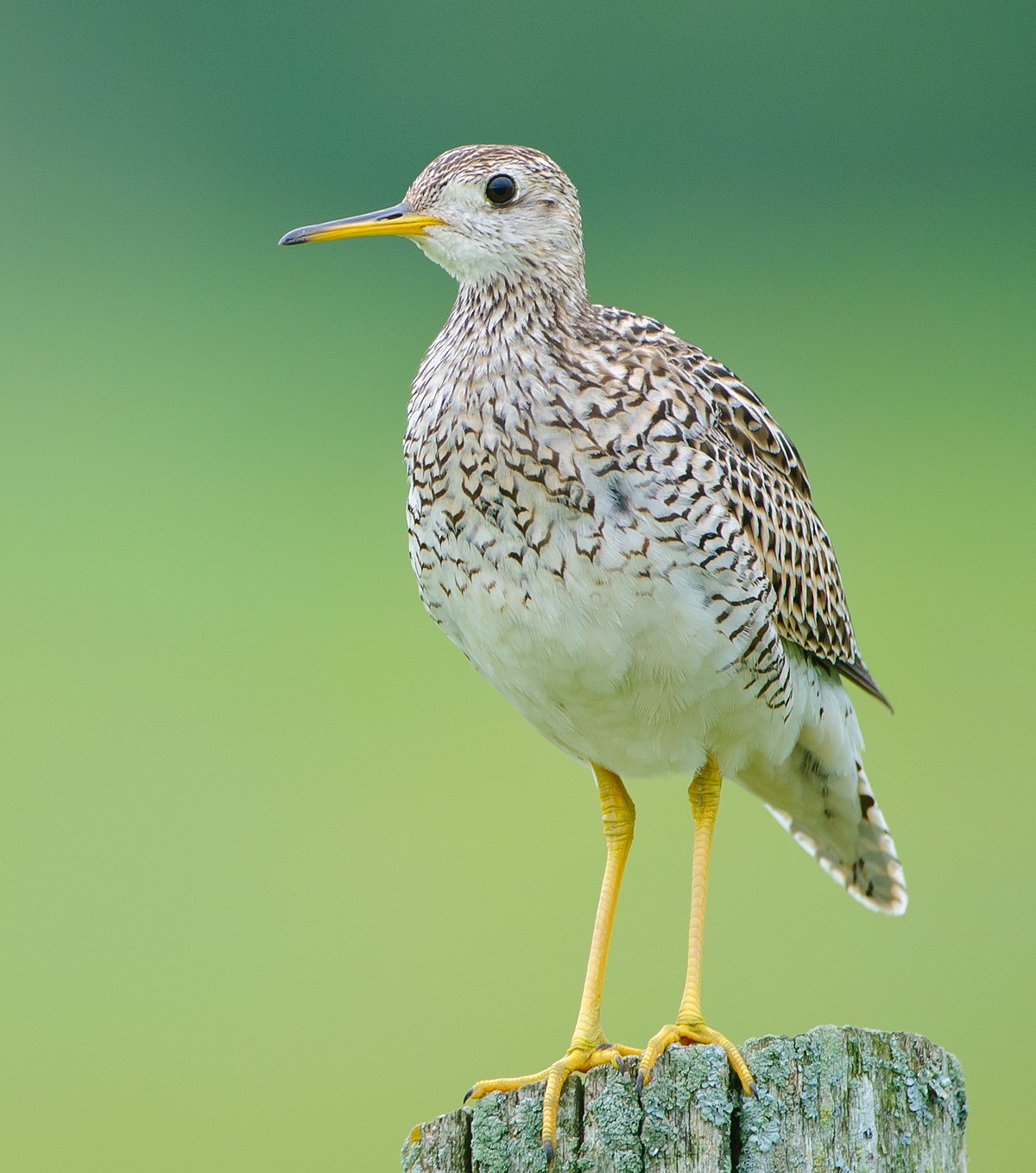
Wikipedia: Upland sandpiper Source: OTHER
1200px-UplandSandpiperOntarioCropped.jpg
This bird appears across the great seas in the following continents:
North America, South America, Australia.
vagrant
Common tern / Flussseeschwalbe (Sterna hirundo)
Profile Wikipedia eBird Vogelwarte BirdLife ZH ornitho.ch bird-song.ch Audubon AllAboutBirds Xeno-Canto BirdID NABU
First observed in 🇨🇭 on 2020-04-27.
This bird appears across the great seas in the following continents:
Europe, North America, South America, Africa, Asia.
Seasonal Behavior: ![]() Die Flussseeschwalbe (Sterna hirundo) ist eine Vogelart aus der Familie der Seeschwalben (Sternidae).
Sie ist in Mitteleuropa ein verbreiteter, aber nicht sehr häufiger Brut- und Sommervogel.
Während der Zugzeiten können im mitteleuropäischen Raum außerdem viele Durchzügler beobachtet werden. [Link]
Die Flussseeschwalbe (Sterna hirundo) ist eine Vogelart aus der Familie der Seeschwalben (Sternidae).
Sie ist in Mitteleuropa ein verbreiteter, aber nicht sehr häufiger Brut- und Sommervogel.
Während der Zugzeiten können im mitteleuropäischen Raum außerdem viele Durchzügler beobachtet werden. [Link]
Vocalization: ![]() Similar to Arctic Tern but deeper. [Link]
Similar to Arctic Tern but deeper. [Link]
Calls: ![]() Lacks latter's high pitched "tip-tip-tip" call, and the drawn out "kree-aaahh" call falls more distinctly in pitch. [Link]
Lacks latter's high pitched "tip-tip-tip" call, and the drawn out "kree-aaahh" call falls more distinctly in pitch. [Link]
Physical details: length=31-35 cm,
wingspan=77-98 cm,
weight=110-150 g
Habitats:
River and lake
Call:
Automatically generated from Xeno-Canto recording
♫ Source: BirdNet
20200427_140813 birdnet 430 - Common tern.mp3
2020-04-27 14.08.13 Luppmen (song?)
Roseate tern / Rosenseeschwalbe (Sterna dougallii)
Profile Wikipedia eBird Audubon AllAboutBirds Xeno-Canto BirdID NABU

Wikipedia: Roseate tern Source: OTHER
1200px-Roseate_terns_Palometas.jpg
This bird appears across the great seas in the following continents:
Europe, North America, Africa, Asia.
General: ![]() The roseate tern (Sterna dougallii) is a tern in the family Laridae. The genus name Sterna is derived from Old English "stearn", "tern",[2] and the specific dougallii refers to Scottish physician and collector Dr Peter McDougall (1777–1814).[3] "Roseate" refers to the bird's pink breast in breeding plumage.[4]
[more]
The roseate tern (Sterna dougallii) is a tern in the family Laridae. The genus name Sterna is derived from Old English "stearn", "tern",[2] and the specific dougallii refers to Scottish physician and collector Dr Peter McDougall (1777–1814).[3] "Roseate" refers to the bird's pink breast in breeding plumage.[4]
[more]
Calls: ![]() Extremely harsh calls. Like mix of Caspian and Arctic Tern. Very hard and raspy "kreeeet", harder and higher pitched than Caspian Tern, but equally harsh. Other calls include more Arctic/Common tern-like short "kek", and similar. [Link]
Extremely harsh calls. Like mix of Caspian and Arctic Tern. Very hard and raspy "kreeeet", harder and higher pitched than Caspian Tern, but equally harsh. Other calls include more Arctic/Common tern-like short "kek", and similar. [Link]
Physical details: length=33-38 cm,
wingspan=72-80 cm,
weight=92-133 g
Arctic tern / Kü̈stenseeschwalbe (Sterna paradisaea)
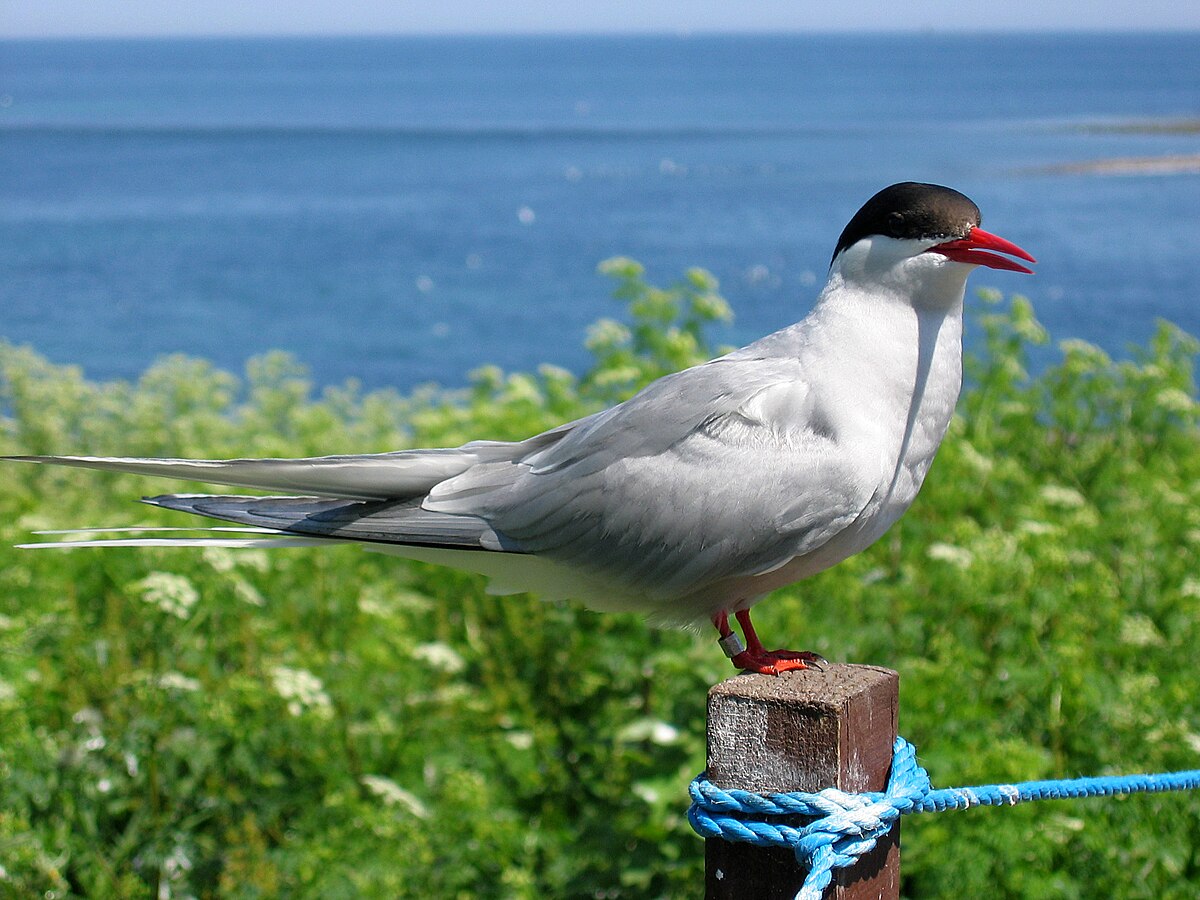
Wikipedia: Arctic tern Source: OTHER
1200px-2009_07_02_-_Arctic_tern_on_Farne_Islands_-_The_blue_rope_demarcates_the_visitors%27_path.JPG
This bird appears across the great seas in the following continents:
Europe, North America, South America, Africa.
General: ![]() The Arctic tern (Sterna paradisaea) is a tern in the family Laridae. This bird has a circumpolar breeding distribution covering the Arctic and sub-Arctic regions of Europe, Asia, and North America (as far south as Brittany and Massachusetts). The species is strongly migratory, seeing two summers each year as it migrates along a convoluted route from its northern breeding grounds to the Antarctic coast for the southern summer and back again about six months later. Recent studies have shown average annual roundtrip lengths of about 70,900 km (44,100 mi) for birds nesting in Iceland and Greenland[3] and about 90,000 km (56,000 mi) for birds nesting in the Netherlands.[4] These are by far the longest migrations known in the animal kingdom. The Arctic tern flies as well as glides through the air. It nests once every one to three years (depending on its mating cycle); once it has finished nesting it takes to the sky for another long southern migration.
[more]
The Arctic tern (Sterna paradisaea) is a tern in the family Laridae. This bird has a circumpolar breeding distribution covering the Arctic and sub-Arctic regions of Europe, Asia, and North America (as far south as Brittany and Massachusetts). The species is strongly migratory, seeing two summers each year as it migrates along a convoluted route from its northern breeding grounds to the Antarctic coast for the southern summer and back again about six months later. Recent studies have shown average annual roundtrip lengths of about 70,900 km (44,100 mi) for birds nesting in Iceland and Greenland[3] and about 90,000 km (56,000 mi) for birds nesting in the Netherlands.[4] These are by far the longest migrations known in the animal kingdom. The Arctic tern flies as well as glides through the air. It nests once every one to three years (depending on its mating cycle); once it has finished nesting it takes to the sky for another long southern migration.
[more]
Vocalization: ![]() Similar to Common Tern but higher pitched. [Link]
Similar to Common Tern but higher pitched. [Link]
Calls: ![]() Typical call a series of high pitched "tip-tip-tip", and longer, ringing, high-pitched "kriiiiii" calls. The drawn out "kree-aaahh" call falls less distinctly in pitch than Common Tern. [Link]
Typical call a series of high pitched "tip-tip-tip", and longer, ringing, high-pitched "kriiiiii" calls. The drawn out "kree-aaahh" call falls less distinctly in pitch than Common Tern. [Link]
Physical details: length=33-35 cm,
wingspan=75-85 cm,
weight=95-120 g
Forster's tern (Sterna forsteri)
Profile Wikipedia eBird Audubon AllAboutBirds Xeno-Canto

Wikipedia: Forster's tern Source: OTHER
1200px-Forster%27s_Tern.jpg
General: ![]() Forster's tern (Sterna forsteri) is a tern in the family Laridae. The genus name Sterna is derived from Old English "stearn", "tern",[2] and forsteri commemorates the naturalist Johann Reinhold Forster.[3]
[more]
Forster's tern (Sterna forsteri) is a tern in the family Laridae. The genus name Sterna is derived from Old English "stearn", "tern",[2] and forsteri commemorates the naturalist Johann Reinhold Forster.[3]
[more]
American oystercatcher / Braunmantel-Austernfischer (Haematopus palliatus)
Profile Wikipedia eBird Audubon AllAboutBirds Xeno-Canto

Wikipedia: American oystercatcher Source: OTHER
1200px-American_oystercatchers_at_Fort_Tilden_%2860747%29.jpg
![]() The American oystercatcher (Haematopus palliatus), occasionally called the American pied oystercatcher, is a member of family Haematopodidae. Originally called the "sea pie", it was renamed in 1731 when naturalist Mark Catesby observed the bird eating oysters.[2] The current population of American oystercatchers is estimated to be 43,000.[2] There are estimated to be 1,500 breeding pairs along the Atlantic and Gulf Coasts of the US.[3] The bird is marked by its black and white body and a long, thick orange beak.
[more]
The American oystercatcher (Haematopus palliatus), occasionally called the American pied oystercatcher, is a member of family Haematopodidae. Originally called the "sea pie", it was renamed in 1731 when naturalist Mark Catesby observed the bird eating oysters.[2] The current population of American oystercatchers is estimated to be 43,000.[2] There are estimated to be 1,500 breeding pairs along the Atlantic and Gulf Coasts of the US.[3] The bird is marked by its black and white body and a long, thick orange beak.
[more]
Pomarine jaeger / Spatelraubmöwe (Stercorarius pomarinus)
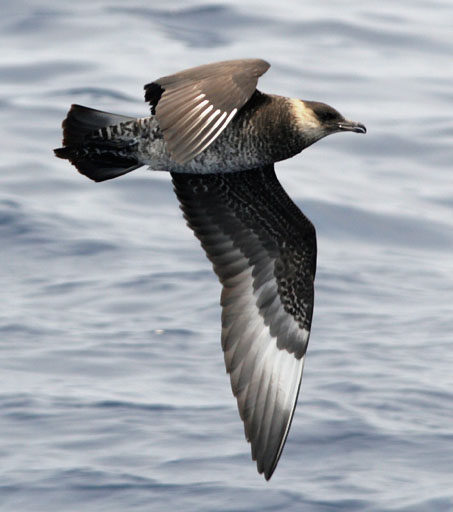
Wikipedia: Pomarine jaeger Source: OTHER
Stercorarius_pomarinusPCCA20070623-3985B.jpg
This bird appears across the great seas in the following continents:
Europe, North America, South America, Africa, Asia.
![]() The pomarine jaeger (Stercorarius pomarinus), pomarine skua, or pomatorhine skua,[2] is a seabird in the skua family Stercorariidae. It is a migrant, wintering at sea in the tropical oceans.
[more]
The pomarine jaeger (Stercorarius pomarinus), pomarine skua, or pomatorhine skua,[2] is a seabird in the skua family Stercorariidae. It is a migrant, wintering at sea in the tropical oceans.
[more]
Calls: ![]() Short "kea" or "ke", and various mewing calls, usually deeper pitched than Arctic Skua. Also a characteristic, laughing and vibrating "kayayayayaya", heard mostly on breeding ground. [Link]
Short "kea" or "ke", and various mewing calls, usually deeper pitched than Arctic Skua. Also a characteristic, laughing and vibrating "kayayayayaya", heard mostly on breeding ground. [Link]
Physical details: length=46-51 cm,
wingspan=125-138 cm,
weight=600-900 g
Long-tailed jaeger / Falkenraubmöwe (Stercorarius longicaudus)

Wikipedia: Long-tailed jaeger Source: OTHER
1200px-Long-tailed_Skua_%28js%29_26.jpg
This bird appears across the great seas in the following continents:
Europe, North America, Africa, Asia.
General: ![]() The long-tailed skua or long-tailed jaeger (Stercorarius longicaudus) is a seabird in the skua family Stercorariidae.
[more]
The long-tailed skua or long-tailed jaeger (Stercorarius longicaudus) is a seabird in the skua family Stercorariidae.
[more]
Parasitic jaeger / Schmarotzerraubmöwe (Stercorarius parasiticus)
Our guide raises his arm, which results in the Arctic Skua keeping a safe distance. 2015-06-10 15.13.04 Iceland
First observed in Iceland on 2015-06-10.
This bird appears across the great seas in the following continents:
Europe, North America, South America, Africa, Asia.
![]() The parasitic jaeger (Stercorarius parasiticus), also known as the Arctic skua, Arctic jaeger or parasitic skua, is a seabird in the skua family Stercorariidae. The word "jaeger" is derived from the German word Jäger, meaning "hunter".[2] The English "skua" comes from the Faroese name skúgvur [ˈskɪkvʊər] for the great skua, with the island of Skúvoy known for its colony of that bird. The general Faroese term for skuas is kjógvi [ˈtʃɛkvə].[3] The genus name Stercorarius is Latin and means "of dung"; the food disgorged by other birds when pursued by skuas was once thought to be excrement. The specific parasiticus is from Latin and means "parasitic".[4]
[more]
The parasitic jaeger (Stercorarius parasiticus), also known as the Arctic skua, Arctic jaeger or parasitic skua, is a seabird in the skua family Stercorariidae. The word "jaeger" is derived from the German word Jäger, meaning "hunter".[2] The English "skua" comes from the Faroese name skúgvur [ˈskɪkvʊər] for the great skua, with the island of Skúvoy known for its colony of that bird. The general Faroese term for skuas is kjógvi [ˈtʃɛkvə].[3] The genus name Stercorarius is Latin and means "of dung"; the food disgorged by other birds when pursued by skuas was once thought to be excrement. The specific parasiticus is from Latin and means "parasitic".[4]
[more]
Vocalization: ![]() Mostly heard at breeding ground. [Link]
Mostly heard at breeding ground. [Link]
Calls: ![]() Most characteristic call is a mewing, kittiwake-like "aeeeee-ah". First syllable drawn-out and rising in pitch, and followed by a deeper conclusive second syllable "ah". Lacks the introductory double accent of Kittiwakes ("kitti-wake"). [Link]
Most characteristic call is a mewing, kittiwake-like "aeeeee-ah". First syllable drawn-out and rising in pitch, and followed by a deeper conclusive second syllable "ah". Lacks the introductory double accent of Kittiwakes ("kitti-wake"). [Link]
Physical details: length=41-46 cm,
wingspan=110-125 cm,
weight=330-570 g
American avocet / Amerikanischer Säbelschnäbler (Recurvirostra americana)
Profile Wikipedia eBird Audubon AllAboutBirds Xeno-Canto

Wikipedia: American avocet Source: OTHER
1200px-American_Avocet1.jpg
General: ![]() The American avocet (Recurvirostra americana) is a large wader in the avocet and stilt family, Recurvirostridae. It spends much of its time foraging in shallow water or on mud flats, often sweeping its bill from side to side in water as it seeks its crustacean and insect prey.[2]
[more]
The American avocet (Recurvirostra americana) is a large wader in the avocet and stilt family, Recurvirostridae. It spends much of its time foraging in shallow water or on mud flats, often sweeping its bill from side to side in water as it seeks its crustacean and insect prey.[2]
[more]
Black-necked stilt / Amerikanischer Stelzenläufer (Himantopus mexicanus)
Profile Wikipedia eBird Audubon AllAboutBirds Xeno-Canto
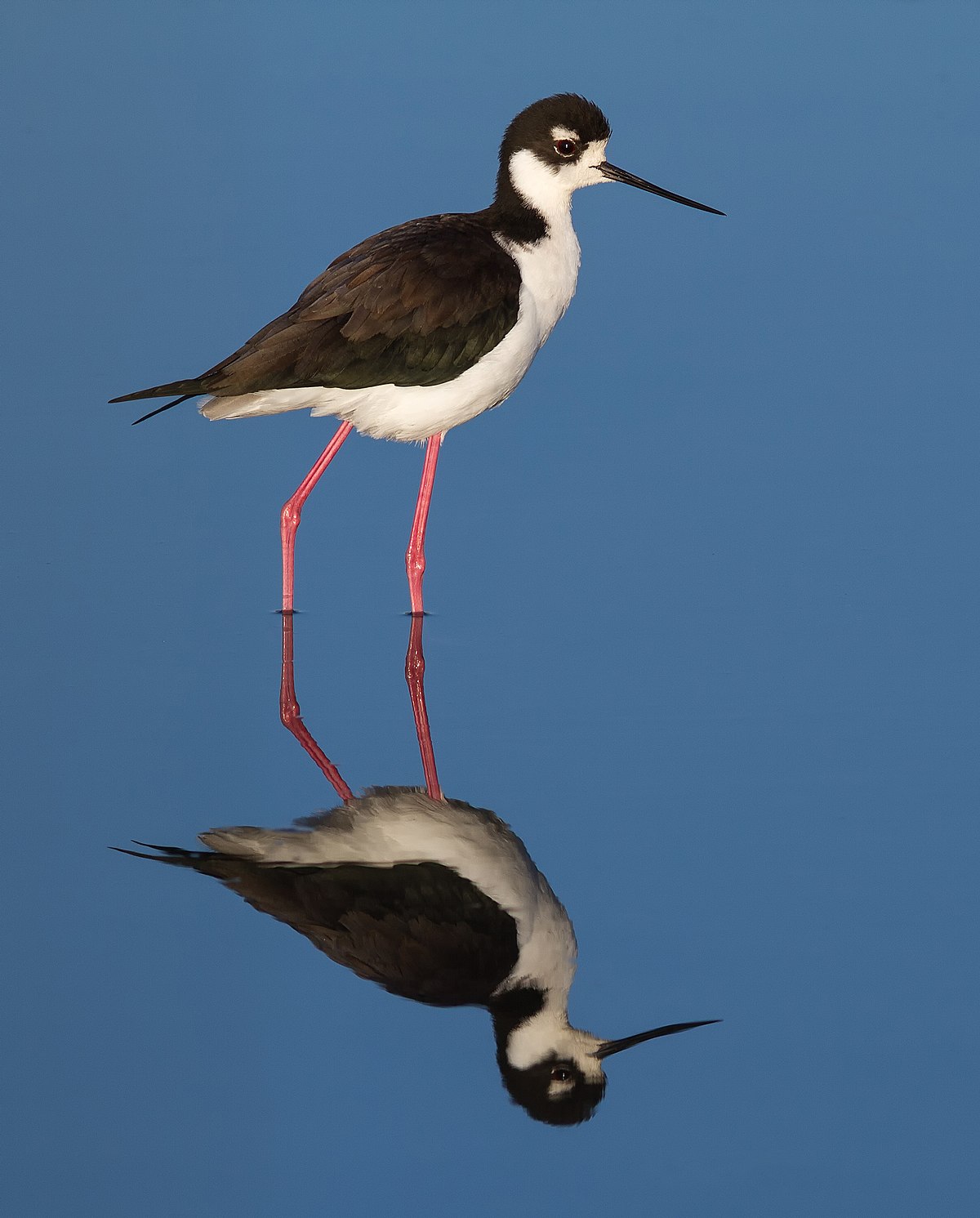
Wikipedia: Black-necked stilt Source: OTHER
1200px-Black-necked_Stilt_%28Himantopus_mexicanus%29%2C_Corte_Madera.jpg
![]() The black-necked stilt (Himantopus mexicanus) is a locally abundant shorebird of American wetlands and coastlines. It is found from the coastal areas of California through much of the interior western United States and along the Gulf of Mexico as far east as Florida, then south through Central America and the Caribbean to Ecuador and the Galápagos Islands. The northernmost populations, particularly those from inland, are migratory, wintering from the extreme south of the United States to southern Mexico, rarely as far south as Costa Rica; on the Baja California peninsula it is only found regularly in winter.[2]
[more]
The black-necked stilt (Himantopus mexicanus) is a locally abundant shorebird of American wetlands and coastlines. It is found from the coastal areas of California through much of the interior western United States and along the Gulf of Mexico as far east as Florida, then south through Central America and the Caribbean to Ecuador and the Galápagos Islands. The northernmost populations, particularly those from inland, are migratory, wintering from the extreme south of the United States to southern Mexico, rarely as far south as Costa Rica; on the Baja California peninsula it is only found regularly in winter.[2]
[more]
American coot (Fulica americana)
Profile Wikipedia eBird Audubon AllAboutBirds Xeno-Canto
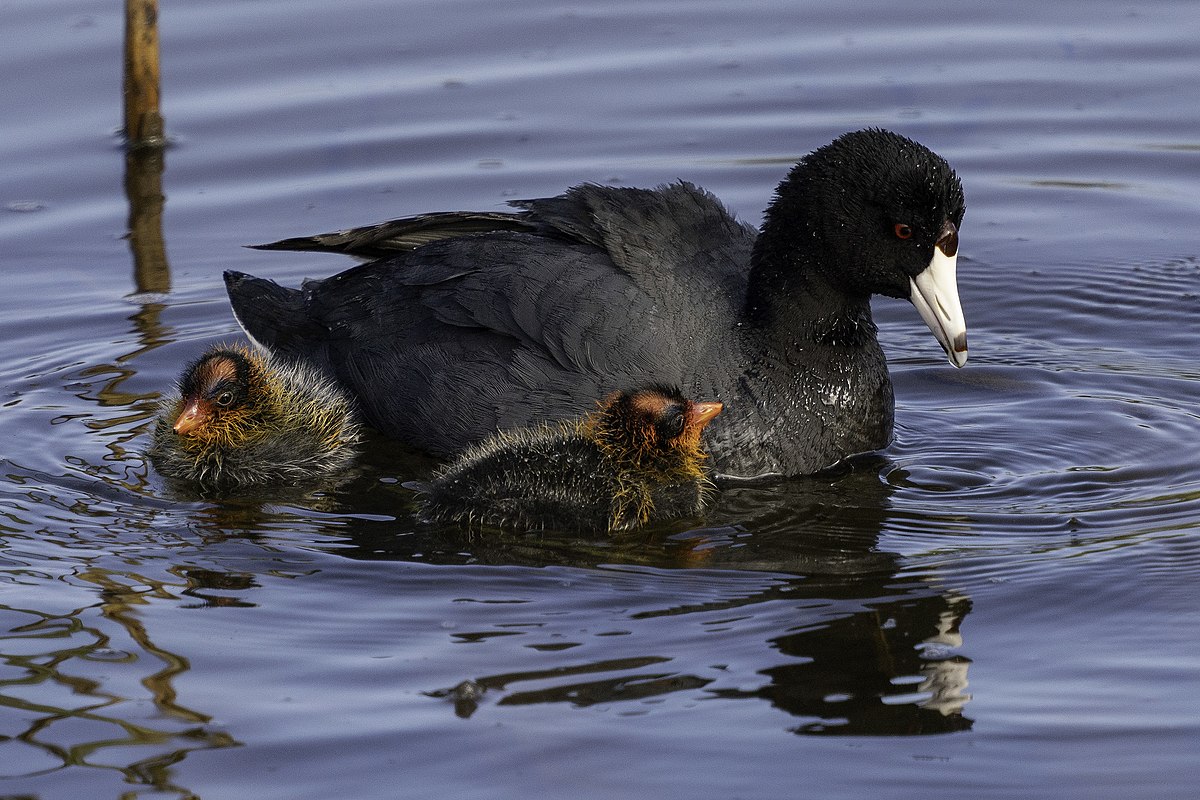
Wikipedia: American coot Source: OTHER
1200px-American-coot-casey-klebba.jpg
![]() The American coot (Fulica americana), also known as a mud hen or pouldeau, is a bird of the family Rallidae. Though commonly mistaken for ducks, American coots are only distantly related to ducks, belonging to a separate order. Unlike the webbed feet of ducks, coots have broad, lobed scales on their lower legs and toes that fold back with each step in order to facilitate walking on dry land.[2] Coots live near water, typically inhabiting wetlands and open water bodies in North America. Groups of coots are called covers[3] or rafts.[citation needed] The oldest known coot lived to be 22 years old.[2]
[more]
The American coot (Fulica americana), also known as a mud hen or pouldeau, is a bird of the family Rallidae. Though commonly mistaken for ducks, American coots are only distantly related to ducks, belonging to a separate order. Unlike the webbed feet of ducks, coots have broad, lobed scales on their lower legs and toes that fold back with each step in order to facilitate walking on dry land.[2] Coots live near water, typically inhabiting wetlands and open water bodies in North America. Groups of coots are called covers[3] or rafts.[citation needed] The oldest known coot lived to be 22 years old.[2]
[more]
Clapper rail (Rallus crepitans)
Profile Wikipedia eBird Audubon AllAboutBirds Xeno-Canto
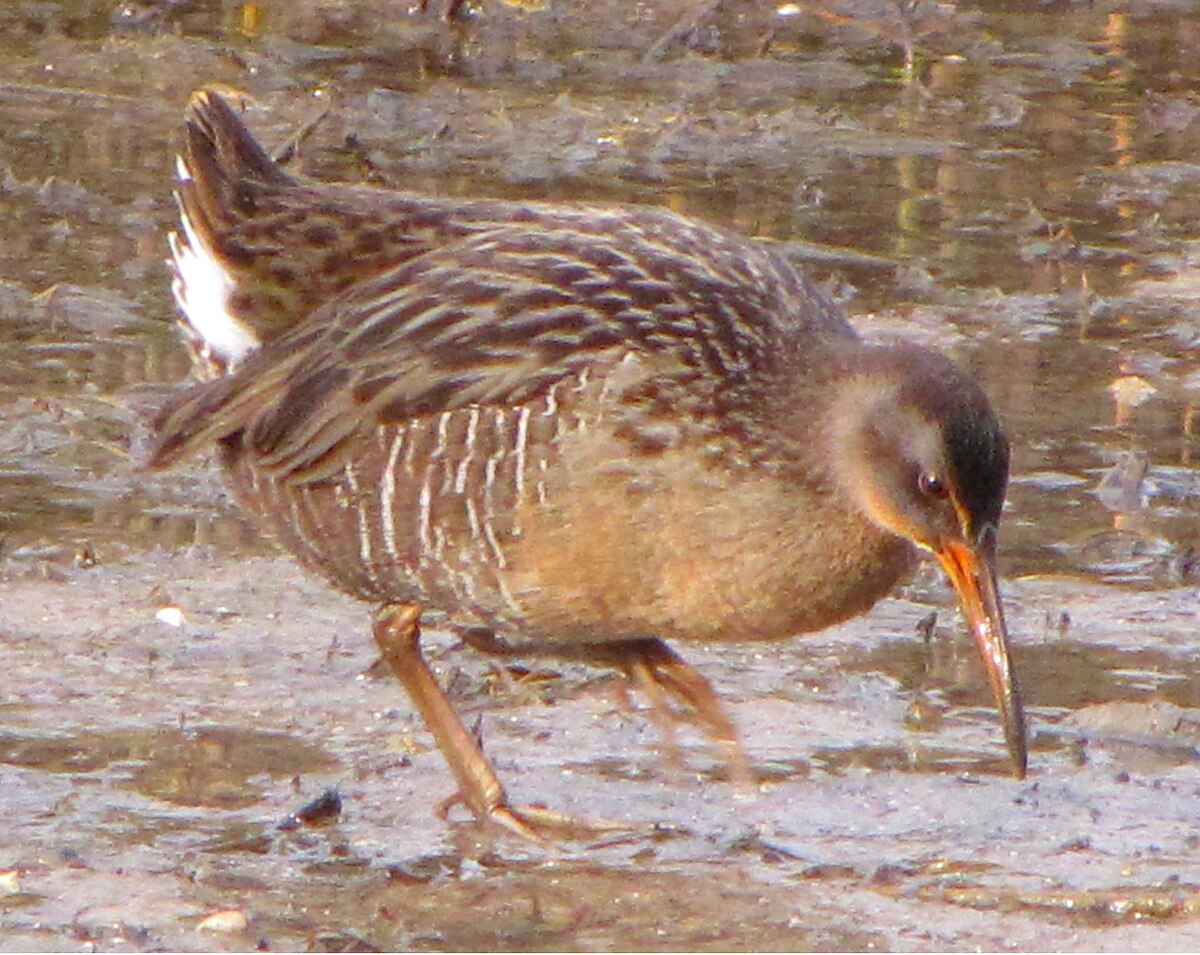
Wikipedia: Clapper rail Source: OTHER
1200px-Rallus_crepitans.jpg
![]() The clapper rail (Rallus crepitans) is a member of the rail family, Rallidae. The taxonomy for this species is confusing and still being determined. The Ridgway's rail (formerly the California clapper rail) and the mangrove rail have been recently split. Furthermore, some taxonomists consider that the King rail and Aztec rail should be considered within this group, as those birds look similar and the birds are known to interbreed where they share territories.
[more]
The clapper rail (Rallus crepitans) is a member of the rail family, Rallidae. The taxonomy for this species is confusing and still being determined. The Ridgway's rail (formerly the California clapper rail) and the mangrove rail have been recently split. Furthermore, some taxonomists consider that the King rail and Aztec rail should be considered within this group, as those birds look similar and the birds are known to interbreed where they share territories.
[more]
Virginia rail (Rallus limicola)
Profile Wikipedia eBird Audubon AllAboutBirds Xeno-Canto

Wikipedia: Virginia rail Source: OTHER
1200px-Rallus_limicola_-Cloisters_Park%2C_Morro_Bay%2C_California%2C_USA-8_%281%29.jpg
![]() The Virginia rail (Rallus limicola) is a small waterbird, of the family Rallidae.
These birds remain fairly common despite continuing loss of habitat, but are secretive by nature and more often heard than seen.[2] They are also considered a game species in some provinces and states, though rarely hunted.[3] The Ecuadorian rail is often considered a subspecies, but some taxonomic authorities consider it distinct.
[more]
The Virginia rail (Rallus limicola) is a small waterbird, of the family Rallidae.
These birds remain fairly common despite continuing loss of habitat, but are secretive by nature and more often heard than seen.[2] They are also considered a game species in some provinces and states, though rarely hunted.[3] The Ecuadorian rail is often considered a subspecies, but some taxonomic authorities consider it distinct.
[more]
King rail (Rallus elegans)
Profile Wikipedia eBird Audubon AllAboutBirds Xeno-Canto
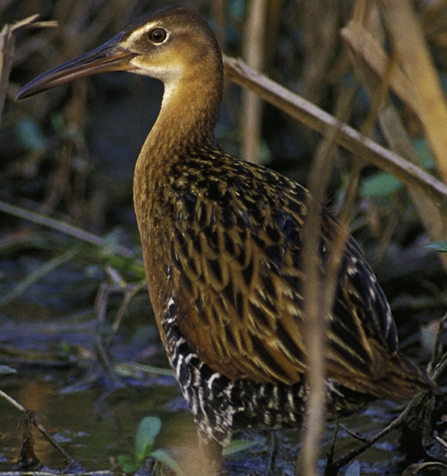
Wikipedia: King rail Source: OTHER
KingRail23.jpg
![]() The king rail (Rallus elegans) is a waterbird, the largest North American rail.
[more]
The king rail (Rallus elegans) is a waterbird, the largest North American rail.
[more]
Common gallinule (Gallinula galeata)
Profile Wikipedia eBird Audubon AllAboutBirds Xeno-Canto
Common gallinule, juvenile, Florida. 2023-09-23 20.46.10 Florida
First observed in Florida on 2023-09-23.
![]() The common gallinule (Gallinula galeata) is a bird in the family Rallidae. It was split from the common moorhen by the American Ornithologists' Union in July 2011.[3] It lives around well-vegetated marshes, ponds, canals, and other wetlands in the Americas. The species is not found in the polar regions or many tropical rainforests. Elsewhere, the common gallinule is likely the most commonly seen rail species in much of North America, except for the American coot in some regions.
[more]
The common gallinule (Gallinula galeata) is a bird in the family Rallidae. It was split from the common moorhen by the American Ornithologists' Union in July 2011.[3] It lives around well-vegetated marshes, ponds, canals, and other wetlands in the Americas. The species is not found in the polar regions or many tropical rainforests. Elsewhere, the common gallinule is likely the most commonly seen rail species in much of North America, except for the American coot in some regions.
[more]
Black rail (Laterallus jamaicensis)
Profile Wikipedia eBird Audubon AllAboutBirds Xeno-Canto

Wikipedia: Black rail Source: OTHER
1200px-Laterallus_jamaicensis_-_Black_Rail%3B_Arari%2C_Maranh%C3%A3o%2C_Brazil.jpg
![]() The black rail (Laterallus jamaicensis) is a mouse-sized member of the bird family Rallidae.
[more]
The black rail (Laterallus jamaicensis) is a mouse-sized member of the bird family Rallidae.
[more]
Purple gallinule / Zwergsultanshuhn (Porphyrio martinica)
This bird appears across the great seas in the following continents:
North America, South America, Africa.
![]() Das Zwergsultanshuhn (Porphyrio martinicus, Syn.: Porphyrula martinica) ist ein vor allem in Amerika heimischer Rallenvogel.
[more]
Das Zwergsultanshuhn (Porphyrio martinicus, Syn.: Porphyrula martinica) ist ein vor allem in Amerika heimischer Rallenvogel.
[more]
Grey-headed swamphen / Graukopf-Purpurhuhn (Porphyrio poliocephalus)

Wikipedia: Grey-headed swamphen Source: OTHER
1200px-Grey-headed_swamphen_%28Porphyrio_poliocephalus%29_male.jpg
This bird appears across the great seas in the following continents:
North America, Asia.
![]() The grey-headed swamphen (Porphyrio poliocephalus) is a species of swamphen occurring from the Middle East and the Indian subcontinent to southern China and northern Thailand. It used to be considered a subspecies of the purple swamphen, but was elevated to full species status in 2015; today the purple swamphen is considered a superspecies and each of its six subspecies groups are designated full species.[1]
[more]
The grey-headed swamphen (Porphyrio poliocephalus) is a species of swamphen occurring from the Middle East and the Indian subcontinent to southern China and northern Thailand. It used to be considered a subspecies of the purple swamphen, but was elevated to full species status in 2015; today the purple swamphen is considered a superspecies and each of its six subspecies groups are designated full species.[1]
[more]
Sora / Carolinasumpfhuhn (Porzana carolina)
Profile Wikipedia eBird Audubon AllAboutBirds Xeno-Canto
![]() Sora or SORA may refer to:
[more]
Sora or SORA may refer to:
[more]
Whooping crane / Schreikranich (Grus americana)
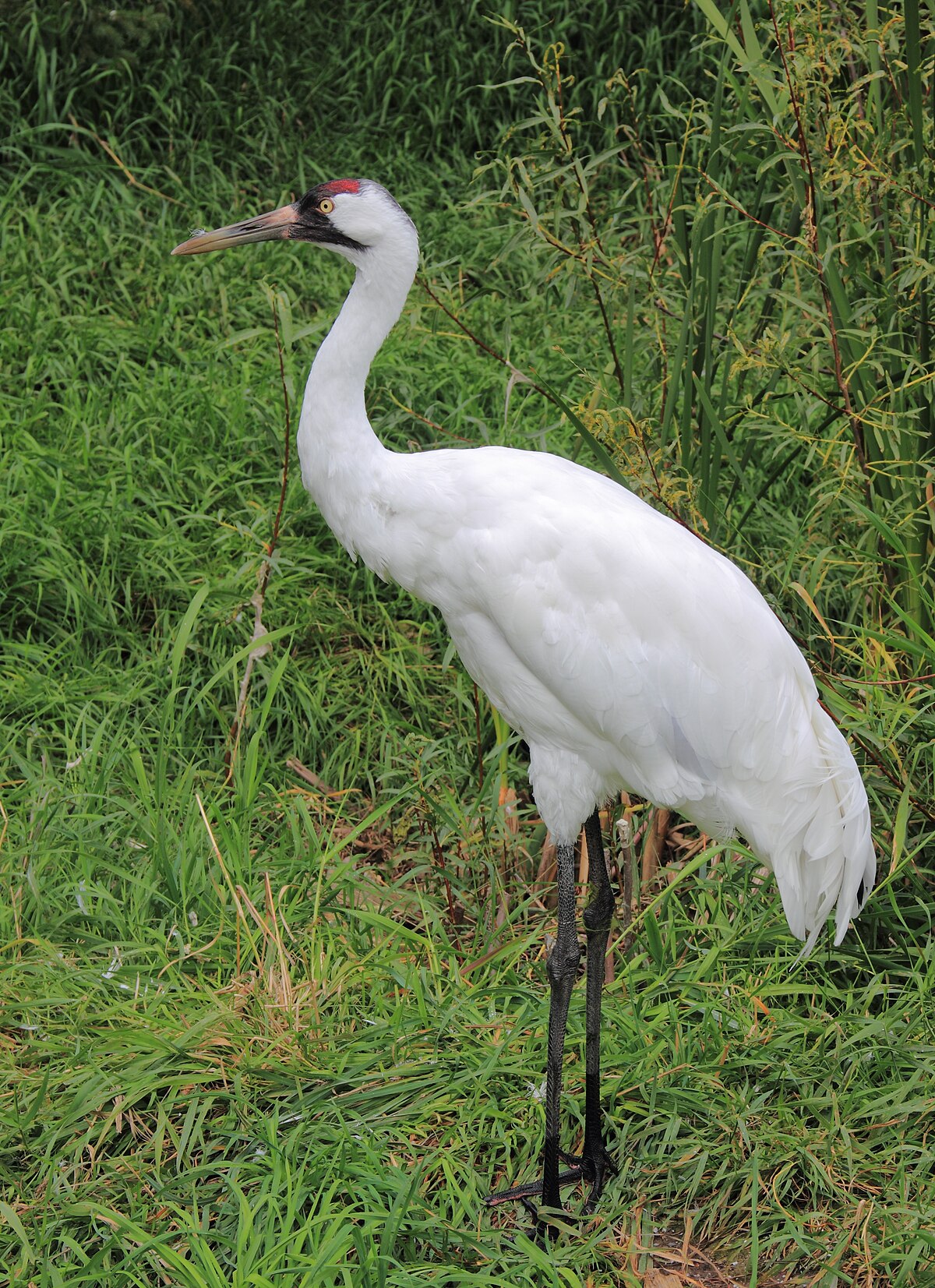
Wikipedia: Whooping crane Source: OTHER
1200px-Grus_americana_Sasata.jpg
![]() Named for its whooping sound, the whooping crane (Grus americana), is the tallest North American bird. It is an endangered crane species. Along with the sandhill crane (Antigone canadensis), it is one of only two crane species native to North America. The whooping crane's lifespan is estimated to be 22 to 24 years in the wild. After being pushed to the brink of extinction by unregulated hunting and loss of habitat to just 21 wild and two captive whooping cranes by 1941, conservation efforts have led to a limited recovery.[2] The total number of cranes in the surviving migratory population, plus three reintroduced flocks and in captivity, now exceeds 800 birds.
[more]
Named for its whooping sound, the whooping crane (Grus americana), is the tallest North American bird. It is an endangered crane species. Along with the sandhill crane (Antigone canadensis), it is one of only two crane species native to North America. The whooping crane's lifespan is estimated to be 22 to 24 years in the wild. After being pushed to the brink of extinction by unregulated hunting and loss of habitat to just 21 wild and two captive whooping cranes by 1941, conservation efforts have led to a limited recovery.[2] The total number of cranes in the surviving migratory population, plus three reintroduced flocks and in captivity, now exceeds 800 birds.
[more]
Sandhill crane (Antigone canadensis)
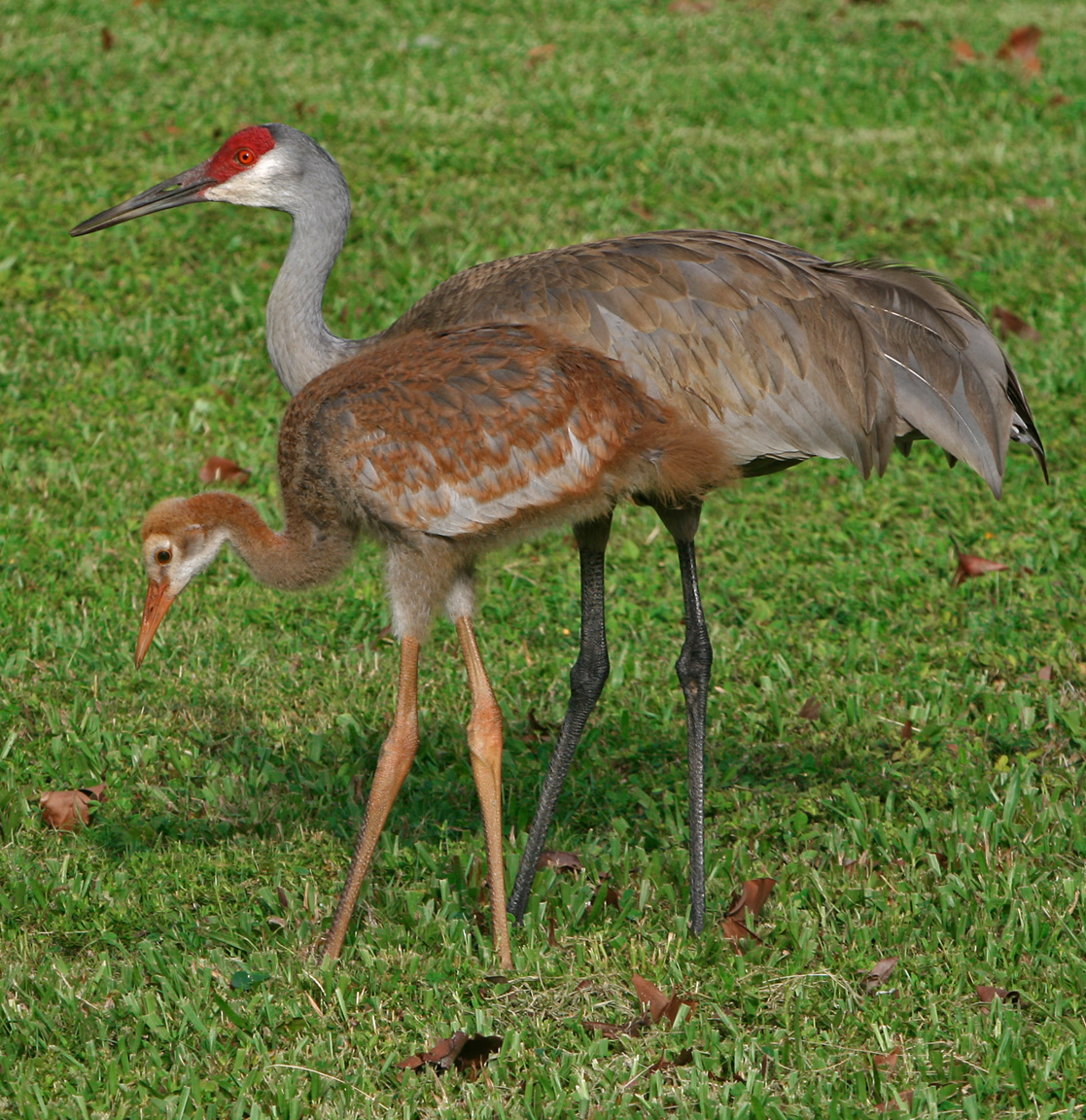
Wikipedia: Sandhill crane Source: OTHER
Grus_canadensis.jpg
![]() The sandhill crane (Antigone canadensis) is a species of large crane of North America and extreme northeastern Siberia. The common name of this bird refers to habitat like that at the Platte River, on the edge of Nebraska's Sandhills on the American Plains. This is the most important stopover area for the nominotypical subspecies, the lesser sandhill crane (Antigone canadensis canadensis), with up to 450,000 of these birds migrating through annually[citation needed].
[more]
The sandhill crane (Antigone canadensis) is a species of large crane of North America and extreme northeastern Siberia. The common name of this bird refers to habitat like that at the Platte River, on the edge of Nebraska's Sandhills on the American Plains. This is the most important stopover area for the nominotypical subspecies, the lesser sandhill crane (Antigone canadensis canadensis), with up to 450,000 of these birds migrating through annually[citation needed].
[more]
Limpkin / Rallenkranich (Aramus guarauna)

Wikipedia: Limpkin Source: OTHER
1200px-Limpkin%2C_Florida_05.jpg
![]() The limpkin (Aramus guarauna), also called carrao, courlan, and crying bird, is a large wading bird related to rails and cranes, and the only extant species in the genus Aramus and the family Aramidae. It is found mostly in wetlands in warm parts of the Americas, from Florida to northern Argentina. It feeds on molluscs, with the diet dominated by apple snails of the genus Pomacea. Its name derives from its seeming limp when it walks.[2]
[more]
The limpkin (Aramus guarauna), also called carrao, courlan, and crying bird, is a large wading bird related to rails and cranes, and the only extant species in the genus Aramus and the family Aramidae. It is found mostly in wetlands in warm parts of the Americas, from Florida to northern Argentina. It feeds on molluscs, with the diet dominated by apple snails of the genus Pomacea. Its name derives from its seeming limp when it walks.[2]
[more]
Profile Wikipedia eBird Audubon AllAboutBirds Xeno-Canto

Wikipedia: Short-tailed hawk Source: OTHER
Buteo_brachyurus_-Manduri%2C_Sao_Paulo%2C_Brazil_-flying-8.jpg
![]() The short-tailed hawk (Buteo brachyurus) is an American bird of prey in the family Accipitridae, which also includes the eagles and Old World vultures. As a member of the genus Buteo, it is not a true hawk and thus also referred to as a "buteo" or (outside North America) "buzzard". The white-throated hawk (B. albigula) is a close relative and was formerly included in the species B. brachyurus.
[more]
The short-tailed hawk (Buteo brachyurus) is an American bird of prey in the family Accipitridae, which also includes the eagles and Old World vultures. As a member of the genus Buteo, it is not a true hawk and thus also referred to as a "buteo" or (outside North America) "buzzard". The white-throated hawk (B. albigula) is a close relative and was formerly included in the species B. brachyurus.
[more]
Wikipedia: Broad-winged hawk Source: OTHER
Julie_Waters_broad_winged_hawk.JPG
![]() The broad-winged hawk (Buteo platypterus) is a medium-sized hawk of the genus Buteo. During the summer, some subspecies are distributed over eastern North America, as far west as British Columbia and Texas; they then migrate south to winter in the Neotropics from Mexico south to southern Brazil.[2] Other subspecies are all-year residents on Caribbean islands.[3] As in most raptors, females are slightly larger than males. Broad-winged hawks' wings are relatively short and broad with a tapered, somewhat pointed appearance. The two types of coloration are a dark morph with fewer white areas and a light morph that is more pale overall. Although the broad-winged hawk's numbers are relatively stable, populations are declining in some parts of its breeding range because of forest fragmentation.
[more]
The broad-winged hawk (Buteo platypterus) is a medium-sized hawk of the genus Buteo. During the summer, some subspecies are distributed over eastern North America, as far west as British Columbia and Texas; they then migrate south to winter in the Neotropics from Mexico south to southern Brazil.[2] Other subspecies are all-year residents on Caribbean islands.[3] As in most raptors, females are slightly larger than males. Broad-winged hawks' wings are relatively short and broad with a tapered, somewhat pointed appearance. The two types of coloration are a dark morph with fewer white areas and a light morph that is more pale overall. Although the broad-winged hawk's numbers are relatively stable, populations are declining in some parts of its breeding range because of forest fragmentation.
[more]
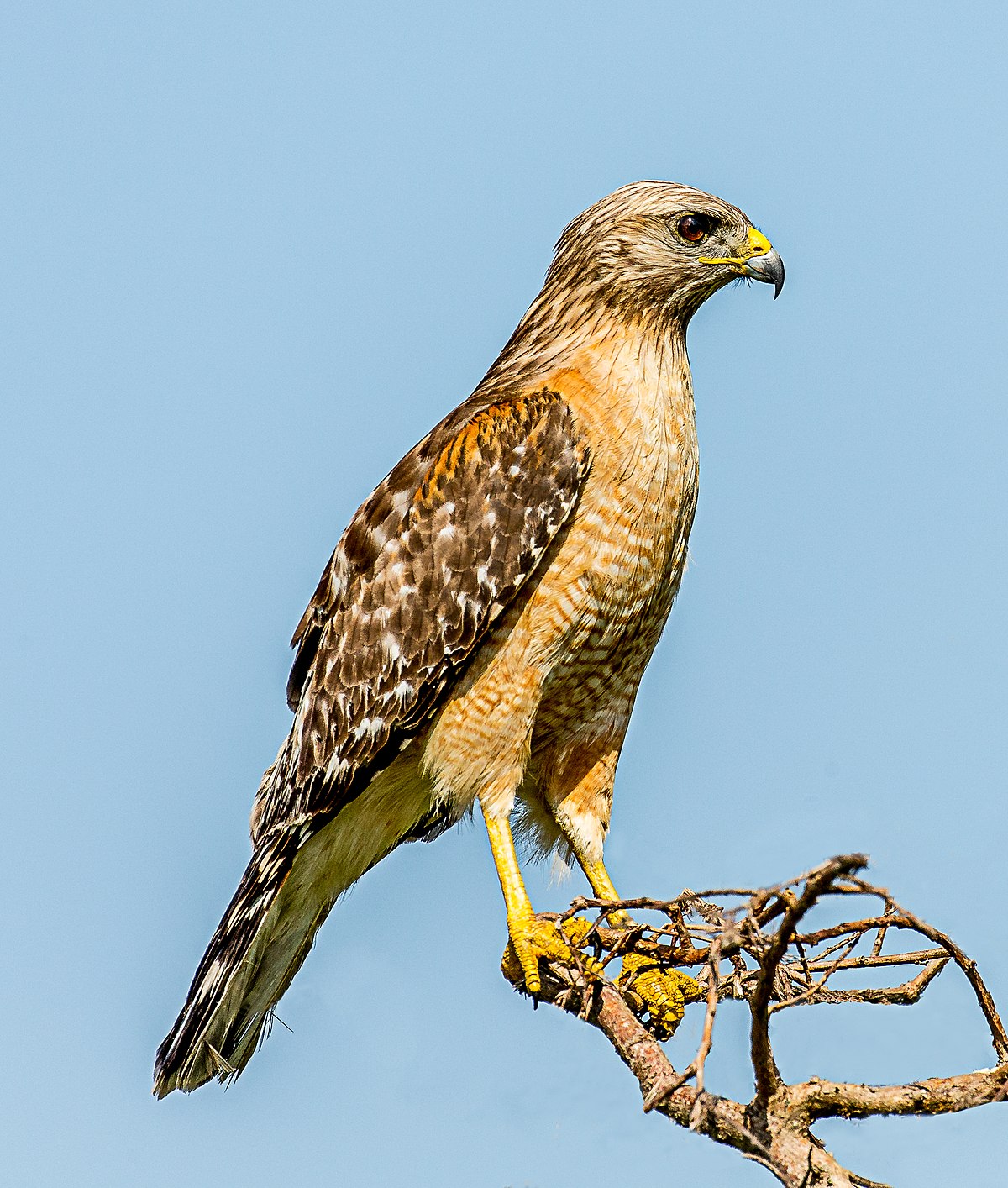
Wikipedia: Red-shouldered hawk Source: OTHER
1200px-Red-shouldered_Hawk_%28Buteo_lineatus%29_-_Blue_Cypress_Lake%2C_Florida.jpg
![]() The red-shouldered hawk (Buteo lineatus) is a medium-sized hawk. Its breeding range spans eastern North America and along the coast of California and northern to northeastern-central Mexico. It is a permanent resident throughout most of its range, though northern birds do migrate, mostly to central Mexico. The main conservation threat to the widespread species is deforestation.
[more]
The red-shouldered hawk (Buteo lineatus) is a medium-sized hawk. Its breeding range spans eastern North America and along the coast of California and northern to northeastern-central Mexico. It is a permanent resident throughout most of its range, though northern birds do migrate, mostly to central Mexico. The main conservation threat to the widespread species is deforestation.
[more]
Red-tailed hawk at Cromwell. 2022-04-29 12.30.10 Maryland
First observed in Maryland on 2022-04-29.
![]() The red-tailed hawk (Buteo jamaicensis) is a bird of prey that breeds throughout most of North America, from the interior of Alaska and northern Canada to as far south as Panama and the West Indies. It is one of the most common members within the genus of Buteo in North America or worldwide.[2] The red-tailed hawk is one of three species colloquially known in the United States as the "chickenhawk", though it rarely preys on standard-sized chickens.[3] The bird is sometimes also referred to as the red-tail for short, when the meaning is clear in context. Red-tailed hawks can acclimate to all the biomes within their range, occurring on the edges of non-ideal habitats such as dense forests and sandy deserts.[4] The red-tailed hawk occupies a wide range of habitats and altitudes including deserts, grasslands, coniferous and deciduous forests, agricultural fields and urban areas. Its latitudinal limits fall around the tree line in the Arctic and the species is absent from the high Arctic. It is legally protected in Canada, Mexico, and the United States by the Migratory Bird Treaty Act.
[more]
The red-tailed hawk (Buteo jamaicensis) is a bird of prey that breeds throughout most of North America, from the interior of Alaska and northern Canada to as far south as Panama and the West Indies. It is one of the most common members within the genus of Buteo in North America or worldwide.[2] The red-tailed hawk is one of three species colloquially known in the United States as the "chickenhawk", though it rarely preys on standard-sized chickens.[3] The bird is sometimes also referred to as the red-tail for short, when the meaning is clear in context. Red-tailed hawks can acclimate to all the biomes within their range, occurring on the edges of non-ideal habitats such as dense forests and sandy deserts.[4] The red-tailed hawk occupies a wide range of habitats and altitudes including deserts, grasslands, coniferous and deciduous forests, agricultural fields and urban areas. Its latitudinal limits fall around the tree line in the Arctic and the species is absent from the high Arctic. It is legally protected in Canada, Mexico, and the United States by the Migratory Bird Treaty Act.
[more]

Wikipedia: Swainson's hawk Source: OTHER
1200px-Swainson%27s_Hawk_%28Buteo_swainsoni%29_RWD.jpg
![]() Swainson's hawk (Buteo swainsoni) is a large birds species in the Accipitriformes order. This species was named after William Swainson, a British naturalist. It is colloquially known as the grasshopper hawk or locust hawk, as it is very fond of Acrididae (locusts and grasshoppers) and will voraciously eat these insects whenever they are available.
[more]
Swainson's hawk (Buteo swainsoni) is a large birds species in the Accipitriformes order. This species was named after William Swainson, a British naturalist. It is colloquially known as the grasshopper hawk or locust hawk, as it is very fond of Acrididae (locusts and grasshoppers) and will voraciously eat these insects whenever they are available.
[more]
Coopers hawk. 2022-05-07 14.20.04 Maryland
First observed in Maryland on 2022-05-07.
![]() Cooper's hawk (Accipiter cooperii) is a medium-sized hawk native to the North American continent and found from southern Canada to Mexico.[2] This species is a member of the genus Accipiter, sometimes referred to as true hawks, which are famously agile, relatively small hawks common to wooded habitats around the world and also the most diverse of all diurnal raptor genera.[2] As in many birds of prey, the male is smaller than the female.[3] The birds found east of the Mississippi River tend to be larger on average than the birds found to the west.[4] It is easily confused with the smaller but similar Sharp-shinned hawk.
[more]
Cooper's hawk (Accipiter cooperii) is a medium-sized hawk native to the North American continent and found from southern Canada to Mexico.[2] This species is a member of the genus Accipiter, sometimes referred to as true hawks, which are famously agile, relatively small hawks common to wooded habitats around the world and also the most diverse of all diurnal raptor genera.[2] As in many birds of prey, the male is smaller than the female.[3] The birds found east of the Mississippi River tend to be larger on average than the birds found to the west.[4] It is easily confused with the smaller but similar Sharp-shinned hawk.
[more]
Profile Wikipedia eBird A-Z Animals Audubon AllAboutBirds Xeno-Canto

Wikipedia: Sharp-shinned hawk Source: OTHER
1200px-Accipiter_striatus%2C_Canet_Road%2C_San_Luis_Obispo_1.jpg
![]() A. s. chionogaster
A. s. chionogaster
A. s. erythronemius
A. s. fringilloides
A. s. madrensis
A. s. perobscurus
A. s. striatus
A. s. suttoni
A. s. velox
A. s. venator
A. s. ventralis
[more]
Profile Wikipedia eBird A-Z Animals Audubon AllAboutBirds Xeno-Canto
Bald eagle. 2023-10-13 13.35.52 New England
First observed in New England on 2023-10-13.
![]() The bald eagle (Haliaeetus leucocephalus) is a bird of prey found in North America. A sea eagle, it has two known subspecies and forms a species pair with the white-tailed eagle (Haliaeetus albicilla). Its range includes most of Canada and Alaska, all of the contiguous United States, and northern Mexico. It is found near large bodies of open water with an abundant food supply and old-growth trees for nesting.
[more]
The bald eagle (Haliaeetus leucocephalus) is a bird of prey found in North America. A sea eagle, it has two known subspecies and forms a species pair with the white-tailed eagle (Haliaeetus albicilla). Its range includes most of Canada and Alaska, all of the contiguous United States, and northern Mexico. It is found near large bodies of open water with an abundant food supply and old-growth trees for nesting.
[more]
Profile Wikipedia eBird Audubon AllAboutBirds Xeno-Canto

Wikipedia: Snail kite Source: OTHER
1200px-Schneckenweih-Snail-Kite.JPG
![]() The snail kite (Rostrhamus sociabilis) is a bird of prey within the family Accipitridae, which also includes the eagles, hawks, and Old World vultures. Its relative, the slender-billed kite, is now again placed in Helicolestes, making the genus Rostrhamus monotypic. Usually, it is placed in the milvine kites, but the validity of that group is under investigation.
[more]
The snail kite (Rostrhamus sociabilis) is a bird of prey within the family Accipitridae, which also includes the eagles, hawks, and Old World vultures. Its relative, the slender-billed kite, is now again placed in Helicolestes, making the genus Rostrhamus monotypic. Usually, it is placed in the milvine kites, but the validity of that group is under investigation.
[more]
Profile Wikipedia eBird Audubon AllAboutBirds Xeno-Canto

Wikipedia: Swallow-tailed kite Source: OTHER
1200px-Swallow-tailed_Kite_%2834163638494%29.jpg
![]() The swallow-tailed kite (Elanoides forficatus) is a pernine raptor which breeds from the southeastern United States to eastern Peru and northern Argentina. It is the only species in the genus Elanoides. Most North and Central American breeders winter in South America where the species is resident year round.
[more]
The swallow-tailed kite (Elanoides forficatus) is a pernine raptor which breeds from the southeastern United States to eastern Peru and northern Argentina. It is the only species in the genus Elanoides. Most North and Central American breeders winter in South America where the species is resident year round.
[more]
Profile Wikipedia eBird Audubon AllAboutBirds Xeno-Canto

Wikipedia: White-tailed kite Source: OTHER
1200px-Elanus_leucurus_3.jpg
![]() The white-tailed kite (Elanus leucurus) is a small raptor found in western North America and parts of South America.
[more]
The white-tailed kite (Elanus leucurus) is a small raptor found in western North America and parts of South America.
[more]
Profile Wikipedia eBird A-Z Animals Audubon AllAboutBirds Xeno-Canto

Wikipedia: Mississippi kite Source: OTHER
Mississippi_Kite.jpg
![]() The Mississippi kite (Ictinia mississippiensis) is a small bird of prey in the family Accipitridae. Mississippi kites have narrow, pointed wings and are graceful in flight, often appearing to float in the air. It is not uncommon to see several circling in the same area.
[more]
The Mississippi kite (Ictinia mississippiensis) is a small bird of prey in the family Accipitridae. Mississippi kites have narrow, pointed wings and are graceful in flight, often appearing to float in the air. It is not uncommon to see several circling in the same area.
[more]
Turkey vulture / Truthahngeier (Cathartes aura)
Turkey vulture. 2022-04-29 11.39.28 Maryland
First observed in Costa Rica on 2018-02-28.
![]() The turkey vulture (Cathartes aura), also known in some North American regions as the turkey buzzard (or just buzzard), and in some areas of the Caribbean as the John crow or carrion crow,[2] is the most widespread of the New World vultures.[3] One of three species in the genus Cathartes of the family Cathartidae, the turkey vulture ranges from southern Canada to the southernmost tip of South America. It inhabits a variety of open and semi-open areas, including subtropical forests, shrublands, pastures, and deserts.[1]
[more]
The turkey vulture (Cathartes aura), also known in some North American regions as the turkey buzzard (or just buzzard), and in some areas of the Caribbean as the John crow or carrion crow,[2] is the most widespread of the New World vultures.[3] One of three species in the genus Cathartes of the family Cathartidae, the turkey vulture ranges from southern Canada to the southernmost tip of South America. It inhabits a variety of open and semi-open areas, including subtropical forests, shrublands, pastures, and deserts.[1]
[more]
Black vulture / Rabengeier (Coragyps atratus)
Black vulture at cenote xxx. 2023-04-14 13.13.52 Yucatan
First observed in Yucatan on 2023-04-14.
![]() The black vulture (Coragyps atratus), also known as the American black vulture, is a bird in the New World vulture family whose range extends from the northeastern United States to Peru, Central Chile and Uruguay in South America. Although a common and widespread species, it has a somewhat more restricted distribution than its compatriot, the turkey vulture, which breeds well into Canada and south to Tierra del Fuego. It is the only extant member of the genus Coragyps, which is in the family Cathartidae. Despite the similar name and appearance, this species is unrelated to the Eurasian black vulture, an Old World vulture in the family Accipitridae (which includes eagles, hawks, kites, and harriers). It inhabits relatively open areas which provide scattered forests or shrublands. With a wingspan of 1.5 m (4.9 ft), the black vulture is a large bird though relatively small for a vulture. It has black plumage, a featherless, grayish-black head and neck, and a short, hooked beak.
[more]
The black vulture (Coragyps atratus), also known as the American black vulture, is a bird in the New World vulture family whose range extends from the northeastern United States to Peru, Central Chile and Uruguay in South America. Although a common and widespread species, it has a somewhat more restricted distribution than its compatriot, the turkey vulture, which breeds well into Canada and south to Tierra del Fuego. It is the only extant member of the genus Coragyps, which is in the family Cathartidae. Despite the similar name and appearance, this species is unrelated to the Eurasian black vulture, an Old World vulture in the family Accipitridae (which includes eagles, hawks, kites, and harriers). It inhabits relatively open areas which provide scattered forests or shrublands. With a wingspan of 1.5 m (4.9 ft), the black vulture is a large bird though relatively small for a vulture. It has black plumage, a featherless, grayish-black head and neck, and a short, hooked beak.
[more]
Osprey / Fischadler (Pandion haliaetus)
Osprey in flight. 2023-09-27 12.22.08 Florida
First observed in Yucatan on 2023-04-21.
This bird appears across the great seas in the following continents:
Europe, North America, South America, Africa, Asia.
![]() Falco haliaetus Linnaeus, 1758
[more]
Falco haliaetus Linnaeus, 1758
[more]
Calls: ![]() Calls with sequences of short, soft and clear whistling notes. Often in series with rising pitch, then ending with a few lower pitched notes. [Link]
Calls with sequences of short, soft and clear whistling notes. Often in series with rising pitch, then ending with a few lower pitched notes. [Link]
Physical details: length=55-58 cm,
wingspan=145-170 cm,
weight=1120-2050 g
Habitats:
Agricultural
Call:
Automatically generated from Xeno-Canto recording
♫ 2023-10-12 15 55 surprising sound of an osprey. 2023-10-12 15.55.00 New England (song?)
Profile Wikipedia eBird Audubon AllAboutBirds Xeno-Canto

Wikipedia: Wood stork Source: OTHER
1200px-Wood_stork_%28Mycteria_americana%29_and_Yacare_caiman.jpg
General: ![]() The wood stork (Mycteria americana) is a large American wading bird in the family Ciconiidae (storks). It was formerly called the "wood ibis", though it is not an ibis. It is found in subtropical and tropical habitats in the Americas, including the Caribbean. In South America, it is resident, but in North America, it may disperse as far as Florida. Originally described by Carl Linnaeus in 1758, this stork likely evolved in tropical regions. The head and neck are bare of feathers, and dark grey in colour.[2] The plumage is mostly white, with the exception of the tail and some of the wing feathers, which are black with a greenish-purplish sheen. The juvenile differs from the adult, with the former having a feathered head and a yellow bill, compared to the black adult bill. There is little sexual dimorphism.
[more]
The wood stork (Mycteria americana) is a large American wading bird in the family Ciconiidae (storks). It was formerly called the "wood ibis", though it is not an ibis. It is found in subtropical and tropical habitats in the Americas, including the Caribbean. In South America, it is resident, but in North America, it may disperse as far as Florida. Originally described by Carl Linnaeus in 1758, this stork likely evolved in tropical regions. The head and neck are bare of feathers, and dark grey in colour.[2] The plumage is mostly white, with the exception of the tail and some of the wing feathers, which are black with a greenish-purplish sheen. The juvenile differs from the adult, with the former having a feathered head and a yellow bill, compared to the black adult bill. There is little sexual dimorphism.
[more]
Rock doves aka common pigeons on the move. 2023-06-19 07.39.10 Bolle di Magadino
First observed in 🇨🇭 on 2023-06-19.
This bird appears across the great seas in the following continents:
Europe, North America, South America, Africa, Asia.
![]() The rock dove, rock pigeon, or common pigeon (/ˈpɪdʒ.ən/ also /ˈpɪdʒ.ɪn/; Columba livia) is a member of the bird family Columbidae (doves and pigeons).[3]:624 In common usage, this bird is often simply referred to as the "pigeon".
[more]
The rock dove, rock pigeon, or common pigeon (/ˈpɪdʒ.ən/ also /ˈpɪdʒ.ɪn/; Columba livia) is a member of the bird family Columbidae (doves and pigeons).[3]:624 In common usage, this bird is often simply referred to as the "pigeon".
[more]
Vocalization: ![]() Not loud. [Link]
Not loud. [Link]
Song: ![]() Song a two-syllable, but continuous cooing. First a rolling ascending "orrrrrr" immediately followed by a short descending "oohh". Wings produce a quite audible whistling sound. [Link]
Song a two-syllable, but continuous cooing. First a rolling ascending "orrrrrr" immediately followed by a short descending "oohh". Wings produce a quite audible whistling sound. [Link]
Physical details: length=31-34 cm,
wingspan=63-70 cm,
weight=230-370 g
Habitats:
Settlement
Didn't recognize this collared dove ...so I annotated it with the characteristics I should have recognized 2021-02-01 13.14.42 Luppmen
First observed in 🇨🇭 on 2020-05-21.
This bird appears across the great seas in the following continents:
Europe, North America (introduced), Africa, Asia (introduced).
General: ![]() The Eurasian collared dove (Streptopelia decaocto) is a dove species native to Europe and Asia; it was introduced to Japan, North America and islands in the Caribbean. Because of its vast global range and increasing population trend, it has been listed as Least Concern on the IUCN Red List since 2014.[1]
[more]
The Eurasian collared dove (Streptopelia decaocto) is a dove species native to Europe and Asia; it was introduced to Japan, North America and islands in the Caribbean. Because of its vast global range and increasing population trend, it has been listed as Least Concern on the IUCN Red List since 2014.[1]
[more]
Song: ![]() Gu-guh-gu, klingt wie „ Gross-mue-ti“ Dazu auch „chräi“ oder „chwii“
[Link]
Gu-guh-gu, klingt wie „ Gross-mue-ti“ Dazu auch „chräi“ oder „chwii“
[Link]
![]() Song a characteristic, rhythmic cooing, consisting of three syllables with emphasis on the second. The third lower pitched than the rest. Can be rendered as "su-do-ku" (or "deca-oc-to", latin name derived from song). [Link]
Song a characteristic, rhythmic cooing, consisting of three syllables with emphasis on the second. The third lower pitched than the rest. Can be rendered as "su-do-ku" (or "deca-oc-to", latin name derived from song). [Link]
Calls: ![]() Excitement-call a nasal "wrrraa". [Link]
Excitement-call a nasal "wrrraa". [Link]
Physical details: length=31-33 cm,
wingspan=47-55 cm,
weight=170-240 g
Habitats:
Settlement
Call:
Automatically generated from Xeno-Canto recording
♫ Türkentaube. 2020-05-21 07.45.50 Luppmen (song?)
Profile Wikipedia eBird Audubon AllAboutBirds Xeno-Canto
White-winged dove - note the blue ring around the red eye. 2023-04-21 16.19.40 Yucatan
First observed in Yucatan on 2023-04-07.
General: ![]() The white-winged dove (Zenaida asiatica) is a dove whose native range extends from the Southwestern United States through Mexico, Central America, and the Caribbean. They are large for doves, and can be distinguished from similar doves by the distinctive white edge on their wings. They have a blue eyering, and red eyes. The plumage is brownish-gray to gray. Juveniles are duller in color, and have brown eyes. The call is likened to English phrase "who cooks for you". There are three subspecies. It was first described by George Edwards in 1743, and given its binomial name by Linnaeus in 1756. It was moved into the genus Zenaida in 1838.
[more]
The white-winged dove (Zenaida asiatica) is a dove whose native range extends from the Southwestern United States through Mexico, Central America, and the Caribbean. They are large for doves, and can be distinguished from similar doves by the distinctive white edge on their wings. They have a blue eyering, and red eyes. The plumage is brownish-gray to gray. Juveniles are duller in color, and have brown eyes. The call is likened to English phrase "who cooks for you". There are three subspecies. It was first described by George Edwards in 1743, and given its binomial name by Linnaeus in 1756. It was moved into the genus Zenaida in 1838.
[more]
Profile Wikipedia eBird A-Z Animals Audubon AllAboutBirds Xeno-Canto
Mourning dove. 2022-05-08 09.50.44 Maryland
First observed in Cockeysville on 2021-06-15.
![]() The mourning dove (Zenaida macroura) is a member of the dove family, Columbidae. The bird is also known as the American mourning dove, the rain dove, and colloquially as the turtle dove, and was once known as the Carolina pigeon and Carolina turtledove.[2] It is one of the most abundant and widespread of all North American birds. It is also a leading gamebird, with more than 20 million birds (up to 70 million in some years) shot annually in the U.S., both for sport and for meat. Its ability to sustain its population under such pressure is due to its prolific breeding; in warm areas, one pair may raise up to six broods of two young each in a single year. The wings make an unusual whistling sound upon take-off and landing, a form of sonation. The bird is a strong flier, capable of speeds up to 88 km/h (55 mph).[3] It is the national bird of the British Virgin Islands.
[more]
The mourning dove (Zenaida macroura) is a member of the dove family, Columbidae. The bird is also known as the American mourning dove, the rain dove, and colloquially as the turtle dove, and was once known as the Carolina pigeon and Carolina turtledove.[2] It is one of the most abundant and widespread of all North American birds. It is also a leading gamebird, with more than 20 million birds (up to 70 million in some years) shot annually in the U.S., both for sport and for meat. Its ability to sustain its population under such pressure is due to its prolific breeding; in warm areas, one pair may raise up to six broods of two young each in a single year. The wings make an unusual whistling sound upon take-off and landing, a form of sonation. The bird is a strong flier, capable of speeds up to 88 km/h (55 mph).[3] It is the national bird of the British Virgin Islands.
[more]
Call:
Automatically generated from Xeno-Canto recording
♫ Source: BirdNet
20210615_185824 birdnet 1663 - Mourning Dove, at the trail - Mourning Dove - Cockeysville.mp3
2021-06-15 18.58.24 Cockeysville (song?)

Wikipedia: Common ground-dove Source: OTHER
Columbina_passerina_-near_Salton_Sea%2C_California%2C_USA-8.jpg
![]() The common ground dove (Columbina passerina) is a small bird that inhabits the southern United States, parts of Central America, the Caribbean and northern South America. It is considered to be the smallest dove that inhabits the United States. As its name suggests, the bird spends the majority of its time on the ground walking but still has the ability to fly.
[more]
The common ground dove (Columbina passerina) is a small bird that inhabits the southern United States, parts of Central America, the Caribbean and northern South America. It is considered to be the smallest dove that inhabits the United States. As its name suggests, the bird spends the majority of its time on the ground walking but still has the ability to fly.
[more]

Wikipedia: White-crowned pigeon Source: OTHER
1200px-White-crowned_Pigeon_%28Patagioenas_leucocephala%29.jpg
![]() The white-crowned pigeon (Patagioenas leucocephala) is a fruit and seed-eating species of bird in the dove and pigeon family Columbidae. It is found primarily in the Caribbean.
[more]
The white-crowned pigeon (Patagioenas leucocephala) is a fruit and seed-eating species of bird in the dove and pigeon family Columbidae. It is found primarily in the Caribbean.
[more]

Wikipedia: Belted kingfisher Source: OTHER
1200px-Belted_Kingfisher.jpg
![]() The belted kingfisher (Megaceryle alcyon) is a large, conspicuous water kingfisher. It is depicted on the 1986 series Canadian $5 note. All kingfishers were formerly placed in one family, Alcedinidae, but recent research suggests that this should be divided into three subfamilies.
[more]
The belted kingfisher (Megaceryle alcyon) is a large, conspicuous water kingfisher. It is depicted on the 1986 series Canadian $5 note. All kingfishers were formerly placed in one family, Alcedinidae, but recent research suggests that this should be divided into three subfamilies.
[more]
Profile Wikipedia eBird Audubon AllAboutBirds Xeno-Canto
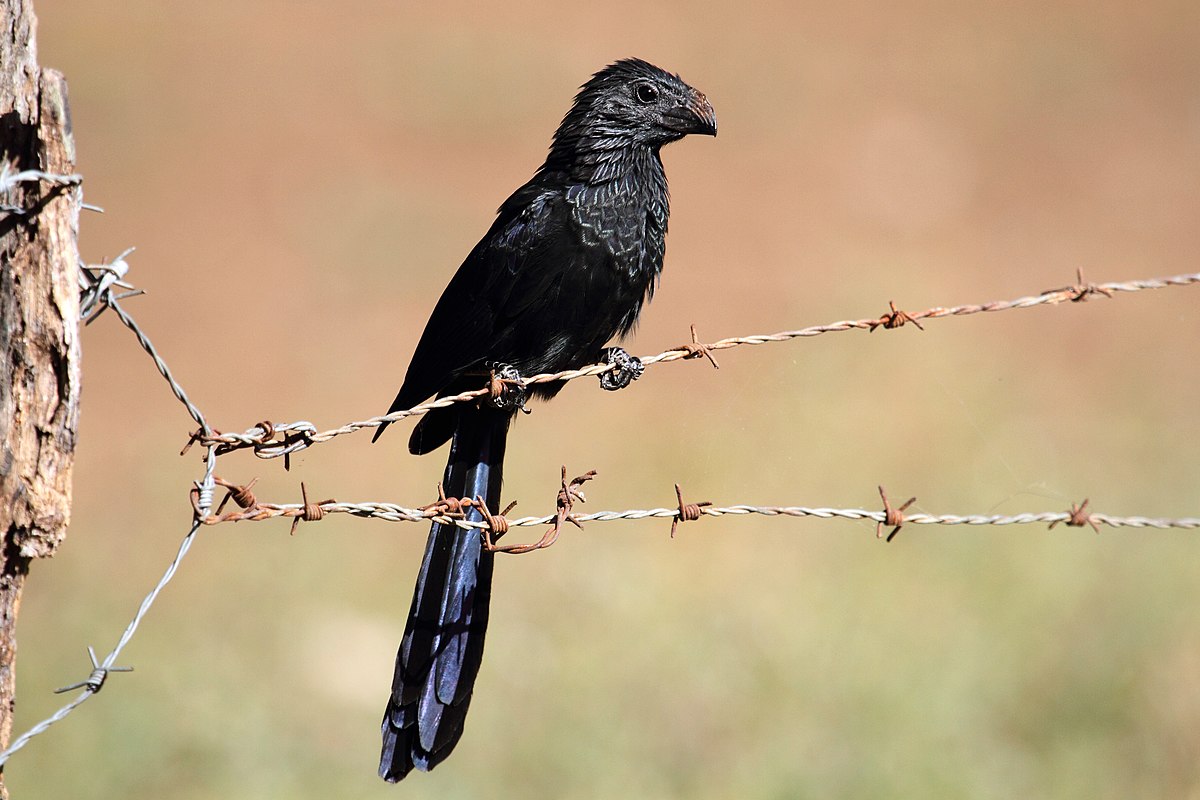
Wikipedia: Groove-billed ani Source: OTHER
1200px-Crotophaga_sulcirostris_CR_bis.JPG
![]() The groove-billed ani (Crotophaga sulcirostris) is a tropical bird in the cuckoo family with a long tail and a large, curved beak. It is a resident species throughout most of its range, from southern Texas, central Mexico and The Bahamas, through Central America, to northern Colombia and Venezuela, and coastal Ecuador and Peru. It only retreats from the northern limits of its range in Texas and northern Mexico during winter.
[more]
The groove-billed ani (Crotophaga sulcirostris) is a tropical bird in the cuckoo family with a long tail and a large, curved beak. It is a resident species throughout most of its range, from southern Texas, central Mexico and The Bahamas, through Central America, to northern Colombia and Venezuela, and coastal Ecuador and Peru. It only retreats from the northern limits of its range in Texas and northern Mexico during winter.
[more]
Profile Wikipedia eBird Audubon AllAboutBirds Xeno-Canto
Smooth-billed ani. 2023-04-16 06.25.20 Yucatan
First observed in Yucatan on 2023-04-16.
![]() The smooth-billed ani (Crotophaga ani) is a large near passerine bird in the cuckoo family. It is a resident breeding species from southern Florida, the Caribbean, parts of Central America, south to western Ecuador, Brazil, northern Argentina and southern Chile.[2] It was introduced to Galápagos around the 1960s and is potentially impacting native and endemic species across the archipelago.[3]
[more]
The smooth-billed ani (Crotophaga ani) is a large near passerine bird in the cuckoo family. It is a resident breeding species from southern Florida, the Caribbean, parts of Central America, south to western Ecuador, Brazil, northern Argentina and southern Chile.[2] It was introduced to Galápagos around the 1960s and is potentially impacting native and endemic species across the archipelago.[3]
[more]
![]() Der Schwarzschnabelkuckuck (Coccyzus erythropthalmus) ist eine Art aus der Familie der Kuckucksvögel, die ausschließlich in der neuen Welt vorkommt. Er brütet ausschließlich im Nordosten Nordamerikas, überwintert aber während des Winterhalbjahres in Südamerika. Während seines Zuges im Herbst und Frühjahr ist er auch in Zentralamerika, in Mexiko und dem Süden der Vereinigten Staaten zu beobachten. Der sehr heimlich lebende Schwarzschnabelkuckuck ist ein mittelgroßer, schlanker und langschwänziger Kuckuck, der sich überwiegend versteckt im Blattwerk aufhält.
[more]
Der Schwarzschnabelkuckuck (Coccyzus erythropthalmus) ist eine Art aus der Familie der Kuckucksvögel, die ausschließlich in der neuen Welt vorkommt. Er brütet ausschließlich im Nordosten Nordamerikas, überwintert aber während des Winterhalbjahres in Südamerika. Während seines Zuges im Herbst und Frühjahr ist er auch in Zentralamerika, in Mexiko und dem Süden der Vereinigten Staaten zu beobachten. Der sehr heimlich lebende Schwarzschnabelkuckuck ist ein mittelgroßer, schlanker und langschwänziger Kuckuck, der sich überwiegend versteckt im Blattwerk aufhält.
[more]
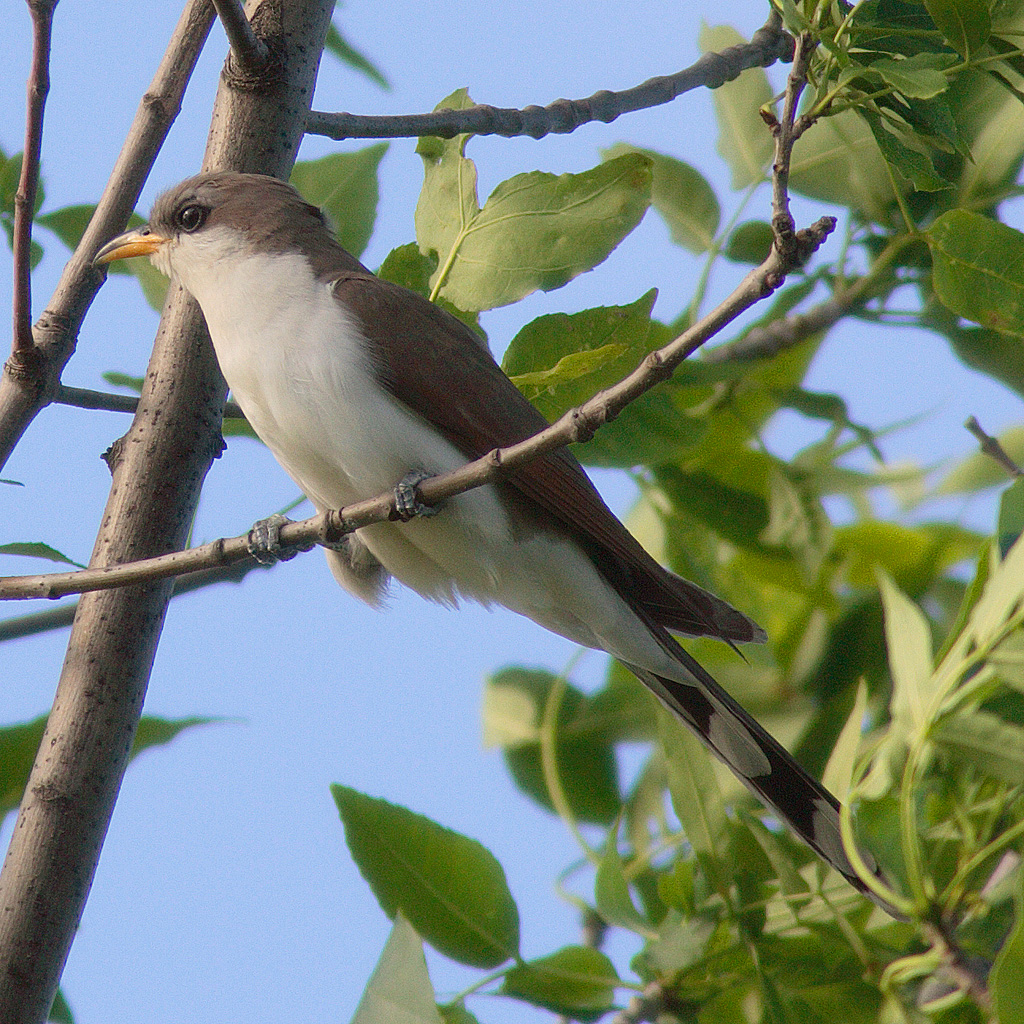
Wikipedia: Yellow-billed cuckoo Source: OTHER
Coccyzus-americanus-001.jpg
![]() The yellow-billed cuckoo (Coccyzus americanus) is a cuckoo. Common folk-names for this bird in the southern United States are rain crow and storm crow. These likely refer to the bird's habit of calling on hot days, often presaging rain or thunderstorms.
[more]
The yellow-billed cuckoo (Coccyzus americanus) is a cuckoo. Common folk-names for this bird in the southern United States are rain crow and storm crow. These likely refer to the bird's habit of calling on hot days, often presaging rain or thunderstorms.
[more]
Profile Wikipedia eBird Audubon AllAboutBirds Xeno-Canto

Wikipedia: Mangrove cuckoo Source: OTHER
1200px-Mangrove_Cuckoo.jpg
![]() The mangrove cuckoo (Coccyzus minor) is a species of cuckoo that is native to the Neotropics.
[more]
The mangrove cuckoo (Coccyzus minor) is a species of cuckoo that is native to the Neotropics.
[more]
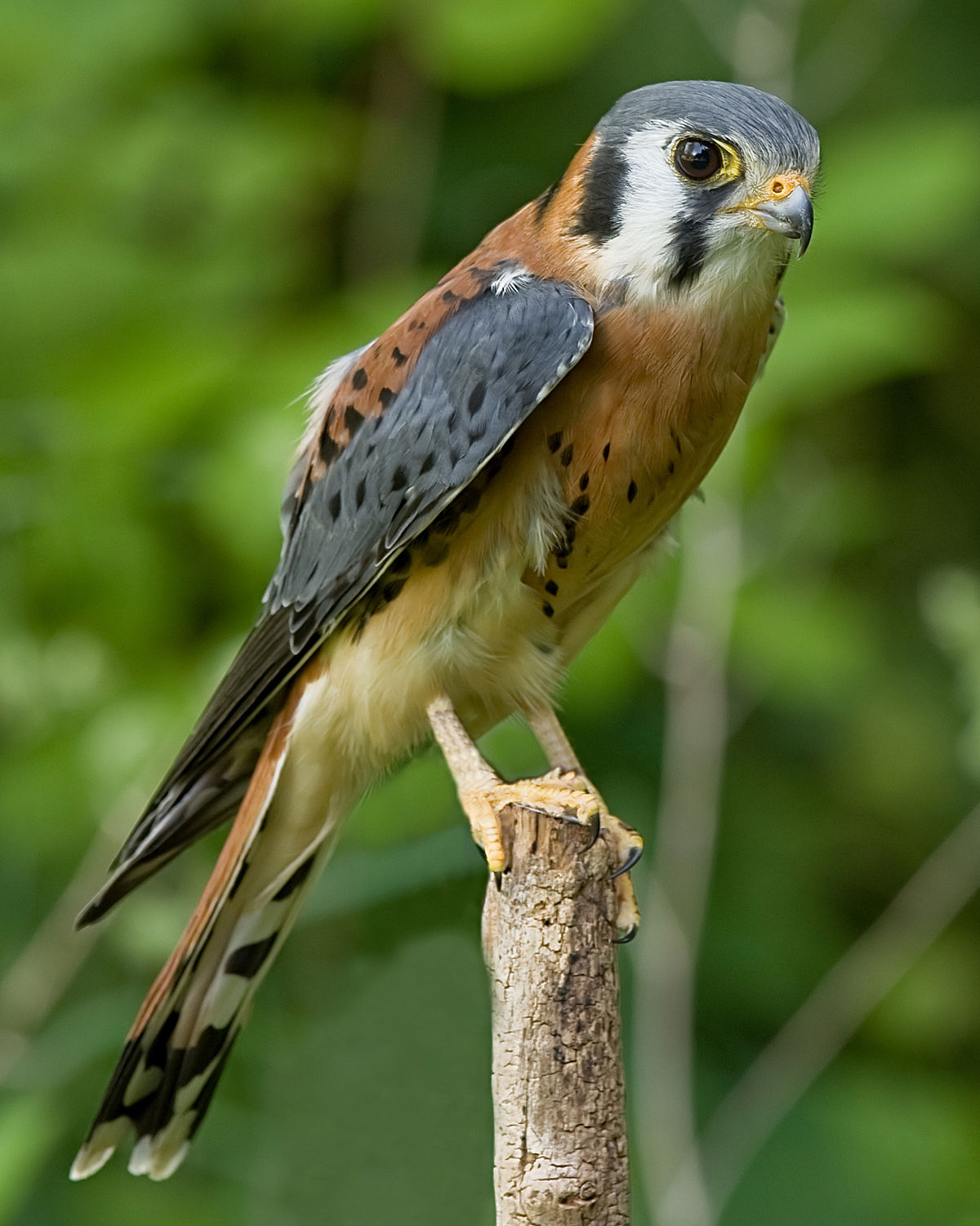
Wikipedia: American kestrel Source: OTHER
1200px-AmericanKestrel02.jpg
![]() The American kestrel (Falco sparverius), also called the sparrow hawk, is the smallest and most common falcon in North America. It has a roughly two-to-one range in size over subspecies and sex, varying in size from about the weight of a blue jay to a mourning dove. It also ranges to South America and is a well-established species that has evolved into 17 subspecies adapted to different environments and habitats throughout the Americas. It exhibits sexual dimorphism in size (females being moderately larger) and plumage, although both sexes have a rufous back with noticeable barring. Its plumage is colorful and attractive, and juveniles are similar in plumage to adults.
[more]
The American kestrel (Falco sparverius), also called the sparrow hawk, is the smallest and most common falcon in North America. It has a roughly two-to-one range in size over subspecies and sex, varying in size from about the weight of a blue jay to a mourning dove. It also ranges to South America and is a well-established species that has evolved into 17 subspecies adapted to different environments and habitats throughout the Americas. It exhibits sexual dimorphism in size (females being moderately larger) and plumage, although both sexes have a rufous back with noticeable barring. Its plumage is colorful and attractive, and juveniles are similar in plumage to adults.
[more]

Wikipedia: Crested caracara Source: OTHER
1200px-Schopfkarakara.jpg
![]() The crested caracara (Caracara plancus), is a bird of prey in the family Falconidae. As presently defined, the crested caracara is found in South America, the southern United States, including Florida, where it has been seen on the East coast as far as extreme eastern Seminole County, Florida (Lake Harney), where it is now considered a resident but listed as threatened. There have been reports of the crested caracara as far north as San Francisco, California.[2] and, in 2012, near Crescent City, California.[3] Some are believed to possibly be living in Nova Scotia, with numerous sightings throughout the 2010s.[4] In July 2016 a northern caracara was reported and photographed by numerous people in the upper peninsula of Michigan, just outside of Munising.[5][6][7] In June 2017, a northern caracara was sighted far north in St. George, New Brunswick, Canada.[8] A specimen was photographed in Woodstock, Vermont in March 2020.[citation needed] The species has recently become more common in central and north Texas and is generally common in south Texas and south of the US border.[citation needed] It can also be found (nesting) in the Southern Caribbean (e.g. Aruba, Curaçao and Bonaire)[citation needed], Mexico, and Central America. It was formerly placed in the genus Polyborus.
[more]
The crested caracara (Caracara plancus), is a bird of prey in the family Falconidae. As presently defined, the crested caracara is found in South America, the southern United States, including Florida, where it has been seen on the East coast as far as extreme eastern Seminole County, Florida (Lake Harney), where it is now considered a resident but listed as threatened. There have been reports of the crested caracara as far north as San Francisco, California.[2] and, in 2012, near Crescent City, California.[3] Some are believed to possibly be living in Nova Scotia, with numerous sightings throughout the 2010s.[4] In July 2016 a northern caracara was reported and photographed by numerous people in the upper peninsula of Michigan, just outside of Munising.[5][6][7] In June 2017, a northern caracara was sighted far north in St. George, New Brunswick, Canada.[8] A specimen was photographed in Woodstock, Vermont in March 2020.[citation needed] The species has recently become more common in central and north Texas and is generally common in south Texas and south of the US border.[citation needed] It can also be found (nesting) in the Southern Caribbean (e.g. Aruba, Curaçao and Bonaire)[citation needed], Mexico, and Central America. It was formerly placed in the genus Polyborus.
[more]
Our first caribbean flamingos at Las Colorados - closeup. 2023-04-15 09.33.10 Yucatan
First observed in Yucatan on 2023-04-15.
![]() The American flamingo (Phoenicopterus ruber) is a large species of flamingo closely related to the greater flamingo and Chilean flamingo native to the Neotropics. It was formerly considered conspecific with the greater flamingo, but that treatment is now widely viewed (e.g. by the American and British Ornithologists' Unions) as incorrect due to a lack of evidence. It is also known as the Caribbean flamingo, although it is also present in the Galápagos Islands. It is the only flamingo that naturally inhabits North America.
[more]
The American flamingo (Phoenicopterus ruber) is a large species of flamingo closely related to the greater flamingo and Chilean flamingo native to the Neotropics. It was formerly considered conspecific with the greater flamingo, but that treatment is now widely viewed (e.g. by the American and British Ornithologists' Unions) as incorrect due to a lack of evidence. It is also known as the Caribbean flamingo, although it is also present in the Galápagos Islands. It is the only flamingo that naturally inhabits North America.
[more]
Profile Wikipedia eBird A-Z Animals Audubon AllAboutBirds Xeno-Canto
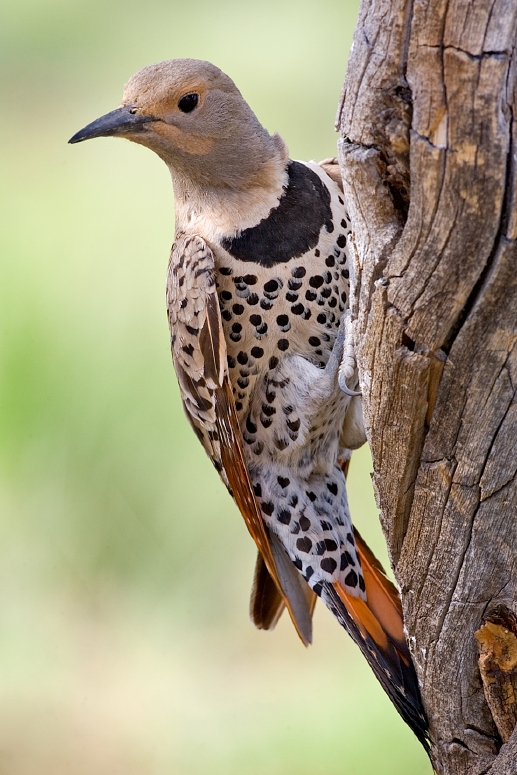
Wikipedia: Northern flicker Source: OTHER
Northern_Flicker.jpg
First observed in Maryland on 2022-04-29.
![]() The northern flicker (Colaptes auratus) or common flicker is a medium-sized bird of the woodpecker family. It is native to most of North America, parts of Central America, Cuba, and the Cayman Islands, and is one of the few woodpecker species that migrate. Over 100 common names for the northern flicker are known, including yellowhammer (not to be confused with the Eurasian yellowhammer), clape, gaffer woodpecker, harry-wicket[citation needed], heigh-ho, wake-up, walk-up, wick-up, yarrup, and gawker bird. Many of these names derive from attempts to imitate some of its calls.
[more]
The northern flicker (Colaptes auratus) or common flicker is a medium-sized bird of the woodpecker family. It is native to most of North America, parts of Central America, Cuba, and the Cayman Islands, and is one of the few woodpecker species that migrate. Over 100 common names for the northern flicker are known, including yellowhammer (not to be confused with the Eurasian yellowhammer), clape, gaffer woodpecker, harry-wicket[citation needed], heigh-ho, wake-up, walk-up, wick-up, yarrup, and gawker bird. Many of these names derive from attempts to imitate some of its calls.
[more]
Call:
Automatically generated from Xeno-Canto recording
♫ Source: BirdNet
20220429_122229 birdnet - Northern Flicker - Northern Flicker - Baltimore.mp3
2022-04-29 12.22.29 Maryland (song?)
Profile Wikipedia eBird A-Z Animals Audubon AllAboutBirds Xeno-Canto
Pileated woodpecker. 2023-10-13 16.06.56 New England
First observed in Cockeysville on 2022-05-05.
![]() The pileated woodpecker (Dryocopus pileatus) is a large, mostly black woodpecker native to North America. An insectivore, it inhabits deciduous forests in eastern North America, the Great Lakes, the boreal forests of Canada, and parts of the Pacific Coast. It is the second largest woodpecker species in the U.S., behind the critically endangered or possibly extinct ivory-billed woodpecker.[2]
[more]
The pileated woodpecker (Dryocopus pileatus) is a large, mostly black woodpecker native to North America. An insectivore, it inhabits deciduous forests in eastern North America, the Great Lakes, the boreal forests of Canada, and parts of the Pacific Coast. It is the second largest woodpecker species in the U.S., behind the critically endangered or possibly extinct ivory-billed woodpecker.[2]
[more]
Call:
Automatically generated from Xeno-Canto recording
♫ Source: BirdNet
20220505_081633 birdnet - Pileated Woodpecker - 2022-05-05 08:16:33 - Pileated Woodpecker - Cockeysville.mp3
2022-05-05 08.16.33 Cockeysville (song?)
Profile Wikipedia eBird Audubon AllAboutBirds Xeno-Canto

Wikipedia: Yellow-bellied sapsucker Source: OTHER
1200px-Yellow-bellied_sapsucker_in_CP_%2840484%29.jpg
![]() The yellow-bellied sapsucker (Sphyrapicus varius) is a medium-sized woodpecker that breeds in Canada and the northeastern United States.
[more]
The yellow-bellied sapsucker (Sphyrapicus varius) is a medium-sized woodpecker that breeds in Canada and the northeastern United States.
[more]
Profile Wikipedia eBird Audubon AllAboutBirds Xeno-Canto
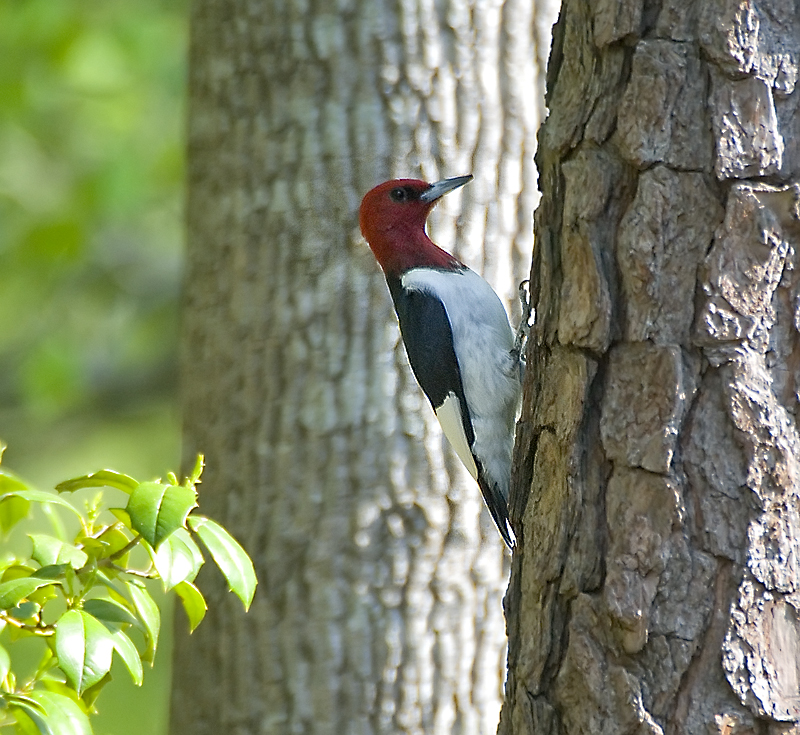
Wikipedia: Red-headed woodpecker Source: OTHER
Melanerpes_erythrocephalus_-tree_trunk-USA.jpg
![]() The red-headed woodpecker (Melanerpes erythrocephalus) is a small or medium-sized woodpecker from temperate North America. Their breeding habitat is open country across southern Canada and the eastern-central United States. It is rated as least concern on the International Union for Conservation of Nature (IUCN)'s Red List of Endangered species, having been downlisted from near threatened in 2018.[2]
[more]
The red-headed woodpecker (Melanerpes erythrocephalus) is a small or medium-sized woodpecker from temperate North America. Their breeding habitat is open country across southern Canada and the eastern-central United States. It is rated as least concern on the International Union for Conservation of Nature (IUCN)'s Red List of Endangered species, having been downlisted from near threatened in 2018.[2]
[more]
Profile Wikipedia eBird A-Z Animals Audubon AllAboutBirds Xeno-Canto
Red bellied woodpecker. 2022-04-29 11.51.34 Maryland
First observed in Maryland on 2021-06-18.
![]() The red-bellied woodpecker (Melanerpes carolinus) is a medium-sized woodpecker of the family Picidae. It breeds mainly in the eastern United States, ranging as far south as Florida and as far north as Canada. Its common name is somewhat misleading, as the most prominent red part of its plumage is on the head; the red-headed woodpecker, however, is another species that is a rather close relative but looks quite different.
[more]
The red-bellied woodpecker (Melanerpes carolinus) is a medium-sized woodpecker of the family Picidae. It breeds mainly in the eastern United States, ranging as far south as Florida and as far north as Canada. Its common name is somewhat misleading, as the most prominent red part of its plumage is on the head; the red-headed woodpecker, however, is another species that is a rather close relative but looks quite different.
[more]
Call:
Automatically generated from Xeno-Canto recording
♫ Source: BirdNet
20220429_102809 birdnet - Red-bellied Woodpecker - Red-bellied Woodpecker - Towson.mp3
2022-04-29 10.28.09 Maryland (song?)
Downy woodpecker. 2022-05-05 09.37.50 Maryland
First observed in Maryland on 2021-06-14.
![]() The downy woodpecker (Dryobates pubescens) is a species of woodpecker, the smallest in North America.
[more]
The downy woodpecker (Dryobates pubescens) is a species of woodpecker, the smallest in North America.
[more]
Hairy woodpecker. 2023-10-12 15.33.18 New England
First observed in New England on 2023-10-12.

Wikipedia: Nanday parakeet Source: OTHER
1200px-2011-4_parrot_in_Strasbourg.jpg
![]() The nanday parakeet (Aratinga nenday), also known as the black-hooded parakeet or nanday conure, is a medium-small, mostly green, Neotropical parrot native to continental South America.
[more]
The nanday parakeet (Aratinga nenday), also known as the black-hooded parakeet or nanday conure, is a medium-small, mostly green, Neotropical parrot native to continental South America.
[more]

Wikipedia: Monk parakeet Source: OTHER
1200px-Monk_Parakeet_%28Myiopsitta_monachus%29_%2828420470712%29.jpg
This bird appears across the great seas in the following continents:
Europe, North America, Africa.
![]() The monk parakeet (Myiopsitta monachus), also known as the Quaker parrot, is a species of true parrot in the family Psittacidae. It is a small, bright-green parrot with a greyish breast and greenish-yellow abdomen. Its average lifespan is 20–30 years. It originates from the temperate to subtropical areas of Argentina and the surrounding countries in South America. Self-sustaining feral populations occur in many places, mainly in North America and Europe.
[more]
The monk parakeet (Myiopsitta monachus), also known as the Quaker parrot, is a species of true parrot in the family Psittacidae. It is a small, bright-green parrot with a greyish breast and greenish-yellow abdomen. Its average lifespan is 20–30 years. It originates from the temperate to subtropical areas of Argentina and the surrounding countries in South America. Self-sustaining feral populations occur in many places, mainly in North America and Europe.
[more]

Wikipedia: Mitred parakeet Source: OTHER
Mitred_Parakeet_Florida.jpg
![]() The mitred parakeet (Psittacara mitratus), also known as the mitred conure in aviculture, is a species of green and red parrot in the family Psittacidae. It is native to the forests and woodlands in the Andes from north-central Peru, south through Bolivia, to north-western Argentina,[2] with introduced populations in California, Florida and Hawaii.[3] It may constitute a cryptic species complex.[2]
[more]
The mitred parakeet (Psittacara mitratus), also known as the mitred conure in aviculture, is a species of green and red parrot in the family Psittacidae. It is native to the forests and woodlands in the Andes from north-central Peru, south through Bolivia, to north-western Argentina,[2] with introduced populations in California, Florida and Hawaii.[3] It may constitute a cryptic species complex.[2]
[more]

Wikipedia: Red-throated loon Source: OTHER
1200px-Gavia_Stellata_%C3%96lfus%C3%A1_20090606.jpg
This bird appears across the great seas in the following continents:
Europe, North America.
Deutschland: Zugvogel, Wintergast
Habitats:
River and lake
Great northern loon, Squam Lake, New Hampshire. 2023-10-06 12.26.58 New England
First observed in New England on 2023-10-06.
This bird appears across the great seas in the following continents:
Europe, North America.
Deutschland: seltener Wintergast
Song: ![]() Song: Like a slow Black-throated Diver. Pitch slowly rising with a register break, progressing into a cyclic, two to four syllable, motif. [Link]
Song: Like a slow Black-throated Diver. Pitch slowly rising with a register break, progressing into a cyclic, two to four syllable, motif. [Link]
Calls: ![]() Also various vibrating eerie descending calls. Often used as sound effect in horror movies. [Link]
Also various vibrating eerie descending calls. Often used as sound effect in horror movies. [Link]
Physical details: length=69-91 cm,
wingspan=69-91 cm,
weight=3600-4480 g
Profile Wikipedia eBird A-Z Animals Audubon AllAboutBirds Xeno-Canto
Pied-billed grebe, Bacalar. 2023-03-31 13.17.14 Yucatan
First observed in Yucatan on 2023-03-31.
This bird appears across the great seas in the following continents:
North America, South America, Africa.
General: ![]() The pied-billed grebe (Podilymbus podiceps) is a species of the grebe family of water birds. Since the Atitlán grebe (Podilymbus gigas) has become extinct, it is the sole extant member of the genus Podilymbus.[2] The pied-billed grebe is primarily found in ponds throughout the Americas.[3] Other names of this grebe include American dabchick, rail, dabchick, Carolina grebe, devil-diver, dive-dapper, dipper, hell-diver, pied-billed dabchick, pied-bill, thick-billed grebe, and water witch.[4][5]
[more]
The pied-billed grebe (Podilymbus podiceps) is a species of the grebe family of water birds. Since the Atitlán grebe (Podilymbus gigas) has become extinct, it is the sole extant member of the genus Podilymbus.[2] The pied-billed grebe is primarily found in ponds throughout the Americas.[3] Other names of this grebe include American dabchick, rail, dabchick, Carolina grebe, devil-diver, dive-dapper, dipper, hell-diver, pied-billed dabchick, pied-bill, thick-billed grebe, and water witch.[4][5]
[more]
Evtl Schwarzhalstaucher. 2021-03-07 11.13.08
First observed in 🇨🇭 on 2021-03-07.
This bird appears across the great seas in the following continents:
Europe, North America, Africa.
![]() The black-necked grebe or eared grebe (Podiceps nigricollis) is a member of the grebe family of water birds. It was described in 1831 by Christian Ludwig Brehm. There are currently three accepted subspecies, including the nominate subspecies. Its breeding plumage features a distinctive ochre-coloured plumage which extends behind its eye and over its ear coverts. The rest of the upper parts, including the head, neck, and breast, are coloured black to blackish brown. The flanks are tawny rufous to maroon-chestnut, and the abdomen is white. When in its non-breeding plumage, this bird has greyish-black upper parts, including the top of the head and a vertical stripe on the back of the neck. The flanks are also greyish-black. The rest of the body is a white or whitish colour. The juvenile has more brown in its darker areas. The subspecies californicus can be distinguished from the nominate by the former's usually longer bill. The other subspecies, P. n. gurneyi, can be differentiated by its greyer head and upper parts and by its smaller size. P. n. gurneyi can also be told apart by its lack of a non-breeding plumage. This species is present in parts of Africa, Eurasia, and the Americas.
[more]
The black-necked grebe or eared grebe (Podiceps nigricollis) is a member of the grebe family of water birds. It was described in 1831 by Christian Ludwig Brehm. There are currently three accepted subspecies, including the nominate subspecies. Its breeding plumage features a distinctive ochre-coloured plumage which extends behind its eye and over its ear coverts. The rest of the upper parts, including the head, neck, and breast, are coloured black to blackish brown. The flanks are tawny rufous to maroon-chestnut, and the abdomen is white. When in its non-breeding plumage, this bird has greyish-black upper parts, including the top of the head and a vertical stripe on the back of the neck. The flanks are also greyish-black. The rest of the body is a white or whitish colour. The juvenile has more brown in its darker areas. The subspecies californicus can be distinguished from the nominate by the former's usually longer bill. The other subspecies, P. n. gurneyi, can be differentiated by its greyer head and upper parts and by its smaller size. P. n. gurneyi can also be told apart by its lack of a non-breeding plumage. This species is present in parts of Africa, Eurasia, and the Americas.
[more]
Habitats:
River and lake
Horned grebe, Myvatn, Iceland. 2015-06-05 11.22.28 Iceland
First observed in Iceland on 2015-06-05.
This bird appears across the great seas in the following continents:
Europe, North America.
Deutschland: Brut-, Zugvogel, Wintergast RL 1
Vocalization: ![]() Varied. Vibrating, wailing, dry and cackling sequences. A mewing, falling and far-reaching "kiaa" and various rattling sounds. [Link]
Varied. Vibrating, wailing, dry and cackling sequences. A mewing, falling and far-reaching "kiaa" and various rattling sounds. [Link]
Physical details: length=31-38 cm,
wingspan=46-55 cm,
weight=364-449 g
Habitats:
River and lake
Profile Wikipedia eBird Audubon AllAboutBirds Xeno-Canto

Wikipedia: Audubon's shearwater Source: OTHER
1200px-Audobon%27s_Shearwater.jpg
General: ![]() Audubon's shearwater (Puffinus lherminieri) is a common tropical seabird in the petrel family. Sometimes known as the dusky-backed shearwater,[2] the specific epithet honours the French naturalist Félix Louis L'Herminier.
[more]
Audubon's shearwater (Puffinus lherminieri) is a common tropical seabird in the petrel family. Sometimes known as the dusky-backed shearwater,[2] the specific epithet honours the French naturalist Félix Louis L'Herminier.
[more]
This bird appears across the great seas in the following continents:
Europe, North America, Africa.
![]() Der Sepiasturmtaucher (Calonectris diomedea, Syn.: Puffinus diomedea), früher als Gelbschnabel-Sturmtaucher bezeichnet, ist eine Vogelart aus der Ordnung der Röhrennasen. Es werden drei Unterarten unterschieden:
C. d. diomedea (Scopoli, 1769), C. d. borealis (Cory, 1881) und C. d. edwardsii (Oustalet, 1883).
[more]
Der Sepiasturmtaucher (Calonectris diomedea, Syn.: Puffinus diomedea), früher als Gelbschnabel-Sturmtaucher bezeichnet, ist eine Vogelart aus der Ordnung der Röhrennasen. Es werden drei Unterarten unterschieden:
C. d. diomedea (Scopoli, 1769), C. d. borealis (Cory, 1881) und C. d. edwardsii (Oustalet, 1883).
[more]
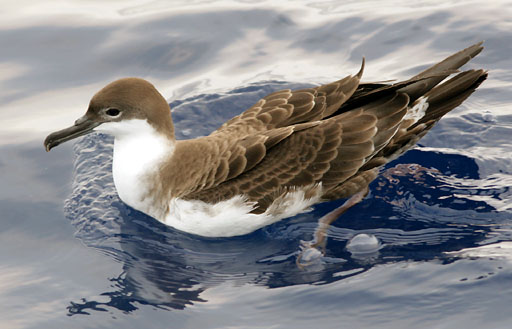
Wikipedia: Great shearwater Source: OTHER
Puffinus_gravisPCCA20070623-3641B.jpg
This bird appears across the great seas in the following continents:
Europe, North America, Africa.
![]() The great shearwater (Ardenna gravis) is a large shearwater in the seabird family Procellariidae. Ardenna was first used to refer to a seabird by Italian naturalist Ulisse Aldrovandi in 1603, and gravis is Latin for "heavy".[3]
[more]
The great shearwater (Ardenna gravis) is a large shearwater in the seabird family Procellariidae. Ardenna was first used to refer to a seabird by Italian naturalist Ulisse Aldrovandi in 1603, and gravis is Latin for "heavy".[3]
[more]
Calls: ![]() Calls at breeding ground a deep, soft, moaning "oooh-aahh" ("surprised or shocked old lady"). Tone fairly clear, and pitch rising and falling. [Link]
Calls at breeding ground a deep, soft, moaning "oooh-aahh" ("surprised or shocked old lady"). Tone fairly clear, and pitch rising and falling. [Link]
Physical details: length=43-51 cm,
wingspan=100-118 cm,
weight=715-950 g

Wikipedia: Band-rumped storm-petrel Source: OTHER
1200px-Band_rumped_storm_petrel_Andre_Raine_KESRP_%2821789178016%29.jpg
This bird appears across the great seas in the following continents:
Europe, North America, South America, Africa, Australia.
vagrant
This bird appears across the great seas in the following continents:
Europe, North America, South America.
General: ![]() Der Wellenläufer (Oceanodroma leucorhoa) ist eine von weltweit 13 Vogelarten der Gattung der Wellenläufer. Ihren Namen verdanken die Wellenläufer der Verhaltensweise, oft mit herunterhängenden Beinen dicht über dem Wasser zu gleiten. Dabei tauchen sie mit den Füßen ins Wasser ein.
[more]
Der Wellenläufer (Oceanodroma leucorhoa) ist eine von weltweit 13 Vogelarten der Gattung der Wellenläufer. Ihren Namen verdanken die Wellenläufer der Verhaltensweise, oft mit herunterhängenden Beinen dicht über dem Wasser zu gleiten. Dabei tauchen sie mit den Füßen ins Wasser ein.
[more]

Wikipedia: Wilson's storm-petrel Source: OTHER
1200px-Oceanites_oceanicus_-_SE_Tasmania.jpg
This bird appears across the great seas in the following continents:
Europe, North America, South America, Africa, Asia.
![]() Wilson's storm petrel (Oceanites oceanicus), also known as Wilson's petrel, is a small seabird of the austral storm petrel family Oceanitidae. It is one of the most abundant bird species in the world and has a circumpolar distribution mainly in the seas of the southern hemisphere but extending northwards during the summer of the northern hemisphere. The world population has been estimated to be more than 50 million pairs.[2] The name commemorates the Scottish-American ornithologist Alexander Wilson. The genus name Oceanites refers to the mythical Oceanids, the three thousand daughters of Tethys. The species name is from Latin oceanus, "ocean".[3]
[more]
Wilson's storm petrel (Oceanites oceanicus), also known as Wilson's petrel, is a small seabird of the austral storm petrel family Oceanitidae. It is one of the most abundant bird species in the world and has a circumpolar distribution mainly in the seas of the southern hemisphere but extending northwards during the summer of the northern hemisphere. The world population has been estimated to be more than 50 million pairs.[2] The name commemorates the Scottish-American ornithologist Alexander Wilson. The genus name Oceanites refers to the mythical Oceanids, the three thousand daughters of Tethys. The species name is from Latin oceanus, "ocean".[3]
[more]

Wikipedia: Great horned owl Source: OTHER
1200px-Bubo_virginianus_06.jpg
![]() About 12, see text
[more]
About 12, see text
[more]

Wikipedia: Northern barred owl Source: OTHER
1200px-Strix-varia-005.jpg
First observed in New England on 2023-10-04.
This bird appears across the great seas in the following continents:
Europe, North America.
![]() Syrnium varium
[more]
Syrnium varium
[more]
Call:
We heard this in New England after sunset, and swore it sounded like monkeys. Merlin's SoundID told it was a barred owl, and when I looked up 'barred owl monkey' in the internet, I found that monkey call is a common description, for instance here.
Call attributes:
Call melody: one note, slow, Frequency: 0-1 KHz,

Wikipedia: Short-eared owl Source: OTHER
1200px-Hibou_des_marais.jpg
This bird appears across the great seas in the following continents:
Europe, North America, South America, Africa, Asia.
Deutschland: Brut-, Zugvogel, Wintergast RL 1
Habitats:
Wetland

Wikipedia: Burrowing owl Source: OTHER
1200px-Brazilian_burrowing_owl_%28Athene_cunicularia_grallaria%29.jpg
General: ![]() The burrowing owl (Athene cunicularia) is a small, long-legged owl found throughout open landscapes of North and South America. Burrowing owls can be found in grasslands, rangelands, agricultural areas, deserts, or any other open dry area with low vegetation.[2] They nest and roost in burrows, such as those excavated by prairie dogs (Cynomys spp.). Unlike most owls, burrowing owls are often active during the day, although they tend to avoid the midday heat. Like many other kinds of owls, though, burrowing owls do most of their hunting from dusk until dawn, when they can use their night vision and hearing to their advantage. Living in open grasslands as opposed to forests, the burrowing owl has developed longer legs that enable it to sprint, as well as fly, when hunting.
[more]
The burrowing owl (Athene cunicularia) is a small, long-legged owl found throughout open landscapes of North and South America. Burrowing owls can be found in grasslands, rangelands, agricultural areas, deserts, or any other open dry area with low vegetation.[2] They nest and roost in burrows, such as those excavated by prairie dogs (Cynomys spp.). Unlike most owls, burrowing owls are often active during the day, although they tend to avoid the midday heat. Like many other kinds of owls, though, burrowing owls do most of their hunting from dusk until dawn, when they can use their night vision and hearing to their advantage. Living in open grasslands as opposed to forests, the burrowing owl has developed longer legs that enable it to sprint, as well as fly, when hunting.
[more]

Wikipedia: Eastern screech-owl Source: OTHER
1200px-Eastern_Screech_Owl.jpg
![]() The eastern screech owl (Megascops asio) or eastern screech-owl, is a small owl that is relatively common in Eastern North America, from Mexico to Canada.[1][2] This species is native to most wooded environments of its distribution, and more so than any other owl in its range, has adapted well to manmade development, although it frequently avoids detection due to its strictly nocturnal habits.[3]
[more]
The eastern screech owl (Megascops asio) or eastern screech-owl, is a small owl that is relatively common in Eastern North America, from Mexico to Canada.[1][2] This species is native to most wooded environments of its distribution, and more so than any other owl in its range, has adapted well to manmade development, although it frequently avoids detection due to its strictly nocturnal habits.[3]
[more]

Wikipedia: Barn owl Source: OTHER
1200px-Tyto_alba_-British_Wildlife_Centre%2C_Surrey%2C_England-8a_%281%29.jpg
This bird appears across the great seas in the following continents:
Europe, North America, South America, Africa, Asia.
![]() The barn owl (Tyto alba) is the most widely distributed species of owl in the world and one of the most widespread of all species of birds, being found almost everywhere in the world except for the polar and desert regions, Asia north of the Himalayas, most of Indonesia, and some Pacific Islands. It is also known as the common barn owl, to distinguish it from the other species in its family, Tytonidae, which forms one of the two main lineages of living owls, the other being the typical owls (Strigidae).
[more]
The barn owl (Tyto alba) is the most widely distributed species of owl in the world and one of the most widespread of all species of birds, being found almost everywhere in the world except for the polar and desert regions, Asia north of the Himalayas, most of Indonesia, and some Pacific Islands. It is also known as the common barn owl, to distinguish it from the other species in its family, Tytonidae, which forms one of the two main lineages of living owls, the other being the typical owls (Strigidae).
[more]
Vocalization: ![]() Large repertoire of mainly hissing and screeching sounds. [Link]
Large repertoire of mainly hissing and screeching sounds. [Link]
Song: ![]() Song consists of a single, drawn screech, lasting about a second and is often performed in flight. Starting in a very hoarse tone, then progressing with a rising pitch into a more burbling sound, before suddenly ending. [Link]
Song consists of a single, drawn screech, lasting about a second and is often performed in flight. Starting in a very hoarse tone, then progressing with a rising pitch into a more burbling sound, before suddenly ending. [Link]
Physical details: length=33-35 cm,
wingspan=80-95 cm,
weight=240-350 g
Habitats:
Agricultural
Profile Wikipedia eBird Audubon AllAboutBirds Xeno-Canto

Wikipedia: Red junglefowl Source: OTHER
Red_Junglefowl_-_Thailand.jpg
This bird appears across the great seas in the following continents:
North America, Asia.
General: ![]() The red junglefowl (Gallus gallus) is a tropical bird in the family Phasianidae. It ranges across much of Southeast Asia and parts of South Asia. Red junglefowl are the primary ancestor of the domestic chicken (Gallus gallus domesticus); the grey junglefowl, Sri Lankan junglefowl and green junglefowl have also contributed genetic material to the gene pool of the chicken.[2][3]
[more]
The red junglefowl (Gallus gallus) is a tropical bird in the family Phasianidae. It ranges across much of Southeast Asia and parts of South Asia. Red junglefowl are the primary ancestor of the domestic chicken (Gallus gallus domesticus); the grey junglefowl, Sri Lankan junglefowl and green junglefowl have also contributed genetic material to the gene pool of the chicken.[2][3]
[more]
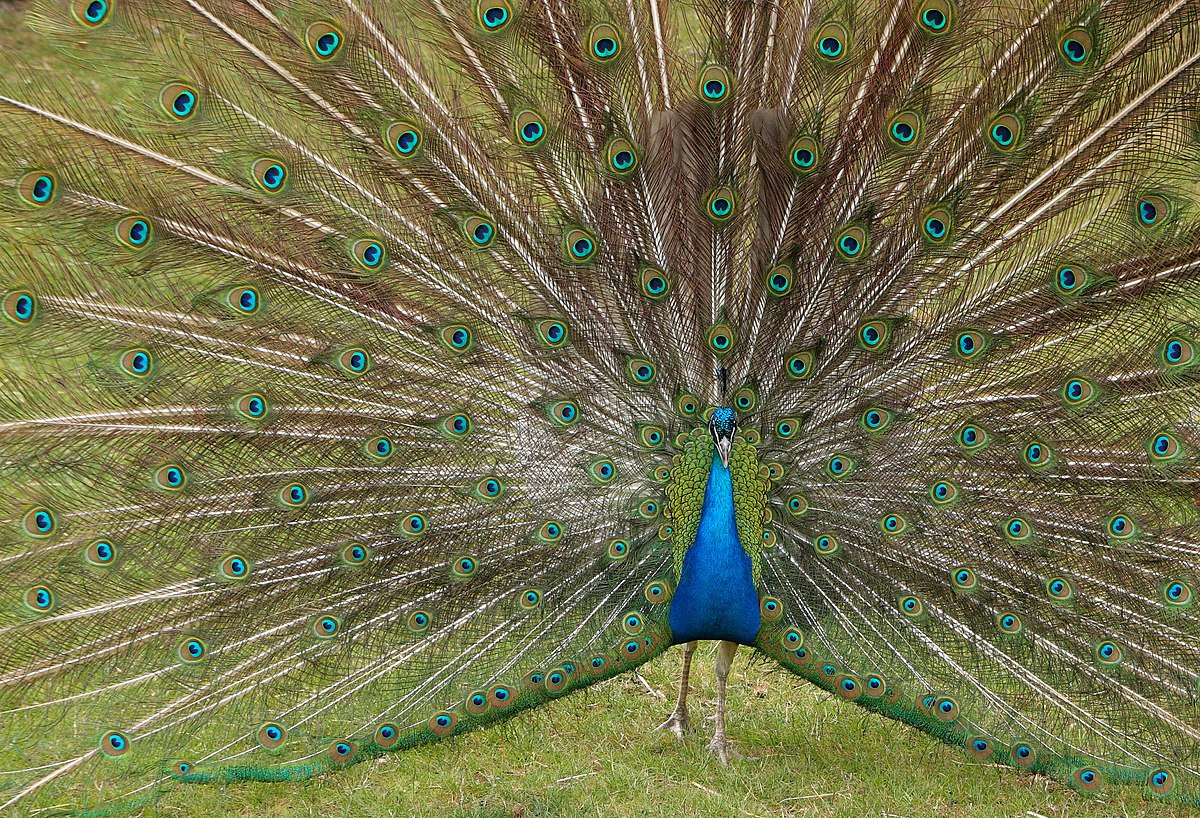
Wikipedia: Indian peafowl Source: OTHER
1200px-Peacock%2C_East_Park%2C_Hull_-_panoramio.jpg
This bird appears across the great seas in the following continents:
North America, Africa.
![]() The Indian peafowl (Pavo cristatus), also known as the common peafowl, and blue peafowl, is a peafowl species native to the Indian subcontinent. It has been introduced to many other countries.
[more]
The Indian peafowl (Pavo cristatus), also known as the common peafowl, and blue peafowl, is a peafowl species native to the Indian subcontinent. It has been introduced to many other countries.
[more]
Wild turkey near Vickys mothers house. 2023-10-11 14.54.58 New England
First observed in Maryland on 2021-06-18.
This bird appears across the great seas in the following continents:
North America, Australia.
introduced, King, Flinders & Kangaroo Island
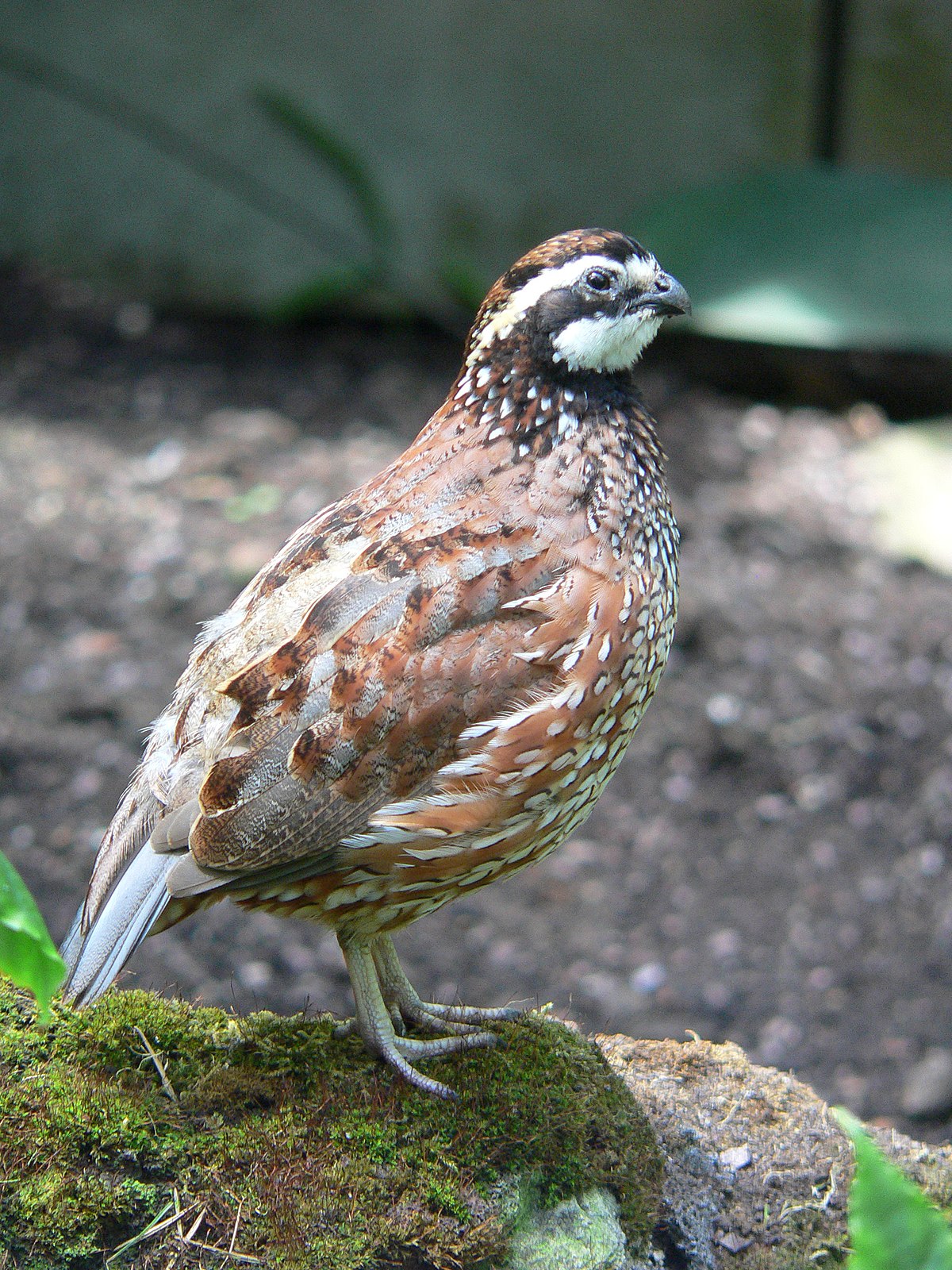
Wikipedia: Northern bobwhite Source: OTHER
1200px-Virginiawachtel_2007-06-16_065.jpg
General: ![]() The northern bobwhite (Colinus virginianus), also known as the Virginia quail or (in its home range) bobwhite quail, is a ground-dwelling bird native to Canada, the United States, Mexico, and Cuba, with introduced populations elsewhere in the Caribbean, Europe, and Asia. It is a member of the group of species known as New World quails (Odontophoridae). They were initially placed with the Old World quails in the pheasant family (Phasianidae), but are not particularly closely related. The name "bobwhite" is an onomatopoeic derivation from its characteristic whistling call. Despite its secretive nature, the northern bobwhite is one of the most familiar quails in eastern North America, because it is frequently the only quail in its range. Habitat degradation has likely contributed to the northern bobwhite population in eastern North America declining by roughly 85% from 1966 to 2014.[3] This population decline is apparently range-wide and continuing.[4][5]
[more]
The northern bobwhite (Colinus virginianus), also known as the Virginia quail or (in its home range) bobwhite quail, is a ground-dwelling bird native to Canada, the United States, Mexico, and Cuba, with introduced populations elsewhere in the Caribbean, Europe, and Asia. It is a member of the group of species known as New World quails (Odontophoridae). They were initially placed with the Old World quails in the pheasant family (Phasianidae), but are not particularly closely related. The name "bobwhite" is an onomatopoeic derivation from its characteristic whistling call. Despite its secretive nature, the northern bobwhite is one of the most familiar quails in eastern North America, because it is frequently the only quail in its range. Habitat degradation has likely contributed to the northern bobwhite population in eastern North America declining by roughly 85% from 1966 to 2014.[3] This population decline is apparently range-wide and continuing.[4][5]
[more]
Profile Wikipedia eBird Audubon AllAboutBirds Xeno-Canto

Wikipedia: Chimney swift Source: OTHER
Chimney_swift_overhead.jpg
![]() The chimney swift (Chaetura pelagica) is a bird belonging to the swift family Apodidae. A member of the genus Chaetura, it is closely related to both the Vaux's swift and the Chapman's swift; in the past, the three were sometimes considered to be conspecific. It has no subspecies. The chimney swift is a medium-sized, sooty gray bird with very long, slender wings and very short legs. Like all swifts, it is incapable of perching, and can only cling vertically to surfaces.
[more]
The chimney swift (Chaetura pelagica) is a bird belonging to the swift family Apodidae. A member of the genus Chaetura, it is closely related to both the Vaux's swift and the Chapman's swift; in the past, the three were sometimes considered to be conspecific. It has no subspecies. The chimney swift is a medium-sized, sooty gray bird with very long, slender wings and very short legs. Like all swifts, it is incapable of perching, and can only cling vertically to surfaces.
[more]
Profile Wikipedia eBird A-Z Animals Audubon AllAboutBirds Xeno-Canto

Wikipedia: Rufous hummingbird Source: OTHER
1200px-USFWS_ribes_sanguineum_%2826123508822%29.jpg
![]() The rufous hummingbird (Selasphorus rufus) is a small hummingbird, about 8 cm (3.1 in) long with a long, straight and slender bill. These birds are known for their extraordinary flight skills, flying 2,000 mi (3,200 km) during their migratory transits. It is one of seven species in the genus Selasphorus.
[more]
The rufous hummingbird (Selasphorus rufus) is a small hummingbird, about 8 cm (3.1 in) long with a long, straight and slender bill. These birds are known for their extraordinary flight skills, flying 2,000 mi (3,200 km) during their migratory transits. It is one of seven species in the genus Selasphorus.
[more]

Wikipedia: Ruby-throated hummingbird Source: OTHER
Rubythroathummer65.jpg
![]() The ruby-throated hummingbird (Archilochus colubris) is a species of hummingbird that generally spends the winter in Central America, Mexico, and Florida, and migrates to Canada and other parts of Eastern North America for the summer to breed. It is by far the most common hummingbird seen east of the Mississippi River in North America.
[more]
The ruby-throated hummingbird (Archilochus colubris) is a species of hummingbird that generally spends the winter in Central America, Mexico, and Florida, and migrates to Canada and other parts of Eastern North America for the summer to breed. It is by far the most common hummingbird seen east of the Mississippi River in North America.
[more]

Wikipedia: Black-chinned hummingbird Source: OTHER
1200px-Archilochus-alexandri-003.jpg
![]() The black-chinned hummingbird (Archilochus alexandri) is a small hummingbird occupying a broad range of habitats.[2] It is migratory, spending winter as far south as Mexico.
[more]
The black-chinned hummingbird (Archilochus alexandri) is a small hummingbird occupying a broad range of habitats.[2] It is migratory, spending winter as far south as Mexico.
[more]
Profile Wikipedia eBird Audubon AllAboutBirds Xeno-Canto

Wikipedia: Antillean nighthawk Source: OTHER
1200px-Antillean_Nighthawk_%28Chordeiles_gundlachii%29%3B_with_distinctive_white_patch%2C_resting_in_Cabo_Rojo_National_Wildlife_Refuge%2C_Puerto_Rico.JPG
![]() The Antillean nighthawk (Chordeiles gundlachii) is a nightjar native to the Caribbean, The Bahamas, and Florida Keys.
[more]
The Antillean nighthawk (Chordeiles gundlachii) is a nightjar native to the Caribbean, The Bahamas, and Florida Keys.
[more]

Wikipedia: Common nighthawk Source: OTHER
1200px-Common_Nighthawk_%2814428313550%29.jpg
![]() The common nighthawk (Chordeiles minor) is a medium-sized [3][4] crepuscular or nocturnal bird[3][5] of the Americas within the nightjar family, whose presence and identity are best revealed by its vocalization. Typically dark[3] (grey, black and brown),[5] displaying cryptic colouration and intricate patterns, this bird is difficult to spot with the naked eye during the day. Once aerial, with its buoyant but erratic flight, this bird is most conspicuous. The most remarkable feature of this aerial insectivore is its small beak that belies the massiveness of its mouth. Some claim appearance similarities to owls. With its horizontal stance[3] and short legs, the common nighthawk does not travel frequently on the ground, instead preferring to perch horizontally, parallel to branches, on posts, on the ground or on a roof.[5] The males of this species may roost together but the bird is primarily solitary. The common nighthawk shows variability in territory size.[4]
[more]
The common nighthawk (Chordeiles minor) is a medium-sized [3][4] crepuscular or nocturnal bird[3][5] of the Americas within the nightjar family, whose presence and identity are best revealed by its vocalization. Typically dark[3] (grey, black and brown),[5] displaying cryptic colouration and intricate patterns, this bird is difficult to spot with the naked eye during the day. Once aerial, with its buoyant but erratic flight, this bird is most conspicuous. The most remarkable feature of this aerial insectivore is its small beak that belies the massiveness of its mouth. Some claim appearance similarities to owls. With its horizontal stance[3] and short legs, the common nighthawk does not travel frequently on the ground, instead preferring to perch horizontally, parallel to branches, on posts, on the ground or on a roof.[5] The males of this species may roost together but the bird is primarily solitary. The common nighthawk shows variability in territory size.[4]
[more]
Profile Wikipedia eBird Audubon AllAboutBirds Xeno-Canto

Wikipedia: Lesser nighthawk Source: OTHER
1200px-Chordeiles_acutipennis_-_Lesser_Nighthawk.jpg
![]() The lesser nighthawk (Chordeiles acutipennis) is a nightjar found throughout a large part of the Americas.
[more]
The lesser nighthawk (Chordeiles acutipennis) is a nightjar found throughout a large part of the Americas.
[more]

Wikipedia: Chuck-will's-widow Source: OTHER
1200px-Chuck-wills-widow_RWD7.jpg
![]() The chuck-will's-widow (Antrostomus carolinensis) is a nocturnal bird of the nightjar family Caprimulgidae. It is found in the southeastern United States near swamps, rocky uplands, and pine woods. It migrates to the West Indies, Central America, and northwestern South America.
[more]
The chuck-will's-widow (Antrostomus carolinensis) is a nocturnal bird of the nightjar family Caprimulgidae. It is found in the southeastern United States near swamps, rocky uplands, and pine woods. It migrates to the West Indies, Central America, and northwestern South America.
[more]

Wikipedia: Eastern whip-poor-will Source: OTHER
Caprimulgus_vociferusAAP065B.jpg
![]() The eastern whip-poor-will (Antrostomus vociferus) is a medium-sized (22–27 cm) nightjar from North America. The whip-poor-will is commonly heard within its range, but less often seen because of its camouflage. It is named onomatopoeically after its song.[2]
[more]
The eastern whip-poor-will (Antrostomus vociferus) is a medium-sized (22–27 cm) nightjar from North America. The whip-poor-will is commonly heard within its range, but less often seen because of its camouflage. It is named onomatopoeically after its song.[2]
[more]
Classification errors:
Double-crested cormorant / Ohrenscharbe (Nannopterum auritum)
Double-crested cormorants hang out on the lightpost in Campeche. 2023-04-06 16.59.40 Yucatan
First observed in Yucatan on 2023-04-06.
![]() The double-crested cormorant (Phalacrocorax auritus) is a member of the cormorant family of water birds. Its habitat is near rivers and lakes as well as in coastal areas, and is widely distributed across North America, from the Aleutian Islands in Alaska down to Florida and Mexico. Measuring 70–90 cm (28–35 in) in length, it is an all-black bird which gains a small double crest of black and white feathers in breeding season. It has a bare patch of orange-yellow facial skin. Five subspecies are recognized. It mainly eats fish and hunts by swimming and diving. Its feathers, like those of all cormorants, are not waterproof and it must spend time drying them out after spending time in the water. Once threatened by the use of DDT, the numbers of this bird have increased markedly in recent years.
[more]
The double-crested cormorant (Phalacrocorax auritus) is a member of the cormorant family of water birds. Its habitat is near rivers and lakes as well as in coastal areas, and is widely distributed across North America, from the Aleutian Islands in Alaska down to Florida and Mexico. Measuring 70–90 cm (28–35 in) in length, it is an all-black bird which gains a small double crest of black and white feathers in breeding season. It has a bare patch of orange-yellow facial skin. Five subspecies are recognized. It mainly eats fish and hunts by swimming and diving. Its feathers, like those of all cormorants, are not waterproof and it must spend time drying them out after spending time in the water. Once threatened by the use of DDT, the numbers of this bird have increased markedly in recent years.
[more]
Ruby-crowned kinglet (Corthylio calendula)
Profile Wikipedia eBird A-Z Animals Audubon AllAboutBirds Xeno-Canto
Ruby-crowned kinglet. 2022-04-29 10.02.10 Maryland
First observed in Maryland on 2022-04-29.
![]() The ruby-crowned kinglet (Regulus calendula) is a very small passerine bird found throughout North America. It is a member of the kinglet family. The bird has olive-green plumage with two white wing bars and a white eye-ring. Males have a red crown patch, which is usually concealed. The sexes are identical (apart from the crown), and juveniles are similar in plumage to adults. It is one of the smallest songbirds in North America. The ruby-crowned kinglet is not closely related to other kinglets, and is put in its own subgenus, Corthylio. Three subspecies are currently recognized.
[more]
The ruby-crowned kinglet (Regulus calendula) is a very small passerine bird found throughout North America. It is a member of the kinglet family. The bird has olive-green plumage with two white wing bars and a white eye-ring. Males have a red crown patch, which is usually concealed. The sexes are identical (apart from the crown), and juveniles are similar in plumage to adults. It is one of the smallest songbirds in North America. The ruby-crowned kinglet is not closely related to other kinglets, and is put in its own subgenus, Corthylio. Three subspecies are currently recognized.
[more]